








This Long Term Plan (LTP) was adopted by the Council on 18 July 2025 in accordance with the Local Government Act 2002 (Act), with the exception of timing Council acknowledges that it failed to adopt the LTP by the statutory deadline of 30 June 2025 which is a breach of section 93(3) of the Act. This was due to delays in preparing the Consultation Document. The plan is based on the Council’s best information and planning at the time it was developed. If circumstances change, Council may have to change its intentions. All the decisions in this document are reviewable, especially during future Long Term Plans and Annual Plans.
Serving as Mayor of the Waipā District is both an honour and a privilege – especially at a time when our communities, as well as local government itself, are facing profound change.
Now after two years of hard mahi - through uncertainty, and some very difficult decisions - we have reached an important milestone. This document, our 2025-34 Long Term Plan, will set a course for our district as we navigate both significant challenge and opportunity in the years ahead.
This is not the plan we would have chosen if the circumstances were different. It continues the ‘back to basics’ approach we began last year with our Enhanced Annual Plan. The decisions we’ve made focus on delivering core services, managing our finances prudently, and preparing the organisation to face a very different and fast- evolving future.
We’ve been caught in a convergence of challenges: inflationary pressure, rising borrowing costs, regulatory changes and reduced revenue due to lower than anticipated growth in recent years. We are at a crossroads staring into the eye of a perfect storm.
Among the most significant unknowns is the future of water service delivery. While our Council supports joining a council- controlled organisation (Waikato Water Done Well) alongside other rural and provincial councils, this plan assumes we continue to deliver water services in-house for the next nine years. We’ve done this deliberately, recognising that a final decision must reflect not only the direction from Central Government but also the voices of our community. We consulted on both water services and the Long Term Plan at the same time, and we’ve made a point of listening first, deciding second.
Throughout this process, the role of our elected members has been critical. The responsibility of decision-making under such complex and constrained circumstances cannot be understated. As a group, we’ve had to wrestle with trade- offs, balance the needs of the organisation with the affordability for ratepayers, and front up to some hard truths. I want to acknowledge the dedication, professionalism, and resilience my fellow elected members have shown.
We’ve challenged ourselves to think strategically, act prudently, and strike a fair balance between delivering what our community needs and what it can afford. We’ve asked staff to go through budgets line-by-line, again and again, to find savings where possible – particularly in the early years of the plan – but always with a clear understanding of the implications.
It hasn’t been a smooth or linear path more like hiking to the top of a hill, only to discover there’s another, steeper hill beyond it. Yet each time, we’ve pushed on together. That willingness to stay the course, even when the ground is uncertain, is something I deeply admire and value.
Just as important has been the role of our community. I want to sincerely thank everyone who took the time to engage with us through written submissions, online feedback, public meetings, webinars and face-to -face conversations. Your voices have shaped this plan. We are always mindful that there is no Council without community and that we govern not just for
today, but for tomorrow's generations. We call this cathedral thinking, or mokopuna decisionmaking.
This Long Term Plan also reflects the input of our wider community through the development of the Ahu Ake - Waipa Community Spatial Plan. The plan is a blueprint for the next 30 years promotingconnected communities, carefully managed growth, and prioritising investment over time to unlock thegreatplacemakingAhuAkeaspiresto.
Intheyearsahead, therewillbemoreuncertainty, morechange,andmorechallengestonavigate. Ourdistrict, likemanyothers, isfacedwithburgeoningcomplianceandregulatorycosts, meeting the costs of reformfrom Central Government andotherchanges we needtogive effect to.
With these challenges comes the opportunity for us to be bold in our thinking, strategic in our approach, andunitedin our purpose.
It is about building a future that reflects our values - one that balances economic vitality with environmental sustainability, championingour culture and being socially resilient.
We've shown that we can prioritise what matters, face difficult trade-offs, and keep a clear eye onthe future.
To our staff- thank you for your relentless work, your integrity, and your commitment to doing what's right.
To our community-thank you for your trust, yourinput, andyour voice. Together, we will continue to build a Waipa that is future-focused, resilient, more vibrant, and better connected.
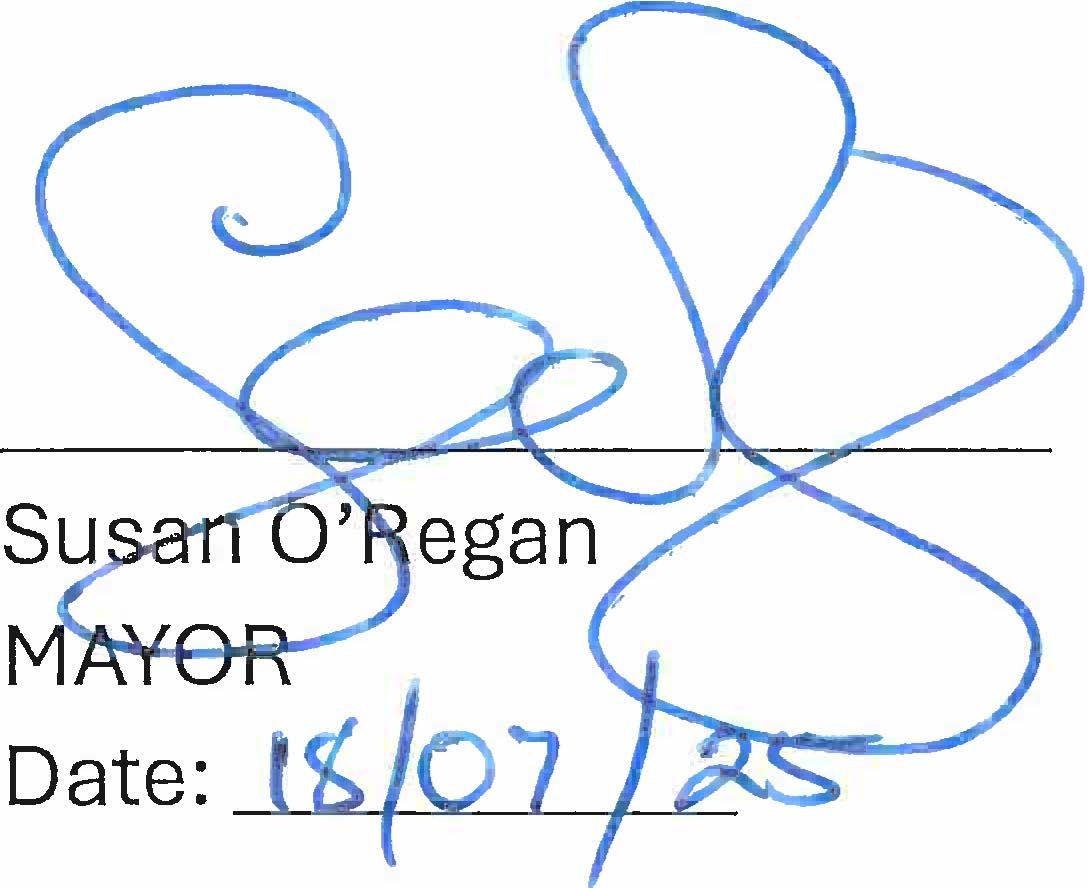
On 8 May 2025, Council approved the 2025–34 Long Term Plan Consultation Document and the supporting material for public consultation. The formal consultation period ran from Friday, 9 May to Monday, 9 June 2025. During this time, a series of questions were posed, including:
1. Do we have our priorities right?
2. Do you agree with the principles we have used to prioritise our plan for the next nine years?
3. Our draft Infrastructure Strategy focuses on renewals and looking after what we have. Do you agree this is the right approach?
4. The objectives of our Draft Financial Strategy are:
• Fxing the balance sheet – ensuring we collect the rates we need to fund operating costs and keep our debt levels sustainable over time;
• Continuing to deliver value to our communities;
• Achieving more together through partnerships and collaboration;
• Staying focussed on the longer term and bigger picture;
• Considering alternative funding and financing options;
• Providing for growth;
• Maintaining existing levels of service;
• Renewing and upgrading ageing infrastructure;
• Responding to climate change.
Do we have it right?
5. Do you agree with the proposed changes to the draft Development Contributions Policy?
6. Do you agree with the proposed changes to the draft Remission and Postponement of Rates and Water Charges Policy, draft Revenue and Financing Policy and draft Treasury Management Policy?
7. Do you agree the measures we use give you a full picture of our performance?
The Consultation Document and supporting materials were made publicly available on the Waipā District Council website from the start of the consultation period. Copies of the Consultation Document were available at libraries and the Council offices. A summary document was also delivered to every household in the district.
During the consultation period, a total of 20 engagement sessions were held across the district, including 15 face-to -face events and five webinars.
Community feedback was received through multiple channels including an online submission form, email, and written submissions delivered in person or by post. In total, 145 submissions were received. Submitters were invited to speak to their submission at hearings held on 17 and 18 June 2025 with 34 submitters attending.
Council considered all feedback received during deliberations on 19 June 2025, making decisions on the key components of the Long Term Plan as well as other matters raised through submissions.
A summary of community feedback on the key consultation questions is presented on the following pages.
1. Do we have our priorities right?
Council asked the community whether we have our priorities right in this Long Term Plan. A total of 75 submitters responded to the question with the following results:
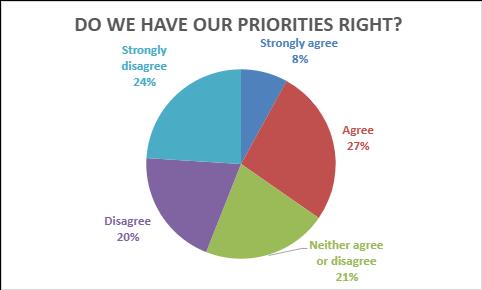
2. Do you agree with the principles we have used to prioritise our plan for the next nine years?
Council asked the community whether they agreed with the principles Council has used to prioritise the draft 2025-34 Long Term Plan for the next nine years. A total of 71 submitters responded to the question with the following results:
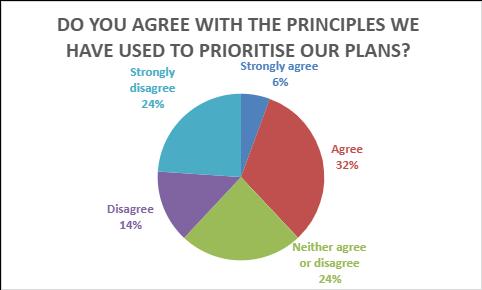
3. Our draft Infrastructure Strategy focusses on renewals and looking after what we have. Do you agree that is the right approach?
Council asked the community whether they agreed with the approach we’d taken to the draft Infrastructure Strategy (focusing on renewals and looking after what we have). A total of 70 submitters responded to the question with the following results:

4. Are the objectives of our draft Financial Strategy right?
Council asked the community whether they think the objectives of our draft Financial Strategy are right. A total of 72 submitters responded to the question with the following results:

5. Do you agree with the proposed changes to the draft Development Contributions Policy?
Council asked the community whether they agree with the proposed changes to the draft Development Contributions Policy. A total of 70 submitters responded to the question with the following results:

6. Do you agree with the proposed changes to the draft Remission and Postponement of Rates and Water Charges Policy, draft Revenue and Financing Policy, and draft Treasury Management Policy?
Council asked the community whether they agree with the proposed changes to the draft funding and financing policies. A total of 69 submitters responded to the question with the following results:

7. Do you agree with the measures we use give you a full picture of our performance?
Council asked the community whether they agree with the proposed changes to the draft funding and financing policies. A total of 72 submitters responded to the question with the following results:

8. Is there any other feedback you’d like to share?
The community was given the opportunity to provide any other feedback they may have. Key themes rising from this question were:
• Rates increases;
• Council spending;
• The impacts of growth and how it is funded;
• Audit’s opinion on the Consultation Document;
• Funding for and prioritisation of the cornerstone projects;
• Transport including cycleways and Cambridge Connections
Council’s decisions
Key decisions made in response to submissions received were to:
• Increase annual funding through a targeted rate for Cambridge Safer Community Charitable Trust from $20,000 to $40,000;
• Investigate whether the ‘Te Awamutu 110kv Compensation Reserve’ could be utilised towards field upgrades, as detailed in Te Awamutu AFC Incorporated’s submission;
• Write to the New Zealand Transport Agency Waka Kotahi advocating for improved state highway safety measures within the district;
• Write to the New Zealand Police advocating for sufficient funding for community safety initiatives within the district;
• Undertake work to bring forward the implementation of the Te Awa Cycleway extension and associated works, in conjunction with the Waipuke Park Master Plan development and associated implementation, subject to funding availability; and
• Undertake further work in collaboration with relevant community halls to determine an appropriate approach for targeted rates in respect of such halls for recommendations at a future Annual Plan or Long Term Plan amendment in 2026.
One minor change was made to the draft Development Contributions Policy with Council agreeing to amend the draft policy to reference both ‘kitchenette/kitchen’ instead of just ‘kitchen’.

Susan O’Regan
Waipā District Mayor 027 222 7784
Susan.O’Regan@waipadc.govt.nz

Mike Montgomerie
Maungatautari Ward 027 454 3892
Mike.Montgomerie@waipadc.govt.nz

Lou Brown
Te Awamutu-Kihikihi
General Ward 027 391 8620
Lou.Brown@waipadc.govt.nz

Clare St Pierre
Pirongia-Kakepuku Ward 027 324 8195
Clare.StPierre@waipadc.govt.nz

Liz Stolwyk
Deputy Mayor
Cambridge Ward 027 571 6206
Liz.Stolwyk@waipadc.govt.nz

Philip Coles
Cambridge Ward 021 432 767
Philip.Coles@waipadc.govt.nz

Andrew Brown
Te Awamutu-Kihikihi General Ward 027 486 4796
Andrew.Brown@waipadc.govt.nz

Bruce Thomas
Pirongia-Kakepuku Ward 0274 728 671
Bruce.Thomas@waipadc.govt.nz

Mike Pettit
Cambridge Ward 027 632 0375
Mike.Pettit@waipadc.govt.nz

Roger Gordon
Cambridge Ward 027 538 1228
Roger.Gordon@waipadc.govt.nz

Marcus Gower
Te Awamutu-Kihikihi General Ward 021 657 175
Marcus.Gower@waipadc.govt.nz

Dale-Maree Morgan
Māori Ward 021 881 693
Dale-Maree.Morgan@waipadc.govt.nz






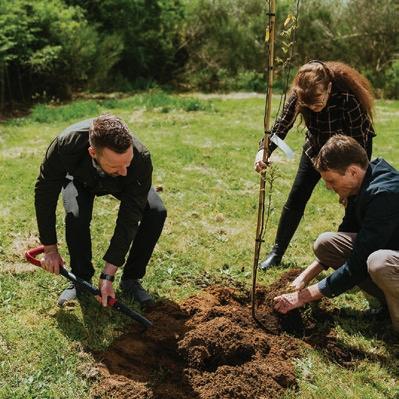
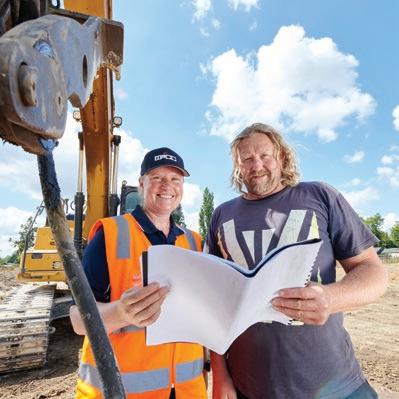
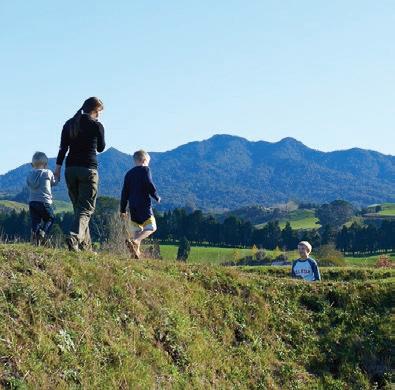
External Strategic Priority What do we mean by this?
Creating vibrant communities
► We celebrate and take pride in everything we love about Waipā.
► We have a strong community spirit and continue to work together to support each other and thrive.
► We recognise and respond to the needs of the increasingly diverse cultures within our community.
What we are going to do to deliver on this
► Provide support for community events through an in-house events team.
► Provide financial support to qualifying events through Council’s District Promotion Fund.
► Implement the Anchor Institutions Framework.
► Provide quality community facilities and services such as destination playgrounds, swimming pools, reserves and libraries to provide for the community's learning and leisure needs.
Nurturing and respecting our unique culture and heritage
► In partnership with Tangata Whenua, we increase our community awareness, understanding and appreciation of the district’s history and significant sites.
Responding to climate change
► We advance our knowledge to ensure decision-making is based on robust evidence and up-to-date information.
► We work together to inform, educate, build resilience and develop new skills and ways of working.
► Showcasing the district’s unique heritage by providing and supporting heritage offerings throughout the district.
► Tell stories of our unique history through the Te Ara Wai Journeys website and corresponding promotional signage.
► Provide financial support to qualifying applications through Council’s Heritage Fund.
► Management of archaeological and public art collection.
► Restoration of ecological sites in partnership with mana whenua.
► Fulfilling our partnership agreements through Treaty settlement mechanisms.
► Development of Climate Change Strategy and implementation plan.
► Emergency preparedness through readiness and resilience planning across communities.
► Understand the impacts, risks, and vulnerabilities of climate change in the district.
External Strategic Priority What do we mean by this?
► We take action to reduce emissions causing climate change (mitigation).
► We take action to manage the risks of climate change impacts (adaptation).
Caring for and valuing our environment now and in the future
► We recognise our responsibilities to control the effects of land use on the environment, including natural hazards and indigenous biodiversity.
► We work in partnership to support initiatives that promote the protection of the natural environment and sustainable living.
► We plan and invest in our green spaces to enhance our environmental outcomes and achieve positive health and social wellbeing outcomes.
What we are going to do to deliver on this
► Ensuring capacity in debt headroom to fund emergency events.
► Working closely with Waikato CDEM Group and Waikato Regional Council climate action group.
► Continue to provide a kerbside recycling service to all urban and rural properties and construct a resource recovery centre to support minimising waste to landfill.
► Provide financial assistance to community groups through the Community Waste Minimisation Fund.
► Continue to minimise environmental issues resulting from stormwater discharges through projects such as the Karāpiro Stream restoration.
► Complete the upgrades of the Cambridge and Te Awamutu wastewater treatment plants.
► Further enhancement of key ecological spaces including Sanctuary Mountain, Pukemako and Mt Pirongia.
► Give effect to Te Ture Whaimana o Waikato, the Vision and Strategy for the Waikato River.
► Review the Environment Strategy and implementation plan.
Effectively planning and providing for growing communities
► We plan ahead to ensure that Waipā continues to be the best place to live, work, play and invest.
► We demonstrate our value to our community through our investment and funding approach, people, services and activities.
► Continue to maintain our roading and footpath network.
► Continue to progress Cambridge Connections.
► Expand the current public transport offering.
► Implementation of Ahu Ake, Waipa Community Spatial Plan.
► Implementation of the Anchor Institutions Framework.
► Review of the Waipa 2050 Growth Strategy.
► Review of Te Awamutu and Kihikihi Town Concept Plan.
External Strategic Priority What do we mean by this?
What we are going to do to deliver on this
► Development of village concept plan for Ohaupo and Karāpiro.
► Development of amenity and neighbourhood reserves.
► Implementation of the Economic Wellbeing Strategy.
► Facilitate Māori housing, including papakāinga.
► Complete the Alpha Street Water Treatment Plan.
Climate change – a global challenge
We expect climate change to continue to significantly impact our social, economic, environmental, and cultural wellbeing. We recognise our responsibility to address this challenge and help build a resilient future for our district.
In 2019, we formally acknowledged climate change as a core issue for our district. Since then, it has been identified as a ‘Top Risk’ for the Council and remains a strategic priority woven through all of our work programmes.
Through the Long Term Plan, we aim to build on the foundational work already undertaken and continue on a path toward being an environmentally sustainable and economically prosperous district.
A key focus of our efforts is the Council’s comprehensive climate change risk assessment. This work evaluates physical risks, such as flooding, drought, and extreme weather events, and their implications for our infrastructure and how we deliver our services. It will also examine potential ‘transitional risks’ which are wider risks to the district and community. These could be things like economic and regulatory changes associated with the shift to a low- carbon future, and considers their potential impacts on our district, such as supply chain disruptions and changes to agricultural practices.
By understanding these risks, we are aiming to be better positioned to plan for climate adaptation and ensure our community remains resilient in the face of change. To guide our ongoing response, we are also developing a Climate Change Strategy. This strategy will consolidate current and future actions over the next decade, providing a coordinated and transparent approach to addressing climate risks and opportunities. It will serve as a framework to guide decision-making and enable the community to hold us accountable for progress.
By driving adaptation responses - preparing for climate impacts and supporting mitigation efforts that reduce greenhouse gas emissions, the strategy will aim to ensure a sustainable and resilient future for our district.
Alongside the development of our Climate Change Strategy and ongoing risk assessments, we are already taking practical steps to respond to climate change. Key examples include:
• Embedding carbon impact assessments into our project business cases to ensure emissions are considered in decision-making.
• Updating activity management plans and work programmes to incorporate climate change considerations. This includes targeted actions already underway to strengthen the resilience of our water, wastewater, stormwater, transport, and other infrastructure, which already include upgrades to things like water treatment plants, culverts, and the types of road materials we use.
In developing the 2025-34 Long Term Plan, a number of what are being termed ‘cornerstone projects’ were considered however, no capital funding has been allocated for them in the draft plan. This is due to the challenging financial environment that Council is operating within and the need to prioritise looking after existing infrastructure in the short to medium term. It is recognised, however, that Council would like to continue to progress investigative work on these projects therefore some operational funding has been allocated to complete this. Further details are provided below.
Cornerstone projects considered but no capital funding included
• Te Ara Wai;
• Cambridge Library;
• Cambridge Town Hall refurbishments;
• Te Awamutu to Pirongia cycleway.
Operational funding included to continue exploring cornerstone projects
• Te Ara Wai – $65,000 in year one;
• Cambridge library – $75,000 in year one;
• Cambridge Town Hall – $621,000 over years one to nine as per contractual agreement
Note there is no operational funding included for the Te Awamutu to Pirongia cycleway.
Other significant projects that Council considered but ultimately, no funding was provided include:
• Holmes Garage;
• Pirongia halls feasibility study outcomes;
• Kerbside food waste service;
• Sportsfield lease model
1. Changes in legislation
That there will be no change to the way Council operates and the functions it is responsible for delivering.
We expect to continue to see legislative change from Central Government that will influence economic, social, cultural and environmental outcomes.
This includes changes to the purpose of local government, planning and resource management, the Local Water Done Well framework, building, emergency management and transport funding and priorities.
Details of emerging legislative changes are unable to be
Very high High
Compliance with such diverse, fragmented and in some cases, very historical legislation and regulatory requirements is a very challenging task for councils.
New or amended legislation frequently involves additional funding, regulation, reporting, resources, and expertise, as well as community input into the development of policies or bylaws.
Legislation may require significant change to the way we perform by either adding new functions, removing existing ones and/or changing the nature of how these are undertaken.
Continue to work with Central Government (individually, and collaboratively with others) to influence policy and legislative change.
Continue to collaborate as a region or sector in responding to change, and to streamline plans, policies, and strategies.
‘Failure to manage change and respond to the uncertainty of the wider business context’ is a top risk to the achievement of Council’s strategic priorities.
Direction and legislative change outlined by Central Government Council’s Top Risks and Risk Appetite Statement for each financial year
Top risk trends and key risk indicators – Audit and Risk Committee.
Internal reform working group; programme reporting through to Strategic Planning and Policy Committee
Local Water Done Well governance group reporting
anticipated with any level of certainty. Therefore, current legislation is guiding our LTP approach.
2. Three waters That Council will continue to deliver stormwater, water supply and wastewater infrastructure and services for the full period of the 2025-34 LTP.
At the time of writing this assumption, consultation on Council’s Water Service Delivery Plan was scheduled to take place from 9 May to 9 June 2025 alongside LTP consultation with a final decision on the preferred water service delivery option being made mid- calendar year. However, this will not be confirmed until the Department of Internal Affairs has approved Council’s Water Services Delivery Plan.
The Local Government (Water Services) Bill is the third bill as part of the Government’s ‘Local Water Done Well’ (LWDW) policy programme. At the time of writing, the bill was at the Select Committee stage meaning there is uncertainty in terms of the final details of what will be required of Council.
Assuming Council continues to deliver water services poses financial, compliance, and reputational risks under the new LWDW regulatory framework.
Continuing to collaborate with the sector including the Department of Internal Affairs as well as, Waikato Waters Done Well, Hamilton City Council and Waikato District Council.
Direction and legislative change outlined by Central Government Local Water Done Well governance group reporting
Once this approval is received it is acknowledged that an LTP amendment will be required prior to 1 July 2026 if Council proceeds with a twowaters asset owning CCO model (with stormwater services provided as a contracted service) from that date.
Economic regulation by the Commerce Commission will increase resourcing costs and introduce compliance risks, potentially requiring unplanned investment beyond the 2025–34 LTP.
Council’s inability to separate water assets from its balance sheet means water investments must remain within existing debt covenants, increasing pressure on overall capital and financial planning. Future price- quality regulation may also limit Council’s revenue and constrain its ability to deliver service levels above regulatory
3. Tangata whenua partnerships That partnerships with Māori will continue to increase in importance. There will be new opportunities for improved collaboration and partnership over the next nine years as we establish a more strategic approach to working with Māori to address priority outcomes and community wellbeing.
minimums, even where community expectations and/or legal obligations (e.g. Te Ture Whaimana) require it.
Very high Moderate Council may need to change the way it manages assets, allocates funding and undertakes planning processes to provide for greater iwi/hapu involvement and increase capacity and capability of Māori partnerships with Council.
If Council fails to give effect to Te Tiriti o Waitangi and build and sustain partnerships with iwi and mana Whenua, including support of developing capability and capacity internally and within mana whenua and iwi, then Council will
Council has a dedicated role and staff focusing on building and maintaining effective relationships with key partners including iwi and mana Whenua. Work is progressing on the development of a Tangata Whenua Partnership framework.
Continue to grow tikanga and cultural awareness in the organisation through the Tikanga and Te Reo training and practice.
Partnership forums are in place with Māori and Council.
GM Strategy Council’s Top Risks and Risk Appetite Statement for each financial year
Top risk trends and key risk indicators
– Audit and Risk Committee
fail to meet its legislative and governance obligations and the ability to operate and deliver key projects will be significantly impacted.
Leading development of Ahu Ake (Waipā Community Spatial Plan) in partnership with iwi and mana whenua.
The ‘Failure to give effect to Te Tiriti and build successful iwi/mana Whenua partnerships’ is a top risk to the achievement of Council’s strategic priorities.
4. Technological changes Technology is quickly changing and will both cause disruption and provide opportunities to the way Council carries out its business and delivers on its strategic priorities.
High (taking innovative opportunitie s)
Low (cybersecuri ty risk/informa tion and data assets)
Moderate Technological changes are rapid and unpredictable and can have a significant impact on our lives and the way we work, how we move around our district and how we interact with each other.
More infrastructure is likely to become obsolete before the end of its life cycle.
Continue to monitor changes and advances in technology and respond as required.
The ‘failure to protect information management assets’ is a top risk to the achievement of Council’s strategic priorities.
LGNZ The 2050 Challenge –Future Proofing our Communities
Taituarā ‘Fit for the Digital Future’ 2015 Digital Roadmap
Top risk trends and key risk indicators – Audit and Risk Committee Council proactively monitors emerging technologies Independent assessment against the ALGIM SAM control
5. Central Government grant and subsidy payments That Council will continue to receive grants and subsidies from Central Government to assist with the expenditure programme. Potential subsidy increases from the Ministry for the Environment Waste Minimisation Levy for waste minimisation activities are unknown. Previous funding contributions are used for planning and funding of this activity.
6. NZTA funding The level of subsidy from NZ Transport Agency – Waka Kotahi will remain at 51 per cent for qualifying projects and activities.
Decisions may be made now based on the best available information that end up being inefficient and do not meet future use or requirements.
Very high Moderate Subsidy or grant payments are significantly reduced from the expected levels. If the subsidy or grant is reduced, the ability to complete the budgeted work programmes will be compromised, either requiring a greater share of costs to be funded by the ratepayers or a reduction in the level of service provided.
Review work programmes should any changes occur to the expected level of subsidy or grant and amend project budgets where appropriate. Any changes will be included in future annual plans or LTPs.
Plan ahead and remain agile to respond to potential future funding opportunities from Central Government.
GM Service Delivery Capital works and operational projects reporting and risk management for project delivery. Financial reporting through the Annual Report against the Annual Plan.
Very high Moderate Subsidy payments are significantly reduced from the expected levels. If the subsidy is reduced, the ability
Review road work programmes should any changes occur to the expected level of subsidy and amend project
GM Service Delivery Financial reporting through the Annual Report against the Annual Plan.
Based on the projects budgeted the subsidy for year 1 is budgeted at $10.0m.
7. Climate change That climate change will occur in line with projections developed by the Intergovernmental Panel on Climate Change. That Waipā can expect the changing climate to result in:
- More extreme weather and greater risks from natural hazard events such as floods, slips and drought.
- Warmer temperatures with longer, hotter summers and shifting seasons.
High High (for climate change)
Low (for emergency manageme nt in responding to events)
to complete the budgeted work programmes will be compromised, either requiring a greater share of costs to be funded by the ratepayers or a reduction in the level of service provided.
The impacts of climate change could be felt sooner and be greater than expected.
Our environment, communities and our economy could be negatively impacted.
The design of existing infrastructure may not sufficiently account for localised effects of climate change such as increased rainfall or drought conditions.
Our levels of service and the delivery of our projects and work programme could be
budgets where appropriate. Any changes will be included in future annual plans or LTPs.
Participation in regional, cross Council and sector initiatives to understand climate change impacts and strategies to respond and adapt.
Climate change response is one of Council’s five external strategic priorities making it a focus area for the organisation.
The ‘Failure to effectively mitigate and adapt to climate change impacts’ is a top risk to the achievement of
Strategic Framework
Council’s Top Risks and Risk Appetite Statement for financial year
Waikato Regional Council climate change modellinghttps://www. waikatoregio n.govt.nz/ass ets/WRC/WR C2019/ClimateRoadmap.pdf
Top risk trends and key risk indicators – ARC.
Organisational KPI reporting through to the community. Climate change improvement plan reporting through to the Sustainability and Climate Change Subcommittee LTP level of service performance measures
- The potential for additional migration of people into Waipā from coastal communities experiencing sea level rise.
- Changes in the habitat range of plant and animal species, including pest and domestic species
- Diversification of primary industry production as climate conditions impact the horticultural and wider agricultural sector.
Infrastructure assets will be impacted as outlined in section 6.6 of the Infrastructure Strategy.
Previous legislative changes signalled increased responsibilities for Council to reduce
compromised as resources get diverted to climate impacts.
Failure to effectively mitigate and adapt to the impacts of climate change could result in negative financial outcomes, reputation damage, a reduction in the social, cultural, environmental and economic wellbeing of our district, and legislative noncompliance.
The experience from Cyclone Gabrielle has elevated awareness of the level of risk of climate change.
Council’s strategic priorities.
Waikato Regional Council is releasing tools to councils and communities to enable proactive monitoring and review of climate change and forecast impacts of adverse weather events.
Carbon emission baselining and monitoring is in place. Carbon impacts are included in business cases and through the project lifecycle.
Climate change governance improvement programme agreed and implemented over next three years.
Risk modelling and assessment work
carbon emissions and implement adaptation and resilience responses. Given the long term nature of the issue, Central Government policy direction over the life of this plan is likely to continue to evolve.
currently underway for Council.
A skills and knowledge matrix has been created and is being completed by the Executive Team, members of the Sustainability & Climate Change Sub - committee and will be shared with all elected members. This will inform the development of a sustainability and climate change learning and development programme.
Preparedness for Civil Defence Emergencies through staff training, exercises, response and communities of practice.
8. Emission trading scheme
9. Global crisis and emergency events
That any costs or actions required in regard to the Emissions Trading Scheme are adequately incorporated into the relevant asset management plans and LTP budgets.
That Council will maintain its level of service during a global crisis such as a pandemic or local emergency event with sufficient systems and procedures in place to ensure business continuity.
Council will adequately resource and support an emergency management response and recovery if one occurs.
Low Medium
Very high Low
There is a risk that costs or actions have not been adequately addressed. Any increase or decrease in costs or actions will need to be resourced differently to the approach planned.
Activity Management Plans
GM Business Support Central Government changes impacting Local Government working group, monitoring and reporting.
The effect of a global crisis or local emergency event on the Council will be greater than assumed, and budgets and levels of service will be significantly affected.
It is unknown when another global crisis might occur and there is a high degree of uncertainty associated with the occurrence of a significant locally based emergency event.
Continue to focus our involvement with regional and subregional emergency management activities and local emergency management and business resilience planning.
In the event of an emergency, Council’s response will be immediate with appropriate resources redirected for that purpose and for recovery purposes.
Preparedness for Civil Defence emergencies through staff training,
GM District Growth & Regulatory Group CDEM plans
Top risk trends and key risk indicators
– Audit and Risk Committee LTP level of service performance measures.
Strategic insurance reporting through to Audit and Risk Committee
CDEM exercise results and targets.
10. Resource consents for Council
The resource consent required by planned capital projects are
Moderate Low Failure to renew existing consents, or the requirement to
exercises, response and communities of practice.
A committed cash advance facility of $5 million is available in the event of a natural disaster, and shortterm lending opportunities exist with the Local Government Funding Agency.
Ensure there is adequate insurance to cover the district’s assets (where possible) against such events.
The ‘Failure to adequately invest in and deliver infrastructure’ is a top risk to the achievement of Council’s strategic priorities.
Continue to work with consenting authorities and key
Manager Water Services Monitored using
activities and operations obtained on-time and without incurring significant costs of compliance.
There is uncertainty in relation to the resource consent, enforcement and regulatory regime under a replacement of the RMA.
All existing resource consents will be renewed where appropriate.
No significant consents (wastewater discharges, water takes) need renewal over the LTP period.
Existing consents are expected to meet or exceed future environmental standards, and the cost of requirements has been captured within LTP budgets.
meet significantly higher consent conditions may require significant expenditure.
Council’s Comprehensive Stormwater Discharge Consent application is still being processed by Waikato Regional Council. There is potential that through a hearings process the proposed conditions of this consent may change, with the impact of any such changes unknown at this time.
stakeholders to ensure that our consent applications address their concerns.
Engage early with iwi and hapu, where relevant, prior to lodging applications.
Monitor legislative changes and work with Central Government and other councils around implementing any reform of the RMA.
Budget revisions will take place where there are anticipated changes to consent requirements.
Early communication with affected parties and resource consent authorities may enable early identification of issues.
consent management software, CSVue.
11. Lifecycle and funding of assets
That the useful lives of assets are revised as part of the cyclical revaluation process for each asset class (one, two or three years depending on the asset class).
Inflation adjustments will be consistent with the Infometrics inflated values outlined in our inflation assumption.
In general, funded depreciation will fund the renewal of assets, and loans will fund any additional replacement costs if depreciation funding has been exhausted.
Further detail on the useful lives of assets is under the accounting policies section of the LTP.
High High Actual asset lives are shorter than expected resulting in unbudgeted remedial maintenance costs and/or earlier than expected asset renewal. A service failure may also occur if the asset unexpectedly fails. Early renewal of assets will also result in a shortfall in the depreciation funded to ‘replace’ the asset. Actual asset lives may be longer than expected. This could result in funding of unnecessary renewal budgets.
Sufficient funds, both from depreciation reserves and loans, are not available to replace assets at the time required. This may impact on the ability to achieve levels of service or compromise asset
Ongoing management of depreciation and renewal programme.
Continue our programme of asset condition assessments and update affected activity management plans. Update asset records and renewal forecasting to reflect any changes to useful lives. Assess and confirm assets that require replacement before work occurs.
Consider any changes to replacement of significant assets in budget forecasts and during the Annual Plan process (if required).
Prioritisation of assets to ensure the non-failure of critical assets.
GM Service Delivery Activity Management Plans
Infometrics
Top risk trends and key risk indicators
– Audit and Risk Committee
Budget processes incorporating asset replacement requirements.
Monitoring against capital delivery KPIs.
Financial reporting through the Annual Report against the Annual Plan.
12. Revaluation of assets Council has assumed that the relative Infometrics capex indices are a fair reflection of increased asset values over time.
Medium Low
utilisation and resilience. ‘Failure to adequately invest in and deliver infrastructure’ is a top risk to the achievement of Council’s strategic priorities.
The cost of building infrastructural assets increases more than assumed in our financial models increasing depreciation in future years.
Global, national and localised events can impact the cost to build infrastructural assets. This consequently affects the valuation of our existing assets as they are valued at optimised depreciated replacement cost. The risk in times of increasing costs is that the revaluation
Council revalues its roading and three waters assets on three yearly cycles. Land and buildings are revalued on two year cycles. Council has applied the average inflation rate in building costs within the revaluation cycles on these asset types in order to account for an increased level of depreciation due to revaluations.
Infometrics Financial reporting through the Annual Report against the Annual Plan.
13. Depreciation rates
14. Forecast return on investment
That Council uses the depreciation rates within its accounting policies as the basis of the rates used in the LTP financial modelling. Asset lifecycles will align with forecast and are used as the basis of depreciation. Where there are multiple rates the most likely rate is used based on the useful life of the overall asset.
It is unknown with many large projects the type of assets that will eventually be created and the actual useful lives of each individual part which is why an average depreciation rate has been assumed for capital projects. Low Low
That interest rates for investments will be set at a margin compared Low Low
of assets is higher than anticipated which increases the depreciation cost.
The depreciation rates used by Council in the calculation of the depreciation cost are different to the actual rates applied when the asset is capitalised which could mean an under recovery of cost from the ratepayer.
Council uses the depreciation rates in their accounting policies to calculate the budgeted depreciation on assets over their useful lives. The rates applied to individual assets are reviewed and updated where appropriate as part of the regular asset revaluations. The use of up to date, robust, and accurate fixed asset registers also mitigates against inaccurate depreciation rate assumptions.
Accounting policies in each Annual Report
Asset register in the financial system
Financial reporting through the Annual Report against the Annual Plan.
Interest rate margin for investments is higher or lower than
Monitor and manage cashflows in line with our Treasury
Bancorp information
Financial reporting through the Annual Report
15. Delivery of capital works programme
Assumption
to the external debt rate. The estimated level of investments will be an outflow of cashflow modelling of cash inputs and outputs.
the external debt rate.
In this LTP, it was assumed that the capital works programme will advance in-line with Council's budgets.
The capital works programme has to meet the direction and policies set out in Council’s Financial Strategy and Treasury Management Policy, particularly around debt limits. The programme envisaged for this LTP is substantial and internal factors (e.g. budgeting constraints)
High Moderate 1. Level of service risk: The impact on our community depends on the capital project(s) that is delayed. Delaying key network infrastructure could negatively impact service levels.
2. Debt and costs: there is limited head room in our early years of the plan. Spiralling costs and delays in DC collection could result in noncompliance with debt limits with the LGFA.
Management Policy to maximise returns on investments with appropriate investment terms. at reduced margin. Bancorp provide regular reporting and advisory support to manage treasury and debt strategy. against the Annual Plan.
Council will undertake a reforecasting exercise of its capital expenditure programme through annual plans, particularly on core infrastructure, to determine what can realistically be delivered within the timeframes and budgets. Council will continue to ensure project delivery resourcing is fit for purpose for the future capital programme.
Activity Management Plans Financial reporting through the Annual Report against the Annual Plan.
Oversight from the Audit and Risk Committee.
and external factors could influence its delivery.
Capital budgets were costed based on current market pricing/conditions and adjusted for inflation over the life of this plan based on the expected timing of capital investment spend.
Table 1 below details the delivery of the capital programme and the impact on borrowing and interest costs.
3. Future rates –would be impacted by debt, DC revenue collection delays and unplanned cost increases.
4. It is unlikely that the infrastructure industry will be able to meet the demand from local government in the coming years. We will do what we can to plan ahead and deliver our projects as planned in order to comply with the regulations.
5. Regulations and regulatory pressures can impact on costs and time to deliver projects impacting on all the risks referred to above.
Table 1 – Delivery of capital programme and impact on borrowing and interest costs
16. Obligations under Local Government Funding Agency (LGFA) guarantee commitments
That Council will not be called upon to meet its guarantee obligations to the LGFA.
Low
Moderate Council is called upon to fulfil one or more of the LGFA obligations which are:
In the case of Guaranteeing Local Authorities, a call is
Undertake annual reviews of the Statement of Intent of the company and its credit rating to determine if its business forecasts will potentially trigger one or more
LGFA Funding Agreement Top risk trends and key risk indicator –Audit and Risk Committee
Financial reporting against assumptions and debt headroom
made under the guarantee. This means that participating councils could potentially be called on to pay their share of another council’s or the LGFA’s debts. The chance of this is considered extremely remote due to the LGFA holding substantial cash reserves and committed liquidity facilities. They have an AA+ credit rating, one grade lower than the NZ Government.
In the case of Guaranteeing Local Authorities, a call is made for a contribution of additional equity to the LGFA.
In the case of all Shareholding Local Authorities, the LGFA is not able to redeem their Borrower Notes.
of these obligations and decide and report on these matters at the earliest opportunity.
regularly to the Finance and Corporate Committee.
Review of six monthly financial report of LGFA and its credit rating to evaluate financial sustainability of the company.
17. Availability of staff and contractors
That sufficient internal and external resources will be available to undertake capital works and maintain operational needs in the years outlined in the financial statements.
High Moderate
There is an ongoing challenge to secure well-resourced and highly competent resources. If Council is not adequately resourced both in terms of capacity and capability, then this under resourcing may contribute to failure and/or significantly increased costs to deliver service levels and key projects.
Provision of human resources staff assistance for each business unit of Council to support addressing capacity and capability issues. Cross organisation approach for skills/resources when undertaking change.
‘Inadequate workforce capacity and capability to deliver Council’s objectives’ is a top risk in the achievement of Council’s strategic priorities. This is regularly monitored and reported against by the Executive Team and Audit and Risk Committee. Resource constraints are reported early to Executive Team so
GM Service Delivery
Council’s Top Risks and Risk Appetite Statement for financial year
Top risk trends and key risk indicators
– Audit and Risk Committee
18. Revenue modelling
That the amount and timing of revenue will occur in line with average growth over a set period and utilisation projections of services and it will be sufficient to cover the costs of providing the services.
High Moderate
That revenue is lower than projected. This could result in a shortfall in funding budgeted costs needing loan funding.
A reduction in revenue projections will also impact the debt affordability matrix Council uses.
That revenue is higher than projected. This would result in additional funds being available for expenditure in future years, and an increase in the debt affordability matrix Council uses.
allocation decisions can be made.
Monitor costs to provide relevant services and revenue to ensure expected costs are met from projected revenue.
Measure and report on movement in other revenue annually as part of the Annual Plan.
‘Risk to Financial Strategy and Affordability’ is a top risk in the achievement of Council’s strategic priorities.
Financial reports
Top risk trends and key risk indicators
– Audit and Risk Committee
Financial reporting against assumptions and debt headroom regularly to the Finance and Corporate Committee.
Monthly financial report provides an analysis of actual spending against budgeting.
Quarterly reforecasting to revenue and expenditure reported to the Finance and Corporate Committee.
Six monthly asset sale reporting through to Audit
19. Demographic changes That the district’s demographics will trend in accordance with the Te Ngira (University of Waikato), age projections as growth occurs.
Projections show an increasing proportion of our population over the age of 65 over the next 40 years. The age structure of Waipā district is moderately old compared with the rest of the Waikato, and ages relatively quickly. In 2023, 19.3 per cent of the population are aged 65 years and over compared with national average of 16.5 per cent, and this is projected to increase to 29.2 per cent by 2043.
High levels of migration are driving population growth in Waipā and are expected to lead to
If demographic changes do not trend as currently projected, our planning may be inadequate to meet future requirements (growth, renewals, changing levels of service) as documented in the LTP, Annual Plan and Annual Report. There will be different housing and business demands than we presently anticipate.
Our planning for growth at the structure plan level will remain flexible to provide for a range of housing types. As the overall district population ages, the proportion of ratepayers on fixed incomes increases, affecting the affordability of rates
Continue to monitor population projections against actual changes confirmed through census data and housing market demand. In this regard, the urban development capacity monitoring and three-yearly capacity assessments will help keep the Council informed as to changes and trends in housing and business demand. This monitoring information will also enable changes to be made through the Annual Plan and LTP review process.
Review services, work programmes and budgets to reflect significant
Te Ngira (University of Waikato) analysis. Produced by the University of Waikato for the Waikato territorial authorities. Current estimates are based on the 2021 Te Ngira (University of Waikato) population projections for Waipā. Council adopted the high growth scenario population projections.
Statistics
New Zealand
Monitored by FutureProof at a territorial authority (TA) level to see what the trends are at a TA level and between TAs.
20. Population growth
a more ethnically diverse population in the future.
Longer term, it is expected that the district will see an increasing young Māori population.
Statistics NZ estimated actual population in Waipā in 2023 to be 61,400 people. The 2021 Te Ngira (University of Waikato) high growth scenario estimated the Waipā population at 59,749 (1,651 less than actual).
That along with Waipā’s Future Proof partners, we continue to use the Te Ngira (University of Waikato) population projections. These were last comprehensively reviewed in 2021 based on the 2018 Census.
Prof. Michael Cameron of Te Ngira (University
Moderate to high Moderate to high
increases and raising the necessity of finding alternative funding sources for the services and infrastructure needed to support our growing and changing communities.
If future growth varies significantly from our assumptions, our ability to fund and deliver the agreed work programmes in a timely manner is likely to be seriously affected.
Should actual growth be less than forecast, a risk is building infrastructure without the ability to recover costs quickly via development contribution revenue.
Should growth be higher than expected, there is both a construction inflation risk and a risk that we
changes in district demographics.
‘Failure to effectively plan for and manage growth’ is a top risk in the achievement of Council’s strategic priorities.
Monitor growth and the housing market demand and supply.
Where the population or market behaves differently than forecasted, we will review the timing of infrastructure development and the staged rezoning of land and structure plan development as per the guidelines of our Waipā 2050 Growth Strategy.
Futureproof has engaged Te Ngira (University of Waikato) to review the comprehensive subregional
Prof. Michael Cameron from Te Ngira (University of Waikato)
Statistics
New Zealand
2018 Census 2023 Census
Overseen by Te Ngira (University of Waikato) in that every updated projection is supervised by Future Proof to coordinate which projection scenario the partner councils choose to adopt for long term planning purposes.
Assumption
of Waikato) revised the Waipā projections in March 2025 to take into account the 2023 Census data and latest population data provided by Statistics NZ.
The March 2025 Te Ngira projections now estimate a Waipā population of 74,165 in 2034.
Graph 1 below shows the revised high growth projections, from Prof. Michael Cameron from Te Ngira (University of Waikato).
will struggle to procure resource to deliver against demand. population projections in late 2025 based on 2023 Census data.
Changes will be signalled in future Annual Plan and LTP reviews.
‘Failure to effectively plan for and manage growth’ is a top risk in the achievement of Council’s strategic priorities.
Source: Interim revised high growth projections, Prof. Michael Cameron from Te Ngira (University of Waikato)
21. Development contributions revenue Development contributions revenue is based on calculated charges for new Household Equivalent Units (HEUs) within the development contributions model. For residential development, development contributions are paid by the developers at the time of consent sign off. There are
Moderate in first three years, high in later years
Moderate to high
The amount and timing of development contributions revenue is dependent on subdivision and land use activity within the district, which is largely dependent on market factors outside Council’s control.
Growth factors are volatile and can vary significantly from our
Monitor growth projections and development contributions revenue against actual levels and maintain communications with our development community on when they are looking to proceed with their developments. Where significant changes occur, work
Development contributions modelling Business and financial cases
Future Proof Housing Development Capacity Assessment report - 2023 provided by
Top risk trends and key risk indicators
– Audit and Risk Committee
Regular financial reporting against assumptions and debt headroom to the Finance and Corporate Committee.
Monitoring on an individual consent basis tracked
Assumption
known lags between assessment of development contributions and the payment trigger, and then between that payment trigger and the housing that eventuates.
To account for the known lags, the assumption for years 1 to 3 is that only anticipated development contributions revenue will eventuate from the development contributions that were already assessed.
For years 4 to 9, it is assumed that development contributions revenue will occur in line with the development contribution model. The model calculates revenue based on anticipated HEUs and the corresponding development
baseline assumptions, thus affecting our ability to fund growth-related work programmes or other programmes if debt escalates.
Note the risk is in the outer years of the plan for development contribution revenue collection i.e. years 4 to 9.
programmes; estimations in growth uptake; and budgets will be reviewed and amended accordingly, including the recalculation of development contributions rates. Changes will be signalled in future annual plans in line with legislative requirements for consultation.
Amendments to the Development Contributions Policy will enable greater ranges of housing typologies. This aims to incentivise smaller site developments. The development agreement section has also been amended to outline terms on timing and requirements of developers where
Market Economics
Future Proof Business Capacity Assessment report – 2024 provided by Market Economics. through growth forums and project steering groups.
contribution fee estimated for 2025/26 financial year.
The amount and timing of development contributions revenue has been calculated so that it is consistent with the development contributions model and assumptions, including economic and population projections.
As the development contribution rates have increased, it is assumed that fee increases will largely be accepted by the market, and this will not have an effect on projected revenue.
Development contributions have increased due to increased interest costs, new projects, high inflation in recent years, government subsidy reduction and other external market factors. We assume
such timing is breached.
Taking a conservative approach to our budgets due to growing historical lag and the impact that this has on debt levels and financial prudence measures.
If the revenue collection is anticipated to be slower than expected due to changing economic conditions in earlier years of the plan then the following options will be available to Council.
1. Reduce capital investment in later years to service debt. 2. Raise development contribution fees. 3. Implement a combination of 1 and 2. 4. Introduce
Assumption
that most of the development contributing at the higher development contribution rates will not occur immediately after the fee increase. Instead, we expect a delayed uptake, with the majority of consents and resulting revenue at the new rates coming through in the later years of the LTP.
It is assumed that population growth will occur in line with the population projections (refer to Assumption 20 – Population Growth).
We have assumed that the occupancy rate will decline from 2.73 to 2.41 people over the nine year period due to reduced section sizes, higher yield as per NPS
– UD requirements and Central Government legislative requirements for
alternative funding mechanisms.
‘Failure to effectively plan for and manage growth’ is a top risk that is actively managed at Executive level and through reporting to the Audit & Risk Committee.
Assumption
increased density within existing and planned growth areas where infrastructure is available. A reduced occupancy rate will create further demand for housing and in turn increase growth predictions for residential development.
Significant growth in non-residential development will occur in addition to the expected residential growth (refer to Assumption 22Development capacity and demand).
Development contributions revenue from non-residential development makes up approximately one third of the total projected development contributions revenue, which equates to approximately 130 hectares of land developed for non-
residential purposes in the next nine years. Current zoning provisions have approximately 301 hectares zoned for nonresidential purposes largely being related to industrial.
We believe that due to the scarcity of zoned industrial land in the wider sub -region and with the availability of land within Waipā at strategic transportation nodes, there will be strong uptake of industrial and commercial development activity within the Waipā district. This assumption is well supported by the relevant Future Proof business capacity assessment reports provided by Market Economics, where it was estimated that industrial demand made up 72% of the
total demand for nonresidential development and commercial demand made up 23%.
There is an increased lag with non-residential development given the subdivision is not the main timing of when development contributions are paid. This is due to the diverse nature of activity that can occur within non-residential development (e.g. a freight logistic hub will generate more traffic demand than an office block, but both are permitted within the zoning). Therefore, nonresidential is assessed at the time of land use or building consent application and payable at building consent certification or activation of land use. Therefore, we believe the majority of our industrial development
contributions revenue will be derived in the later years of the plan to account for the lag between the provision of infrastructure and land use development.
Due to the current plan change programme and multiple private plan changes being initiated by developers, we expect more growth cells currently zoned rural or scheduled for post-2035 to be developed earlier than planned. As a result, these areas are expected to contribute to development contribution revenue during the LTP period. From year four onwards, we expect to receive development contribution revenue from growth areas not currently included in the Development Contributions Policy (DCP). For example, areas like the C10
industrial growth cell, which has $42 million in projected revenue as C10 is already partly uplifted (57ha) and progressing through a development agreement, with a private plan change underway to uplift an additional 105ha.
22. Development capacity and demand Development capacity within current live zoned growth cells in Waipā is sufficient to meet the expected uptake in development.
Infrastructure, planned or already provided by Council, enables development to deliver anticipated demand for both residential and non-residential sectors.
For residential, we expect developers will deliver supply in alignment with higher population projections and will provide for a
Moderate in first three years, high in later years
Moderate to high If there is change in government priorities (e.g. restrictive immigration settings, macro/micro economic impact (interest rate changes or the creation of significant risks or opportunities), then there is greater uncertainty in the market.
Uncertainty in the market can lead to decreased demand for housing or nonresidential development which can in turn cause
Ensuring delivery of infrastructure is undertaken in a “just in time” manner. Timing infrastructure delivery in tandem or potentially with developers, through Infrastructure Works or development agreements to ensure alignment of costs with revenue.
Set out clear expectations and requirements that any out of sequence development is responsible for all costs associated with unplanned or
Future Proof Housing Development Capacity Assessment report – 2023 provided by Market Economics
Future Proof Business Capacity Assessment report – 2024 provided by Market Economics
Prof. Michael Cameron from Te Ngira
Top risk trends and key risk indicators – Audit and Risk Committee. Monitoring on an individual consent basis, tracked through Growth forums and project steering groups.
wide range of housing typologies within the urban boundaries of Te Awamutu and Cambridge. This will meet Central Government legislative and policy direction associated with housing (where there is a focus on the intensification of existing and planned urban areas).
With the higher population, we anticipate a large majority will work within the district and that there will be strong demand for nonresidential development, particularly industrial activity, within Waipā. This is driven by the limited supply of industrial-zoned land across the wider subregion and the availability of live zoned land for industrial activities within Waipā,
decrease in projected revenue.
A decrease in demand will require a reforecasting of future capital expenditure to ensure that investment is made to enable growth at the appropriate time. This will have an impact on the timing of spending and consequently the timing of debt being incurred.
infrastructure upgrades, internal and external to the development.
(University of Waikato)
Stats New Zealand
2018 Census
2023 Census
National Policy Statement for Urban Development
Assumption
located near key transportation nodes. This assumption is well supported by the relevant Future Proof business capacity assessment reports provided by Market Economics, where it was estimated that industrial demand made up 72% of the total demand for nonresidential development and commercial demand made up 23%.
Graph 2 below shows the non-residential HEUs anticipated for the 2025-34 period.
Graph 2 – Non residential HEUs 2025-34
Source: Waipā District Council development contributions model 23. Economic environment Waipā’s economy is reasonably resilient and is projected to continue to grow.
Economic activity will however continue to be constrained in the short term. Inflation and interest rates are projected to continue to improve into 2025.
Future economic uncertainty is still a concern that needs to
High Moderate Economic factors vary significantly, from the assumptions in this plan which then affects our ability to deliver on the agreed work programmes, either in terms of the scope or timing of the work.
Review work programmes and budgets annually, or as required due to the changing conditions. If conditions change, then appropriate reductions or increases will be made and signalled in future annual plans.
‘Risk to Financial Strategy and
Bancorp Infometrics
Financial Strategy
Council’s Top Risks and Risk Appetite Statement for financial year
Regular economic updates from external parties.
Economic monitoring by Council’s Economic Development Advisor.
24. Increase in rating units and capital value
be factored into financial planning (e.g. expectations of Council to fund and respond to climate related matters).
That based on the projected population increase for the next nine years, together with demand for nonresidential development, there will be an increase in the district’s rating units, service connections and capital value. A significant part of the capital value increase comes from value uplift from rezoning and subdivision activity, as well as from building development. We believe that the occupancy rate will decline from 2.73 to 2.41 people over the 9 year period of the plan due to: the age structure of Waipā being moderately old (noting that in 2023, 19.3% of the
Moderate in first three years, high in later years.
Moderate
If the increase in rating base is higher than projected, the average rating impact for existing ratepayers will be reduced because there will be a greater number of ratepayers and higher property value across the district over which the rates requirement will be allocated.
If, however, the increase in rating base is lower than projected, the average rating impact for existing ratepayers will be higher (assuming levels of service are maintained).
Affordability’ is a top risk in the achievement of Council’s strategic priorities.
Monitor development projections against actual levels and review the projections on a three-yearly basis. Measure and report on increases in the rating base annually as part of the Annual Plan.
Development contributions
revenue calculation
Council’s Top Risks and Risk Appetite Statement for financial year
Financial Strategy
Top risk trends and key risk indicators
– Audit and Risk Committee
Financial reporting against assumptions and debt headroom regularly to the Finance and Corporate Committee.
Strategic Planning and Policy Committee reporting revenue by locations and tracking of consents.
population was aged over 65 years and over compared with the national average of 16.5%) which serves to reduce occupancy rates over time; reduced section sizes; and a higher yield in accordance with the requirements of the National Policy Statement – Urban Development and Central Government legislative requirements for increased density within existing and planned growth areas where infrastructure is available. Collectively these elements result in a significantly increased rating base and shelter existing ratepayers from the full impact of increases in rating requirement.
Table 2 below shows the projected increase in rating units.
Table 2 – Projected increase in rating units
Year Projected increase in rating units
Year 1 236
Year 2 303
Year 3 518
Year 4 595
Year 5 953
Year 6 1296
Year 7 1466
Year 8 1436
Year 9 1521
25. Inflation That the cost of future projects included in this plan will be consistent with the Infometrics Cost Escalation Report.
Table 3 below shows the inflation rates for each activity. The salary assumption for market movement is set each year. It is not part of the inflation rates but has been included in the table as an internal assumption
High Council has a higher level of confidence regarding project costs in the short-term but less certainty in the longer term even with the Infometrics projections,
Moderate Price level changes increase significantly from those used in preparing the work programmes and associated budgets. Higher costs could result in additional funding being required to maintain the existing levels of service.
Higher costs relating to capital expenditure could result in higher debt
Monitor cost projections against actuals, with significant differences and associated responses such as changes in levels of service reflected in budget forecasts and annual plans.
Inflation will increase both the costs and the rates cap of Local Government Cost
Infometrics Cost Escalation Report
Council’s Top Risks and Risk Appetite Statement for financial year
Financial Strategy
Top risk trends and key risk indicators – Audit and Risk Committee Financial reporting against assumptions and debt headroom regularly to the Finance and Corporate Committee.
based on history and indications from the market. due to fluctuations in the economy.
levels and increased operating costs from interest expense leading to increases in rates.
Should price level changes decrease from those used to prepare the budgets, then there would be a favourable impact on Council’s operating and capital expenditure budgets and rates.
Index plus two per cent, mitigating the possible breach of the rate cap for operational spend.
‘Risk to Financial Strategy and Affordability’ is a top risk in the achievement of Council’s strategic priorities.
Table 3 – Inflation rates by activity (Source: Infometrics)
* For salary forecasting, Waipā District Council uses a combination of local government and general market salary survey data to determine market movement; provided by Strategic Pay, Council’s remuneration advisor.
26. Borrowing and interest rates That there will be ready access to loan funds at competitive rates. Interest rates will track in line with the projections prepared by our financial advisors. Interest rates for investments will be set at a margin compared to external debt rates. Council will meet its financial commitments and maintain its AA- Fitch credit rating. This will provide Council access to lower interest rates on its borrowing through the Local Government Funding Agency.
Table 4 below details the borrowing interest rates used.
High Moderate Interest rates will increase significantly from the rates used in preparing this plan which would increase costs for Council. This could have an impact on rates increases, future borrowing requirements, and on our ability to deliver the agreed work programmes.
Manage changes in interest rates as set out in our Treasury Management Policy, taking advantage of hedging, fixed rates and swaps.
‘Risk to Financial Strategy and Affordability’ is a top risk in the achievement of Council’s strategic priorities.
Bancorp
Council’s Top Risks and Risk Appetite Statement for financial year Financial Strategy
Top risk trends and key risk indicators
– Audit and Risk Committee
Financial reporting against assumptions and debt headroom regularly to the Finance and Corporate Committee.
Introduction
The Waipā District has a rich Māori history, with generations of mana whenua living and thriving here until the Land Wars in the 1860s. The confiscation of 1.2 million acres of land across the Waikato, including some of the most fertile land in the Waipā district, caused significant loss and change for mana whenua. Today, we are focused on strengthening relationships and providing meaningful ways for Māori to be involved in decisions that matter.
Supporting Māori to be part of the decision-making process is an important priority for Waipā District Council. This reflects our commitment to Te Tiriti o Waitangi and our responsibilities under the Local Government Act 2002.
Te Tiriti o Waitangi is New Zealand’s founding document. It sets out the relationship between Māori and the Crown, where the Crown governs (kāwanatanga) while protecting Māori rights and independence (tino rangatiratanga) over their lands, resources, and culture.
Iwi, hapū, and Māori organisations and providers have Te Tiriti roles and responsibilities outlined in:
• The preamble, particularly regarding whanaungatanga and the importance of relationships through shared experiences and connections;
• Article one, particularly as leaders who give effect to tino rangatiratanga;
• Article two, as kaitiaki of taonga, including mātauranga, tikanga, and rongoā (medicine);
• Article three, as kaitiaki of citizenship to achieve equity of outcomes for Māori; and
• Article four, as kaitiaki of wairuatanga.
The Crown and its agencies also have roles and responsibilities to:
• Actively protect that which is important to Māori. This may include their rights, property, special places, culture, or language;
• Guarantee Māori the right to manage, control, and enjoy their resources and taonga;
• Adhere to the principle of equity, act fairly, and intervene to address disparities between Māori and others;
• Consult with Māori before making any decisions that may impinge upon any Māori interests protected by Te Tiriti o Waitangi; and
• To remedy any past breaches of Te Tiriti o Waitangi and act reasonably and in good faith.
For generations, Māori have worked to protect their rights under Te Tiriti, using it to guide their role as kaitiaki and support the wellbeing of their people.
Our responsibilities under Te Tiriti o Waitangi and the law
Waipā District Council holds a range of different relationships with iwi and mana whenua organisations, each with their own function that can include information sharing, consultation, engagement, shared decision making, co -design and co -governance. Understanding, respecting and enhancing these relationships is a big part of our work.
We are guided by various instruments, including our Long Term Plan, the Local Government Act 2002 (LGA), the Conservation Act 1987, the Resource Management Act 1991, and Treaty settlements within our district. The LGA specifically requires us to:
• Make it easier for Māori to participate in decision making processes;
• Support Māori to have a stronger voice;
• Consider Māori culture, traditions, and connections to land and water when making decisions.
For example, when we make important decisions about land or water, we must consider the relationship between Māori and their culture and traditions with land, water, sites, wāhi tapu (sacred sites), valued flora and fauna, and other taonga. We are also required to plan to ensure Māori input into decisions is not limited to cultural or environmental topics but extends to all areas.
By meeting these responsibilities, we hope to build stronger partnerships with Māori and achieve better outcomes for everyone in our community.
The following sections explain how we are making this happen. It covers the steps we have taken to improve Māori representation, how we collaborate with iwi and hapū, and the co -governance agreements we have developed. It also demonstrates the work that we are doing within the council to grow our understanding of tikanga and better respond to the needs and aspirations of Māori in our district.
Development of Māori capacity to contribute to decision making processes
Waipā District was densely populated by Māori for many generations until the land wars of the early 1860s. Crown forces invaded the Waikato which resulted in the confiscation of 1.2 million acres of land including Waipā’s fertile agricultural lands. Māori communities were then replaced by the garrison towns of Alexandra (Pirongia) Te Awamutu, Kihikihi and Cambridge with much of the land then being balloted to the military settlers.
Waipā District Council has Joint Management Agreements with three iwi in Waipā, all of whom affiliate to the Tainui waka:
• Maniapoto
• Raukawa
• Waikato - Tainui.
We also have a Joint Management Agreement with Te Nehenehenui, a post-settlement governance entity, representing the interests of Maniapoto iwi.
In addition, mana whenua of the Waipā District include:
• Ngāti Apakura
• Ngāti Hauā
• Ngāti Hikairo
• Ngāti Koroki Kahukura
• Ngāti Māhanga
• Ngāti Paretekawa
• Ngāti Unu and Ngāti Kahu
Note: There are other mana whenua groups connected to the Waipā District as well.
Waipā District Council is committed to ensuring mana whenua are able to meaningfully contribute to Council’s decisions. Council has put in place several arrangements which support Māori involvement in decision making. These are detailed below.
Council has several representation arrangements to ensure Māori contributions are made through Council and its committees:
1. Waipā District Council introduced a Māori ward in 2022 as a way for Māori to contribute to decision-making and have representation at Council. The Māori ward councillor represents Māori in our community so that our decision-making is more inclusive. The establishment of a Māori ward also guarantees that Māori are represented at Council. It should be noted that Council is required to hold a binding poll alongside the 2025 local body election to determine whether the Māori seat remains, with the outcome becoming binding from 2028.
2. Council provides for the appointment of three Te Kanohi representatives, one each to the Strategic Planning and Policy, Regulatory, and Service Delivery committees. The appointees bring a Māori worldview to the committees and are a voice for mana whenua interests across the district. Representatives have voting rights on their committees.
3. Work is currently underway to develop a Tāngata Whenua Partnership Framework in collaboration with mana whenua and iwi.
1. Ngā Iwi Toopū o Waipā (NITOW), translated as The Assembled Tribes of Waipā, is an independent group that has representatives from the majority of hapū in the district. They meet monthly and consider resource consent applications and other resource management policy issues. They also consider other issues relating to land and water that are brought directly to mana whenua by Council for consultation and consideration.
2. The Future Proof partnership leads the development and implementation of a sub -regional growth strategy. Partners include Waipā, Waikato and Matamata-Piako District Councils, Hamilton City Council and Waikato Regional Council, Waikato Tainui, Tainui Waka Alliance, Tāngata Whenua, and Central Government agencies. It includes a Tāngata Whenua reference group – Ngā Karu Atua o te Waka – with members drawn from iwi and hapū-based groups representing Tāngata Whenua in Waipā District and the wider sub -region.
Co -governance arrangements
Waipā District Council has several co -governance arrangements and Joint Management Agreements (JMAs) with iwi regarding their participation in natural resource management decision making as the result of Treaty of Waitangi settlements with the Crown.
Waikato River/JMAs
The Waikato -Tainui Raupatu Claims (Waikato River) Settlement Act 2010, the Ngāti Tūwharetoa, Raukawa and Te Arawa River Iwi Waikato River Act 2010 and the Ngā Wai o Maniapoto (Waipā River) Act 2012 provide further opportunities for iwi involvement in decision-making.
These Acts require Waipā District Council to enter into JMAs with respect to the Waikato River and activities within its catchment affecting the river with Waikato -Tainui, Raukawa and Maniapoto respectively.
The JMAs were all signed in 2013. A new JMA between Te Nehenehenui (formerly the Maniapoto Māori Trust Board) and other partner councils, including Waipā District Council, was signed in December 2023 following the enactment of the Maniapoto Claims Settlement Act 2022.
The JMAs define the process around engagement for resource consent applications, plan changes and monitoring and enforcement. Within the Waipā and Waikato River catchment, they are underpinned by Te Ture Whaimana o Te Awa o Waikato (the Vision and Strategy for the Waikato River). They can also enable the provision of some customary activities with respect to the river and can extend to providing opportunities for closer relationships with trust boards.
Ngā Pae Whenua
Ngā Pae Whenua is a joint committee created under s62 of the Ngāti Koroki Kahukura Claims Settlement Act 2014 for the administration of the Koroki Kahukura ki Hinuera, Taumatawiwi, Te Reti, and Waikaukau reserves. Waipā District Council and Ngāti Koroki Kahukura each appoint members to the committee.
Ngāti Hauā Joint Management Board
A joint management board has been created under the Ngāti Hauā Claims Settlement Act 2014 for the administration of Pukemako reserve. Ngāti Hauā and Waipā District Council each appoint members to the board.
Organisational capacity and capability
From an internal perspective, a key value of Council is Te Piropono ki te iwi Māori me te Tiriti –commitment to Māori and the Treaty. As this value is embedded, Council is focusing on growing the understanding of tikanga across the organisation as well as building the cultural capability and capacity of staff. A tikanga training programme is in place to help achieve this. This will help strengthen our capacity to respond to the needs and aspirations of Māori.
Glossary of terms
Kaitiaki guardian, caregiver
Mana whenua territorial rights, power from the land, authority over land or territory, jurisdiction over land or territory - power associated with possession and occupation of tribal land
Mātauranga knowledge, wisdom, understanding
Taonga treasure, anything prized - applied to anything considered to be of value including socially or culturally valuable objects, resources, phenomenon, ideas and techniques.
Te Tiriti o Waitangi the version of the Treaty written entirely in Māori. This indigenous version differs from the English translation version known as ‘the Treaty of Waitangi’
Tikanga correct procedure, custom
Wairuatanga spirituality
Whanaungatanga relationship, kinship, sense of family connection


There are seven activities in Community Services and Facilities:
• Emergency Management;
• Heritage;
• Libraries;
• Parks and Reserves;
• Property Services;
• Swimming Pools;
• Waste Management and Minimisation.
Community outcomes
This group of activities primarily contributes to these External Strategic Priorities: Economically progressive – support a thriving sustainable economy
• Provide value for money from services, promotion and a great place to invest and do business, and;
• Financially sustainable decision making and work programmes.
Environmental champions – protect and sustain the environment
• Promote awareness and responsibilities.
Cultural champions – promote culture and heritage
• Unique history cultural awareness.
Social wellbeing – all about people
• Great place to live, work, play and invest, and;
• High quality of life.
Potential significant negative effects
The following significant negative effects may occur as a result of this activity:
Risk
Possible disruption to neighbours or the community caused by activities being held in open spaces.
How we are addressing this
Council is able to control these effects through the District Plan, Reserve Management Plans and the use of Crime Prevention Through Environmental Design principles in planning and developing open spaces.
We operate regular and appropriate maintenance schedules and provide advanced notice of any works or events likely to cause disruption.
Health issues could arise in respect of cemeteries, public toilets or pools if services are not adequately provided.
We ensure our staff are trained, our facilities are monitored/audited, and we provide a timely response to complaints and customer requests.
The Cemetery Provision Plan has identified future steps to ensure cemetery capacity is catered for and help inform future requirements.
New public toilets are installed where appropriate with existing renewals programmes addressing the condition and performance of existing toilets.
Best practice maintenance programmes and staff training ensures health risks are mitigated at the district’s pools.
Inability to meet demand for housing for the elderly.
Maintaining contact with other housing providers such as Kāinga Ora to ensure maximum use of rental accommodation.
Maintaining a waiting list with criteria for eligibility including connection to the district. Our efforts to showcase the district’s historic sites may compromise their cultural and archaeological condition.
Using smart technologies to enhance people’s ability to understand the history with minimal impact to the sites.
Cultural values assessments are undertaken where necessary prior to the commencement of projects.
Engagement with mana whenua and iwi partners and stakeholders.
Sports fields in the district reach capacity reducing the amount of participation in active recreation and fields being overused cause quality issues and poor experiences for the users.
Working with partners such as Sport Waikato and the district’s clubs to undertake forward planning to meet community needs and demand.
The Emergency Management activity is about preparing for emergency events by having:
• Our staff and partners trained in the Coordinated Incident Management System (New Zealand’s framework to achieve a coordinated incident management across responding agencies);
• An Emergency Operations Centre fully equipped to operate in an emergency; and
• Processes in place that guide us in the event of an emergency.
We prepare for recovery from an emergency event through readiness and resilience planning across communities.
To provide effective emergency management response and recovery outcomes for our communities.
What’s planned for the next nine years
While it will largely be business as usual for this activity, responding to changes to the Civil Defence and Emergency Management Act (due in 2025) and the Regional Civil Defence and Emergency Group Plan 2025-29 will need to occur.
We remain suitably capable to provide a high level 1 response and recovery in the event of a Civil Defence Emergency.
scored in an emergency response annual evaluation exercise 2
Percentage of staff trained working in the Emergency Operating Centre to an intermediate level 3
The Heritage activity is about showcasing the district’s unique place in New Zealand’s history through the provision of museum services, heritage interpretation and managing Council’s monuments, public art and archaeological collection.
This activity also includes the Heritage Fund available to community members or groups working to safeguard our district's rich and diverse heritage.
1 High level is considered to be Advancing or Mature score. Scores are based on the CDEM Capability Scoring Guide & Capability level.
2 Council will be assessed on the capability shown during the exercise and scored a percentage based on the CDEM Capability Scoring Guide & Capability level: Unsatisfactory = 0-20%, Early Developing = 21-40%, Late Developing = 41-60%, Advancing = 61-80%, 81-100% = Mature.
3 In accordance with the Integrated Training Framework recognised by the National Emergency Management Agency.
To ensure the support of the identification, celebration, protection and promotion of Waipā District’s heritage which provides a connection to place and enriches the lives of current and future generations of locals and visitors.
What’s planned for the next nine years
Condition assessments of Council’s monuments will be undertaken and maintenance/conservation plan subsequently developed.
Council has an Arts Policy. It should be noted that from time to time, Council may dispose of or acquire art assets in accordance with that Policy (as may be amended or replaced from time to time).
Levels of service and performance measures
The district’s community and visitors are provided with appropriate opportunities to experience the district’s heritage through interpretation, education and conservation delivered directly by Council and through partnerships.
Percentage of visitors to the Te Awamutu Museum who were satisfied with their visit. 4
Awamutu Museum 5
of annual visitors to key heritage sites.
of Te Ara Wai Journeys 6 website.
Number of school student experiencing heritage based education through the ELC 7programme.
4 As identified through the Museum’s survey questionnaire.
5 Excludes school students visiting the museum as part of the LEOTC programme.
6 Number of individual Te Ara Wai Journeys App sessions
7 Enriched Local Curriculum
with the Te Awamutu Museum. 8
of residents who are satisfied with the Cambridge Museum. 9
There are two libraries in the Waipā District - Cambridge and Te Awamutu. They hold over 175,000 items both books and electronic resources. The library service also provides a variety of programmes and events both onsite and through outreach.
Why we do it
To ensure the provision of accessible facilities, resources and services that support the community’s learning and leisure needs.
What’s planned for the next nine years
While it will largely be business as usual for this activity, investigations will continue into the development of a new Cambridge library.
Levels of service and performance measures
Size of the library collection compared with the LIANZA standard of three items per resident.
8 From Waipā District Council Annual Resident Perception Survey result. Satisfied is that percent of individuals who scored Council an 810 on the ten point survey scale. Full wording of question: ‘How would you rate your overall satisfaction with each of the following facilities…Te Awamutu Museum?’
9 From Waipā District Council Annual Resident Perception Survey result. Satisfied is that percent of individuals who scored Council an 810 on the ten point survey scale. Full wording of question: ‘How would you rate your overall satisfaction with each of the following facilities…Cambridge Museum?’
10 Active = library card used in past two years.
Waipā District Council has more than 200 actively managed parks and reserves sites that cover in excess of 4,000 hectares including playgrounds, skate parks, natural areas, open spaces, sports parks and community amenities.
We operate ten cemeteries within the district with the majority being located near small rural settlements. Waipā cemeteries provide for around 200 burials and ash interments each year, with 90 per cent of these being at the four larger cemeteries at Hautapu, Leamington, Kihikihi and Te Awamutu. We also provide an online cemetery database to assist people searching for the location of plots in our cemeteries.
Council also provides 55 public toilets across the district located in reserves, business areas and places where public events are held.
To ensure the provision of:
• Appropriate open spaces that provide for and support opportunities for the community’s health and recreation needs to be met;
• Playgrounds which provide for and support opportunities for the communities to engage in safe and stimulating play;
• Adequate and appropriate places for interment and remembrance; and
11 Percentage of respondents to residents’ perception survey question regarding satisfaction with libraries.
• An adequate and accessible network of public toilets that meet the needs of the community and visitors to the district.
What’s planned for the next nine years
• Land acquisition for new cemeteries to meet future demand;
• Increasing cemetery capacity where possible;
• Playground and parks renewals;
• Implementation of the Memorial Park Concept Plan in Te Awamutu;
• Implementation of the Leamington Domain Concept Plan and Lake Te Koo Utu Concept Plan in Cambridge;
• Erosion control and amenity enhancement along Mangaohoi Stream;
• Implementation of Reserve Management Plan at Sainsbury Road;
• Completion of the Lake Ngaroto Reserve Management Plan;
• Completion of the Karāpiro Lake Domain Reserve Management Plan and development of a masterplan for the reserve;
• Completion of the Waipuke Park Masterplan and implementation.
Note - there are no variations in this LTP from what's presented in the Water and Sanitary Services Assessment 2024.
Levels of service and performance measures
12 From Waipā District Council Annual Resident Perception Survey result. Satisfied are the percentage of individuals who scored Council an 8-10 on the ten-point survey scale. Full working of question: ‘How would you rate your overall satisfaction with each other the following facilities…Playgrounds?’.
13 From Waipā District Council Annual Resident Perception Survey result. Full working of question: ‘Which of the following facilities have you visited or used within the last year…Playgrounds?’.
for passive and active recreation and sporting activities.
reserves and open spaces. 14
Percentage of residents who have utilised parks, reserves and open spaces in the last year. 15
Provision of an adequate and accessible network of public toilets which meets the needs of the community and visitors while minimising public health risks and environmental impact, in a way that is most costeffective.
Provision of accessible cemeteries and interment services that meet the needs of the community.
Percentage of residents who are satisfied with public toilets. 16
Percentage of residents who are satisfied with cemeteries. 17 39%
Waipā District Council has a portfolio of 162 council, community, and commercial properties. Most commercial land and buildings are held for specific projects and have an interim use until they are required. We also administer community leases, primarily the leasing of sports fields by community
14 From Waipā District Council Annual Resident Perception Survey result. Satisfied are the percentage of individuals who scored Council an 8-10 on the ten-point survey scale. Full working of question: ‘How would you rate your overall satisfaction with each other the following facilities…Parks, reserves and open spaces?’.
15 From Waipā District Council Annual Resident Perception Survey result. Full working of question: ‘Which of the following facilities have you visited or used within the last year…Parks, reserves and open spaces?’.
[16] From Waipā District Council Annual Resident Perception Survey result. Full working of question: ‘How would you rate your overall satisfaction with each other the following facilities…Public toilets?’.
17 From Waipā District Council Annual Resident Perception Survey result. Satisfied are the percentage of individuals who scored Council an 8-10 on the ten-point survey scale. Full working of question: ‘How would you rate your overall satisfaction with each other the following facilities… cemeteries?’.
sports clubs, as well as commercial leases including grazing land. Council also owns 102 housing units for the elderly to provide safe, secure and age friendly homes in sound condition.
Why we do it
To ensure the provision of:
• Land and buildings within the community that support social and recreational interaction; and
• Suitable housing within the district for elderly of limited financial means.
What’s planned for the next nine years
• Continuing to investigate options for the future of the Cambridge water tower;
• Continuing to fund renewals and improvements to the Cambridge Town Hall;
• Implementation of the Business Accommodation Strategy for Council office needs;
• Renewals related to Council owned properties.
Levels of service and performance measures
You Can Expect From Us
Council is responsive to community requests related to Council owned and operated land and buildings.
Council provides suitable housing for the elderly of limited financial means.
Percentage of urgent service requests 18 responded to within 24 hours of notification.
Percentage of non-urgent service requests 19 responded to within 20 working days of notification.
Percentage of occupied housing for the elderly which meets minimum standards. 20
Percentage of occupied residential housing which meets minimum standards. 21
18 From Waipā District Council Annual Resident Perception Survey result.
19 Non urgent service requests are events that pose a non-imminent reduction in the service level being provided.
20 As per the standards set out in the Healthy Homes Act
21 As per the standards set out in the Healthy Homes Act
wait time for availability of housing for the elderly.
Council provides suitable facilities to support social and recreational interaction. Percentage of Council owned buildings 22 that meet a minimum overall condition rating of ‘good’. 23
Waipā District Council has two pool facilities. The Livingstone Aquatic Centre in Te Awamutu opened in 2001 and is an indoor facility including a 25-metre pool, hydro slide, hydrotherapy pool, learners’ pool, toddlers’ pool, spa, sauna and an inflatable obstacle course. The Te Awamutu Events Centre is also housed at the same location and includes an events hall and fitness centre.
The Perry Aquatic Centre in Cambridge opened in 2021. It consists of an indoor 10 lane, 25-metre pool, a learner/hydrotherapy pool, spa, sauna, toddlers’ pool and splash pad. There is also a refurbished 50 metre outdoor pool.
Both pools and the events centre are managed by the Waipā Community Facilities Trust.
To ensure the provision of appropriate public swimming pools to support opportunities for the community’s health and recreation needs to be met.
What’s planned for the next nine years
It will be business as usual for this activity over the next nine years.
22 This includes all Council owned facilities except for housing for the elderly and residential housing which have measures specific to their purpose.
23Based on condition assessments carried out by third parties engaged by Council.
Safe and pleasant aquatic facilities are provided which offer a variety of casual and programmed activities which cater for the needs of the community.
of users satisfied with swimming pool services (via survey mechanism).
(no. of tests compliant).
What we do
Waipā District Council provides a recycling service to all urban and rural properties, an extensive number of public litter bins and illegal dumping clean-ups. Support is also provided to community groups and organisations through the Community Waste Minimisation Fund to develop and deliver projects to reduce waste to landfill.
Why we do it
To support the management of the district’s waste to maximise sustainability and minimise waste to landfill.
A new resource recovery centre will be built in Cambridge with construction starting in year one. The majority of the project will be funded via the Ministry for the Environment’s Waste Minimisation Levy.
The introduction of a kerbside refuse collection service will be investigated for a scheduled commencement in year 5. The service will help to address illegal dumping and recycling contamination.
Note - there are no variations in this LTP from what's presented in the Waste Minimisation and Management Plan 2023.
Levels of service and performance measures
Provision of an effective waste minimisation education programme.
Provision of a convenient kerbside recycling service.
Number of face-toface participants in the waste minimisation programme.
Annual average quantity (kg) of recycled material per household.
Number of residents satisfied with the kerbside recycling service.
Financial overview
Capital and operating investment
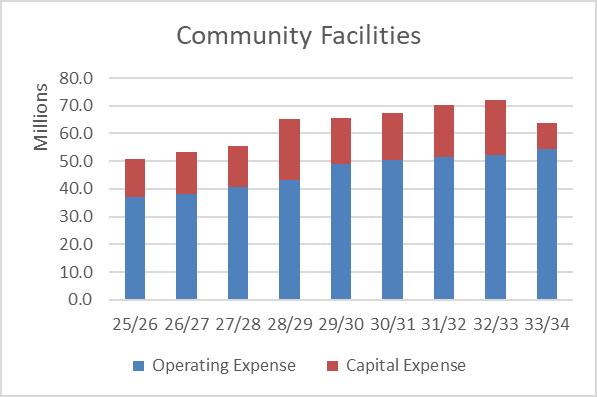
Growth/level of service/renewals
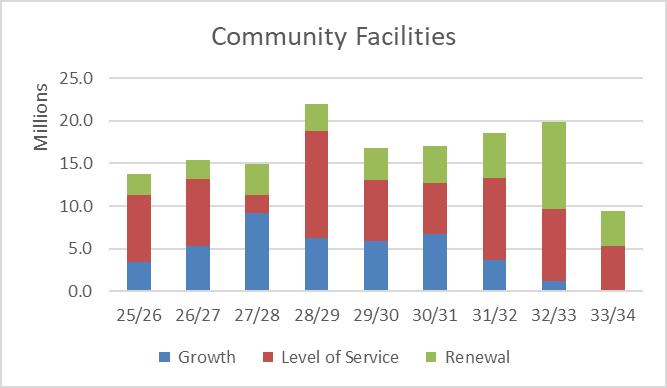
Community Services and Facilities capital expenditure
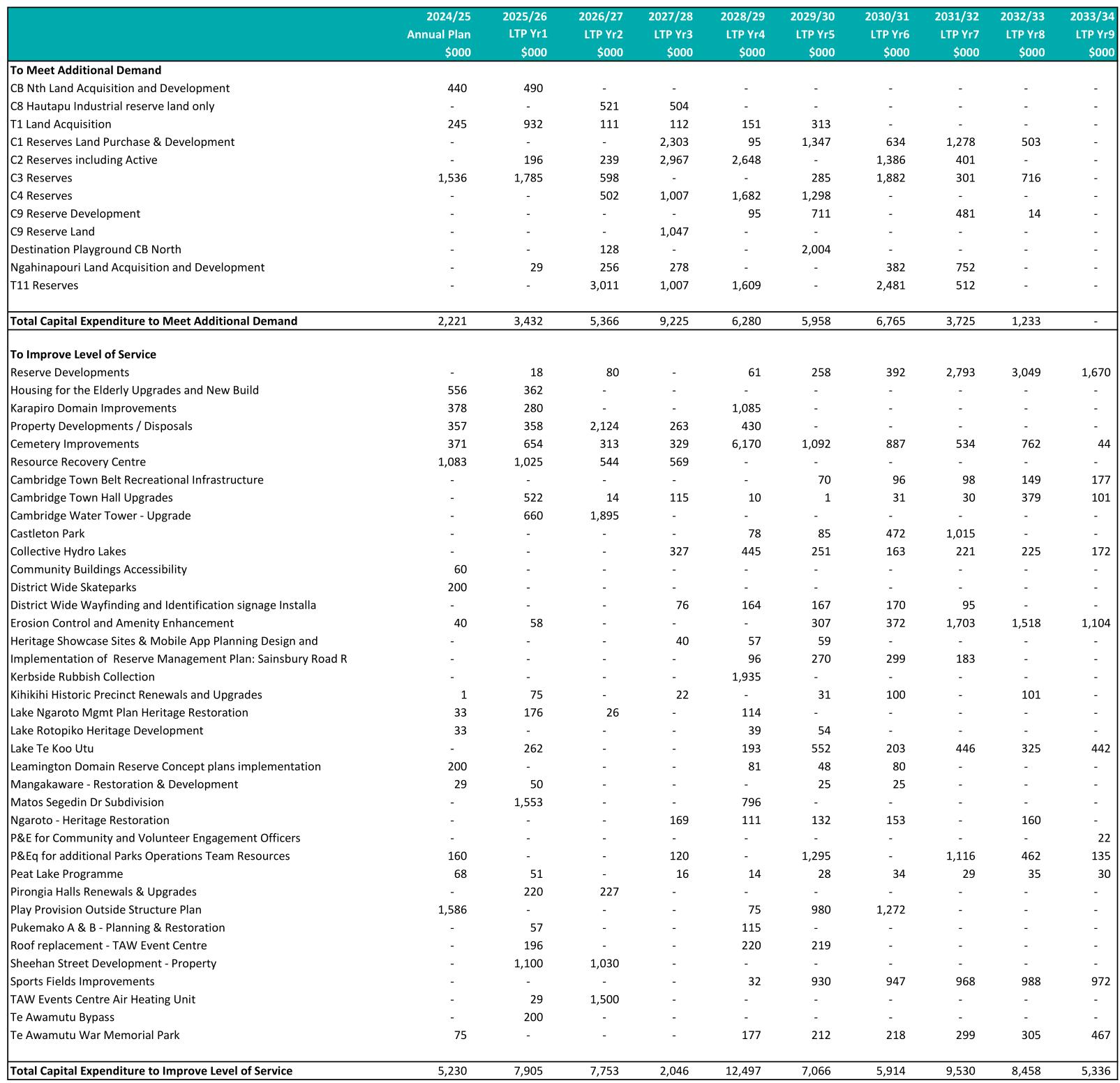

Community Services and Facilities funding impact statement
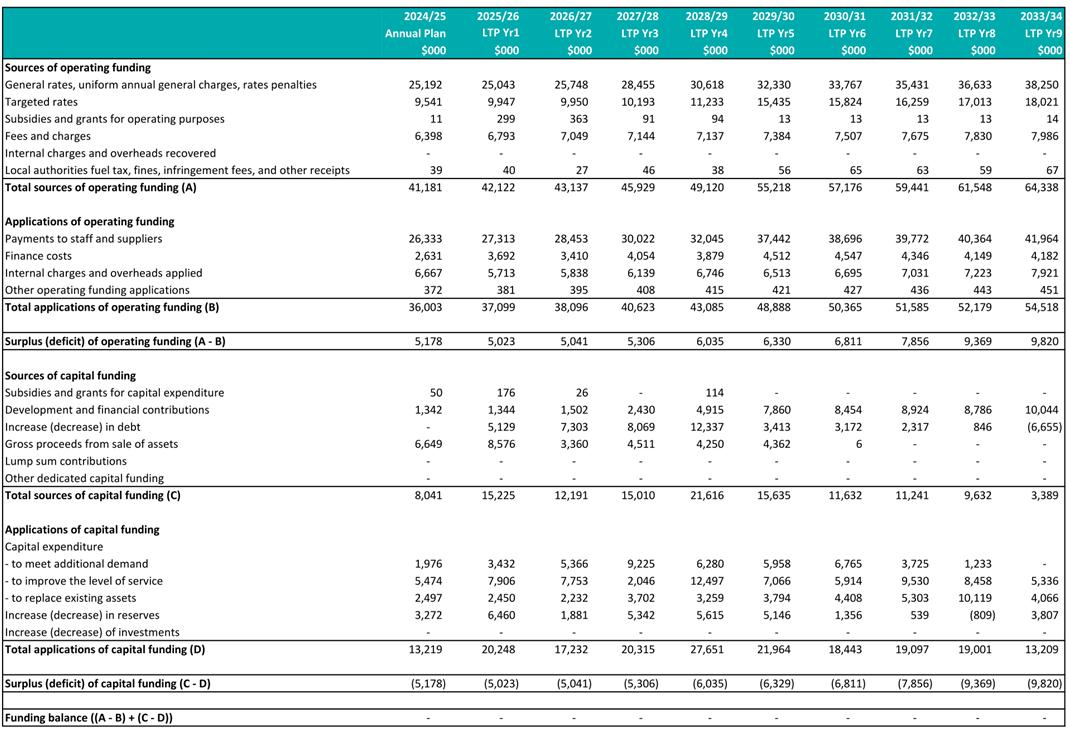
There are three activities in the Governance group of activities:
• Communications and Engagement
• Representation
• Strategy and Strategic Partnerships.
Community outcomes
This group of activities primarily contributes to these External Strategic Priorities:
Economically progressive
• Provide value for money from services, promotion and a great place to invest and do business.
• Financially sustainable decision-making.
Cultural champions
• Unique history cultural awareness.
• Tangata Whenua partnership.
• Respect cultural diversity.
Social wellbeing
• Great place to live, work and play and invest.
• High quality of life.
• Invest in health and well-being and support community groups.
Potential significant negative effects
The following significant negative effects may occur as a result of this activity:
Risk
Some sectors of the community may be under-represented.
We engage with the community in several ways to ensure a wide range of views are taken into account and targeting as many key stakeholders and members of the community as possible through our Communications Strategy.
Some sectors of the community may be more difficult than others to be kept informed of Council’s activities and plans.
Engagement plans will include efforts to ensure the community is as well informed as possible.
We undertake meaningful engagement with our communities by:
• getting information out to the right people at the right time on what’s happening and why;
• providing updates on our services, projects and activities;
• enabling great working relationships between Council, partners, stakeholders and communities;
• listening to the aspirations of the people we represent.
We also create opportunities for the community to have their say, provide feedback and get involved in Council’s decision-making processes.
This activity also supports events in our district to enhance vibrancy and encourage a strong economy.
• To keep our communities informed about Council issues and activities and make it easy for them to be involved in our decision-making processes.
• To showcase Waipā District as a great place to live, work, play and invest creating pride in the district.
What’s planned for the next nine years
Opportunities for participative democracy will be explored as appropriate.
Levels of service and performance measures
We provide regular communication to the district enabling community sharing and engagement.
Respondents to the resident’s perception survey who know where to find the latest information on Council activities and services. 24
The percentage of growth of followers or subscribers to Council’s digital channels. 25
24
25
We showcase how we’re building champion communities to support creating pride in the district.
Overall per cent of respondents to residents’ perception survey who have pride in their district. 26
We provide community grants to organisations and community groups on an annual basis. These include the Cambridge and Te Awamutu Citizens Advice Bureau, the Cambridge and Te Awamutu Safer Community Charitable Trusts and the Cambridge Museum. The funding of these has been included in the relevant group of activities (note these numbers are shown in real value terms, no level of rounding applies).
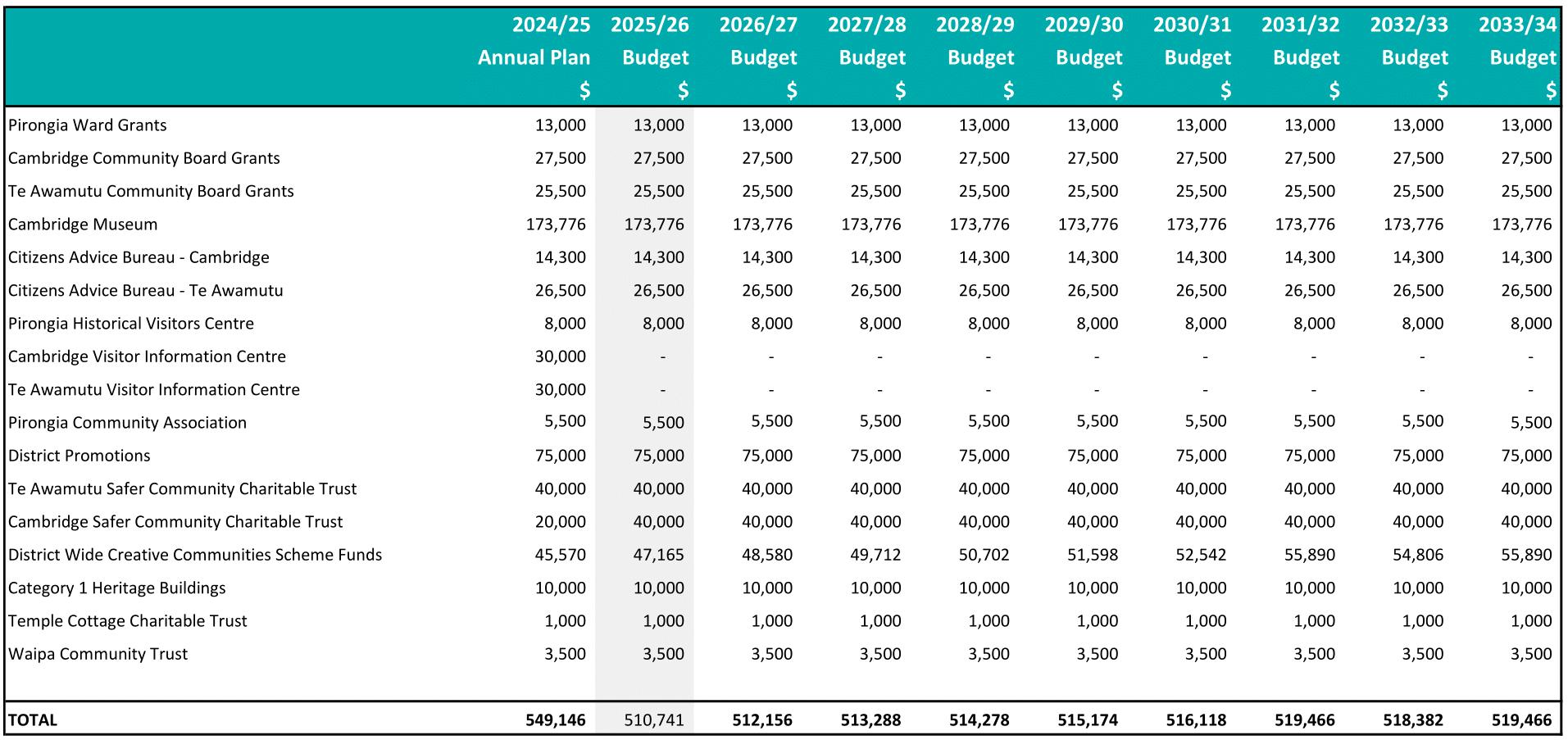
This activity supports the Mayor and Elected Members through the provision of advice and administrative support as well as facilitating Council and committee meetings. Support is also provided to the district’s two community boards and one ward committee. This activity also organises local government elections.
26 From Waipā District Council Annual Resident Perception Survey result. Satisfied are those per cent of individuals who scored Council an 8-10 on the ten-point survey scale. Full working of question: ‘How proud do you feel to be able to say that you live in this district?’.
This activity enables democratic, local decision-making by, and on behalf of, communities with the support provided helping elected members make robust decisions in the best interests of the community.
What’s planned for the next nine years
It will be business as usual for this activity including local body elections, undertaking representation reviews and organising Council and committee meetings.
The community has access to timely and accurate information.
Percentage of official information requests are responded to within statutory timeframes.
Percentage of respondents to resident’s perception survey 27 who are satisfied with Council ‘for being transparent and communicating openly’.
We provide opportunities for our communities to engage with Council and participate in decision-making processes.
Percentage of respondents to resident’s perception survey 28 who are satisfied with the opportunities provided to them to participate in Council decision making processes.
27 From Waipā District Council Annual Resident Perception Survey result. Satisfied are those per cent of individuals who scored Council an 8-10 on the ten point survey scale. Full working of question: ‘How would you rate Council for being transparent and communicating openly?’.
28 From Waipā District Council Annual Resident Perception Survey result. Satisfied are those per cent of individuals who scored Council an 8-10 on the ten point survey scale. Full working of question: ‘How satisfied are you with the opportunities provided to you to participate in Council decision making processes?’
What we do
This activity focuses on the development of strategies, plans, policies and bylaws including work on the Future Proof Strategy, Ahu Ake, Waipā Community Spatial Plan, and the development of long term plans and annual plans.
The activity also provides the ability for the community to engage with Council on the plans and decisions we make for the district, helps support economic development in the district, drives the implementation of an improvement programme plan relating to climate change and enhances Council’s capability and capacity to effectively partner with mana whenua and iwi.
Why we do it
This activity ensures that we successfully deliver on the aspirations and priorities of our communities. Through the information we provide, our residents are given the opportunity to influence decision making and understand whether our strategies, plans, policies and bylaws are achieving their intended objectives.
What’s planned for the next nine years
• Implement Ahu Ake, Waipā Community Spatial Plan
• Review of our Growth Strategy, Waipā 2050
• Review of the Te Awamutu and Kihikihi Town Concept Plan
• Development of village concept plans for Ōhaupō and Karāpiro
• Work with Future Proof to progress the Waipā North/Hamilton South spatial study
• Finalise and implement the Economic Wellbeing Strategy
• Implement the Anchor Institution Framework
• Develop and implement the Tangata Whenua Partnership Framework
• Develop long term plans and annual plans
• Continue to review policies and bylaws as required.
Levels of service and performance measures
There are no performance measures for this activity.
Capital and operating investment

Growth/level of service/renewals

Governance capital expenditure

Governance funding impact statement
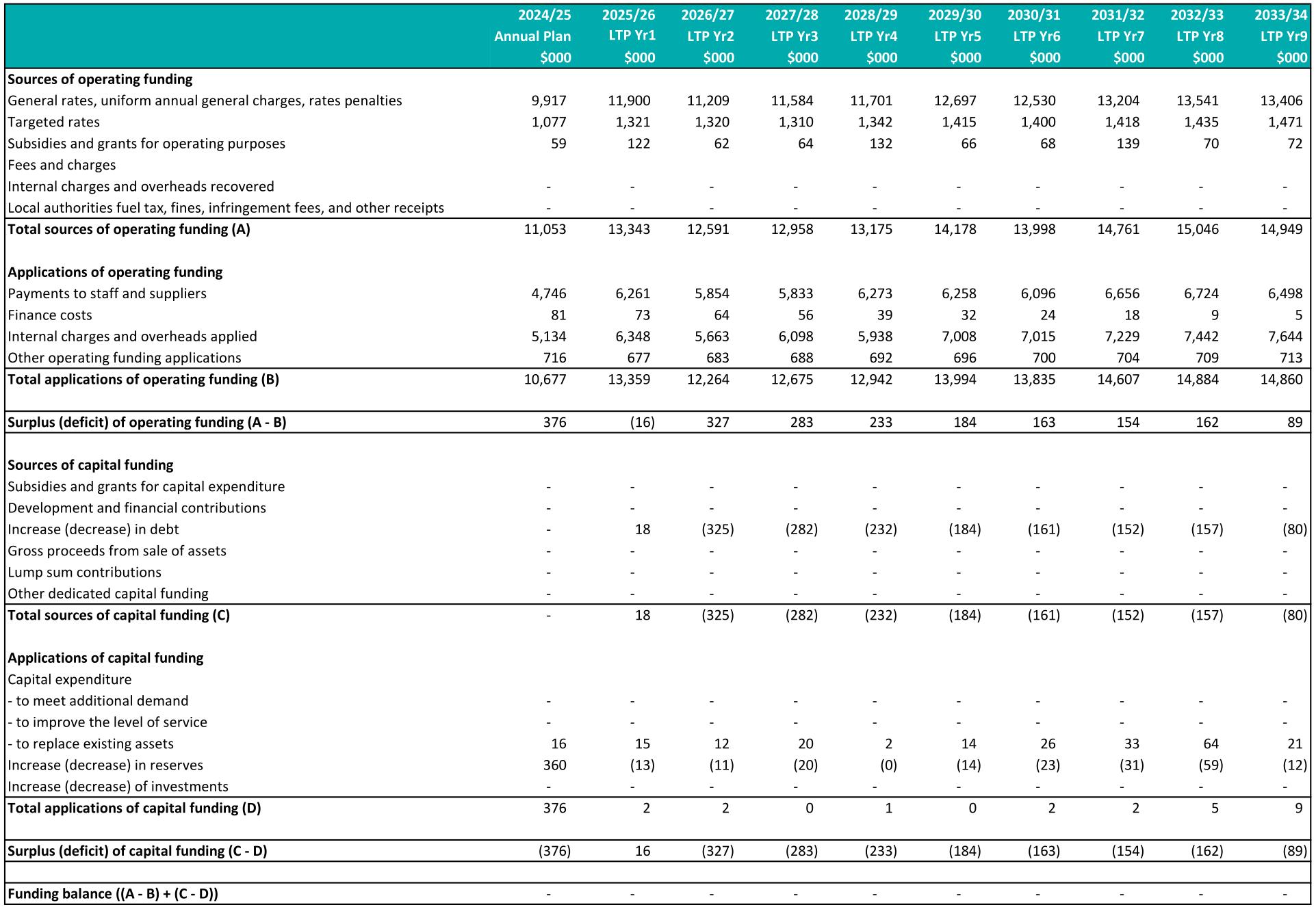
There are five activities in the Planning and Regulatory group of activities:
• Animal Control
• Building Compliance
• Development Engineering
• Environmental Health
• Resource Consents, Enforcement and Land Information Memoranda.
Community outcomes
This group of activities primarily contributes to these External Strategic Priorities:
Environmental champions – protect and sustain the environment
• Promote awareness and responsibilities.
• Responsive to climate change.
Cultural champions – promote culture and heritage
• Unique history;
• Cultural awareness.
Social wellbeing – all about the people
• High quality of life.
Potential significant negative effects
The following significant negative effects may occur as a result of this activity:
Failure to comply with resource consents leading to adverse environmental effects.
Processing time for resource and building consents may be considered excessive by applicants.
The cost of complying with regulatory requirements may be seen as excessive.
Having a programme for the regular monitoring of resource consents.
Striving to meet legislative timeframes.
Ensuring that fees and charges are both actual and reasonable.
Regularly monitoring the effectiveness and efficiency of our systems and processes.
What we do
This activity involves dog registration, responding to complaints related to dogs, impounding dogs, owner education, patrols and wandering stock on roads.
Why we do it
To ensure animals are kept in a way that promotes animal welfare and community safety.
What’s planned for the next nine years
• The building of a new pound facility in Cambridge is scheduled for 2026/27
• Ongoing maintenance of the Kihikihi pound facility
• New dog bins and related infrastructure will be introduced to new off-leash areas
Levels of service and performance measures
Animal control is managed in a way that ensures support is provided to both animals and the community in a timely manner. The percentage of urgent dog attack allegations acted upon within one hour of Council being notified. 29
What we do
The Building Compliance activity covers the processing and monitoring of building consents and the issuing of Code of Compliance Certificates pursuant to the Building Act. It also covers the monitoring and enforcement of earthquake-prone building requirements, building warrant of fitness and compliance schedules.
Why we do it
To ensure buildings and swimming pools are safe for the community and related regulations and standards are met.
29 Urgent is defined as a dog attack on a human or other animal where the Council has been notified within 12 hours of the event. Acted upon is defined as a phone call or site visit.
What’s planned for the next nine years
This activity will continue to provide monitoring, processing, and enforcement activities to ensure the safety of the community. Responding to Government legislative changes will therefore be required.
We ensure that buildings, including earthquake prone buildings, are safe and fit for purpose.
Building consent applications are processed within statutory timeframes. 30
What
Development Engineering provides a core regulatory function that manages the effects related to Council’s infrastructure or infrastructure that may be provided to Council through a development. Ways in which Development Engineering manages this function include the following:
• Evaluating and providing engineering input to subdivision and related land use developments
• Monitoring the compliance of engineering resource consent conditions
• Overseeing the road naming process
• Allocating property road numbers, and;
• Regulating the use and connections to roads.
This activity also includes district growth which provides technical support to development engineering, other departments within Council and the development community to ensure proposed developments are in alignment with council’s strategies. They also undertake the infrastructure management for complex, large scale or out of sequence developments.
The management and implementation of the Development Contributions Policy and preparation and management of development agreements also sits within this activity Development contributions are charges which Council imposes to ensure the costs of enabling the growth are tied to enable of the development that occurs from a lodged consent. Development agreements are contracts that developers voluntarily enter into with the Council. They are only entered into when it is in the best interest of all parties and all parties agree. These agreements can cover various matters related to the Council's growth infrastructure investment, which is necessary for the development to occur. Agreements may include providing, supplying, or exchanging infrastructure and/or land or set terms for payment of network infrastructure costs.
30 The Building Act 2004 states the time limit is ‘within 20 working days after receipt by the building consent authority of the application’.
Why we do it
To ensure the community and Council benefits from appropriate standards of development and infrastructure.
What’s planned for the next nine years
The Development Engineering activity will continue with business as usual.
Levels of service and performance measures
What we do
The Environmental Health activity covers general public health inspections, responding to public health complaints, the licensing and the inspection of hairdressers and food, alcohol outlets and other businesses. A 24-hour, seven day a week service is also provided for any excessive or unreasonable noise.
Why we do it
To ensure the promotion and protection of our community’s health and related regulations and standards are met.
What’s planned for the next nine years
This activity will be focusing on the backlog of alcohol licence applications with dedicated resourcing.
31 Responded to is defined as contact with the requestor (could include email, phone call or visit) to advise the outcome or findings of the investigation into the enquiry.
We ensure the public sale and supply of alcohol is undertaken safely and responsibly.
Noise and smoke control is provided to the community in a timely manner.
All premises that sell alcohol are licensed.
Percentage of excessive noise complaints
1 hour.
Food premises maintain a high level of food safety.
All premises that sell food to the public are registered.
What we do
This activity includes the processing and monitoring of resource consents and other resource management applications. This is carefully managed through the District Plan which is the key document defining how and where Waipā grows. In addition, it includes providing Land Information Memoranda, enforcement of the District Plan and certain bylaws, and the inspection of swimming pool barriers.
Why we do it
Resource consents and monitoring - continuing to build a sustainable thriving economy based upon the district’s unique characteristics and building a community that is proud of Waipā’s physical and cultural environment.
Land information memoranda – to provide relevant information to property owners and potential owners about property and any associated buildings to help inform their decisions.
What’s planned for the next nine years
This activity will largely be business as usual however, there is likely to be significant change due to resource management reform.
We respond to all general enquiries and process all applications within agreed timeframes.
Percentage of resource consents processed within statutory timeframes.
Percentage of LIMs processed within statutory timeframes.
Percentage of requests for general resource consent information and planning enquiries responded to within 10 working days.
We ensure we investigate compliance with the District Plan when requested.
We complete the required safety inspections of swimming pools and associated fencing.
We respond 32 to requests to check compliance with the District Plan and land use consents within 4 working days.
The percentage of residential pool barriers inspected in the last three years. 33
32 Responded to is defined as contact with the requestor (could include email, phone call or visit) to advise the outcome or findings of the investigation into the enquiry.
33 The Building Act requires all residential pool barriers to be inspected at least every 3 years for compliance.
Capital and operating investment

Growth/level of service/renewals
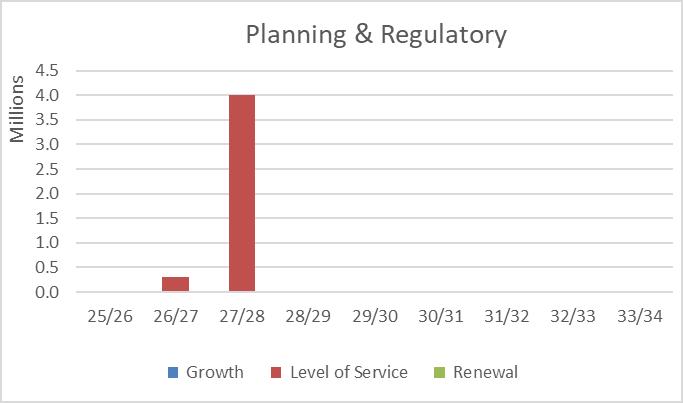
Planning and Regulatory capital expenditure
Planning and Regulatory funding impact statement
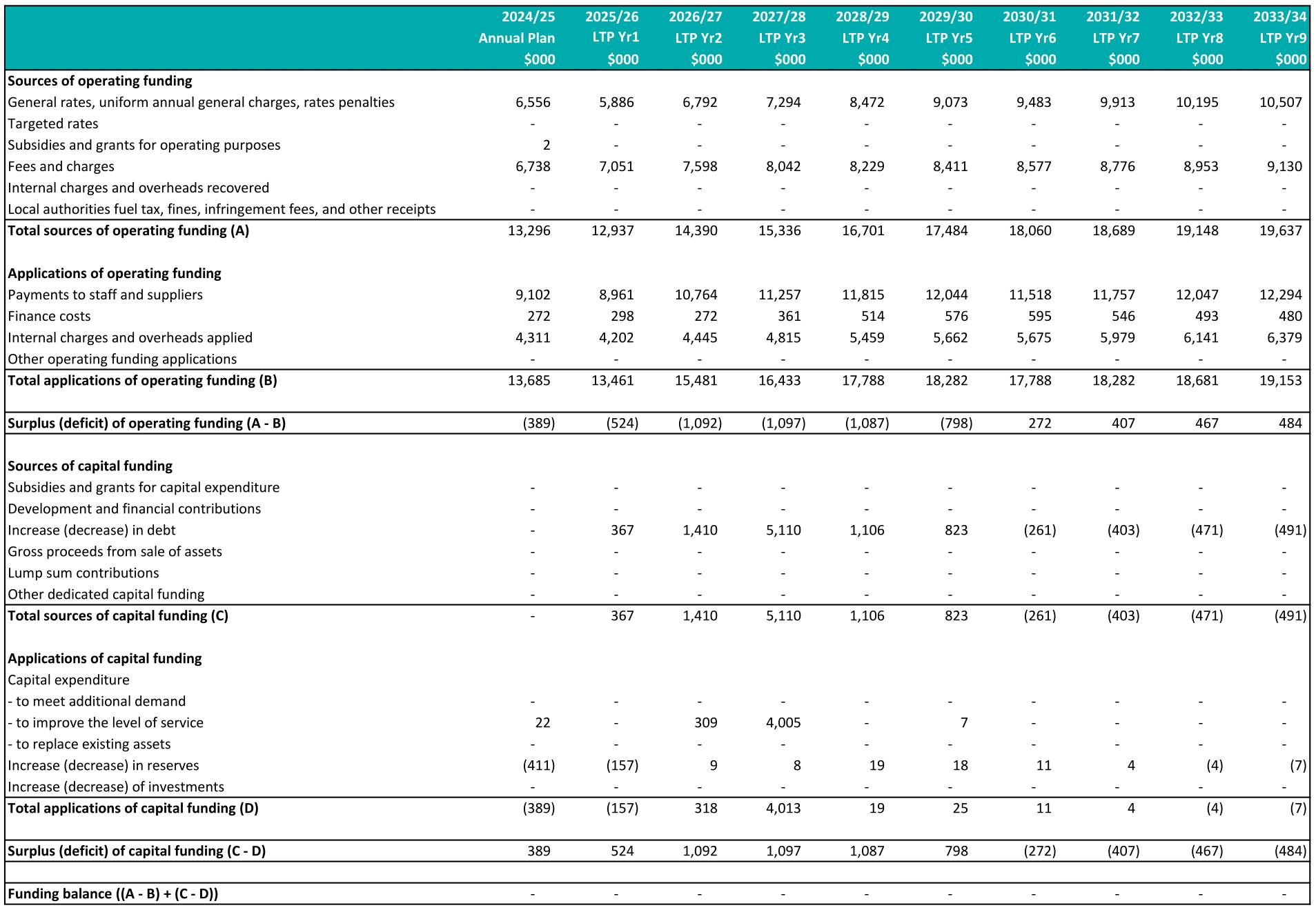
What we do
This activity is responsible for the district road network which covers 1,131km of sealed and unsealed roads, bridges, large culverts and structures such as retaining walls and bus shelters. We also have 40km of cycleways, 276.6km of surfaced footpaths, streetlights and lighting in amenity areas such as carparks.
This activity is also about developing and maintaining town and village centre streets and paths, managing a large number of carparks in CBD areas, sporting facilities, reserves and community areas.
Road safety is also an important part of this activity and includes the implementation of speed management, intersection improvements, addressing deficiencies in the network and road safety education.
Why we do it
To ensure the ongoing provision of an adequate local transport network that supports the transportation of people, goods, and services as an integral part of everyday community activity.
What’s planned for the next nine years
• Maintaining our currents roads and transport assets
• Continuing the development of the Cambridge Connections project
• Further expansion of public transport across the district, and;
• Integrating new residential and industrial growth areas with upgraded intersections and walking and cycling connections.
Community outcomes
This group of activities primarily contributes to these External Strategic Priorities:
Socially wellbeing – all about the people
• High quality of life.
Environmental champions - protect and sustain the environment
• Responsive to climate change.
Economically progressive – support a thriving and sustainable economy
• Financially sustainable decision-making.
• Provide economic stimulus through new infrastructure.
• Provide value for money from services, promotion and a great place to invest and do business.
Cultural champions promote culture and heritage
• Tangata whenua partnerships
Potential significant negative effects
The following significant negative effects may occur as a result of this activity:
Poorly planned transport networks can result in congestion, wasting time and money for users, noise pollution, air pollution (including carbon emissions), accidents, and injuries and visual disturbance.
Road construction can cause erosion, damage to flora and fauna, noise, pollution, and impacts on places of cultural, historical, and archaeological importance.
Run off from road surfaces may contain pollutants.
The Transport Strategy 2022-52 aims to ensure that transport infrastructure and land use planning are tightly integrated.
Managing potential risks through adhering to industry best practice and by ensuring contractors are suitably qualified.
Involving mana whenua in planning projects so cultural impacts are understood and mitigated appropriately.
Managing sensitive urban environments through the design and operation of our stormwater system.
Levels of service and performance measures
Roads and road usage is managed to reduce the risk of harm to users.
Fatal and serious injuries per 100m vehicle kilometres travelled.
The change from the previous financial year in the number of fatal and serious injury crashes on the local road network. [M]
Provision of road and footpath networks which The percentage of the sealed local road network that is resurfaced. 34 [M]
The percentage of footpaths whose condition meets the
34 As compared to the average annual target set in the Asset Management Plan (82.6 centre line km per year).
support usability and user comfort. both now and in the future.
We are responsive to roading issues raised by the community
desired minimum standard for condition 35 [M] Length (km) of network which remains unsealed.
The percentage of vehicle kilometres travelled on smooth sealed local roads. 36 [M]
The percentage of customer service requests relating to roads and footpaths responded to within the time frame specified in the long term plan 37 [M]
Alternative transport options are available and user friendly Usage of the ratepayer funded passenger transport services
[M] = DIA mandatory measure
35 Full wording of mandatory measure is: The percentage of footpaths within a territorial authority district that fall within the level of service or service standard for the condition of footpaths that is set out in the territorial authority’s relevant document (such as its annual plan, activity management plan, asset management plan, annual works program or long term plan). For Waipā District Council, this is based on a five point scale (excellent, good, average, poor and very poor) the percentage will be the length of footpath recorded as average, good or excellent condition grade.
36 Full wording of mandatory measure is: The average quality of ride on a sealed local road network, measured by smooth travel exposure.
37 Full wording of mandatory measure is: The percentage of customer service requests relating to roads & footpaths to which the territorial authority responds within the time frame specified in the long term plan - 10 working days.
38 Te Awamutu and Cambridge services to Hamilton
39 Defined as cycleways which are within the road corridor, but which are separate to the actual road, this includes cycleways which are designed to be shared by pedestrians and mobility device users.
Capital and operating investment

Growth/level of service/renewals
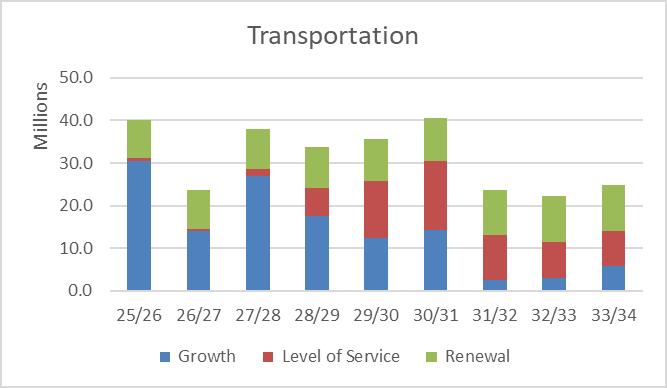

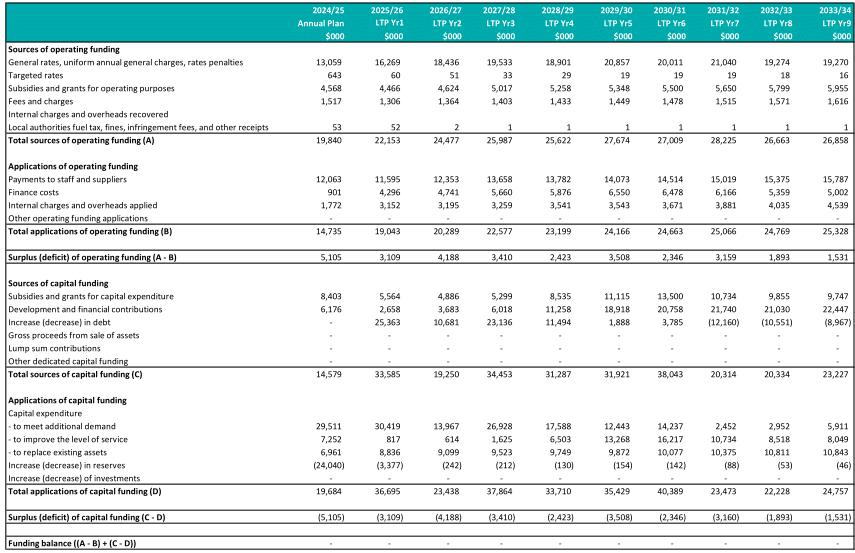
There are two activities in the Support Services group of activities:
• Customer Support;
• Information Services.
Community outcomes
This group of activities primarily contributes to:
Economically progressive – support a thriving, sustainable economy
• Provide value for money from services and promotion;
• A great place to invest and do business.
• Financially sustainable decision-making.
Environmental champions - protect and sustain the environment
• Support programmes.
Social wellbeing– all about the people
• High quality of life.
• Great place to live, work and play and invest.
Potential significant negative effects
The following significant negative effects may occur as a result of these activities.
An information technology system failure or cybersecurity breach impacts Council operations and restricts the community’s access to information.
Council mitigates against cyber-security risk by implementing up to date firewalls, anti-virus software operating system patching, and by having policies aligned with best practice security controls. A regular hardware, software and network renewal programme reduces the risk of vulnerability to attack.
This activity is responsible for ensuring customers receive excellent support and includes key tasks such as providing information to customers, logging customer requests, and processing payments. We continually look for opportunities to make it easier for customers to do business with Council.
Why we do it
To provide a responsive and supportive customer service to our community.
What’s planned for the next nine years
Improving the organisation focus on Customer Experience as we transition into our digital roadmap for customers to do more online self-service interactions.
The community has enquiries completed at first resolution provided by Customer Support.
The community has a positive experience when contacting Council.
Percentage of query calls received by Customer Support resolved at the time.
Percentage of query emails received by Customer Support resolved at the time.
Percentage of respondents to residents’ perception survey who are satisfied with how their enquiry or complaint has been handled. 40
What we do
The Information Services activity:
• Advises and implements business solutions to support Council and its people’s needs;
• Maintains and operates Council’s technology infrastructure, including the Technology One stack;
• Supports Council’s business applications such as finance, rates, payroll and online services;
• Provides advice on security and risk management.
Why we do it
To provide convenient and reliable digital contact channels for customers.
What’s planned for the next nine years
It will be business as usual for this activity over the next nine years.
40 From Waipā District Council Annual Resident Perception Survey result. Satisfied are those per cent of individuals who scored Council an 8-10 on the ten point survey scale. Full working of question: ’Overall, how satisfied are you with how your complaint or query was handled?’.
Financial overview Capital and operating investment

41 www.waipadc.govt.nz and eservices.waipadc.govt.nz sites only.
Growth/level of service/renewals
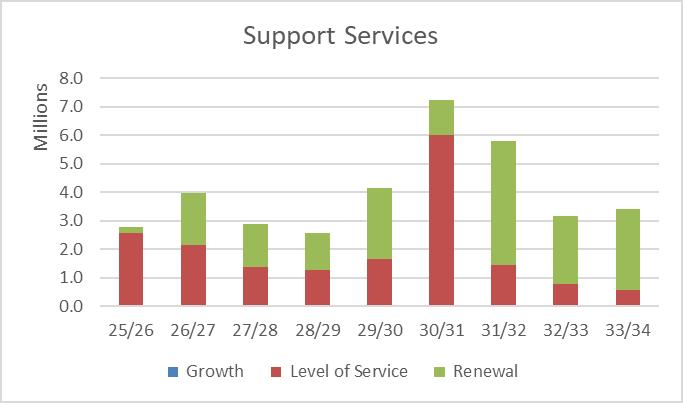

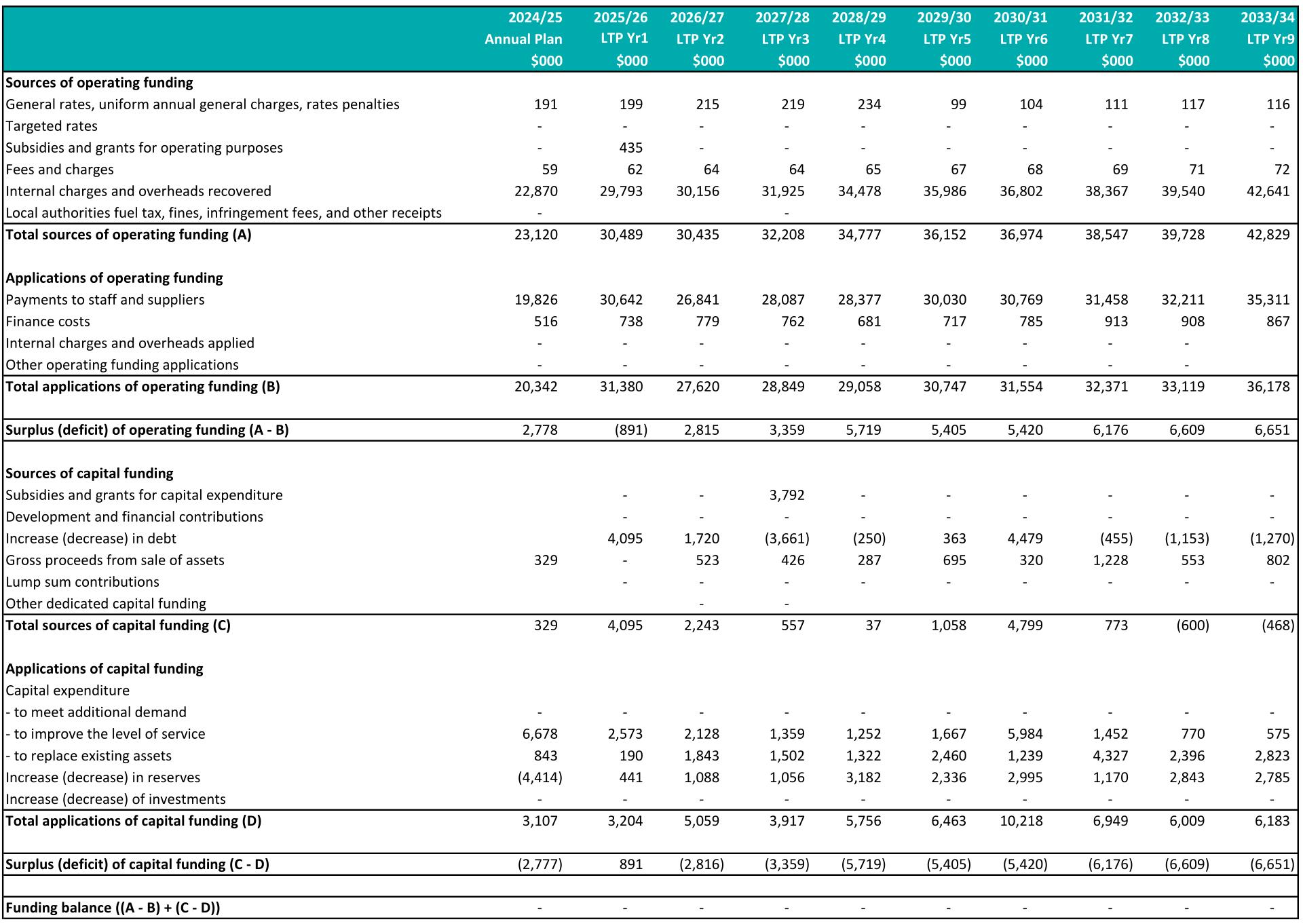
What we do
Council operates and maintains stormwater infrastructure across the district to limit the impact of flooding and to ensure that stormwater discharges to waterways are free from contaminants. Assets include pipes, manholes, and other related structures such as open drains, swales, soak systems, and retention structures.
Why we do it
To ensure the adverse effects of stormwater run- off and flooding on the community and the environment are minimised.
What’s planned for the next nine years
The stormwater work programme will focus on the implementation plan required under Council’s new Waikato Regional Council consent for urban stormwater discharge. The activities in the plan are aligned to Council’s catchment management plans and will aim to mitigate contaminant risks and enhance the quality of discharge to the environment, as well as minimise environmental issues resulting from the discharges, for example, stream erosion and/or effects on flora and fauna resulting from rate of discharge.
Issues associated with Council maintaining the stormwater level of service will also be dealt with over the life of the plan, especially in areas where flood mapping identified dwellings at risk of flooding.
Note - there are no variations in this LTP from what's presented in Water and Sanitary Services Assessment 2024.
Community outcomes
This group of activity primarily contributes to these External Strategic Priorities:
Economically progressive – support a thriving, sustainable economy
• Provide value for money from services and promotion;
• A great place to invest and do business.
Environmental champions - protect and sustain the environment
• Promote awareness and responsibilities.
Social wellbeing– all about the people
• High quality of life.
The following significant negative effects may occur as a result of this activity:
Contaminated stormwater from runoff or spillage could impact on the groundwater and river water.
These are managed through network design and resource consents, which include regular street sweeping, monitoring storm water quality, and investigating the sources of contaminants. Poor management of the stormwater system and large rainfall events can lead to flooding, which can affect people and property.
To help alleviate this, secondary flow paths are used to reduce the risk of household damage, and we have emergency plans in place to respond to flooding.
Provision of a safe and reliable stormwater system, which minimises flooding and environmental impact in a way that is most cost- effective.
The number of complaints (per 1,000 properties connected) received about the performance of the stormwater system. 42 [M]
Compliance with the resource consents for discharge from the stormwater system. 43 [M]
of abatement notices
of
The number of flooding events in the district. 44 [M]
42 Full wording of mandatory measure is: The number of complaints received by a territorial authority about the performance of its stormwater system, expressed per 1000 properties connected to the territorial authority’s stormwater system.
43 Full wording of mandatory measure is ‘Compliance with the territorial authority’s resource consents for discharge from its stormwater system, measured by the number of: (a) abatement notices; and (b) infringement notices; and (c) enforcement orders; (d) successful prosecutions, received by the territorial authority in relation to those resource consents’.
44 Full wording of mandatory measure is: The number of flooding events that occur in a territorial authority district.
For each flooding event, the number of habitable floors affected (per 1,000 properties connected). 45 [M]
The median response time (hours) to attend a flooding event from the time that notification is received. 46 [M]
Financial overview
Capital and operating investment

45 Full wording of mandatory measure is: For each flooding event, the number of habitable floors affected (expressed per 1000 properties connected to the territorial authority’s stormwater system).
46 Full wording of mandatory measure is: The median response time to attend a flooding event, measured from the time that the territorial authority receives notification to the time that service personnel reach the site.
Growth/level of service/renewals


Stormwater funding impact statement

Wastewater from toilets, bathrooms, laundries, kitchens and trade waste (from commercial and industrial facilities), is collected and managed by wastewater assets consisting of over 317 kilometres of pipes, 4831 manholes, 60 pump stations, and two treatment plants. Council is also responsible for ensuring wastewater is treated and disposed of in a way that minimises potential harm to the environment, consistent with the requirements of Waikato Regional Council (WRC) resource consents, legislation, and our sustainable development approach.
To ensure the community and the environment are protected from the adverse effects of wastewater.
Major projects to be undertaken over the next nine years include:
• Local Water Done Well – a Water Services Plan will be delivered to the Government by September 2025 setting out how we intend to operate in the future;
• The Cambridge Wastewater Treatment Plant upgrade will continue as required by Council’s WRC consent and associated stakeholder and sub -regional commitments;
• Wastewater asset renewals as they reach the end of their useful life; and
• Te Awamutu Wastewater Treatment Plant stage 4 upgrade to service growth and meet WRC consent condition requirements.
Note - there are no variations in this LTP from what's presented in Water and Sanitary Services Assessment 2024.
Community outcomes
This group of activities primarily contributes to:
Social wellbeing – all about the people
• High quality of life.
Cultural champions – promote culture and heritage
• Tangata whenua partnerships.
Economically progressive – support a thriving and sustainable economy
• Provide economic stimulus through new infrastructure.
• Provide value for money from services and promotion and a great place to invest and do business.
Environmental champions - protect and sustain the environment
• Responsive to climate change.
Potential significant negative effects
The following significant negative effects may occur as a result of this activity:
Risk How we are addressing this Discharge and overflows from the wastewater network pose health, safety, economic, and environmental risks.
Ensuring compliance with discharge consent conditions and through ensuring compliance with appropriate New Zealand standards.
Responding promptly to odour complaints and sewage spills.
Provision of a safe and reliable system for the treatment and disposal of wastewater, which minimises public health risks and environmental impact, in a way that is most costeffective.
The number of dry weather sewerage overflows. 47 [M]
Compliance with consents for discharge from the sewerage system. 48
Number of abatement notices [M]
Number of infringemen t notices [M]
Number of enforcemen t orders [M]
Number of convictions [M]
The median response time for call outs in response to a sewerage overflow. 49
The time (hours) from notification for service personnel to reach the site. [M]
The time (hours) from notification that resolution of a blockage or other fault. [M]
The number of complaints per 1,000 sewage connections.
47 Full wording of mandatory measure is: The number of dry weather sewerage overflows from the territorial authority’s sewerage system expressed per 1000 sewerage connections to that sewerage system.
48 Full wording of mandatory measure is Compliance with the territorial authority’s resource consents for discharge from its sewerage system measured by the number of: (a) abatement notices, (b) infringement notices, (c) enforcement orders, (d) convictions received by the territorial authority in relation to those resource consents
49 Full wording of mandatory measure is: Where the territorial authority attends to sewerage overflows resulting from a blockage or other fault in the territorial authority’s sewerage system, the following median response times measured: (a) Attendance time: from the time
Capital and operating investment

Growth/level of service/renewals

that the territorial authority receives notification to the time that service personnel reach the site, (b) Resolution time: from the time that the territorial authority receives notification to the time that service personnel confirm resolution of the blockage or other fault.
Wastewater Treatment and Disposal capital expenditure
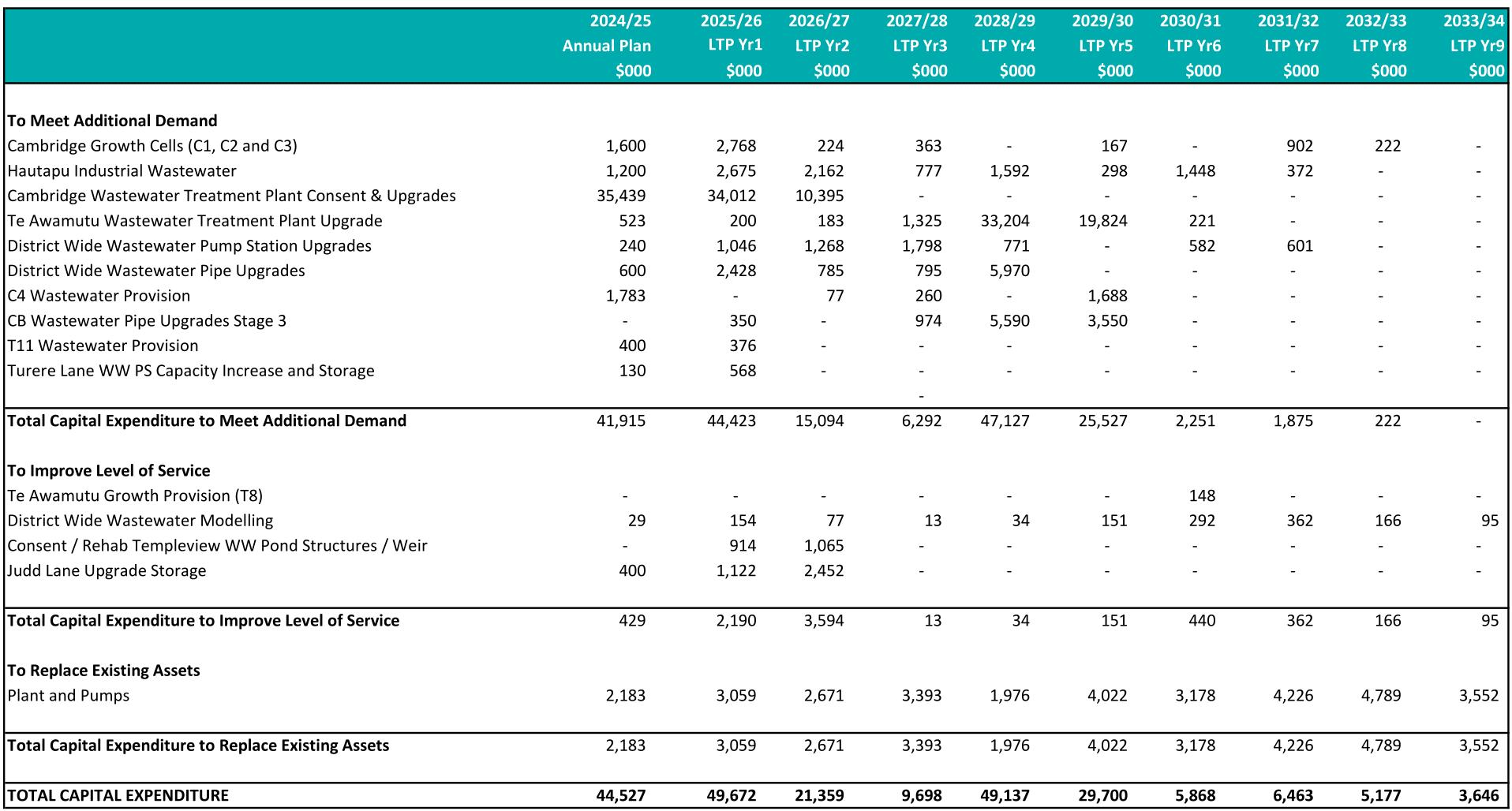
Wastewater Treatment and Disposal funding impact statement

What we do
This activity is about the provision of clean, reliable, and safe drinking water to the district. Reticulated water supplies are distributed to Cambridge, Te Awamutu, Kihikihi, Pirongia, Ōhaupō, Pukerimu and Karāpiro. Assets include six water treatment plants, 685km of water mains well as pump stations and reservoirs.
Why we do it
To ensure our community benefits from the ongoing provision of potable water.
What’s planned for the next nine years
The major projects planned for the next nine years include:
• Local Water Done Well – a Water Services Plan will be delivered to the Government by September 2025 setting out how Council intends to operate in the future.
• Alpha Water Treatment Plant upgrade - renewal of the old plant, upgrading for additional treated flow capacity. This upgrade will assist with the provision of water for firefighting and summer peak water demand.
• Upgrade and renewal of various reservoirs in the district due to age, lack of seismic resilience, and also to ensure sufficient (increased) storage capacity particularly in Cambridge to service growth.
• Water asset renewals as they reach the end of their useful life.
Note - there are no variations in this LTP from what's presented in the Water and Sanitary Services Assessment 2024.
Community outcomes
This group of activities primarily contributes to:
Economically progressive – support a thriving and sustainable economy
• Financially sustainable decision making.
• Provide economic stimulus through new infrastructure.
• Provide value for money from services and promotion and a great place to invest and do business.
Economically progressive – support a thriving and sustainable economy
• Responsive to climate change.
Cultural champions – promote culture and heritage
• Tangata whenua partnerships.
Social wellbeing – all about the people
• High quality of life.
Potential significant negative effects
The following significant negative effects may occur as a result of this activity:
Risk How we are addressing this System failure, contamination, or vandalism could lead to disruption of service, environmental damage, or public health risk.
Holding resource consents regarding water abstraction and water meters are intended to contribute to behaviour changes for improved water conservation and to help pinpoint losses in the reticulation system.
Water Safety Plans and Incident Management Plans are in place for each area and telemetry systems provide early warnings of issues. Increasing demand due to population increase and drought events may have adverse environmental effects on supply sources.
Built-in redundancy is in place in Council’s system and our asset management and renewal programmes ensure infrastructure is fit-for-purpose.
A programme is in place that actively promotes water use education and conservation.
Levels of service and performance measures
The community is provided with safe and wholesome drinking water within specified areas in a way that is most costeffective.
The extent to which the local authority’s drinking water supply complies with the following parts of the drinking water quality assurance rules:
4.10.2 T3 Protozoa l Rules [M] Alpha Street Treatment Plant
Frontier Road Treatment Plant
Karāpiro Treatment Plant
Parallel Road Treatment Plant
Rolleston Street Treatment Plant
Te Tahi Treatment Plant
4.11.5 D3.29 Microbiol ogical Monitori ng Rule [M]
Cambridg e Distributio n Zone
Kihikihi Distributio n Zone
Pirongia Distributio n Zone
Pukerimu (incl. Ōhaupō) Distributio n Zone
Te Awamutu Distributio n Zone
The community is provided with safe and wholesome drinking water within specified areas in a way that is most costeffective
Median response time for call outs in response to a fault or unplanned interruption to the network. 50
Attendance for urgent call- out from the time of notification. (hours). 51 [M]
Resolution of urgent call outs from the time of notification (hours) 52[M]
Attendance for nonurgent call outs from the time of notification (days). 53 [M]
Resolution of nonurgent call outs from the time of notification (days) 54 [M]
The total number of complaints (per 1000 connections) received about any of the following: Drinking water clarity, taste, odour, pressure or flow, continuity of supply, and the response to any of these issues. 55 [M]
The supply and demand are managed to ensure prudent use of water
The percentage of real water loss from the networked reticulation system. 56[M]
The
& Karāpiro
Te Awamutu & Pirongia
Kihikihi
Ōhaupō & Pukerimu
consumption of Cambridge & Karāpiro
50 Full wording is: Where the local authority attends a call-out in response to a fault or unplanned interruption to its networked reticulation system, the following median response time measured.
51 Full wording is: Attendance for urgent call-outs: from the time the local authority receives notification to the time that service personnel reach the site.
52 Full wording is: Resolution of urgent call-outs: from the time the local authority receives notification to the time service personnel confirm resolution of the fault or interruption.
53 Full wording is: Attendance for non-urgent call-outs: from the time the local authority receives notification to the time that service personnel reach the site.
54 Full wording is: Resolution of non-urgent call-outs: from the time the local authority receives notification to the time service personnel confirm resolution of the fault or interruption.
55 Full wording is: The total number of complaints received by the local authority about any of the following (expressed per 1000 connections to the local authority’s networked reticulation system): Drinking water clarity, drinking water quality, drinking water taste, drinking water odour, drinking water pressure or flow, continuity of supply, the local authority’s response to any of these issues.
56 Full wording is: The percentage of real water loss from the local authority’s networked reticulation system.
Financial overview
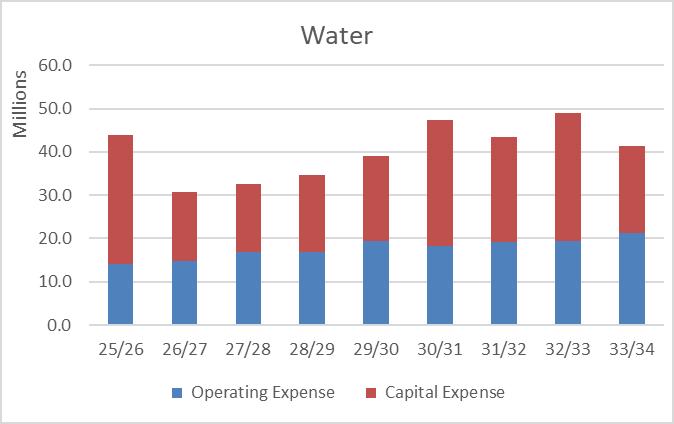
Capital and operating investment 57 Full wording is: The average consumption of drinking water per day per resident within the territorial authority district.
Growth/level of service/renewals
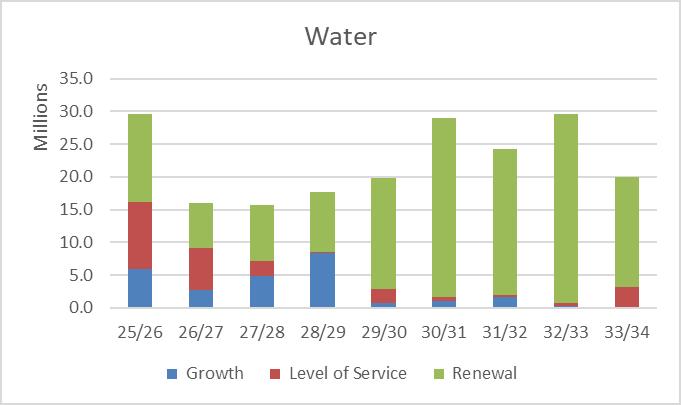

Water Treatment and Supply funding impact statement
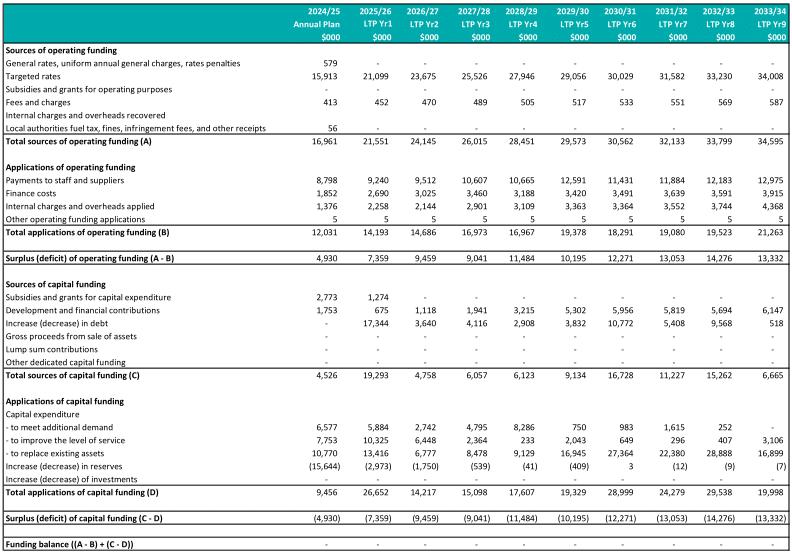

































































This Financial Strategy clearly outlines the financial vision and priorities for the next nine years.
It aims to ensure we are achieving a balance between the needs of our community, responsible management of our assets, and financial sustainability over the long term.
It provides guidance for Council’s financial decisions and a means to monitor our financial performance.
The budget for this Long Term Plan (LTP) has been developed to give effect to the priorities as agreed by Council. It honours the commitment to ensure we are meeting legislative requirements, maintaining current level of services, looking after our assets, and ensuring alignment with Ahu Ake – Waipā Community Spatial Plan, our blueprint for the district for the next 30+ years.
We also want to continue to give effect to our strategic priorities of:
• Creating vibrant communities
• Nurturing and respecting our unique culture and heritage
• Responding to climate change
• Caring for and valuing our environment now and in the future
• Effectively planning and providing for growing communities.
Operational efficiencies, changes in the timing of our renewal programme, and some project cuts have been required to ensure these priorities will be achieved and to mitigate the un-avoidable budget increases.
Further budgetary cuts would compromise these priorities.
Council is facing additional challenges being driven by central government changes to policy and legislative requirements. The biggest of these is the requirement for us to review the delivery of water services. For the purposes of this plan, the costs to operate, and maintain these critical infrastructure assets, are included for the full nine years until a decision is made on how they will be delivered into the future.
Post the Covid-19 pandemic, the whole of the country also faced significant inflation, interest rate and cost increases, which then led to a significant slowdown in the economy and in growth. Over the nine years covered by this strategy, we expect Waipā to experience high levels of growth particularly in non-residential areas.
This Financial Strategy has been adapted to respond to the challenges outlined, along with financial sustainability considerations, including the impact on rates and debt, to achieve the right balance.
We will continue to act prudently with the aim of striking a balance between limiting rates increases and ensuring Waipā is a great place to live, work, play and invest.
This Financial Strategy fixes our balance sheet to address previous funding shortfalls and sets us up for a more financially sustainable future. This will take time, and we will need to ‘stay on track’ to achieve this.
As a tier one growth Council, we have been required by successive governments to plan for growth, and that comes at significant cost. While growth pays for growth over time, we are required to put infrastructure in the ground to cater for development ahead of time. We only recoup the cost when sections go to market.
When you combine growth with a need to comply with legislative and markedly increased regulatory and environmental standards, we have had a history of underfunding water and wastewater activities through successive LTPs.
To keep rates lower in some years, we’ve used debt and ringfenced reserves, however, those reserves have been exhausted and debt is near its limit. To fix our balance sheet, we now need to not only rate for the full cost of these activities, but also to get the debt levels in our balance sheet into a sustainable position.
We annually monitor progress against six benchmarks, in accordance with the financial prudence regulations requirements.
Two of the six benchmarks relate to debt – debt servicing, which measures the percentage of net interest costs against total revenue, and debt affordability which sets a net debt ceiling.
We can currently borrow 3.5 times the amount of revenue we take. It has been recognised that for growth councils in particular, it is becoming more difficult to meet that benchmark. As a result, a bespoke increased borrowing limit of 3.5 times revenue was approved by our lenders, the Local Government Funding Agency (LGFA), with effect from 1 March 2025. We applied for this increased debt covenant so we can achieve our capital programme, retain affordable interest rates, and have an appropriate level of debt headroom. Without this increased covenant, increase to rates would need to be much higher to ensure we can meet the debt covenant provision given the level of debt that is required.
It makes sense for our financial prudence measure to be consistent with the covenant. In addition to this benchmark, Council has prepared this plan ensuring that it remains within a debt limit of 3.5 times revenue. This represents our approved borrowing limit. Additionally, the LGFA monitors our plan against a maximum planning debt limit of 3.3 times revenue. This planning limit is an agreed condition of our bespoke debt covenant. This in effect creates a buffer between what Council can plan for through the LTP (set at 3.3 times revenue) versus Council’s actual borrowing capacity of 3.5 times revenue.
For the purposes of this strategy, we have used the actual 3.5 debt covenant limit for year one to year six, in year seven this limit reduces to 3.3, in year eight to 3.1 and in year nine to 3.0.
We have more commentary on the debt servicing benchmark in the disclosure statement section of this strategy.
$0
We need to address our debt levels by increasing revenue
We fund our activities from a number of sources. Our forecast funding sources over the nine years is represented below.
A significant element of this Financial Strategy is ensuring we remain well within our debt covenant provisions. Increased revenue is a key factor to achieving this. In the waters activities we are having to increase revenue sharply in the first two years to comply with a net debt to revenue ratio limit of 5.0 times revenue for our water activities. This is what the limit will be if those activities move out to a separate entity.
We also need to ensure that across all our activities in our LTP are compliant with a net debt to revenue ratio limit of 3.5. This is what we refer to as fixing the balance sheet.
We need to address the compounding effect infrastructure investment decisions have had on the level of our debt and interest costs now. Over time, higher rates will be used to pay debt down faster, reducing interest costs. Our debt management approach will ensure rigorous checks and balances are in place across all investment decisions, particularly when made outside of a Long Term Plan or Annual Plan budget process. Accounting surpluses are largely due to non-cash revaluations and vested asset income. We will use additional revenue or cash surpluses to pay down external debt; while keeping a close eye on other organisational requirements.
Council considers this is the most fair and equitable approach to set a more sustainable financial position in the future. We don’t want to continue to ‘kick the can’ down the road and we can’t keep taking a short term or year by year approach to how we manage our finances. This will only create higher costs down the track. Other key changes from previous financial strategies are:
• Temporarily increasing the limit for the proportion of our income from rates to 75 per cent for the first three years, reducing to 65 per cent for the remaining period consistent with previous strategies.
• Focussing on one nine year plan rather than looking year by year.
• Providing rates predictability in the later years of this plan (consistent rates rise for the latter years (year 6 onwards) rather than fluctuating year on year).
A large portion of our projected revenue will be recovered via development contributions, particularly from year 4 onwards. Council is currently in the process of investing significantly into growth areas to ensure that our existing and new infrastructure can facilitate the current and projected growth. From year 4 onwards, Council will not be undertaking as many growth projects, but we will be in the recovery phase where infrastructure will have sufficient capacity to facilitate projected growth.
Population predictions for Waipā prepared by Te Ngira and Statistics New Zealand have estimated that population will increase significantly over the next nine years which will in turn drive the demand for residential, industrial, and commercial development. This will also result in increased development contribution revenue.
One third of the development contribution revenue will come from non-residential development, i.e. commercial and industrial development. Due to the scarcity of the readily available industrial zoned land in the wider sub -region and with the availability of land within Waipā at strategic transportation nodes, we anticipate there will be strong uptake of industrial and commercial development activity within the district. For more detailed information about development contribution revenue and population projections assumptions, please refer to the LTP significant forecasting assumptions.
We will continue to work with the wider local government sector to investigate and consider other revenue streams.
Under the Local Government Act 2002, local authorities are required to set balanced budgets, where operating revenue is equal to expenditure. Council can set an unbalanced budget only where this can be shown to be financially prudent. This benchmark aims to ensure that the operating expenditure needs of the organisation are met by the level of revenue, ensuring that current ratepayers are contributing an appropriate amount towards the cost of the services they receive or can access.
In other words, ‘everyday costs’ are covered by everyday income – such as fees and charges, grants and subsidies, investment returns, and rates revenue – ensuring the budget remains balanced.
The balanced budget benchmark is not met in years one to three because operating reserves are used to reduce the overall rates requirement, some depreciation costs are unfunded (in some cases
temporarily), and certain operating costs for projects like the District Plan and Ahu Ake - Waipā Community Spatial Plan are loan funded rather than funded through rates.
In making sure these decisions are financially prudent over those three years, Council has considered the risks and what effect they may have on the level of service we can provide and how both current and future ratepayers might be impacted. These considerations are outlined in the financial information section of the LTP.
Graph 5 - Balanced budget benchmark
2024/25 2025/26 2026/27 2027/28 2028/29 2029/30 2030/31 2031/32 2032/33 2033/34 Revenue/expenditure
Benchmark met Benchmark not met
Rates affordability
We want to ensure the affordability of rates over time, for both current and future ratepayers. Decisions made today will affect rates affordability in the years ahead, as there is potential to pass rates burden on to future generations if we don’t invest in infrastructure and services now, or ensure we have a sustainable financial model in place.
We use an intergenerational equity approach to split asset costs across multiple generations, over the useful life of an asset. This means that all those that benefit from it contribute - today’s communities and tomorrow’s communities paying their share. We achieve this by raising 30-year loans on long life assets, and funding the majority of depreciation costs, to replace or renew assets at the end of their useful life.
We have used a threshold of no more than five per cent of median household income to measure rates affordability for all Council activities. Within that, there is a two per cent threshold for the cost of water and wastewater. Our proposed rate increases achieve compliance with the all- of-Council thresholds over the nine years, but the water and wastewater threshold is exceeded from year five
onwards. We have also set quantified limits on the amount of rates we can collect (see the disclosure statement below).
This Financial Strategy aims to give our ratepayers predictability in rates increases to help them plan for their budgets and finances.
We recognise rates increases can put pressure on household budgets, especially for those on fixed incomes. In addition to our existing automatic payment options, we can offer some support through our rates postponement policies and rates rebate schemes.
Based upon our assumptions and ensuring we stay within the limits set we have developed detailed financial forecasts. Our high-level financial forecasts over the next nine years are outlined below.
We have planned to spend a total of $963.2 million capex and $1.8 billion opex across all of our projects over the nine years. Further details of the nine years are outlined below.
1. Continuing to deliver value to our communities
Good stewardship of community assets and resources
We will maintain our existing assets in an appropriate condition for current and future generations.
We are ensuring investment in the renewal of assets is a budget priority. This means making the most of what we have and correcting funding gaps from previous LTPs over time. This will help to reduce the potential for negative perceptions of core services over the short term (some of which are being experienced now), and the risk of asset failure over the longer term. Any reduction in funding received from Government departments to help fund renewal work, such as the New Zealand Transport Agency, could compromise our ability to maintain the desired levels of renewal.
We are using the full nine-year period to move towards fully funding the cost of renewing our assets. The Infrastructure Strategy provides more detail on our renewal approach.
2. Achieving more together
We recognise the value of partnerships and collaboration. We can achieve more when we work together with others to unlock positive outcomes for our community.
Council partners with mana whenua and iwi to recognise the importance of Te Tiriti o Waitangi, and specific responsibilities that derive from our Joint Management Agreements with Waikato Tainui, Ngāti Maniapoto and Ngāti Raukawa.
We will make the most of enhanced opportunities of Central Government funding when they arise, regional deals, subsidies, partnerships, and other incentives to advance our strategic priorities. We will continue to work with Government and other current and potential future partners with a view to establishing more enduring ways of funding services we provide to the community.
3. Staying focused on the longer term and the bigger picture
We are committed to delivering projects such as Te Ara Wai and a fit for purpose Cambridge Library. It will just take longer to deliver than what was originally envisaged, and we want to explore all possible options for funding and delivery.
We are proposing we have a comprehensive community conversation on these projects leading up to our 2027-37 LTP. This will ensure we connect levels of service with our strategic priorities and the Ahu Ake - Waipā Community Spatial Plan to understand expectations, associated costs and potential trade- offs.
We will also use the 2027-37 LTP to better understand the community’s views on potential new levels of service such as a kerbside refuse service. In the meantime, this has been deferred to later years where the year-on-year rates increases are forecasted to be lower, deferring the impact on the overall rates requirement to later years.
4. Considering alternative funding and financing options
We have looked at the viability of alternative funding and financing options and will continue to explore those that help reduce the impact on our ratepayers. The option of utilising the Infrastructure Funding and Financing mechanism through Central Government was explored to remove a portion of infrastructure debt from our balance sheet. However, this would be more expensive for our community due to higher interest costs compared to other options so has not been pursued at this stage.
5. Providing for growth
By 2034, we’re expecting an additional 10,259 people to be living in our district, bringing our population to around 74,165. 58
Population growth brings benefits to the district including increased prosperity, the attraction of investment, and community vibrancy and diversity. It also creates challenges for the delivery of services and funding of infrastructure, creating demand for additional services and facilities. Many growth projects will provide capacity for growth over a period of up to 30 years.
We will borrow to fund this work and repay the loans through charging developers over several years using our ‘growth pays for growth’ approach. We recognise that there will be a time-lag between when Council builds the necessary infrastructure and when developers pay their development contributions (when sections go to market).
58 Revised Te Ngira (NIDEA) revised population projections. March 2025
This significantly impacts Council debt levels, especially when there is a slowdown on sales in the current economic climate.
To manage growth risk and our financial challenges, we have taken the following approach:
• Reforecasting development contributions revenue and growth projects to respond to changing market conditions, which has seen a slowdown in uptake and revenue, growth predictions, and what is occurring on the ground.
• Fully realising our existing infrastructure investments in the growth cells under development before taking on new growth areas where there is a significant cost to Council.
• Reducing investment and, in some cases, stopping investment where there is little or no uptake of growth. All growth cell related infrastructure projects that do not already have existing Council commitments have either been removed or shifted out to year four and beyond.
• The debt associated with growth is managed separately from other Council debt. The costs associated with growth is added to the growth debt and revenue generated through development contributions is used to reduce the growth debt balances
We will continue to review growth uptake and demand, and review our capital work programme annually, amending the scale and timing of projects in response to actual or anticipated growth.
Levels of service are what we have agreed to deliver to, and on behalf of, our community. Levels of service are sometimes set in response to community desire, and sometimes in response to legislative requirements.
For this LTP, we are proposing to continue to maintain our levels of service, noting that in some cases higher environmental standards have been built into levels of service. For example, stormwater discharge consents require a higher standard of treatment of stormwater prior to discharge.
We are responsible for $2.7 billion worth of assets, the majority of this is large and critical waters and roading infrastructure networks. Once an asset is worn out or becomes obsolete, it usually requires renewal or replacement. Depreciation is the method used to account for the cost of these assets over the assets’ lives and to ensure they are appropriately funded. Activity Management Plans outline the funding necessary to deliver the activity’s services to the required levels.
Most renewals are considered a capital expense as they relate to the renewal of a capital asset. Council has limited depreciation funding reserves, and they are typically spent year to year. As with most services, renewal costs have significantly increased with some of this due to increasing government standards and compliance with consent requirements.
In the 2021-31 LTP, we constrained investment in renewals to keep rates increases low. Nearly all activity areas have renewal funding at levels lower than required in the first three years with the intent to catch-up in later years.
Timely renewal of assets is crucial to the continued effective delivery of services. Renewal funding shortfalls over the short term can be managed to minimise negative impacts of delivering services to desired levels. Continually delaying renewals can lead to extra maintenance costs, reduced quality of service, and an increase in risk of unplanned service failures.
In the 2025-34 LTP, we have prioritised renewals expenditure to reduce the risk of asset failure over the longer term and negative perceptions of core services over the short term.
The majority of our investment is allocated for renewal of our existing assets, which ensures we are able to continue to provide our existing levels of service. Levels of service investment is driven predominantly by legislative and regulatory compliance, and community expectations.
More information on the capital projects we are planning over the nine-year period by activity is outlined below.
8 - Essential services benchmark
Our assumptions recognise that Waipā can expect to see a changing climate, including more extreme weather and greater risks from natural hazard events such as floods, slips, and drought.
Responding to climate change is one of Council’s five external strategic priorities making it a focus area for the organisation. The ‘failure to effectively mitigate and adapt to climate change impacts’ is a top risk that is regularly monitored and reported against to the Executive Team and Audit and Risk Committee.
Carbon emission baselining and monitoring is in place. Carbon impacts are included in business cases and through the project lifecycle. A climate change governance improvement programme has been agreed to and is being implemented over the next three years. We have included funding in the 2025-34 LTP for climate change projects and initiatives including the development of a Climate Change Strategy and work that will improve our understanding of district-specific risks and opportunities. In most cases, funding is embedded in activity management plans for the activity concerned and is largely focused on improving the resilience of our assets.
9. Effect of changes in land use on service demand
Demand for infrastructure services (roads, water supply, wastewater, stormwater, reserves, community facilities) increases where development occurs and can strain existing networks Development may be subdivisions for housing, new commercial or industrial areas, or intensification of existing development. Any new development has been planned for through our growth strategy ( Waipā 2050 Growth Strategy). Budget to enable new development to occur, with timing provided for within this LTP.
We have included this section so we can be as transparent as possible with our community on the approach we have taken to this LTP. This is what we are proposing, and community consultation may indicate differing points of views on what we have deemed to be our ‘bottom lines’.
The things we are not prepared to do are:
• Compromise on projects that achieve our strategic priorities.
• Compromise our approach to managing critical and lifeline infrastructure and services.
• Significantly lower levels of service purely from a cost saving perspective.
• Put too much pressure on the business. It is important that we look after staff welfare. We have achieved operational savings through multiple budget reviews; however, we still have business-as-usual activities and services to deliver.
• Change our funding model by funding operational costs through loans instead of rates (to reduce the rates impact). This approach is not prudent or sustainable in the longer term. It does not achieve intergenerational equity as we will get into a position where we have future generations repaying the loans incurred now to achieve this.
Council has an assumption regarding global crisis and emergency events; that Council will maintain its level of service during a global crisis such as a pandemic or local emergency event, with sufficient systems and procedures in place to ensure business continuity.
We’ve considered how we would respond if unexpected circumstances or unplanned events had a significant impact on our financial situation. This is particularly relevant in uncertain economic and political times, and given we have fewer financial contingencies in place than previous plans.
Affordability for ratepayers, Council’s financial sustainability, and delivery of service levels and key projects may be significantly impacted. Council has accepted a high level of risk in this regard.
It is important that we manage, to the best of our knowledge, the potential financial risk and uncertainty that comes from these types of events. Unplanned events may require earlier than planned investment (e.g. Civil Defence emergencies, natural events, fire, theft, and safety concerns). These events, if they occur, could result in significant unplanned operating and capital costs.
Council’s financial mitigations include:
• Debt is a key tool for financing infrastructure while retaining borrowing headroom for unexpected events.
• A committed cash advance facility of $5 million is available in the event of a natural disaster, and short-term lending opportunities exist with the Local Government Funding Agency.
• Urgently reprioritise and reduce capital spending and community levels of service spending, to mitigate the risk of breaching debt-to -revenue limits.
• Ensure there is adequate insurance to cover the district’s assets (where possible) against such events.
• An insurance programme through Co -Lab will fund some operational costs (e.g. business interruption) and capital costs where a claimable event occurs. All councils in the Co -Lab group have material damage insurance and infrastructure insurance using a maximum probable loss approach rather than reinstatement value for all properties. This Policy has the benefit of spreading risk across a wider geographical area. Maximum probable loss is the anticipated value of the biggest monetary loss that might result from an event, whether natural or otherwise.
Borrowing is secured by a charge over rates by way of debenture trust deed. Generally, assets are not offered as security for any loan or performance of any obligation under an incidental arrangement.
Our investment policy sets out the detail of the type of investments Council currently holds, and objectives and risk management strategies related to holding these investments. The approach to managing our investments is set out in the Treasury Management Policy.
Council is a shareholder in Waikato Regional Airport Limited, the New Zealand Local Government Funding Agency Limited and Local Authority Shared Services Limited. We also hold a small interest in Civic Financial Services Limited.
Other than to achieve strategic objectives, it is not our intention to undertake new equity investments. We will periodically review investments with a view to exiting at a time when market conditions are favourable and overall strategic objectives are not compromised.
Any dividend income from investments is generally included as part of other revenue. Any purchase or disposal of equity investments not identified in the LTP is by Council resolution. At the time of disposal, we will determine the most appropriate use of sale proceeds.
The Disclosure Statement is provided in accordance with the Local Government (Financial Reporting and Prudence) Regulations 2014.
This statement discloses our planned financial performance in relation to various nationally consistent benchmarks. These benchmarks enable the assessment of whether we are prudently managing our revenues, expenses, assets, liabilities, and general financial dealings.
This Financial Strategy outlines the benchmarks Council has set for rates and debt affordability, balanced budget, essential services and debt servicing, and our compliance with these benchmarks.
The following graph compares Council’s planned rates with a quantified limit on rates contained in the Financial Strategy included in this LTP. The quantified limit is limiting rates levels to a maximum of 75 per cent of our total revenue in 2025/26 to 2027/28; after this the limit reduces to 65 per cent of our total revenue.
The following graph compares Council’s planned rates increases to a quantified limit on rates increases contained in the Financial Strategy included in this LTP. Council will limit the increase in rates requirements (after growth) to 15.50 per cent in 2025/26, 10.70 per cent in 2026/27, 6.90 per cent in 2027/28, 6.80 per cent in 2028/29, and 4.60 per cent in 2029/30. For the remainder of the LTP,
Council will limit the annual rates increases to the projected 59 Local Government Index cost for the year plus 2 per cent.
Graph 10 - Rates (increases) affordability
Debt affordability benchmark
Council meets the debt affordability benchmark if its planned borrowing is within each quantified limit on borrowing. The following graph compares Council’s planned debt with a quantified limit on borrowing contained in this Financial Strategy. The quantified limit is set at 3.5 times revenue 60 for years one to six, 3.3 times revenue for year seven, 3.1 times revenue for year eight, and 3 times revenue for year nine.
59 The projected Local Government Index cost percentage will be reaffirmed at each Annual Plan stage.
60 Total
The following graph displays Council’s planned borrowing costs as a proportion of planned total revenue. 61 Because we are a growth Council, we meet the debt servicing benchmark if our planned borrowing costs equal or are less than 15 per cent of our planned total revenue 62. For our debt covenant purposes with the Local Government Funding Agency, this threshold is 20 per cent and our planned ratio is also measured against this.
61 Total revenue excludes development contributions, financial contributions, vested assets, gains on derivative financial infor
and gains on revaluations of property, plant and equipment).
62 Total revenue excludes development contributions, financial contributions, vested assets, gains on derivative financial information and gains on revaluations of property, plant and equipment).
The following graph displays Council’s planned revenue as a proportion of planned operating expenses (excluding losses on derivative financial instruments and revaluations of property, plant, and equipment). Council meets the balanced budget benchmark if its planned revenue equals or is greater than its planned operating expenses. The balanced budget benchmark is not met in years one and two due to the fact that operating reserves are applied to reduce the overall rates requirement, some depreciation costs are not funded (in some cases just on a temporary short-term basis), and the fact that specific operating costs associated with projects such as the district plan and Ahu Ake - Waipā Community Spatial Plan are loan funded and not funded through rates. It should be noted that in years 4 – 9 of the LTP, there is forecast a significant increase in the collection of development contributions, due to significant investment in infrastructure spend. The risk is that macro and micro economic conditions could shift the development revenue timing and mismatch the capital investment from the revenue collection. This could necessitate in the future a change in the timing off capital investment and an increase in development contribution fees.
The following graph displays Council’s planned capital expenditure on network services as a proportion of expected depreciation on network services. Council meets this benchmark if its planned capital expenditure on network services equals or is greater than expected depreciation on network services.
The financial information contained within this Long Term Plan (LTP) is prospective financial information, which complies with the Financial Reporting Standard 42 (FRS42). FRS42 sets the principles and specifies minimum disclosures for the preparation and presentation of general purpose prospective financial information. The purpose of this financial information is to enable the public to participate in decision-making process about the services that Waipā District Council (Council) will provide over the 2025-34 financial years , and to serve as an accountability mechanism for the community. The financial information may not be appropriate for purposes other than those described.
In relation to the FRS42, the financial years 2025/26 to 2033/34 are considered to be ‘forecast years’ and based on future events which are expected to occur. The actual results achieved for the financial years 2025-34 are likely to vary from the information presented and may vary depending upon the circumstances that arise during the period.
The forecast financial information has been prepared in accordance with Council’s current accounting policies which comply with the New Zealand International Financial Reporting Standards.
Council is responsible for the prospective financial statements, including the appropriateness of the underlying assumptions and all other required disclosures.
The 2024/25 Annual Plan budget and/or the forecast values for the 2024/25 have been included in the forecasted statements, as presented in the 8-month report to 28 February 2025. The forecasted 2024/25 year, while based on the actual transactions occurring during the 2024/25 year, is still only a forecast as the financial year 2024/25 had not been completed at the time the forecast financial information was prepared.
The prospective statements in the LTP were adopted by Waipā District Council on 18 July 2025 and take effect after adoption
LTPs are normally developed every three years. As an Enhanced Annual Plan was developed for 2024/25, this LTP will commence in 2025/26. The next LTP will commence in 2027/28.
Section 100 of the Local Government Act 2002 requires councils to fund operating expenditure from operating revenue. Reasons for not fully funding selected operating expenses are detailed below.
Council does not fund depreciation on buildings and improvements where future renewals would be from community sources, fundraising, or new debt. These types of facilities are primarily community occupied, have a lifespan exceeding 50 years, and would only be renewed if future generations chose to do so. The amount of depreciation not funded on this basis in 2025/26 is $1,391,912. We do not fully fund depreciation on computer software and hardware, as Council is transitioning to cloudbased software and leasing of hardware. The unfunded depreciation for 2025/26 is $550,000.
Except as described above, Council fully funds the depreciation on all asset classes. This is crucial to ensure that Council is compliant with section 100 of the Local Government Act 2002 requirements in regard to a balanced budget and prudent financial management.
In certain years of this LTP there is a temporary underfunding of a portion of the depreciation. Where this is the case, the quantum is detailed in the table below. All of these temporary shortfalls are corrected by year 8 as demonstrated in the table. In year 9, all depreciation is fully funded.
Council has an investment in forestry, and we generate income from logging sales and expenditure to maintain and manage the forest. The income and expenditure do not necessarily match each year, with some years having higher sales than other years. To ensure that there is no -flow on impact to ratepayers, this activity will be managed through a reserve account, which over a number of years should show a surplus.
Council has an investment in residential housing, and we generate income from rent and expenditure to maintain and manage the properties. The income and expenditure do not necessarily match each year and to ensure that there is no flow-on impact to ratepayers, this activity is managed through a reserve account to ensure that any rents collected are used for the benefit of the property.
Council’s operating surplus is the result of income funding asset development and ensuring a sustainable balance sheet, and various non-cash items such as revaluation gains, being included in the Statement of Comprehensive Revenue and Expense in line with accounting requirements. The Statement of Comprehensive Revenue and Expense also includes significant infrastructural revaluations which are non- cash items.

Table 7: Targeted water rates

Table 8: Depreciation and amortisation

Table 9: Prospective statement in changes in equity

10: Prospective statement of financial position
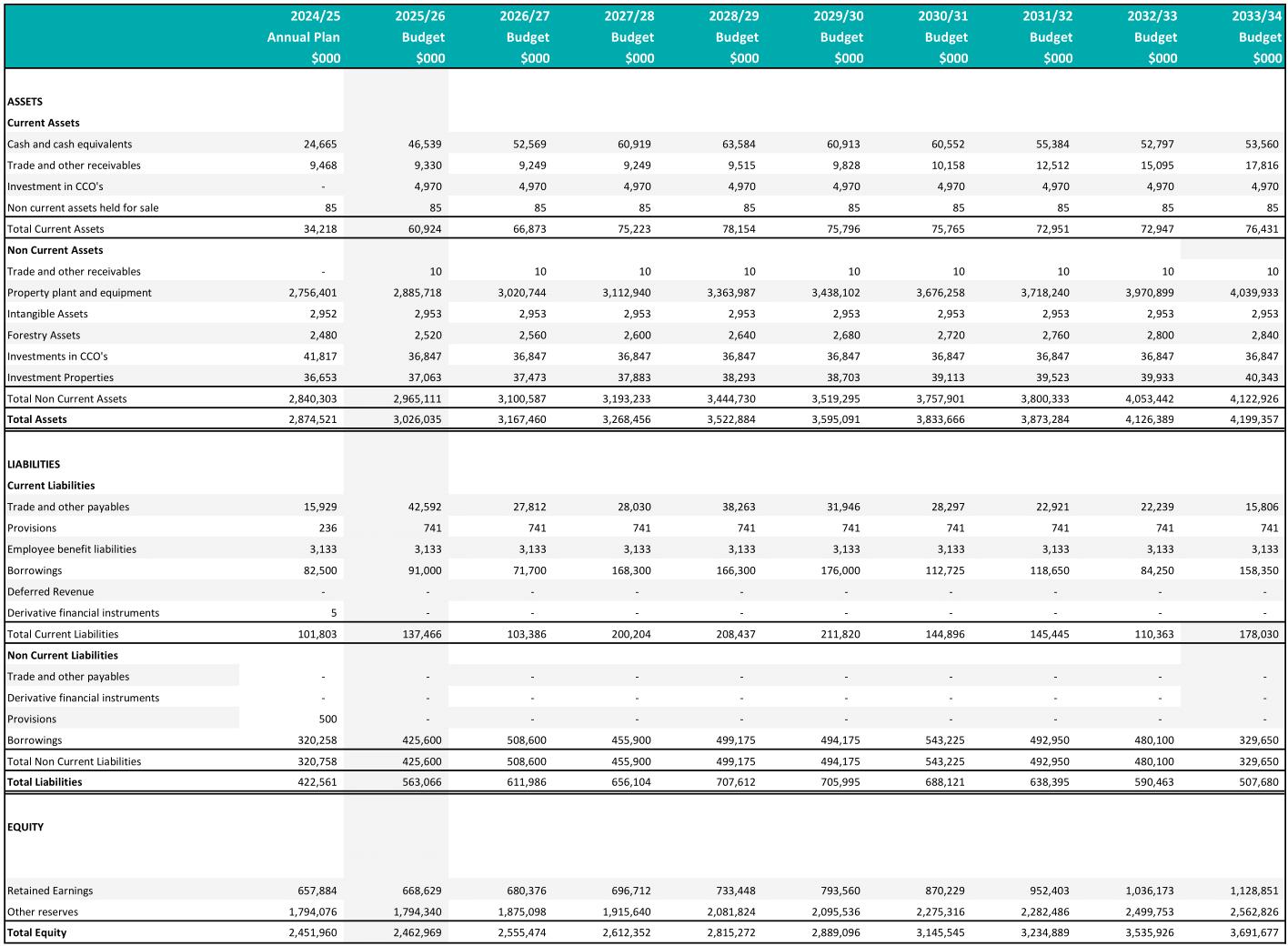
Council will apply cash reserves to reduce external debt over the term of this plan, ensuring it retains a sustainable, prudent financial position throughout.

12: Prospective statement of cash flow
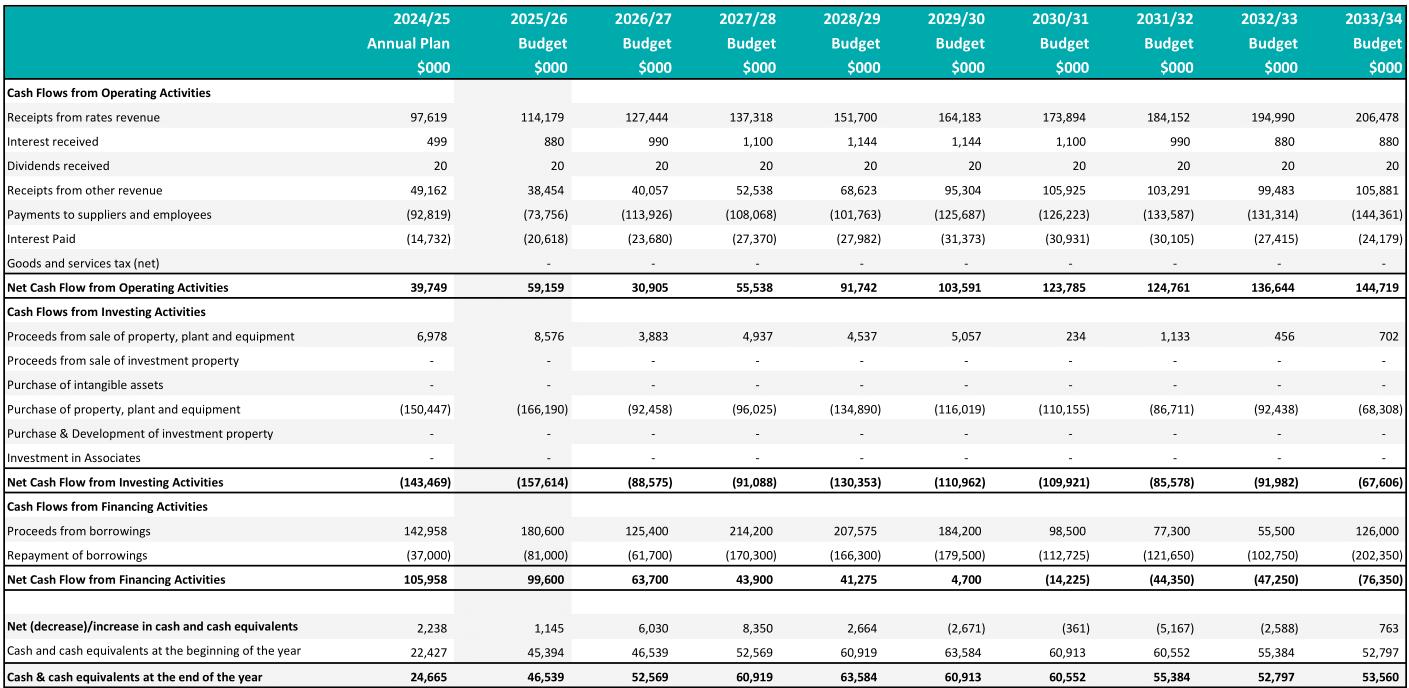
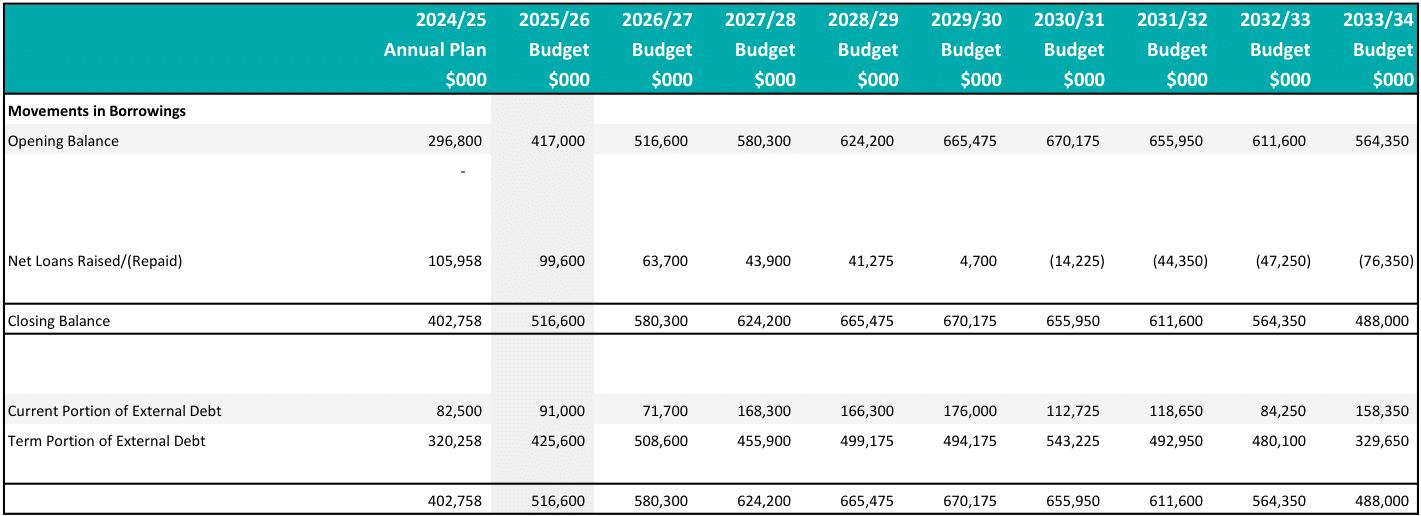
The above represents the level of external borrowing but this could fluctuate depending on future use of cash reserves.
14: Capital expenditure programme

Note: Refer to the Groups of Activities section in this LTP which outlines the individual projects in detail.
The tables below set out the purpose of the reserves held by Council and the related activities for these reserves.
Asset sales: Cambridge
Asset sales: Te Awamutu
Asset sales: General
Endowment land: Cambridge
Endowment land: Pirongia
Endowment land: Te Awamutu
Endowment land: Waipā district
Forestry reserve
Residential housing reserve
Proceeds from Cambridge asset sales held in reserve to fund future asset purchases
Proceeds from Te Awamutu asset sales held in reserve to fund future asset purchases
Proceeds from district-wide asset sales held in reserve to fund future asset purchases
Proceeds from sale of Cambridge endowment land held in reserve for endowment purposes
Proceeds from sale of Pirongia endowment land held in reserve for endowment purposes
Proceeds from sale of Te Awamutu endowment land held in reserve for endowment purposes
Proceeds from sale of district-wide endowment land held in reserve for endowment purposes
Proceeds from forestry harvesting to fund future forestry activities
Proceeds from residential housing rental revenue to fund the operating and capital expenditure of that activity
Property services
Property services
Property services
Property services
Property services
Property services
Property services
Forestry
Housing for the Elderly and Own Your Own Housing
District-wide water treatment and supply
District-wide roading
District-wide reserve developments
Proceeds from development contributions to fund growth-related expenditure
Proceeds from development contributions to fund growth-related expenditure
Proceeds from development contributions to fund growth-related expenditure
Proceeds from development contributions to fund growth-related expenditure
and disposal
Water treatment and supply
Transportation
Parks and reserves
District-wide land purchase
Karāpiro Reserve development
Te Awamutu library / museum
Cemetery: Paterangi
Project funding reserve
General insurance reserve
Infrastructure insurance reserve
Te Awamutu 100kv compensation reserve
Pavement levies
Regional Asset Technical Accord (RATA)
Waste minimisation
Proceeds from development contributions to fund growth-related expenditure
Proceeds from development contributions to fund growth-related expenditure for Karāpiro Reserve and Cambridge Pool
Proceeds from development contributions to fund growth-related expenditure for Te Awamutu library / museum
Table 18: Council reserves – Special funds
Proceeds held in reserve to fund future capital works
Funding for specific projects to be completed in the following year
Provision to pay call-ups and to fund increase in deductibles of claims as well as to help to pay future premium increases
Provision to help cover the insurance deductible if a major event happens in the Waipā district
Proceeds from the granting of easement rights for the Waipā Networks 110kv line, held in reserve for appropriate future utilisation with due regard to the source of these funds
Levies collected from land use consents for future pavement rehabilitation
Funds held in reserve for future works
Funds held in reserve for future works
Table 19: Council reserves – Separate balances
Parks and reserves
Parks and reserves
District libraries/museums
Cemeteries
All activities
All activities
Stormwater/ wastewater treatment and disposal/ water treatment and supply
Properties
Transportation
Transportation
Recycling
Reserve Purpose Activity
Roading reserve
Stormwater reserve
Water supply reserve
Funds held in reserve for capital works expenditure
Funds held in reserve for capital works expenditure
Funds held in reserve for capital works expenditure
Transportation
Stormwater
Water treatment & supply
Wastewater reserve
Depreciation reserve long term assets
Depreciation reserve medium term assets
Funds held in reserve for operating and capital works expenditure
Funds held in reserve for capital works expenditure
Funds held in reserve for capital works expenditure
Wastewater treatment and disposal
Community services and facilities
Community services and facilities
Operational
Land
Buildings
Infrastructural assets
Sewerage system
Water system
Drainage network
Roading network
Non-cash reserve to record appreciation values arising from asset revaluations
Non-cash reserve to record appreciation values arising from asset revaluations
Non-cash reserve to record appreciation values arising from asset revaluations
Non-cash reserve to record appreciation values arising from asset revaluations
Non-cash reserve to record appreciation values arising from asset revaluations
Non-cash reserve to record appreciation values arising from asset revaluations
Community services and facilities
Community services and facilities
Wastewater treatment and disposal
Water treatment and supply
Stormwater
Transportation
The funding impact statement has been prepared in accordance with Schedule 10 of the Local Government Act 2002, as well as sections 13 to 19 of the Local Government (Rating) Act 2002 and sets out:
• The revenue and financing mechanisms used.
• An indicative level or amount of funding for each mechanism.
• A summary of the total rates requirement.
• The application of funding methods to Council activities.
This statement should be read in conjunction with our Revenue and Financing Policy that sets out our policies in respect of each source of funding for operating and capital expenses. We have
reviewed the Revenue and Financing Policy as part of preparing this LTP and in doing so have taken into consideration:
• The community outcomes that each activity primarily supports.
• The distribution of benefits between the community as a whole, any identifiable part of the community, and individuals.
• The period over which those benefits are expected to occur.
• The extent to which the actions or inaction of particular individuals or a group contribute to the need to undertake the activity.
• The costs and benefits, including consequences for transparency and accountability, of funding the activity distinctly from other activities.
• The overall impact of any allocation of liability for revenue needs on the community.
The Consolidated Funding Statement includes petrol tax, funds from asset sales, rates penalties, and rates remissions, which are not directly attributable to a specific activity.
Table 21: Consolidated funding impact statement
The funding impact statement is prepared in compliance with the requirements of Clause 15, Part 1, Schedule 10 of the Local Government Act 2002. All of the rates applied in this FIS are intended to apply to each of the years of this LTP. Unlike the Statement of Comprehensive Revenue and Expense, the funding impact statement is intended to show in a transparent manner, how all sources of funding received by us are applied. It does not include ‘non-cash’ that is classified as income on the Statement of Comprehensive Revenue and Expense (as required by GAAP) such as assets that are vested to us through the subdivision process, or unrealised gains on assets. The Statement of Comprehensive Revenue and Expense also requires ‘non-cash’ expenses such as depreciation, amortisation, and unrealised losses of assets to be reflected, whereas these are excluded from the funding impact statement. The reconciliation below identifies the differences between these two statements.
Table 22: Reconciliation between the funding impact statement and statement of comprehensive revenue and expense
Rateable property numbers as required by legislation at the end of the preceding year for each year covered by the plan:
Table 23: Rateable property numbers
Rates requirement figures quoted in the section below are GST inclusive (with GST at the prevailing rate).
The funding of district-wide activities will be from a combination of general rates and Uniform Annual General Charge (UAGC) This combination of general rates and UAGC is referred to as ‘district-wide funding’. Activities funded from district-wide funding include governance, animal control, building, environmental health, resource management, development engineering, parks and reserves, Mighty River Domain, libraries, Cambridge Pool, Te Awamutu Events Centre, museums, cemeteries, public toilets, property, rural halls, town halls, community buildings, emergency management, litter bins and waste management, recycling, roading and stormwater.
A Separately Used or Inhabited Part of a rating unit exists when part of the rating unit is used, or can be used, as an independent residence; or, in the case of a commercial or industrial business, where part of the unit is used, or can be used, for independent trading operations. This is based on the principle that if a rating unit is configured for separate inhabitation or use, regardless of whether it is currently occupied, it is considered a separate use of the rating unit by the owner.
A general rate is set under section 13 of the Local Government (Rating) Act 2002 based on the capital value of each rating unit in the district and with no differential. The rate for 2025/26 is 0.1217 cents in the dollar on the capital value of each rating unit.
The general rate will fund 64.2 per cent of the district-wide funding.
Amount to be raised: $42,892,879 inclusive of GST.
A UAGC is set under section 15 of the Local Government (Rating) Act 2002 at $893.55 inclusive of GST per separately used or inhabited part of a rating unit.
The UAGC will fund a portion of the district-wide funding.
Amount to be raised: $23,902,463 inclusive of GST.
Targeted rates are set under sections 16 and 19 of the Local Government (Rating) Act 2002 for the activities listed below. Council will not invite lump sum contributions in respect of any of these targeted rates.
A targeted area rate is set on each rating unit in the district. The targeted rate will be a fixed amount per rating unit. This rate will be set on a differential basis based on location, being the areas of Te Awamutu, Kakepuku, Cambridge, Maungatautari and Pirongia. The rates for the 2025/26 year are shown in the following table:
Table 24: Targeted area rates
The targeted area rate will fund a portion of the district-wide funding and fund the public community/group benefit element of activities.
The activities funded from the targeted area rate include community boards, community grants, libraries, the Cambridge Pool, Te Awamutu Events Centre, the District Museum, the Cambridge Town Hall (Cambridge area only), community properties (Cambridge and Te Awamutu areas), the Cambridge Refuse Centre grant, and the National Cycling Centre of Excellence.
Amount to be raised: $7,896,586 inclusive of GST.
A targeted rate is set to fund the loan charges for the grant made for the development of the sports hall located at the Cambridge High School.
The targeted rate is a fixed amount per rating unit. A rate of $12.90 inclusive of GST is set for each rating unit in the Cambridge and Maungatautari areas.
Amount to be raised: $141,803 inclusive of GST.
A targeted rate is set to fund the maintenance costs for the Pirongia Memorial Hall and the Kihikihi Town Hall and part of the maintenance costs of the Cambridge Town Hall.
The targeted rate is a fixed amount per rating unit. A rate of $6.11 inclusive of GST is set for each rating unit in the Cambridge and Te Awamutu areas and in the Pirongia township being roll number 4,605.
Amount to be raised: $105,069 inclusive of GST.
A targeted rate is set to fund capital costs in connection with improvements and extensions to footpaths, kerbing and channelling of roads, and street lighting.
The capital works rate is based on the capital value of each rating unit in the district. The capital works rate is set on a differential basis based on location, with the categories being the areas of Te Awamutu and Cambridge. The rates in cents per dollar of capital value are shown in the following table:
Amount to be raised: $68,868 inclusive of GST.
A targeted rate is set to fund the operating costs and loan charges for stormwater in urban and rural areas of the district. The stormwater rate is based on the capital value of each rating unit in the
district. The stormwater rate is set on a differential basis based on location, the categories being urban and rural. Urban is defined as being the urban drainage areas of Cambridge, Te Awamutu, Kihikihi, Ōhaupō, Pirongia and Karāpiro as shown on drainage maps on www.waipadc.govt.nz. Rural is defined as the remaining area of the district not defined as urban. The rates for 2025/26 in cents per dollar of capital value are shown in the following table:
Amount to be raised: $8,349,290 inclusive of GST.
A targeted rate is set for sewerage disposal costs and loan charges for each rating unit in the areas of the Cambridge sewerage scheme, Hamilton Airport sewerage scheme, and the Te Awamutu sewerage scheme.
The targeted rate is set on a differential basis, based on the provision of service provided. The service categories are connected and serviceable.
• Connected refers to any rating unit connected to the Cambridge, Hamilton Airport, or Te Awamutu sewerage schemes
• Serviceable refers to any rating unit located within 30 metres of a public sewerage drain in one of the above Council sewerage scheme areas, where the property is capable of being effectively connected but which is not so connected.
For connected rating units, the liability is an amount per rating unit, calculated based on the number of pans and urinals at the rating unit. The rates for the 2025/26 year are:
A rating unit used primarily as a residence for one household will be treated as having no more than one pan or urinal. Rating units that are neither connected to the scheme nor serviceable are not liable for this rate.
Amount to be raised: $20,764,000 inclusive of GST
A targeted rate is set to contribute to the funding of water supply costs and loan charges to serviceable properties in the areas of the Cambridge water supply and the Te Awamutu water supply.
The targeted rate is set for serviceable rating units and is a fixed amount per SUIP of a rating unit. Serviceable means within 100 metres of a supply pipe in the Cambridge and Te Awamutu areas and capable of being effectively connected but not so connected. The rates for the 2025/26 year are:
28: Serviceable water targeted rate
Amount to be raised: $35,880 inclusive of GST.
A targeted rate is set for the water supply costs in the Cambridge and Te Awamutu areas and to fund loan charges to rating units with metered connections .
The metered water targeted rate includes both an amount per SUIP of a rating unit and a charge based on the cubic metres of water consumed and is set on a differential basis based on the provision of service for all metered rating units. The differential categories of service are potable and raw water supply. The rates for the 2025/26 year are:
Amount to be raised: $24,221,959 inclusive of GST.
A targeted rate is set to fund the Arohena rural water supply loan costs for Waipā ratepayers within the Arohena rural water supply area.
This revenue is collected on behalf of Ōtorohanga District Council who administers the Arohena rural water supply. The Arohena water rate is based on the capital value of each rating unit located within the Arohena rural water supply area.
The rate for 2025/26 in cents per dollar of capital value is 0.0069 inclusive of GST.
Amount to be raised: $5,635 inclusive of GST.
A targeted rate is set to fund the provision of a kerbside refuse recycling service to each household in the district.
The targeted rate is a fixed amount of $191.68 inclusive of GST per separately used or inhabited part of a rating unit.
Amount to be raised: $4,606,519 inclusive of GST.
Council has several community halls which have a targeted rate set for each hall. The targeted rates are to fund part of the costs of the relevant community hall.
These rates are a fixed amount per SUIP of a rating unit. For the purpose of Community Hall rates, SUIP is defined to include only household units. The rates will be charged to every rating unit within the relevant community hall areas that contains at least one residential household.
The plans showing the boundaries of the various community hall areas can be found at www.waipadc.govt.nz.
The following table shows the details for the various community hall targeted rates:
Council has a number of community centres that have a targeted rate set for each community centre. The targeted rates are to fund part of the costs of the relevant community centre.
These rates are a fixed amount per SUIP of a rating unit. For the purpose of community centre rates, SUIP is defined to include only household units. The rates will be charged to every rating unit within the relevant community centre area that contains at least one residential household.
The plans showing the boundaries of the various community centre areas can be found at www.waipadc.govt.nz
The following table shows the details for the various community centre targeted rates:
Table 31: Community centre targeted rates
Sections 55 and 56 of the Local Government (Rating) Act 2002 empower councils to adopt policies in relation to the early payment of rates. Council accepts full payment of all rates assessed for the year if paid on or before the due date of the first instalment. No discount will be given to any payment of rates received on this basis.
Rates are payable in four equal instalments with the due dates and penalty dates as set out in the table below:
Invoices for the supply of water via metered connections are payable in four instalments. The location where the water is supplied within the district will determine the month of meter reading, invoice date, due date, and the penalty date. The due dates and penalty dates are as per the following table.
Table 33: Metered water rate payment due dates
Location Invoiced during month of:
Te Awamutu / Pirongia
Kihikihi
July 29-Aug-255-Sep-25
October 28-Nov-255-Dec-25
January 2-Mar-269-Mar-26
April 29-May-265-Jun-26
July 29-Aug-255-Sep-25
October 28-Nov-255-Dec-25
January 2-Mar-269-Mar-26
April 29-May-265-Jun-26
Cambridge August 30-Sep-257-Oct-25
November 8-Jan-2615-Jan-26
February 31-Mar-267-Apr-26
May 30-Jun-267-Jul-26
Pukerimu / Ohaupo
September 31-Oct-257-Nov-25
December 30-Jan-269-Feb-26
March 30-Apr-267-May-26
June 31-Jul-267-Aug-26
Sections 57 and 58 of the Local Government (Rating) Act 2002 enables penalties to be imposed. A penalty of ten per cent will be added to any instalment, or part thereof. that remains unpaid as at the relevant date shown in the ‘penalty added’ column of the tables above, under the headings ‘rates payable by instalment’ and ‘metered water rate payment due dates.’
An additional penalty of ten per cent will be added to any rates assessed in any previous year that are still unpaid on 25 July 2025. The penalty will be added on 28 July 2025.
A further additional penalty of ten per cent will be added to rates from the previous years that are still unpaid after 28 January 2026. The penalty will be added on 29 January 2026.
The level of rates set on each property in the district is determined by several factors including location, property use, property value, and connection to services. The following pages provide the detail of the proposed rate charges for a selection of properties across the district. The information is provided to give indication of what level of rates will be applied to properties of similar type, location and value.
The proposed rates for the indicator properties are shown inclusive of GST.
Water is charged on a metered basis and varies property by property according to the quantity of water used by the owners or the tenants. Because of this, the metered water rates used in the indicator property calculations are based on an average level of water consumption for a residential
and a commercial/industrial property (as applicable). The average level of consumption applied is based on information submitted to Taumata Arowai annually. The actual consumption, and therefore the actual level of rates, is dependent on the actual water consumption of a particular property.
*SUIP: Separately Used or Inhabited Part of a property
Table 34: Rates breakdown indicator properties
Cents/$
Table 35: Cambridge indicator properties
Cambridge Ward (Residential)
$1,100,000 with 1
Table 36: Te Awamutu indicator properties
Te Awamutu Ward (Residential)
$690,000 with 1
Te Awamutu Ward (Residential)
$800,000 with 1
Te Awamutu Ward (Residential)
$1,330,000 with 1
Table 37: Pirongia indicator properties
Pirongia Ward (Rural)
$1,080,000 with 1
2025/262026/272027/28
Pirongia Ward (Rural)
$3,450,000 with 2
2025/262026/272027/28
Pirongia Ward (Rural)
$7,165,000 with 1
2025/262026/272027/28
Pirongia Village
2025/262026/272027/28
$750,000 with 1
Pirongia Village
2025/262026/272027/28 $980,000 with 1
Pirongia Village
$1,220,000 with 1
2025/262026/272027/28
Table 38: Ōhaupō indicator properties
Ōhaupō Village
Ōhaupō Village
$700,000 with 1
2025/262026/272027/28
$950,000 with 1
2025/262026/272027/28
Ōhaupō Village
$1,340,000 with 1
2025/262026/272027/28
Table 39: Ngāhinapōuri indicator properties
Ngahinapouri
$740,000 with 1
2025/262026/272027/28
Ngahinapouri
$1,030,000 with 1
2025/262026/272027/28
$2,300,000 with 1
2025/262026/272027/28
Table 40: Kakepuku indicator properties
Kakepuku Ward
$1,690,000 with 1
2025/262026/272027/28
Kakepuku Ward
$5,550,000 with 1
2025/262026/272027/28
Kakepuku Ward
$8,860,000 with 2
2025/262026/272027/28
Table 41: Maungatautari indicator properties
Maungatautari Ward
$870,000 with 1
2025/262026/272027/28
Maungatautari Ward
$3,520,000 with 1
2025/262026/272027/28
Maungatautari Ward
$7,430,000 with 2
2025/262026/272027/28
Waipā District Council is a territorial local authority established under the Local Government Act 2002 (LGA). It is domiciled in, and operates within New Zealand. The relevant legislation governing the Council’s operations includes the LGA and the Local Government (Rating) Act 2002.
The primary objective of Council is to provide goods or services for community or social benefit rather than making a financial return. Accordingly, Council has designated itself as a public benefit entity (PBE) for financial reporting purposes. Council has not presented group prospective financial statements because Council believes that the parent prospective statements are more relevant to the users. The main purpose of these statements is to provide users with information about the core services that Council intends to provide ratepayers, the expected cost of those services, and the consequential requirement for rate funding.
The financial statements have been prepared on the going concern basis, and the accounting policies have been applied consistently throughout the period.
The financial statements of Council have been prepared in accordance with the requirements of the LGA and the Local Government (Financial Reporting and Prudence) Regulations 2014 (LG(FRP)R), which include the requirement to comply with generally accepted accounting practice in New Zealand (NZ GAAP).
The financial statements have been prepared in accordance with Tier 1 PBE accounting standards.
The financial statements are presented in New Zealand dollars, and all values are rounded to the nearest thousand dollars ($’000). The functional currency of Council is New Zealand dollars.
All items in the financial statements are stated exclusive of GST, except for receivables and payables, which are stated on a GST inclusive basis.
The net amount of GST recoverable from, or payable to, the Inland Revenue Department (IRD) is included as part of receivables or payables in the statement of financial position. The net GST paid to, or received from, the IRD is classified as an operating cash flow in the statement of cash flows.
Commitments and contingencies are disclosed exclusive of GST.
The Council is tax exempt for income tax purposes.
The budget figures have been prepared in accordance with the New Zealand Generally Accepted Accounting Practices, using accounting policies that are consistent with those adopted by Council for the preparation of these financial statements.
Council has derived the cost of service for each significant activity using the cost allocation system outlined below.
• Direct costs are those costs directly attributable and charged to a significant activity.
• Indirect costs are those costs that cannot be identified in an economically feasible manner, with a specific significant activity. Indirect costs are charged to significant activities using appropriate cost drivers, such as computer equipment used, staff numbers, and floor area.
Revenue may be derived from either exchange or non- exchange transactions.
Exchange transactions are those in which Council receives assets or services, or has liabilities extinguished, and provides approximately equal value in return to another entity.
Specific accounting policies for major categories of exchange revenue transactions are listed below.
Interest income is recognised using the effective interest method.
Dividends are recognised when Council’s right to receive the payment is established.
Rental revenue arising from tenancy agreements is accounted for on a straight-line basis over the lease term and is included in revenue in the statement of revenue and expenditure due to its operating nature.
Other gains and losses include fair value gains and losses on financial instruments at fair value through surplus or deficit, unrealised fair value gains and losses on the revaluation of investment properties, and realised gains and losses from the sale of Property, Plant and Equipment (PPE) held at cost.
Revenue from the sale of goods is recognised when a product is sold to the customer.
Non- exchange transactions are those that are not exchange transactions. In a non- exchange transaction, Council either receives value from or provides value to another entity without directly
giving or receiving approximately equal value in return, or where the value exchanged cannot be reliably measured.
An inflow of resources from a non- exchange transaction, whether an asset or revenue, is only recognised if a corresponding liability is not also recognised for that asset or revenue.
A liability is only recognised to the extent that the present obligations have not been satisfied. A liability for a transferred asset is recognised only when the asset is subject to a condition, such as a requirement that it be used for a specific purpose and/or that future economic benefits or service potential must be returned to the owner.
Specific accounting policies for major categories of non- exchange revenue transactions are listed below.
The following policies for rates have been applied:
• General rates, targeted rates (excluding water-by-meter), and Uniform Annual General Charges are recognised at the start of the financial year to which the rates resolution relates. They are recognised at the amounts due. The Council considers that the effect of payment of rates by instalments is not sufficient to require discounting of rates receivables and subsequent recognition of interest revenue.
• Rates arising from late payment penalties are recognised as revenue when rates become overdue.
• Revenue from water-by-meter rates is recognised on an actual basis. Unbilled usage, as a result of unread meters at year end, is accrued on an average usage basis.
• Rates remissions are recognised as a reduction in rates revenue when the Council has received an application that satisfies its Rates Remission Policy.
Development and financial contributions are recognised as revenue when Council provides, or is able to provide, the service for which the contribution was collected. Otherwise, development and financial contributions are recognised as liabilities until such time as Council provides, or is able to provide the service.
Council receives funding assistance from Waka Kotahi NZ Transport Agency which subsidises part of the costs of maintenance and capital expenditure on the local roading infrastructure. The subsidies are recognised as revenue upon entitlement as conditions pertaining to eligible expenditure have been fulfilled.
Other grants are recognised as revenue when they become receivable, unless there is an obligation in substance to return the funds if conditions of the grant are not met. If such an obligation exists, the
grant is initially recorded as grants received in advance and is recognised as revenue when the grant conditions are satisfied.
Rendering of services at a price that is not approximately equal to the value of the service provided by the Council or group is considered a non- exchange transaction. This includes services where the fee charged does not fully cover the cost of delivery, such as resource consents, building consents, water connections, dog licensing, etc., with the shortfall subsidised by income from other activities, such as rates. Generally, no conditions are attached to this type of revenue.
Revenue from such services is recognised when the Council or group issues the invoice or bill for the service. Revenue is recognised at the amount of the invoice or bill, which is the fair value of the cash received or receivable for the service. Revenue is recognised by reference to the stage of completion of the service to the extent that the Council or group has an obligation to refund the cash received from the service (or to the extent that the customer has the right to withhold payment from the Council or Group for the service) if the service is not completed.
Fees and charges for building and resource consent services are recognised on a percentage completion basis with reference to the recoverable costs incurred at balance date.
Entrance fees are fees charged to users of the Council’s local facilities such as the pools. Revenue from entrance fees is recognised upon entry to such facilities.
Infringement fees and fines mostly relate to animal infringements and parking infringements and are recognised when the revenue is received. The fair value of this revenue is determined based on the probability of collecting fines, which is estimated by considering the collection history of fines over the preceding two -year period.
Where a physical asset is acquired for nil or nominal consideration, the fair value of the asset received is recognised as income. Assets vested in Council are recognised as revenue when Council gains control of the asset.
The fair value of vested assets is usually determined by reference to the cost of constructing the asset. For assets received from property developments, the fair value is either based on construction price information provided by the property developer, or values as per the last revaluation.
For long-lived assets that must be used for a specific purpose (e.g. land must be used as a recreation reserve), Council immediately recognises the fair value of the asset as revenue. A liability is only recognised if Council expects that it will need to return or transfer the asset to another party.
Council is required by the New Zealand Local Government Funding Agency Limited (LGFA) Guarantee and Indemnity Deed to disclose in its financial statements (or notes) its annual rates income. That
deed defines annual rates income as an amount equal to the total revenue from any funding mechanism authorised by the Local Government (Rating) Act 2002, together with any revenue received by Council from other local authorities for services provided by Council, for which those other local authorities rate.
Employer contributions to KiwiSaver are treated as defined contribution superannuation scheme expenses and are recognised in the surplus or deficit when incurred.
Non-discretionary grants are those that must be awarded if the grant application meets the specified criteria These are recognised as expenditure when an eligible application is received. Discretionary grants, on the other hand, are those grants for which Council is under no obligation to award upon receipt of the grant application. These grants are recognised as expenditure when the payment is made
An operating lease is a lease that does not transfer substantially all the risks and rewards incidental to ownership of an asset. Lease payments under an operating lease are recognised as an expense on a straight-line basis over the lease term.
In accordance with PBE IPSAS 5 Borrowing Costs, all borrowing costs are recognised as an expense in the period in which they are incurred.
Cash and cash equivalents includes cash-in-hand, deposits held at call with banks, and other shortterm, highly liquid investments with original maturities of three months or less. Bank overdrafts are classified as borrowings under current liabilities in the Statement of Financial Position.
Short-term receivables are recorded at the amount due, less an allowance for expected credit losses (ECL).
The Council applies the simplified ECL model of recognising lifetime ECL for short-term receivables.
In measuring ECLs, receivables are grouped into rates receivables, GST, and other receivables, and assessed collectively due to their shared credit risk characteristics. These groups are further classified based on days past due. A provision matrix is then developed using historical credit loss experience, adjusted for forward looking factors specific to the debtors and the economic environment.
Rates are ‘ written-off’:
• When remitted in accordance with the Council’s rates remission policy; and
• In accordance with the write- off criteria of section 90A (where rates cannot be reasonably recovered) and 90B (in relation to Māori freehold land) of the Local Government (Rating) Act 2002.
Other receivables are written off when there is no reasonable expectation of recovery. Indicators that there is no reasonable expectation of recovery include the debtor being in liquidation or the receivable being more than one year overdue.
Other financial assets (other than shares in subsidiaries) are initially recognised at fair value. They are then classified as, and subsequently measured under, the following categories:
• amortised cost;
• fair value through other comprehensive revenue and expense (FVTOCRE); and
• fair value through surplus and deficit (FVTSD).
Transaction costs are included in the value of the financial asset at initial recognition unless it has been designated at FVTSD, in which case it is recognised in surplus or deficit.
The classification of a financial asset depends on its cash flow characteristics and the Council and group’s management model for managing them.
A financial asset is classified and subsequently measured at amortised cost if it gives rise to cash flows that are ‘solely payments of principal and interest (SPPI)’ on the outstanding principal and is held within a management model focused on collecting the asset’s contractual cash flows.
A financial asset is classified and subsequently measured at FVTOCRE if it gives rise to cash flows that are SPPI and is held within a management model whose objective is both to collect contractual cash flows and to sell financial assets.
Financial assets that do not meet the criteria to be measured at amortised cost or FVTOCRE are subsequently measured at FVTSD. However, the Council and group may elect at initial recognition to designate an equity investment not held for trading as subsequently measured at FVTOCRE.
Subsequent measurement of financial assets at amortised cost
Financial assets classified at amortised cost are subsequently measured at amortised cost using the effective interest method, less any expected credit losses (ECL). Where applicable, interest accrued is added to the investment balance. Instruments in this category include term deposits, community loans, and loans to subsidiaries and associates.
Subsequent measurement of financial assets at FVTOCRE
Financial assets in this category that are debt instruments are subsequently measured at fair value, with fair value gains and losses recognised in other comprehensive revenue and expense, except ECL and foreign exchange gains and losses are recognised in surplus or deficit. When sold, the cumulative gain or loss previously recognised in other comprehensive revenue and expense is reclassified to surplus and deficit. Debt instruments in this category include the Council and group’s listed bonds.
Financial assets in this category that are equity instruments designated as FVTOCRE are subsequently measured at fair value, with fair value gains and losses recognised in other comprehensive revenue and expense. There is no impairment assessment when fair value falls below the cost of the investment. When sold, the cumulative gain or loss previously recognised in other comprehensive revenue and expense is transferred to accumulated funds within equity. The Council and group designate all equity investments not held for trading into this category, as these are strategic investments intended to be held for the medium to long-term.
Subsequent measurement of financial assets at FVTSD
Financial assets in this category are subsequently measured at fair value, with fair value gains and losses recognised in surplus or deficit.
Interest revenue and dividends recognised from these financial assets are separately presented within revenue. Except for derivatives, the Council and group have no instruments classified in this category.
Shares in subsidiaries (at cost)
Investments in subsidiaries are carried at cost in the Council’s parent entity financial statements.
Assets held for sale are classified as held for sale if their carrying amount will be recovered principally through a sale transaction, not through continuing use.
Assets held for sale are measured at the lower of their carrying amount and fair value less costs to sell.
Any impairment losses for write- downs of non- current assets held for sale are recognised in the surplus or deficit.
Any increases in fair value (less costs to sell) are recognised up to the level of any impairment losses that have been previously recognised.
These assets are not depreciated or amortised.
Property, plant, and equipment consists of:
• Operational assets: These include land, buildings, library books, plant, furniture and equipment, and motor vehicles.
• Infrastructural assets: These are fixed utility systems. Each asset class includes all items that are required for the network to function, for example sewer reticulation includes reticulation piping and sewer pump stations.
Property, plant, and equipment is shown at cost or valuation, less accumulated depreciation and impairment losses.
The cost of an item of property, plant, and equipment is recognised as an asset if it is probable that future economic benefits or service potential associated with the item will flow to Council, and if the cost of the item can be measured reliably. Additions are generally recognised at cost. Where an asset is acquired through a non- exchange transaction, it is recognised at its fair value at the date of acquisition. Work in progress is initially recognised at cost and is subsequently revalued and depreciated from the expected completion date of the project.
Gains and losses on disposal are determined by comparing the proceeds with the carrying amount of the asset. Gains and losses on disposal are included in the Statement of Comprehensive Revenue and Expense. When revalued assets are sold, the amounts included in asset revaluation reserves in respect of those assets are transferred to retained earnings.
Costs incurred subsequent to initial acquisition are capitalised only when it is probable that future economic benefits or service potential with the item will flow to Council and the cost of the item can be measured reliably.
The costs of day-to -day servicing of property, plant, and equipment are recognised in the surplus or deficit as they are incurred.
Depreciation is provided on a straight-line basis for all property, plant, and equipment, except land, at rates that will write- off the cost (or valuation) of the assets to their estimated residual values over their useful lives. The useful lives and associated depreciation rates of major classes of assets have been estimated as follows:
Table 42: Useful lives and associated depreciation rates of major classes of assets
The residual value and useful life of an asset is reviewed, and adjusted if applicable, at each financial year end.
Those asset classes that are revalued are valued on a two -yearly cycle and Operational Land and Buildings are valued every three years. All other asset classes are carried at depreciated historical cost.
The carrying values of revalued assets are assessed annually to ensure that they do not differ materially from the assets’ fair values. If there is a material difference, then the off- cycle asset classes are revalued.
Revaluations of property, plant, and equipment are accounted for on a class-of-asset basis.
The net revaluation results are credited or debited to other comprehensive revenue and expense and accumulated in an asset revaluation reserve within equity for that class of asset. Where this would result in a debit balance in the asset revaluation reserve, this balance is not recognised in other comprehensive revenue and expense but instead is recognised in the surplus or deficit.
Any subsequent increase on revaluation that reverses a previous decrease in value recognised in the surplus or deficit will be recognised first in the surplus or deficit, up to the amount previously expensed, and then recognised in other comprehensive revenue and expense.
At fair value as determined from market-based evidence where there is a market, or depreciated replacement cost for specialised assets, by an independent valuer.
At fair value determined on a Depreciated Replacement Cost (DRC) basis by an independent valuer.
Land under roads is no longer revalued.
Assets that have a finite useful life are reviewed for indicators of and are tested annually for impairment at each balance date. When there is an indicator of impairment, the asset’s recoverable amount is estimated. An impairment loss is recognised for the amount by which the asset’s carrying amount exceeds its recoverable amount. The recoverable amount is the higher of an asset’s fair value less costs to sell and value in use.
If an asset’s carrying amount exceeds its recoverable amount, the asset is impaired and the carrying amount is written down to the recoverable amount. For revalued assets, the impairment loss is recognised against the revaluation reserve for that class of asset. Where that results in a debit balance in the revaluation reserve, the balance is recognised in the surplus or deficit.
For assets not carried at a revalued amount, the total impairment loss is recognised in the surplus or deficit.
The reversal of an impairment loss on a revalued asset is credited to the revaluation reserve. However, to the extent that an impairment loss for that class of asset was previously recognised in the surplus or deficit, a reversal of the impairment loss is also recognised in the surplus or deficit.
For assets not carried at a revalued amount, the reversal of an impairment loss is recognised in the surplus or deficit.
Value in use for non- cash-generating assets
Non-cash generating assets are those assets that are not held with the primary objective of generating a commercial return.
For non-cash generating assets, value in use is determined using an approach based on either a depreciated replacement cost approach, restoration cost approach, or a service units approach. The most appropriate approach used to measure value in use depends on the nature of the impairment and availability of information.
Value in use for cash-generating assets
Cash-generating assets are those assets that are held with the primary objective of generating a commercial return.
The value in use for cash-generating assets and cash-generating units is the present value of expected future cash flows.
Acquired computer software licences are capitalised on the basis of the costs incurred to acquire and prepare the software for use. Costs associated with maintaining computer software are recognised as an expense when incurred. Staff training costs are also recognised in the surplus or deficit as incurred. Similarly, costs associated with development and maintenance of the Council’s website are recognised as an expense when incurred.
The carrying value of an intangible asset with a finite life is amortised on a straight-line basis over its useful life. Amortisation begins when the asset is available for use and ceases at the date that the asset is derecognised. The amortisation charge for each period is recognised in the Statement of Comprehensive Revenue and Expense. The useful lives and associated amortisation rates of computer software have been estimated at 3-10 years (33% - 10%).
Intangible assets that have an indefinite useful life, or not yet available for use, are not subject to amortisation and are tested annually for impairment. Assets that have a finite life are reviewed for indicators of impairment and tested annually for impairments each balance date.
Gains and losses on disposal are determined by comparing the disposal proceeds with the carrying amount of the New Zealand Units (NZU). Gains and losses on disposals are reported in the surplus or deficit. If, at the end of any financial year, deforestation (such as harvesting) has occurred but replating has not yet taken place, a contingent liability will be disclosed until replanting has occurred. After initial recognition, Emission Trading Scheme credits are measured at their fair value, with gains or losses on re-measurement recognised in the surplus or deficit. NZUs are not amortised and have an indefinite life.
Forestry assets are independently revalued annually at fair value less estimated point of sale costs. Fair value is determined based on the present value of expected net cash flows discounted at a current market determined pre-tax rate. This calculation is based on existing sustainable felling plans and assessments of growth, timber prices, felling costs, and silvicultural costs, while also considering environmental, operational, and market restrictions.
Gains or losses arising on initial recognition of forestry assets at fair value less estimated point of sale costs, and from a change in fair value less estimated point of sale costs, are recognised in the Statement of Comprehensive Revenue and Expense. The costs to maintain the forestry assets are included in the Statement of Comprehensive Revenue and Expense.
Properties leased to third parties under operating leases are classified as investment property, unless the property is held to meet service delivery objectives, rather than to earn rentals.
Initially, investment properties are measured at cost, including transaction costs. After initial recognition, investment properties are measured at fair value as determined annually by an independent valuer. Gains and losses on revaluation, acquisition, and disposal are recognised in the Statement of Comprehensive Revenue and Expense.
Trade and other payables are initially measured at fair value and subsequently measured at amortised cost using the effective interest method.
Council recognises a provision for future expenditure of uncertain amount or timing when there is a present obligation (either legal or constructive) arising from a past event, it is probable that expenditure will be required to settle the obligation, and a reliable estimate of the obligation amount can be made. Provisions are not recognised for future operating losses.
Provisions are measured at the present value of the expenditures expected to be required to settle the obligation, using a pre-tax discount rate that reflects current market assessments of the time value of money and the risks specific to the obligation. The increase in the provision due to the passage of time is recognised as an interest expense and is included in ‘finance costs.’
Employee benefits expected to be settled within twelve months of the balance date are measured at nominal value based on accrued entitlements at current rates of pay. These include salaries and wages accrued up to the balance date, annual leave earned but not yet taken, and sick leave. A liability for sick leave is recognised only if future absences in the coming year are expected to exceed sick leave entitlements earned in the coming year. This amount is calculated based on the unused sick leave entitlements that can be carried forward at the balance date, and are anticipated to be used by staff to cover those future absences.
Borrowings are initially recognised at fair value less directly attributable transaction costs, unless they are designated at fair value through surplus or deficit. After initial recognition, borrowings are measured at amortised cost using the effective interest method.
Borrowings are classified as current liabilities unless the Council has a contractual and unconditional right to defer settlement for at least 12 months after balance date.
Council uses derivative financial instruments to hedge its exposure to interest rate risks arising from financing activities. In accordance with the Treasury Management Policy, Council does not hold or issue derivative financial instruments for trading purposes.
Derivative financial instruments are recognised initially at fair value. Subsequent to initial recognition, derivative financial instruments are stated at fair value. The gain or loss on remeasurement to fair value is recognised immediately in the Statement of Comprehensive Revenue and Expense. However, where derivatives qualify for hedge accounting, recognition of any resultant gain or loss depends on the nature of the item being hedged (refer to the section below).
The fair value of interest rate swaps is the estimated amount that the Council would receive or pay to terminate the swap at the Statement of Financial Position date, considering current interest rates and the current credit worthiness of the swap counterparts.
Derivatives are initially recognised at fair value on the date the contract is entered into and are subsequently remeasured to their fair value. The recognition of resulting gains or losses depends on whether the derivative is designated as a hedging instrument and, if so, the nature of the item being hedged. Council designates certain derivatives as either: (1) hedges of the fair value of recognised assets or liabilities, or firm commitments (fair value hedges); or (2) hedges of highly probable forecast transactions (cash flow hedges).
At the inception of the transaction, Council documents the relationship between hedging instruments and hedged items as well as its risk management objective and strategy for undertaking various hedge transactions. Council documents its assessment, both at hedge inception and on an ongoing basis, of whether the derivatives used in hedging transactions have been, and will continue to be, highly effective in offsetting changes in the fair value or cash flows of the hedged items.
Changes in the fair value of derivatives that are designated and qualify as fair value hedges are recorded in the Statement of Comprehensive Revenue and Expense, together with any changes in the fair value of the assets or liability that are attributable to the hedged risk.
The effective portion of changes in the fair value of derivatives that are designated and qualify as cash flow hedges is recognised in equity in the hedging reserve. The gain or loss relating to the ineffective portion is recognised immediately in the Statement of Comprehensive Revenue and Expense.
Amounts accumulated in equity are recycled in the Statement of Comprehensive Revenue and Expense in the periods when the hedged item will affects profit or loss (e.g., when a forecast sale occurs). However, if the forecast transaction results in the recognition of the non-financial asset (such as inventory) or a non-financial liability, the gains or losses previously deferred in equity are transferred from equity and included in the initial measurement of the asset or liability.
When a hedging instrument expires, is sold, terminated, or no longer meets the criteria for hedge accounting, any cumulative gain or loss remaining in equity at the time remains in equity and is recognised in the Statement of Comprehensive Revenue and Expense when the forecast transaction is ultimately recognised.
When a forecast transaction is no longer expected to occur, the cumulative gain or loss that was reported in equity is immediately transferred to the Statement of Comprehensive Revenue and Expense.
Certain derivative instruments do not qualify for hedge accounting. Changes in the fair value of any derivative instrument that do not qualify for hedge accounting are recognised immediately in the Statement of Comprehensive Revenue and Expense.
Equity is the community’s interest in Council and is measured as the difference between total assets and total liabilities. Equity is disaggregated and classified into a number of reserves; the components are:
• Retained earnings;
• Council created reserves;
• Revaluation reserves;
• Cash flow hedge reserve.
Council created reserves
Council created reserves are a component of equity representing a particular use to which various parts of equity have been assigned. Council may alter them without reference to any third party or the courts. Transfers from these reserves may be made only for certain specified purposes or when certain specified conditions are met.
This reserve relates to the revaluation of property, plant, and equipment to fair value.
This reserve comprises the effective portion of the cumulative net change in the fair value of derivatives designated as cash flows hedges
PBE IFRS 17 – Insurance Contracts: This standard is effective for periods beginning on or after 1 January 2026 and is applicable to the Council. Council expects there not to be an impact on the financial reporting of the organisation.


The Revenue and Financing Policy (‘the Policy’) outlines Waipā District Council’s policies on the funding sources to be used to fund the operational and capital expenditure of Council’s activities and the rationale for their use.
The Policy is required by sections 102 and 103 of the Local Government Act 2002 (the Act). The Policy must be included in the Long Term Plan (LTP) as required by schedule 10, clause 10.
Section 102(3A)(a) of the Act also requires that this policy supports the principles set out in the Preamble to Te Ture Whenua Māori Act 1993. The Council will take those principles into account when considering funding decisions.
Section 103(2) of the Act allows the following mechanisms to be used for funding the operating or capital expenditure of Council’s activities:
1. General rates including:
i. Choice of valuation system
ii. Differential rating
iii. Uniform annual general charges
2. Targeted rates
3. Lump sum contributions
4. Fees and charges
5. Interest and dividends from investments
6. Borrowing
7. Proceeds from asset sales
8. Development contributions
9. Financial contributions under the Resource Management Act 1991
10. Grants and subsidies
11. Any other source
In addition to identifying the sources of funding under section 103(2) of the Act, the Policy must set out why Council has determined they should be used. A two -step process is required under section 101(3) of the Act.
Firstly, for each activity, Council must consider the following matters:
• The community outcomes to which the activity primarily contributes;
• The distribution of benefits between the community as a whole, any identifiable part of the community, and individuals;
• The period of time over which benefits occur (intergenerational equity);
• The extent to which the actions or inaction of particular individuals or a group contribute to the need to undertake the activity (also called the ‘exacerbator pays’ principle, which suggests that in appropriate cases the exacerbators should meet at least part of the cost of an activity); and
• The costs and benefits, including consequences for transparency and accountability, of funding the activity distinctly from other activities.
Secondly, following consideration of these matters, Council must consider the overall impact of this allocation of liability on the current and future wellbeing of the community (section 101(3)(b) of the Act).
In deciding how activities will be funded, Council first looks to sources other than rates. These sources include fees and charges, and grants and subsidies. Rates are Council’s major source of income, although grants, fees and charges, subsidies, levies and loans also provide substantial funding.
The Act requires Council to produce a Funding Impact Statement, which provides details on the funding mechanisms to be used for each year covered by the Long Term Plan (Schedule 10, Clause 15). The Funding Impact Statement shows how Council intends to implement the Revenue and Financing Policy each year. It also shows the amounts to be collected from each available source, including how various rates are to be applied.
A high-level review was undertaken with a particular focus on some key areas of the 2021 policy. The following changes have been incorporated into the 2025 Policy.
Activities with a whole of district benefit have previously been funded through a mix of general rate (determined on capital value), Uniform Annual General Charge (UAGC), and a portion of the targeted area rates. This was referred to in the 2021 policy as ‘district wide funding’. Over a period of six years the targeted area rate element of the district wide funding has been intentionally phased out and district wide funding is now a mix of general rate and UAGC. Targeted area rates still exist for specific area activity funding.
District wide funding will no longer be used for water and wastewater activities. Funding will be generated through targeted user charges and volumetric rates, consistent with the legislative direction of Central Government’s Local Water Done Well Policy.
This section sets out how Council has applied its analysis of section 101(3) to the funding sources in sections 3 and 4 of this Policy.
Council is required to identify the community outcome to which each activity primarily contributes. Council’s community outcomes are:
Social wellbeing – all about people
Cultural championspromote culture and heritage
Environmental champions – protect and sustain the environment
Economically progressive - supporting a thriving, sustainable economy
• Great place to live, work and play and invest.
• Invest in health and wellbeing, and support community groups.
• High quality of life.
• Unique history cultural awareness.
• Tangata whenua partnerships.
• Respect cultural diversity.
• Promote awareness and responsibilities.
• Support programmes.
• Responsive to climate change.
• Financially sustainable decision-making.
• Provide economic stimulus through new infrastructure.
• Provide value for money from services, promotion and a great place to invest and do business.
Section 101(3)(ii) of the Act requires Council to assess the ‘distribution of benefits between the community as a whole, any identifiable part of the community, and individuals.’ For this assessment, Council has identified three types of benefits:
1. Public benefit - whole district
This is any service or product that is generally available to the whole community and exhibits some or all of the following:
a) From which it is not practicable to exclude and/or identify particular user(s);
b) Where use by one particular individual or group does not consume the service or product, and it remains available for the benefit of others;
c) That typically does not incur significant additional costs for additional users;
d) That may benefit the community generally through option value (availability), existence value (quality of life), bequest value (a legacy for later generations), or prestige value (civic pride).
2. Public benefit - community
This is any service or product which can be identified as benefitting a specific part of the community (on the same basis as above for the whole district) usually by location, i.e., by area.
3. Private benefit
This is any service or product:
a) That is used only by a particular individual or group;
b) That once purchased or used, the service or product is not available for use by another individual or group;
c) That has a quantifiable incremental cost according to the number of users.
For a number of activities, Council has established a range of values for the percentage split of public and private benefits, reflecting that benefit assessments are inherently subjective and may vary from year to year depending on the demand for services and the level of debt servicing within the activities.
Council is required to assess the period over which benefits are expected to occur, which in turn indicates the period in which the operating and capital expenditure should be funded. For all activities, operating costs are directly related to providing benefits in the year of expenditure and are funded on an annual basis.
Assets provide benefits for the duration of their useful lives ranging from a few years to many decades for infrastructural assets. The concept behind intergenerational equity involves matching the period over which an asset is funded to the period during which benefits are derived from its use.
Council is required to consider the extent to which the action or inaction of particular individuals or groups contribute to the need for an activity. The ‘exacerbator pays’ principle holds that those whose actions or inactions give rise to the need for a particular activity should contribute to its cost.
Council is required to consider the costs and benefits, including consequences for transparency and accountability, of funding the activity distinctly from other activities using a different rate or combination of rates.
When Council has completed its activity-by-activity analysis and allocation of funding mechanisms, it examines the overall effect of the allocation on the community to ensure that it does not adversely impact on the current or future wellbeing of the district. To achieve this, Council’s revenue policies have regard to the following principles:
a) Fairness/equity
b) Uniformity
c) Efficiency
d) Stability
e) Simplicity
f) Justifiability.
Council assesses the effect of proposed funding mixes on a range of properties including low and high-value residential properties in urban areas and townships, rural properties, and commercial/industrial properties. As part of this assessment, Council can adjust the proportion of the general rate, Uniform Annual General Charge, and targeted area rate that make up district-wide funding if the annual effects of relative changes in the level of rates between various types of properties in the district require moderation.
Operating expenditure is expenditure on the day-to-day operations of Council. Council’s funding of operating expenses policies are set out to ensure prudent financial management and compliance with legislative requirements and generally accepted accounting practice.
Council may choose not to fully fund operating expenditure in any particular year if the deficit can be funded from operating surpluses in the immediate, preceding, or subsequent years. An operating deficit will only be budgeted when it would be beneficial to avoid significant fluctuations in rates, fees, or charges.
In addition, Council may choose to fund more than is necessary to meet the operating expenditure in any particular year. It will only budget for such an operating surplus if needed to cover an operating deficit in the immediate, preceding or subsequent years, to repay debt with regard to forecasted future debt levels, or to avoid significant fluctuations in rates, fees, or charges in future years.
From time-to-time loans may also be used to cover the costs of operating projects or unforeseen events. These are likely to be projects that span more than one year and/or the outcome of which is expected to last for some time e.g., the District Plan review. Any projects to be funded from loans will be identified in the annual Funding Impact Statement.
The proportion of district-wide funding provided by general rates, Uniform Annual General Charge and targeted area rates are determined and disclosed each year in the Funding Impact Statement.
Council has determined that the following sources may be used to fund operating expenditure:
In selecting funding mechanisms for each activity, Council generally seeks to fund private benefit from fees and charges, community benefit from targeted rates, and whole district benefit from a mixture of general rates and Uniform Annual General Charges for district-wide activities.
The mixture of general rates and Uniform Annual General Charge for district-wide activities is referred to in this Policy as ‘district-wide funding’. District-wide funding is also used to meet the shortfall where the fees and charges that are collected are less than the assessed private benefit of the activity.
Council uses a capital value rating system across the district. Capital value is preferred to land value because Council believes this generally provides a better surrogate for ability to pay. Rates in a capital value rating system are collected as follows:
A general rate is a rate in the dollar for the capital value of the property and is used to meet a portion of district-wide funding.
A Uniform Annual General Charge, based on a fixed amount per separately used or inhabited part of a rating unit (SUIP), is used to meet a portion of district-wide funding.
Definition of a Separately Used or Inhabited Part of a Rating Unit:
A separately used or inhabited part of a rating unit exists where there is use or ability to use a part or parts of the rating unit as an independent residence; or in the case of a rating unit used for commercial or industrial business, where there is use or ability to use a part or parts of the rating unit for independent trading operations. This is on the basis that where a rating unit is configured for the purpose of separate inhabitation or use, even if it is not currently occupied, this constitutes a separate use of the rating unit by the owner.
The following are guides to how this will be applied.
In a residential situation, an independent residence is defined as having a separate entrance and separate cooking, living, and toilet/bathroom facilities. A separately used or inhabited part comes into effect in a business situation when the property has been set up to accommodate, or is accommodating, separate lessees, tenants, or the like, or the ability to operate separate businesses from the same rating unit.
The following examples are separately used or inhabited parts of a rating unit:
a) Individual flats, apartments, or dwellings
b) A building or parts of a building that can be used as independent trading operations
c) Vacant rating units
d) A dwelling attached to a shop or other business premises
e) A residential building or part of a residential building that is used or can be used as an independent residence
The following are not considered to be separately used parts of a rating unit:
a) Residential sleep out or granny flat that does not meet the definition of an independent residence
b) A hotel room with or without kitchen facilities
c) A motel room with or without kitchen facilities
The Council’s targeted rates sources are a targeted area rate and other targeted rates. The targeted area rate is a fixed amount per rating unit, collected on a differential basis based on location.
The targeted area rate is used to meet the community/group benefit element of activities which includes community boards, community grants, libraries, Cambridge Pool, Te Awamutu Events Centre, District Museum, community properties, Cambridge Town Hall, recycling, Cycling Centre of Excellence, and passenger transport.
The Council’s other targeted rates can either be based on a rate in the dollar of the property’s capital value, or a fixed amount per property, either by rating unit or by SUIP.
Targeted rates are used to fund activities such as rural halls and town halls, recycling, kerbside refuse collection, Cambridge Community Sports Hall, stormwater, water treatment and supply, and wastewater treatment and disposal.
Generally, Council will use fees and charges to recover the ‘private benefit’ costs of a particular activity if it is economically viable to do so. Examples include dog registration fees and building consent fees.
Some activities undertaken by Council qualify for grants or subsidies from the Crown. In particular, Council receives a subsidy from Waka Kotahi NZ Transport Agency (NZTA) for qualifying roading expenditure.
This is a catch-all classification. The income is treated in the same way as fees and charges. It includes parking infringement fines, rates penalties, income from interest, and lease income.
The tables in this section illustrate the outcome of Council’s analysis in relation to section 101(3) of the Act. There are three sets of tables:
1. Community outcomes
2. Funding principles
3. Economic benefits
The community outcomes and funding principles tables are assessed for the entire group of activities, while the economic benefit assessment tables are assessed for each activity within each group. Where appropriate, footnotes are provided for additional rationale of the funding of the targeted area rate.
The funding principles tables show how the funding principles in sections 101(3)(a)(ii) to (v) relate to each group of activities. This assists Council in determining which funding mechanisms are appropriate for each activity. Generally, those activities that score low for user pays or for cost/benefit of separate funding are best funded by general rates, whilst those scoring higher in those areas are best funded by user charges or targeted rates.
The economic benefits tables show the degree to which each group of activities conforms to the following economic principles:
a. Distribution of benefit – the degree to which benefits can be attributed to individuals/groups, rather than the whole community
b. Period of benefit – the degree to which benefits can be attributed to a future period.
c. Extent of action/inaction – the degree to which action or inaction of groups or individuals gives rise to need for expenditure
d. Cost/benefit of separate funding – the degree to which costs and benefits justify separate funding of this activity
The economic benefit assessment and funding target tables detail how each activity is proposed to be funded and what the funding targets are for each activity. Generally, these tables show that where a private benefit exists, the cost of this is to be recovered by user charges or a targeted rate. The cost of public benefits is usually funded via district-wide funding or via the targeted area rate for benefits restricted by location.
Costs for each group of activities include the allocation of Council’s support service overheads.
Council, elections, strategic planning, and communications provide a public benefit to the whole district and should be funded by all ratepayers through district-wide funding. The Community Boards provide a public benefit both to the individual communities that they serve and to the wider district, and are funded partially by the targeted area rate and partially by district-wide funding. Community grants provide a public benefit to the specific communities they relate to, while some grants also deliver a district-wide benefit.
Table 43: Governance and Support Services – community outcomes primarily contributed to
Governance and Support Services - community outcomes primarily contributed to
• Financially sustainable decision making.
Economically progressive –supporting thriving communities
Social wellbeing – all about people
Cultural champions – promote culture and heritage
Environmental champions –protect and sustain the environment
• Provide value for money from services, promotion and a great place to invest and do business.
• Provide economic stimulus through new infrastructure.
• Great place to live, work, play and invest.
• Unique history cultural awareness.
• Tangata whenua partnerships.
• Respect cultural diversity.
• Support programmes.
Table 44: Governance and Support Services funding principles
Funding principles
Distribution of benefit (user pays)
Period of benefit (intergenerational equity)
Extent of action/inaction (Exacerbator pays)
Cost/benefit of separate funding
Benefits are generated for the whole district through activities such as health inspections, maintenance of animal control facilities, certain enforcement actions, aspects of planning (e.g. appeals to the Environmental Court, heritage and landscape protection), and responses to nonchargeable information requests.
Fees and charges are levied for these activities to recover the private benefit portion of services provided (‘user pays’). The quantity of services delivered will vary according to market conditions, and accordingly Council sets a range for the funding for these activities from fees and charges. The
63 The Te Awamutu Community Board is allocated to Te Awamutu and Kakepuku areas, the Cambridge Community Board is allocated to the Cambridge and Maungatautari areas.
64 These are allocated to the area to which the grant relates/benefits, grants benefiting the whole district are funded across all areas.
65 Interest expense from growth loans to be paid by development contribution revenue.
balance is funded from district-wide funding.
For the Environmental Health activity, Council is prevented by statutory limits from fully recovering the costs related to implementing liquor licenses and hazardous substances. This results in the balance of these costs being funded from district-wide funding.
Table 46: Planning and Regulatory community outcomes
Planning and Regulatory - community outcomes primarily contributed to
Environmental champions –protect and sustain the environment
Social wellbeing – all about people
Cultural champions – promote culture and heritage
• Promote awareness and responsibilities.
• Responsive to climate change.
• High quality of life.
• Unique history cultural awareness
Table 47: Planning and Regulatory funding principles
Distribution of benefit (user pays) Period of benefit (intergenerational equity) Extent of action/inaction (Exacerbator pays)
Cost/benefit of separate funding
Table 48: Planning and Regulatory economic benefit assessment and funding targets
66 Refer to paragraph 3
Some activities are identified as generating benefits for the whole district, such as Emergency Management, while other activities will benefit a specific identifiable community within the district, e.g. Cambridge Community Sports Hall.
Council will recover reasonable costs from individuals or groups who are identified as benefiting from the service or facility (‘user pays’).
Council subsidises some activities via district-wide funding to promote Council policies and achieve strategic outcomes through:
a) Subsidising the costs to individuals of borrowing library books, to encourage recreational and educational development of district residents; and
b) Subsidising the costs to individuals of entry to community facilities to encourage the development of a healthy community.
Social wellbeing – all about people
Economically progressive –support a thriving, sustainable economy
• Great place to live, work, play and invest.
• High quality of life.
• Provide value for money from services, promotion and a great place to invest and do business.
• Financially sustainable decision making.
Community Services and Facilities - community outcomes primarily contributed to
Cultural champions – promote culture and heritage
• We champion the unique history of Waipā.
• We have a high level of cultural awareness.
Table 50: Community Services and Facilities funding principles
Table 51: Community Services and Facilities economic benefit assessment and funding targets
67 There are practical difficulties in applying the ‘user pays’ principle to this activity. There is no revenue received for the use of the toilets; all costs are funded through district-wide funding.
68 The Te Awamutu Library is allocated to the Te Awamutu, Kakepuku and Pirongia areas; Cambridge Library is allocated to the Cambridge and Maungatautari areas.
69 The Cambridge pool is allocated to the Cambridge and Maungatautari areas, this includes the funding of the capital loans and 50% of the operating costs.
70 The Te Awamutu Events Centre is allocated to the Te Awamutu, Kakepuku and Pirongia areas. This includes the funding of the capital loans and 50% of the operating costs.
71 District Museum is allocated to the Te Awamutu area.
72 Council subsidises the rental costs for this activity as rent received from these organisations is generally below market value.
73 Allocated to the Cambridge and Te Awamutu areas.
74 Council has a long standing policy of funding all costs from rents.
75 Private benefit relates to the fees and charges received from hall hireage.
76 Urban Hall Rate which is allocated to Cambridge and Te Awamutu areas and the Pirongia village.
77 Allocated to the Cambridge area to fund the Cambridge Town Hall.
78 Fees and charges are received in the form of forestry harvesting revenue, which is accounted for in a separate reserve to fund this activity.
Management and Minimisation
This group of activity is considered to generate benefits for the whole district, although in some circumstances (e.g. road seal extensions), there is a higher proportion of benefit identified for a particular community. Additionally, in some instances the provision of a paved surface is considered to benefit a particular community (e.g. the construction of new footpaths), but the maintenance of it generates a benefit to the whole district.
Access to the road system is regarded as a public good due to non-excludability and the funding method is through district-wide funding. External subsidies and contributions are available and Council seeks to maximise the level of subsidy available from external agencies and minimise district-wide funding. The funding percentages are expressed as ranges because the actual funding mix from year to year will vary in accordance with the percentage of work undertaken that is eligible for subsidy.
79 This is allocated to all areas in the Waipā District.
80 Funds received from Ministry for the Environment to fund waste minimisation activities.
81 Allocated to the Cambridge and Maungatautari areas.
Table 52: Transportation community outcomes
Transportation - community outcomes primarily contributed to
Social wellbeing – all about people
Economically progressive –support a thriving, sustainable economy
Environmental champions –protect and sustain the environment
Cultural champions –promote culture and heritage
• Waipā provides a high quality of life for current and future generations.
• Financially sustainable decision making.
• Provide value for money from services, promotion, and a great place to invest and do business.
• Provide economic stimulus through new infrastructure.
• Support programmes.
• Responsive to climate change.
• Tangata whenua partnerships.
Table 53: Transportation funding principles
Funding principles
Distribution of benefit (user pays)
Period of benefit (intergenerational equity) Extent of action/inaction (Exacerbator pays)
Cost/benefit of separate funding
Stormwater is one of the mandatory groups of activities and it is considered appropriate to rate this as a separate activity. Council considers that this service is a public benefit that should primarily be recovered through a targeted rate differentiated for rural and urban service.
Reticulated stormwater is considered to generate benefits for urban communities, whereas rural drainage is considered to benefit rural communities.
Table 55: Stormwater community outcomes
Stormwater - community outcomes primarily contributed to
Social wellbeing – all about people
Economically progressive –support a thriving, sustainable economy
Environmental champions –protect and sustain the environment
Cultural champions – promote culture and heritage
• High quality of life.
• Provide value for money from services, promotion, and a great place to invest and do business.
• Provide economic stimulus through new infrastructure.
• Responsive to climate change.
• Tangata whenua partnerships.
Table 57: Stormwater economic benefit assessment and funding targets
Water Treatment and Supply Group of Activity
Water Treatment and Supply is one of the mandatory groups of activities and it is considered appropriate to rate this as a separate activity.
Direct users of the water supply clearly receive a benefit.
Council considers this service should be recovered through a targeted rate for connectable properties and through water invoicing for metered properties. The rate will be differentiated for the service received being connectable or connected via a water meter.
Table 58: Water Treatment and Supply community outcomes
Water Treatment and Supply - community outcomes primarily contributed to
Social wellbeing – all about people
Economically progressive –support a thriving sustainable economy
Environmental champions –protect and sustain the environment
Cultural champions – promote culture and heritage
• High quality of life.
• Provide value for money from services, promotion, and a great place to invest and do business.
• Financially sustainable decision making.
• Provide economic stimulus through new infrastructure.
• Responsive to climate change.
• Tangata whenua partnerships.
Table 59: Water Treatment and Supply funding principles
Funding principles
Distribution of benefit (user pays)
Period of benefit (intergenerational equity)
Extent of action/inaction (Exacerbator pays)
Cost/benefit of separate funding
Table 60: Water Treatment and Supply economic benefit assessment and funding targets
Wastewater Treatment and Disposal Group of Activity
Wastewater Treatment and Disposal is one of the mandatory groups of activities and it is considered appropriate to rate this as a separate activity.
The provision of wastewater service is primarily a private benefit to the communities that can access the reticulation.
Council considers that this service should be recovered through a targeted rate and through fees and charges for trade waste recoveries. The rate will be differentiated for the service received, connected, or connectable.
Table 61: Wastewater Treatment and Disposal community outcomes
Wastewater Treatment and Disposal - community outcomes primarily contributed to
Social wellbeing – all about people
Economically progressive –support a thriving sustainable economy
• High quality of life.
• Provide value for money from services, promotion, and a great place to invest and do business.
• Provide economic stimulus through new infrastructure.
Wastewater Treatment and Disposal - community outcomes primarily contributed to
Environmental championsprotect and sustain the environment
Cultural champions – promote culture and heritage
• Responsive to climate change.
• Tangata whenua partnerships.
Table 62: Wastewater Treatment and Supply funding principles
Funding principles
Distribution of benefit (user pays)
Cost/benefit of separate funding
Table 63: Wastewater Treatment and Supply economic benefit assessment and funding targets
The activity outlined above allocates some funding directly to sources such as fees and charges, subsidises, grants, and targeted rates (including targeted area rate). The remaining funding balance comes from district-wide funding, a mix of general rates (by CV), UAGC and targeted area rates.
Funding sources – capital expenditure
As with operating expenditure, Council ensures that it takes a prudent approach to the funding of capital expenditure with an emphasis on legislative and accounting compliance.
Funding to pay for new assets will come from a mix of borrowing, development contributions, grants and subsidies, capital revenue, reserves, and asset sales. Generally, the costs of new assets will not be met from rates, however a portion of the costs of servicing loans will be.
Rates may be used to fund low value capital projects. These may be district-wide funding or a targeted rate depending on the activity the capital project relates to.
Some groups of activities use separate reserves to fund upgrades/growth in order to achieve stated levels of service. Once these reserves are fully used, any remaining costs are funded by borrowing. These activities include stormwater, water treatment and supply, wastewater treatment and disposal, and transportation.
Funding for capital works depends on the nature of the work, particularly the underlying cost drivers that make the work necessary. There are three main cost drivers recognised by Council:
a) Growth
b) Level of service improvements
c) Renewals.
As outlined in the introduction section of this Policy, section 101(3) of the Act requires Council to consider a range of matters (using a two-step process) to determine what funding sources are appropriate. Responses to these requirements in relation to all methods of funding capital expenditure are illustrated in the tables below:
Capital expenditure- community outcomes primarily contributed to
Social wellbeing – all about people
Economically progressive –support a thriving sustainable economy
Environmental champions –protect and sustain the environment
Cultural champions – promote culture and heritage
• High quality of life.
• Provide value for money from services, promotion and a great place to invest and do business.
• Financially sustainable decision making.
• Provide economic stimulus through new infrastructure.
• Responsive to climate change.
• Tangata whenua partnerships.
Distribution of benefit (user pays)
Funding principles
Period of benefit (intergenerati onal equity)
Extent of action/inactio n (Exacerbator pays)
Cost/benefit of separate funding
Capital expenditure due to growth
Capital expenditure – levels of service improvement, statutory requirements or other reasons
Capital expenditure due to renewals
Capital expenditure due to growth
The district’s population and local economy is growing. The development generated from growth places pressure on the assets and services provided by Council. Investment in additional assets is required to meet growth-related demands.
Council intends to entirely fund the portion of capital expenditure that is attributable to growth by development contributions where it is legally, fairly, reasonably, and practically possible to do so. It is considered that development contributions are the best mechanism available to ensure that the cost of growth sits with those who have created the need for that cost. Refer to the Development Contributions Policy for full details around the rationale for, and level of, contributions.
The funding sources for growth capital expenditure in order of priority are:
a) Vested assets
b) Development contributions
c) Financial contributions
d) Capital grants and subsidies attributable to growth portion
e) Borrowing.
Capital expenditure due to changes in levels of service
The cost driver for a portion of capital works within the Waipā District relates to increasing levels of service for the community. In some cases, these improvements are required because of changes to
legislation or resource consent conditions, which means there is often little discretion regarding the decision 82
The funding sources for levels of service improvement capital expenditure in order of priority are:
a) Capital grants and subsidies
b) Asset sales
c) Capital reserves
d) Borrowing
e) Rates for small value capital projects.
Capital expenditure due to renewals
Renewal capital works are those capital expenditure costs that are incurred in restoring an asset to previous service levels, usually reflected in the amount that an asset has depreciated. Therefore, by using depreciation funds, Council is maintaining infrastructural networks to their existing service level.
The funding of depreciation is an implied requirement of the ‘balanced budget’ provision of the Act. It requires that the Council fully fund all operating costs, including reductions in the useful life or quality of assets.
The funding sources for renewal capital expenditure in order of priority are:
a) Depreciation reserves
b) Borrowing
c) Rates for small value capital projects.
Depreciation reserves are used to fund projects relating to renewals. Borrowing is used to fund projects where insufficient depreciation reserves are available.
82 For example, upgrades to water treatment plants due to water treatment standards.
Waipā District Council (Council) undertakes liability management (borrowing), investment, cash and associated risk management activity (in total referred to in this document as treasury activity). Council’s borrowing and investment activities are carried out within the requirements of the Local Government Act 2002 (the Act) and its various amendments, which define the operating environment for local authorities in relation to borrowing, investment, and treasury risk management activity.
This Treasury Management Policy (the Policy) document includes the Liability Management Policy and Investment Policy as required by part 6, sections 104 and 105 of the Act. The Policy provides the framework for all of Council’s treasury activities, defining key responsibilities and the operating parameters within which these activities are to be carried out.
The scope of this policy covers treasury activity at Council level and is formally reviewed and updated from time to time, but at least once every three years, although the review is normally in conjunction with the review of the long term plan (LTP).
Council’s borrowing activity is largely driven by its capital expenditure programme.
Council also manages a portfolio of investments comprising of equity, biological assets (such as forestry), property, and treasury investments.
Council’s broad objectives in relation to treasury activity are as follows:
1. Compliance with the Act and any other relevant local authority legislation.
2. To manage Council’s borrowings and investments in line with its strategic and commercial objectives, interest expense budget, and to optimise returns on treasury investments within these objectives.
3. Avoidance of capital losses. For treasury investments this is achieved by investing on a hold to maturity basis (unless exceptional circumstances otherwise dictate), and only invest with creditworthy counter parties.
4. Maintain funding mechanisms with an appropriate maturity profile to ensure adequate liquidity is available at margins and costs appropriate to Council’s credit standing.
5. To manage the operational cash position and ensure that any surplus cash is invested in approved liquid instruments, or where appropriate, is used to minimise debt.
6. Mitigate potential adverse interest rate risk and minimise financing costs within acceptable risk management parameters. Develop and maintain professional relationships with the New Zealand Local Government Funding Agency Limited (LGFA), Council’s bankers, and the financial markets in general.
7. Provide timely and accurate reporting of treasury activity and performance.
In meeting the above objectives, Council acknowledges that there are specific financial risks such as funding, liquidity, interest rate, credit, and operational risks arising from its treasury activities.
Council is a risk averse entity and does not wish to incur undue risk from its treasury activities. Accordingly, Council manages its treasury activities in a manner that addresses these risks, focusing on protecting budgeted interest costs and income, and stabilising cash flows. Council seeks to prudently manage these risks, and any activity that is unrelated to its underlying cash flows or considered speculative in nature is expressly forbidden.
Section 104 of the Act provides that the Liability Management Policy required under Section 102(2)(b) must state the local authority’s policies in respect of liability management, including:
• Interest rate exposure
• Credit exposure
• Liquidity
• Debt repayment.
Council’s infrastructure and community assets generally have long economic lives and long-term benefits. The use of debt is seen as an appropriate and efficient mechanism for promoting intergenerational equity between current and future ratepayers in relation to Council’s assets and investments, as well as assisting Council in meeting the infrastructure demands of its ratepayers on a timely basis. Council borrows as it considers appropriate within the flexible and diversified borrowing powers contained within the Act. Borrowing arrangements exceeding $250,00 in aggregate, which are not included in the current LTP, must be approved by Council resolution.
Council raises debt for the following primary purposes:
• General debt to fund Council’s balance sheet;
• Specific debt associated with special one- off projects and capital expenditure;
• To fund assets with intergenerational qualities.
Council is able to borrow through a variety of market mechanisms including borrowing from the LGFA, direct bank borrowing or the issue of bonds via the domestic capital markets.
Council generally prefers to use available internal reserves to meet its borrowing requirements before seeking external funding sources.
Given the relative advantages to each funding mechanism, Council may have a mix of LGFA, bank, and capital markets borrowing over time. Generally, a bank facility is most appropriate to provide working capital and core funding where there is uncertainty regarding the timing and amount of borrowing. When there is greater certainty around the amount and term, the LGFA or bonds issued via the domestic capital markets is likely to be more suitable.
Council may borrow from the LGFA and, in connection with that borrowing, may enter into the following related transactions to the extent it considers necessary or desirable:
• Contribute a portion of its borrowing back to the LGFA as an equity contribution to the LGFA;
• Provide guarantees of the indebtedness of other local authorities to the LGFA and of the indebtedness of the LGFA itself;
• Commit to contributing additional equity (or subordinated debt) to the LGFA if required;
• Subscribe for shares and uncalled capital in the LGFA; and
• Secure its borrowing from the LGFA and the performance of other obligations to the LGFA or its creditors with a charge over Council's rates and rates revenue.
In managing debt, Council will adhere to the following limits:
As a high growth local authority, the net interest expense on external debt for the year must be equal to or less than 15 per cent of revenue (excluding development contributions, financial contributions, vested assets, gains on derivative financial instruments, and revaluations of property, plant, or equipment) for the year 83 .
Net external debt will not exceed 350 per cent of total revenue. Total revenue is defined as cash earnings from rates, grants and subsidies, user charges, interest, dividends, financial and other revenue, and excludes non-government capital contributions (e.g. developer contributions and vested assets).
Council reports compliance to these limits on an annual basis.
Liquidity risk management refers to the timely availability of funds when needed without incurring penalty costs. Funding risk management centres on the ability to re-finance or raise new debt in the future on the same or more favourable pricing (including fees and borrowing margins) and terms of existing facilities.
Council’s ability to readily attract cost effective borrowing is largely dependent on maintaining a strong balance sheet, levy rates, its capacity to effectively manage relationships with the LGFA, its bankers, and capital market investors. Where practical, Council seeks a diversified pool of external borrowing and ensures bank borrowings and incidental arrangements (risk management products) are only sought from strongly rated New Zealand registered banks. This helps ensure that funds are available when required, and any amounts owing are paid in full on the due date.
Council minimises its liquidity risk by:
• Matching expenditure to its revenue streams and managing cash flow timing differences through its bank facilities and/or maintaining a liquidity buffer; 83 Local Government (Financial Reporting and Prudence) Regulations 2014, Section 21
• Ensuring that any liquidity buffer investments are liquid and readily negotiable instruments;
• Maintain a committed bank or similar LGFA provided facility that provides at least $5 million in headroom above projected peak borrowing requirements for the next 12 months, as detailed in the latest Annual Plan or LTP;
• Monitor the alignment of longer-term expenditure and revenue requirements through cash flow forecasts prepared during the Annual Plan and LTP processes, with regular reviews through the quarterly forecast reports.
In managing funding risk, Council aims to minimise the risk of debt maturing or being reissued during foreseeable periods of illiquidity or high credit margins, where practical. This is achieved by maintaining ongoing access to multiple funding sources, including the LGFA, the banking sector, and domestic debt capital markets, and by ensuring its outstanding debt is spread across a range of maturities.
Specifically, Council manages funding risk by avoiding a concentration of debt maturity dates by ensuring that:
• No more than $120 million of outstanding external debt is subject to refinancing over the next 12 months or any rolling 12-month period thereafter.
• The maximum term for external debt is 12 years unless approved by Council.
Council uses its reserves and external borrowing to internally fund capital expenditure as identified in the LTP and Annual Plan, and approved by Council resolution. The finance function is responsible for administering Council’s internal loan portfolio.
The primary objective in funding internally is to use reserves and external borrowing effectively, by establishing a portfolio that provides funding to internal activity centres. This creates operational efficiencies as savings may be created by eliminating the negative margin that would be incurred through Council separately investing and borrowing externally.
The following operational parameters apply in relation to the management of Council’s internal loan portfolio:
• The finance function uses the internal loan portfolio as an input into determining its external debt requirements. In most cases, Council’s reserves are used firstly to reduce external debt requirements, as this would normally reduce Council’s net interest cost.
• All internal borrowing activities are consistent with the principles and parameters outlined throughout this Policy.
• In determining an activity centre’s internal loan amount, any depreciation reserve or other related amount is firstly allocated to that centre. Any additional funding is then provided through internal loans.
• The maximum term of the internal loan is the lesser of either 60 per cent of the projected economic life of the underlying asset, or 30 years.
• A notional internal loan is set up for all new capital projects and operating projects in special circumstances, which would require Council resolution, and is allocated to the activity
centre incurring the expenditure. External interest is apportioned across all internal loan balances.
• Loans can be on an interest only basis if it is expected that the underlying asset may be sold or transferred to another party in the future and is strategic in nature. Development contribution loans can also be on an interest only basis. However, the maximum term for such loans is five years.
• Unless specified otherwise, principal repayments required in relation to internal loans will be on a table mortgage basis over the expected life of the loan.
Council’s borrowing gives rise to a direct exposure to interest rate movements. Council looks to balance the long-term nature of its assets, projects, intergenerational factors, the correlation between interest rate levels and economic activity, the financial capacity of ratepayers, overall income levels, and Council’s objective to smooth the adverse impacts of interest rate movements on rating requirements. This implies an appropriate level of long-term fixed rate or hedged debt taking into account Council budget requirements, the nominal level of interest rates, and other appropriate factors balanced against the flexibility of floating rate debt. In any case, interest rate risk must be managed within the parameters detailed below, unless an exception is approved by Council. Compliance is measured against total drawn debt excluding any short-term working capital linked debt.
Table 66
(*) Hedging beyond ten years can only be by way of bond issuance or hedging that is directly linked to an underlying debt instrument already in place (for example a floating rate note). Any hedging beyond 12-years requires Council approval.
Interest rate risk management objectives are reflected in the table above and outline the minimum fixed or hedged rate requirements allocated to various time bands. Debt is regarded as fixed or hedged, where the interest rate is protected for a period of at least 6-months. The Group Manager Business Support has discretion within the control parameters to set interest rate risk management hedging levels.
Council can only enter into interest rate hedging transactions by way of the following instruments:
• Interest rate swaps for a maximum term of twelve years;
• Interest rate collars where the nominal value of the best and worst- case interest rates defined by the collar are the same, and for a maximum term of five years.
Council can only enter into transactions with approved counterparties. Current approved counterparties and exposure limits are detailed in table 67 (contained within Treasury Investment section)
Council’s current security arrangements consist of a charge over rates by way of a debenture trust deed. Council generally does not offer assets, other than a charge over rates or rates revenue, as security for any loan or performance of any obligation under an incidental arrangement.
Council repays borrowings from refinancing or surplus general funds. Maturing borrowings may be refinanced by new borrowings that have a maximum 12-year term unless approved by Council, as stipulated in clause 24.
Council may provide financial guarantees to community and service organisations, subject to application and approval. Guarantees are only granted after confirming that the organisation’s business plan aligns with the strategic objectives of Council and that the organisation has the means to service and repay the debt. Should the guarantee be called up, Council takes immediate action to recover the money.
Individual guarantees are limited to $1 million, and total guarantees will not exceed $5 million. This is supported by section 2.2.5 (Community Grants and Guarantees) of the Procedural Policy Manual. Granting of any guarantees is by Council resolution.
Section 105 of the Act provides that the Investment Policy required to be adopted under section 102(2)(c) must state the local authority’s policies in respect of investments, including:
• The mix of investments;
• The acquisition of new investments;
• An outline of the procedures by which investments are managed and reported;
• An outline of how risks associated with investments are assessed and managed.
Council investments may be maintained to meet specific strategic and economic objectives outlined in the LTP. The finance function monitors the investments and reports performance on a regular basis to the Chief Executive and Council. The types of investments held include:
• Equity investments;
• Loan advances;
• Property investments;
• Biological assets (such as forestry);
• Treasury investments.
Equity investments
Council maintains equity investments in:
• Waikato Regional Airport Limited;
• New Zealand Local Government Funding Agency Limited;
• Local Authority Shared Services Limited;
• New Zealand Local Government Insurance Corporation Limited (Civic Assurance).
Other than to achieve strategic objectives, it is not Council’s intention to undertake new equity investments. Council may periodically review investments with a view to exiting at a time when market conditions are favourable, and overall strategic objectives are not compromised.
Any dividend income is included as part of general revenue.
Any purchase or disposition of equity investments not identified in the LTP is by Council resolution.
At the time of disposal, Council determines the most appropriate use of sale proceeds.
New Zealand Local Government Funding Agency Limited Investment
Council may invest in shares and other financial instruments of the LGFA and may borrow to fund that investment.
Council's objective in making any such investment will be to:
• Obtain a return on the investment; and
• Ensure that the LGFA has sufficient capital to maintain an appropriate credit rating so that it continues as a source of attractively priced debt funding for Council sector.
Because of this dual objective, Council may invest in LGFA shares in circumstances in which the return on that investment is potentially lower than the return it could achieve with alternative investments.
If required in connection with the investment, Council may also subscribe for uncalled capital in the LGFA.
Council provides financial guarantees to community and service organisations but generally does not make loan advances, except in special circumstances, which would require Council resolution. Council has existing outstanding community loans that it will manage until repayment is complete.
Council owns property to achieve its operational and strategic objectives. Council reviews property ownership through assessing the benefits of continued ownership in comparison to other arrangements that could deliver the same results. This assessment is based on the most financially viable method of achieving the delivery of its services.
The purchase or disposition of property not identified in the LTP is approved by Council resolution. A precondition of all property purchases is the obtaining of a current registered valuation. Property holdings are sold at market values that are at least equivalent to 90 per cent of a current registered valuation. Vendor financing may be provided to facilitate a sale in special circumstances, subject to approval by Council resolution.
Except where Council has identified a rental subsidy appropriate to the end use for which the property is held, all properties will be leased on commercial terms at market rates. Rental subsidies not identified in the LTP will be approved by Council resolution. All income from property, including rentals and ground rent, is included as part of the general revenue, except for housing for the elderly and ‘own your own’ properties where revenue is ring-fenced.
Net proceeds from the sale of property, unless subject to statutory constraints, will either be used to settle a portion of external loans or form part of the reserves of the district. These may be reinvested in new assets or used to improve existing assets for the benefit of the current and future residents of the district. A resolution of Council is required for expenditure from the asset sales reserve accounts.
Council’s investment in forestry on Mount Pirongia, historically, was to assist with water catchment protection objectives and to provide a scenic reserve. The water catchment protection objective is less of a consideration now with the reduced reliance on the Te Tahi stream for potable water supply and with modern water treatment practices in place. The investment is managed by a specialist consultant and is expected to deliver positive cash flow over the long term.
New investment or the disposition of existing investments not identified in the LTP is by Council resolution.
At time of harvest, Council determines the most appropriate use of both the sale proceeds and the land.
Council may maintain treasury investments for the following purposes:
• Provide cash in the event of a natural disaster;
• Invest amounts allocated to special funds and reserves;
• Invest amounts allocated for approved future expenditure, to implement strategic initiatives or to support intergenerational allocations;
• Invest the proceeds from the sale of assets;
• Invest surplus cash.
Council’s primary investment objective is capital protection. It utilises its surplus funds through internal lending to various activity centres within Council and through external investment to approved counterparties.
Within the above credit constraints, Council also seeks to:
• Ensure investments are in liquid instruments;
• Maximise investment return;
• Match investment maturities to projected cash flow requirements to avoid realisations prior to maturity;
• Manage potential capital losses due to interest rate movements if investments need to be liquidated prior to maturity.
Council is also able to undertake short-term investments funded by external borrowings that mature within the next 12 months, with approved counterparties, if it is able to earn a positive margin between the borrowing and investment interest rates. This is called positive arbitrage.
The amount that Council can borrow this way can, when added to existing external debt, be no more than the peak projected debt levels for the financial year as outlined in the latest LTP or Annual Plan.
In relation to all external treasury exposures, including treasury investments, credit exposure is minimised by limiting exposure to any investment sector or counterparty and from monitoring compliance against set limits as detailed in the table below:
(including LGFA)
A1)
Note: If a counterparty is downgraded only one notch below the minimum rating controls in the above table, the underlying investments can be held to maturity as long as the term is less than sixmonths. Beyond that, it requires Council approval.
Council may also hold LGFA Borrower Notes. However, as these are a required investment by Council when it borrows via the LGFA, they are not deemed an external investment and are thus not included when investment counterparty limits are calculated as per the limits above.
When determining counterparty exposures, investments are measured at 100 per cent of their face value including accrued interest.
Any interest rate hedges are only recognised if their current value is positive for Council. For example, if Council had an interest swap where it paid a fixed rate of 4.0 per cent while the current rate is 6.0 per cent, the hedge would have a positive value over its remaining life In this case, the market value represents a financial obligation owed to Council by the swap counterparty.
From time to time, Council may have foreign exchange exposure through the occasional purchase of foreign currency denominated plant, equipment, and services.
All exposures over NZD100,000 equivalent are recognised and hedged when the exact timing and amount of the exposure is known, following the Group Manager Business Support’s approval. Exposures are hedged using foreign exchange contracts.
Exposures of less than NZD100,000 equivalent are transacted at the prevailing spot rate on the day.
Council does not borrow or enter into incidental arrangements within or outside New Zealand in currency other than New Zealand currency.
Council can only enter into foreign exchange hedging transactions by way of the following instruments:
• Spot foreign exchange or forward foreign exchange contracts with a maturity date aligned with the timing of the confirmed exposure.
1.1.1 Objective
This Policy is intended to facilitate the ongoing provision of non-commercial community services and recreational opportunities for the residents of Waipā district. The purpose of granting rates remission to an organisation is to:
(a) assist the organisation’s survival; and
(b) make membership of the organisation more accessible and affordable to Waipā residents and ratepayers.
1.1.2 Conditions and Criteria
This part of the Policy will apply to land owned and occupied by a charitable organisation, which is used exclusively or principally for sporting, recreation, or community purposes.
The Policy does not apply to organisations operated for private pecuniary profit, nor to groups or organisations who engage in recreational, sporting, or community services as a secondary purpose only.
Remission will be applied as follows to all rates with the exception of targeted rates for water supply, sewage disposal, or waste collection including recycling:
(c) A remission of the 50% residual rates will be given to those societies and associations who qualify for the 50% non-rateable category under Schedule 1, Part 2 of the Local Government (Rating) Act 2002.
(a) All other community and sporting organisations fitting the criteria stated in this Policy will receive a full remission of rates.
Due to the funding arrangements put in place with the Home of Cycling Charitable Trust, this Policy does not apply to the New Zealand Cycling Centre of Excellence building located adjacent to the St Peters School in Cambridge.
No remission will be granted on targeted rates for water supply, sewage disposal, or waste collection including recycling.
1.2.1 Objective
Section 20 of the Local Government (Rating) Act 2002 states that two or more rating units must be treated as one unit for setting a rate that is applied per rating unit.
The objective of this part of the Policy is to provide relief for land held in common ownership that is no longer eligible for the application of section 20 as the Uniform Annual General Charge (UAGC) will be applied on the basis of each Separately Used or Inhabited Part of a rating unit (SUIP)
1.2.2 Conditions and criteria
The remission applied will be 100% of the Uniform Annual General Charge where the following criteria is met:
• The land must be owned by the same person or persons; and
• Used jointly as a single unit; and
• Contiguous or separated only by a road, railway, drain, water race, river or stream; and
• Not have a dwelling, flat or unit recorded as improvements.
1.3.1 Objective
To provide for relief for land where an open-space covenant under section 22 of the Queen Elizabeth the Second National Trust Act 1977 has been registered against the title of a property.
To provide relief for land where a covenant or consent notice is registered on the title to secure perpetual interest for conservation, heritage, or cultural purposes under either the Resource Management Act 1991 or the Reserves Act 1977.
1.3.2 Conditions and criteria
The Local Government (Rating) Act 2002 provides for land owned or used by the QE2 National Trust to be non-rateable. Where the land to which the covenant relates remains in the ownership of the ratepayer, the covenanted land will be eligible for a remission of rate. Where a covenant or consent notice under the Resource Management Act 1991 as described in the objective above is registered, the covenanted land will be eligible for a remission of rates.
The remission applied will be 100% of all rates other than targeted rates for water supply, wastewater disposal, or waste collection including recycling.
2.1.1 Objective
The objective of this part of the Policy is to assist ratepayers experiencing extreme financial circumstances, which affect their ability to pay rates.
2.1.2 Conditions and criteria
Only rating units used solely for residential purposes will be eligible for consideration for rates postponement due to extreme financial circumstances.
Only the person listed as the ratepayer inCouncil’s rating information database, or their authorised agent, may apply for rates postponement due to extreme financial circumstances. The applicant must be the current owner and must have owned the rating unit for a minimum of five years. Additionally, the ratepayer must not own any other rating units or investment properties, either within the district or in another district.
The ratepayer (or authorised agent) must make an application to Council for consideration. Council will consider on a case by case basis all applications received that meet the criteria above. When considering an application, all of the ratepayer’s personal circumstances will be relevant including the following factors: age, physical or mental disability, injury, illness, and family circumstances.
Before approving an application, Council must be satisfied that the ratepayer is unlikely to have sufficient funds left over, after the payment of rates, to cover normal health care costs, maintain their home and chattels to an adequate standard, and meet day to day living expenses.
Where Council decides to postpone rates, the ratepayer must first make acceptable arrangements for payment of future rates, for example by setting up a system for regular payments.
Any postponed rates will be postponed until:
• the death of the ratepayer; or
• the ratepayer ceases to be the owner of the rating unit; or
• the ratepayer ceases to use the property as their residence; or
• a date specified by Council-five yearly intervals as a minimum.
In accordance with section 88 of the Local Government (Rating) Act 2002, Council will charge an additional fee on postponed rates for the period between the due date and the date they are paid. This fee is designed to cover the Council’s administrative and financial costs and will be based on the average bank borrowing rate in any one year. This fee would replace the six month penalty regime and would require any six month penalties already charged to be remitted.
Postponed rates, or any part thereof, may be paid at any time. The applicant may also choose to postpone a lesser amount than the total they are eligible to postpone pursuant to this Policy.
Postponed rates will be registered as a statutory land charge on the rating unit title. This means that Council will have first call on the proceeds of any revenue from the sale or lease of the rating unit.
3.1.1 Objective
The objective of this part of the remission Policy is to enable Council to act fairly and reasonably in its consideration of overdue rates and water invoices, due to circumstances outside the ratepayer’s control.
3.1.2 Conditions and criteria
Remission of penalty will be granted where payment is made within 14 days of the penalty date, provided the ratepayer has made no late payments for rates or water invoices within the current rating year.
Remission of penalty may be granted at Council’s discretion where regular payments are being made in accordance with an agreement that is set up to clear all outstanding rates by the end of the rating year.
In addition, remission of penalty will be considered where payment has been late due to significant family disruption or as a result of matters beyond the control of the ratepayer. Each application will be considered on its merits and remission will be granted where it is considered just and equitable to do so.
Decisions on remission of penalties will be delegated to officers as set out in Council’s delegations resolution.
4.1.2 Objective
The wastewater charges levied by Council against separate rating units make provision to charge rates based on the number of toilets. The legislation to provide some relief to schools in their liability for wastewater charges was repealed and in the absence of new legislation, Council wishes to provide a partial remission to schools in line with the previous legislation.
In some cases, Council may wish to provide relief to not-for-profit organisations that choose to install more toilets than required by the building code.
4.1.2 Conditions and criteria
Wastewater charges for schools will be based on the required number of toilets based on staff/student numbers supplied by each school. The student numbers will be taken as those at the March roll. The difference between the required rate and the school calculation rate will be treated as a remission.
Council may partially remit the wastewater charge for not-for-profit organisations where the number of toilets installed exceeds the number of toilets required under the building code.
5.1.1 Objective
The objective of this part of the Policy is to assist people in situations where water usage is high and attributed to a water leak.
5.1.2 Conditions and criteria
The ratepayer (or authorised agent) must make an application to Council for consideration.
Council is satisfied a leak on the property has caused excessive consumption and is recorded on the water meter. The leak has been repaired within one month of being identified (unless evidence is provided that the services of an appropriate repairer could not be obtained within this period). Proof of the leak being repaired has been provided to Council promptly after repair of the leak.
The amount of the remission will be the difference between the average consumption of the property prior to the leak, as deemed reasonable by Council, and the consumption over and above that average.
Remission for any particular property will generally be granted only once every year within 6 months of the leak being repaired. Where a further remission is applied for within that year, the approval for that remission is to be made by the Finance Manager.
5.2.1 Objective
The objective of this part of the Policy is to provide a mechanism for adjusting the impact of metered water rates on complex water metered properties.
5.2.2 Conditions and criteria
Definition: Threshold Daily Usage means the use of 0.488 cubic metres per day
1. Any ratepayer of a residential rating unit connected to a complex water meter may apply for a remission, except where the ratepayer owns all the rating units connected to a complex meter.
2. When a ratepayer applies for a remission, the average daily usage for their rating unit (as recorded on their water invoice) is compared to the Threshold Daily Usage.
3. If the daily usage invoiced is greater than 0.877 cubic metres, the resident or ratepayer must provide evidence that there are no leaks or extraordinary use such as where there
is a swimming pool, fixed garden irrigation, or any type of commercial undertaking within the rating unit prior to the remission being processed.
4. A ratepayer will be eligible for a remission where the invoiced daily usage for the rating unit is higher than the Threshold Daily Usage and the ratepayer is eligible to have their remission processed under 3 above.
5. A remission will be granted for the difference between invoiced daily usage and the Threshold Daily Usage.
6. At Council’s absolute discretion and on a case-by-case basis, Council staff can work with owners of complex properties with a water meter to get an equitable distribution of costs. This could include making reasonable inquiries about water usage as a basis for adjusting the allocations that would otherwise result from the application of this Policy.
If a remission is given to one of the rating units on the complex meter, Council is unable to increase the amount invoiced to the other ratepayers on the same meter to recover the reduced revenue received.
Applicants may apply for this remission from 1 July 2018 and the remission will be effective from that date or the first day of the billing quarter in which application is made, whichever is the later. The remission will be calculated as part of the normal water billing cycle.
All remissions will be processed via the metered water account.
Māori freehold land is defined in the Local Government (Rating) Act 2002 as ‘land whose beneficial ownership has been determined by the Māori Land Court by freehold order’.
This policy recognises that the ownership and use of Māori freehold land is legally different to general land. It enables Council to respond to those differences in ways that are fair to owners and that encourage the long-term retention, use, and enjoyment of Māori freehold land by its owners.
This Policy only applies to Māori freehold land.
The objectives of this policy are to:
• Support the principles set out in the Preamble to Te Ture Whenua Māori Act 1993 by supporting Māori ownership and use of Māori freehold land;
• Provide equity in rating by recognising limitations on the use, development and sale of Māori freehold land compared to other land;
• Recognise situations where there is no person or owner gaining an economic or financial benefit from the land;
• Encourage owners or trustees to use or develop the land.
Rates remission under this policy is granted entirely at the discretion of Council.
Rates remission will only be granted under this Policy in respect of Māori freehold land.
Rates remission will only be granted based on the extent to which the land meets at least one or more of the following criteria:
1. The land is not in use. Council considers land would be in use where:
• It is leased;
• A person or persons:
Resides on the land,
Maintains livestock on the land, or
Stores anything on the land (compare the definition of ‘person actually using land’ in section 5 of the Local Government (Rating) Act 2002).
Council acknowledges that while commercial grazing constitutes a valid use of land, the mere presence of animals to control grass growth does not, in itself, qualify as a use. Council will consider other factors such as:
• Whether the size and quality of the land would support commercial grazing
• Significant improvements on the land, which may indicate active use
• Where land is difficult to access, such as land being landlocked or lacking legal access to a public road, which may indicate that the land is not being significantly used.
• Council may, at its sole discretion, provide rates relief where the use is insignificant. Land is not regarded as used (for this purpose) merely because personal visits are made to the land or personal collections of kai or cultural or medicinal material are made from the land.
Where a portion the land, Council may, at its sole discretion, provide rates relief that recognises that the remaining portion is unused.
2. The land is being used for traditional purposes.
3. The land is used in providing economic and infrastructure support for marae and associated papakāinga housing (whether on the land or elsewhere).
4. The use of the land for other purposes is affected by the presence of wāhi tapu.
5. The land has a high conservation value which the Council or community wish to preserve.
6. The land is in multiple ownership or fragmented ownership and no management or operating structure is in place to administer matters.
7. There is a history of rate arrears in respect of the land and/or a difficulty in establishing who is/should be responsible for the payment of rates.
8. Where a rates remission is sought under section 114A of the Local Government (Rating) Act 2002 for Māori freehold land under development.
Remission Conditions
Applications for remission under this policy can be made by any owner. In the case of collective ownership, it must be made in writing and should be made prior to the commencement of the rating year.
Applications made after the commencement of the rating year may be accepted at the discretion of Council.
No remissions are able to be granted for a previous financial year.
Remissions will be granted for a period of three years unless stated otherwise.
Council may reduce the period of remission during the period of the remission if it deems that the criteria for granting the remission are no longer met.
Applications should include the following information:
a. Details of the rating unit or units involved;
b. Documentation that shows that the land is eligible as detailed above including meeting all or part of the criteria set out above.
Where applicable, Council may determine that a remission will only apply to part of the land to which is eligible (for example, wāhi tapu on a portion of a site that limits some but not the entire use of the site). In these cases, the remission will be pro-rated.
For remissions on Māori land under development that meet the benefits described in section 114A(3) of the Local Government (Rating) Act 2002, Council will determine the duration and extent of the rates to be remitted in accordance with section 114A(4) and section 114A(5) of the Act.
Relief, and the extent thereof, is at the sole discretion of Council and may be cancelled and reduced at any time. Council will advise landowners of the intention to cancel or reduce the remission or extent of remission, seek feedback from the landowner, and take this feedback into account before making a final decision.
Nothing in this Policy prevents owners of Māori freehold land from applying for a rates remission under Council’s other rates remission policies. For example, a not-for profit community-based organisation providing services from Māori freehold land might apply for a remission under the other rates remission policies. However, two rates remissions will not be given in respect of the same rates.
Under Part 1 of Schedule 1 to the Local Government (Rating) Act 2002, ‘non-rateable land’ includes:
• An unused rating unit of Māori freehold land (clause 14A);
• Land that is subject to a Ngā Whenua Rāhui kawenata (clause 1A);
• Land used solely or principally as a place of religious worship (clause 9);
• Land used as a Māori burial ground (clause 10);
• Māori customary land (clause 11);
• Land that is used for the purposes of a marae (some exceptions apply) (clause 12);
• Land set apart as a Māori reservation (some exceptions apply) (clauses 13 and 13B);
• Māori freehold land on which a meeting house is erected (some exceptions apply) (clause 13A).
Non-rateable land may still have targeted rates set on it for wastewater and water supply but will not have other rates applied.
Remission of rates is available only to the extent that rates are actually set on the land.
Non-rateable Māori freehold land will not need to apply for a rates relief under this policy, except to the extent that the land has rates set for wastewater and water supply – those rates may be remitted under this policy.
Council has considered postponement of rates on Māori freehold land including considering Schedule 11 of the Local Government Act 2002 and the principles in the Preamble to the Te Ture Whenua Māori Act 1993 and considered that Council’s rates remission policies provide sufficient benefit, making a specific Māori freehold land rates postponement policy unnecessary.
This is a copy of the Significance and Engagement Policy that was adopted by Council on 29 June 2021.
1. To enable Council, Māori and communities to identify the degree of significance attached to particular issues, proposals, assets, decisions and activities.
2. To provide clarity about how and when communities can expect to be engaged in decisions made by Council.
3. To inform Council from the beginning of a decision-making process about the extent, form and type of engagement required.
Community A group of people living in the same place or having a particular characteristic in common. Includes interested parties, affected people and key stakeholders.
Core Service Is a term defined in Section 11A of the LGA2002: ‘In performing its role, a local authority must have particular regard to the contribution that the following core services make to its communities:
(a) network infrastructure; (b) public transport services;
(c) solid waste collection and disposal; (d) the avoidance or mitigation of natural hazards; (e) libraries, museums, reserves, and other recreational facilities and community amenities’.
Decisions
Refers to all the decisions made by or on behalf of Council including those made by officers under delegation. (Management decisions made by officers under delegation during the implementation of council decisions will not be deemed to be significant).
Engagement Is a term used to describe the process of seeking information from the community to inform and assist decision-making. There is a continuum of community involvement.
Group of activities Is a term used to describe a whole- of-asset approach. Without limiting the application of this provision to other assets, it means the group of assets as a whole and not each individual component of the group.
Māori values Māori values emanate from a common Māori worldview. These values (principles) are the means by which Māori view, understand, interpret, explore, interact and make sense of the worlds as Māori. In turn, these values are interpreted by each iwi and hapū according to its own knowledge and experiences. Māori values cover every sphere of existence from the tangible to the imaginable, the seen and the un-
seen, land, water, air, Ranginui and Papatūānuku; the essentials of life that are to be respected, cherished, and sustained.
Significance As defined in Section 5 of the LGA2002 ‘in relation to any issue, proposal, decision, or other matter that concerns or is before a local authority, means the degree of importance of the issue, proposal, decision, or matter, as assessed by the local authority, in terms of its likely impact on, and likely consequences for:
(a) the district or region;
(b) any persons who are likely to be particularly affected by, or interested in, the issue, proposal, decision, or matter;
(c) the capacity of the local authority to perform its role, and the financial and other costs of doing so’.
Significant As defined in Section 5 of the LGA2002 ‘means that the issue, proposal, decision, or other matter has a high degree of significance’.
Significant activity Is a term used to describe those groups of activities which are both a core service of Council AND in which Council has historically invested substantial funding. These include:
• Roading
• Stormwater
• Wastewater
• Water
• Libraries
• Museums
• Reserves
• Recreational facilities
Strategic asset As defined in Section 5 of the LGA2002 ‘in relation to the assets held by a local authority, means an asset or group of assets that the local authority needs to retain if the local authority is to maintain the local authority's capacity to achieve or promote any outcome that the local authority determines to be important to the current or future wellbeing of the community; and includes:
(a)any asset or group of assets listed in accordance with Section 76AA(3) by the local authority; and
(b)any land or building owned by the local authority and required to maintain the local authority's capacity to provide affordable housing as part of its social policy; and
(c) any equity securities held by the local authority in:
(i) a port company within the meaning of the Port Companies Act 1988;
(ii) an airport company within the meaning of the Airport Authorities Act 1966’.
4. Engagement with the community is critical to understand the needs, views, opinions and preferences of people likely to be affected by or interested in a proposal or decision. Council is committed to the inclusion of Māori in decision-making processes, including taking into account any impact on Māori values or interests.
5. The Council must have regard to the principles of Te Tiriti o Waitangi, the Treaty of Waitangi and recognise and provide for the special relationship between Māori, their culture, traditions, land and taonga. This obligation includes recognising those who have mana whenua, or inherited rights of land ownership or customary authority.
6. An assessment of the degree of significance of proposals and decisions, and the appropriate level of engagement, will therefore be considered in the early stages of a proposal before decision making occurs and, if necessary, reviewed as a proposal develops
7. The Council will take into account the following matters when assessing the degree of significance of proposals and decisions, and the appropriate level of engagement:
• Whether the proposal has an impact on the interests, values and aspirations of Māori in the district.
• The likely impact on Māori values, including their relationship with their ancestral land, water, sites, waahi tapu, valued flora and fauna, and other taonga.
• Whether there is a legal requirement to engage with the community.
• The degree to which the proposal or decision may impact current and future community well-being.
• The level of financial impact of the proposal or decision.
• Whether the proposal or decision will impact a large portion of the community.
• The level of likely impact on present and future interests of the community.
• Whether the proposal affects the level of service of a significant activity.
• Whether community interest is high.
• Whether the likely consequences are controversial.
• Whether community views are already known, including the community’s preferences about the form of engagement.
• The form of engagement used in the past for similar proposals and decisions.
8. Council will take into account the degree to which the issue has a financial impact on the Council or the rating levels of its communities, using the following thresholds:
a. Unbudgeted operating expenditure greater than 7.5 per cent of total operating expenditure in that year; or
b. Unbudgeted capital expenditure greater than 2.5 per cent of the total value of Council’s assets.
9. If a proposal or decision is affected by a number of the above considerations, it is more likely to have a higher degree of significance.
10. In general, the more significant an issue, the greater the level of community engagement.
11. Council will apply a consistent and transparent approach to engagement.
12. Council is required to undertake a special consultative procedure as set out in Section 83 of the Local Government Act 2002, or to carry out consultation in accordance with or giving effect to Section 82 of the Local Government Act 2002 on certain matters (regardless of whether they are considered significant as part of this policy).
13. For all other issues requiring a decision, Council will use the policy and schedule two to determine the appropriate level of engagement on a case-by- case basis.
14. The Community Engagement Guide (schedule two, attached) identifies the form of engagement Council may use to respond to some specific issues. It also provides examples of types of issues and how and when communities could expect to be engaged in the decision making process.
15. Joint Management Agreements, Memoranda of Understanding or any other formal agreements with Māori, will be considered as part of this process.
16. When Council makes a decision that is significantly inconsistent with this policy, the steps identified in Section 80 of the Local Government Act 2002 will be undertaken.
17. Our strategic assets or groups of assets are those physical assets vital for delivering services to Waipā and/or are important to achieve or promote any outcome that is important to the current or future wellbeing of our community. Strategic assets are the group of assets or the asset as a whole entity and not the individual elements of the asset. Council’s strategic assets are listed in schedule one, attached.
18. Any decision that transfers ownership or control of a strategic asset to or from Council, can only be taken if explicitly provided for in the Long Term Plan and consulted on in accordance with section 97 of the Local Government Act 2002.
19. Engagement or consultation on other decisions regarding strategic assets will be determined by the level of significance of the proposal, including consideration of the likely impact on Māori values and on any Joint Management Agreements or other formal agreements with Māori (see significance considerations above).
20. The policy will be reviewed as required, to meet the needs of the organisation, the community and best practice.
21. Any report to Council that requires a decision will include:
• An assessment of the degree of significance of the matter; and
• A recommended approach to engagement, including a description of any engagement already undertaken.
The following is a list of assets or group of assets the Council considers strategic as per the interpretation and requirements in Section 5 of the Local Government Act 2002.
Strategic Assets:
• Housing for the elderly stock as a whole.
• Equity securities in the Waikato Regional Airport Ltd.
• Water supply network infrastructure as a whole.
• Stormwater network infrastructure as a whole.
• Wastewater network infrastructure as a whole.
• District roading infrastructure as a whole.
• District libraries.
Introduction
Community engagement is a two -way communication process where information is exchanged or imparted between parties to achieve sustainable and effective outcomes, processes, relationships, discourse, decision-making, or implementation.
The International Association for Public Participation (IAP2) has developed a Public Participation Spectrum to explain different forms of engagement with the community. This model shows the increasing level of public participation as you progress through the spectrum from left to right‘inform’, ‘consult’, ‘involve’, and ‘collaborate’, through to ‘empower’.
Using this model, by simply ‘informing’ communities, there is no expectation of receiving feedback, and consequently there is a low level of public participation. At the other end of the spectrum, ‘empowering’ communities to make decisions requires a greater level of engagement and public participation. Differing levels of engagement may be required during the varying phases of decision-making on an issue, and for different stakeholders.
Throughout the spectrum, some issues will not warrant as much public participation as others due to their size and impact on community well-being. Resources may also limit what can be achieved. In general, the more significant an issue, the greater the level of community engagement.
The Council will use the Special Consultative Procedure (as set out in Section 83 of the Local Government Act 2002 (LGA 2002)) where required to do so by law, including for the following issues requiring decisions:
• The adoption or amendment of a Long Term Plan (in accordance with Section 93 A of the LGA 2002).
• The adoption, amendment, or revocation of bylaws if required under Section 156(1)(a) of the LGA 2002.
• The adoption, amendment or revocation of a Local Alcohol Policy.
• The adoption or review of a Local Approved Products (Psychoactive Substances) Policy.
• The adoption or review of a Class 4 Gambling Venue Policy under the Gambling Act 2003.
• The preparation, amendment or revocation of a Waste Management and Minimisation Plan.
Unless already explicitly provided for in the Long Term Plan, the Council will seek to amend its Long Term Plan, and therefore use the Special Consultative Procedure, when it proposes to:
• Significantly alter the intended level of service provision for any significant activity undertaken by or on behalf of Council, including commencing or ceasing such an activity; or
• Transfer the ownership or control of strategic assets, as listed in Schedule 1.
The Council will consult in accordance with, or using a process or a manner that gives effect to the requirements of, Section 82 of the LGA 2002 where required to do so by law, including for the following specific issues requiring decisions:
• Adopting or amending the Annual Plan, if required under Section 95 of the LGA 2002.
• Transferring responsibilities to another local authority under Section 17 of the LGA 2002.
• Establishing or becoming a shareholder in a Council Controlled Organisation.
• Adopting or amending a:
Revenue and Financing Policy;
Development Contributions Policy;
Financial Contributions Policy;
Rates Remission Policy;
Rates Postponement Policy; and
Policy on the Remission or Postponement of Rates on Māori Freehold Land.
For such consultation, Council will develop information fulfilling the requirements of Section 82A of the LGA 2002, make this available to the public, allow written submissions for a period of up to four weeks, and consider all submissions prior to making decisions.
For all other issues, an engagement/consultation plan aligned with section 78 of the LGA 2002 is to be decided at the beginning of the process, and the following table provides an example of the
differing levels of engagement that might be considered appropriate, the types of tools associated with each level and the timing generally associated with these types of decisions/levels of engagement.
What does it involve
Providing balanced and objective information to assist the public’s understanding about something that is going to happen or has happened.
Types of issues that we might use this for
Examples of how we might do this
Annual Report, Infrastructure upgrades, Results of hearings
Obtaining public feedback about proposals on rationale and alternative options to inform decisionmaking.
Working directly with members of the public to help identify issues and views throughout the process to ensure that concerns and aspirations are understood and considered prior to decisionmaking.
Rates reviews, Bylaw reviews, Local Alcohol Policy
Public notices, advertising, social media posts, Council’s website, news media, fact sheets, letters, emails, newsletters.
Formal consultation processes (e.g. District Plan review), public meetings, iwi liaison, surveys.
Long Term Plan development, Concept plan development, infrastructure projects that impact on people
Linking in with local groups that represent parts of the community, polling, focus groups, workshops, project advisory groups, stakeholder events.
Partnering with members of the public to develop understanding of all issues and interests, including to develop alternatives and identify preferred solutions.
Resource consents, Shared services issues, innovating streets
The final decision making is in the hands of the public. Under the LGA 2002, the Mayor and Councillors are elected to make decisions on behalf of their constituents.
Election voting systems (e.g. STV or FPP)
External working groups, Joint Committees, community liaison, advisory committees, face-to -face interactions.
Local body elections, Binding referendums
When the community can expect to be involved
Council would generally advise the community once a decision is made.
Council would advise the community once a draft decision is made. Council would generally
Council would generally provide the community with a greater lead in time to allow time for them to be
Council would generally involve the community at the start to scope the issue, again after information has been collected
Council would generally be led by the community regarding the time required for them to be
Level Inform Consult Involve Collaborate Empower provide the community with up to four weeks to participate and respond. involved in the process. and again when options are being considered. involved in the process.
Over the course of the decision-making process, Council may use a variety of best practice engagement approaches depending on:
• Significance and impacts on Māori values, including their relationship with their ancestral land, water, sites, waahi tapu, valued flora and fauna, and other taonga
• History and public awareness of the issue
• Council’s overall goals and desired outcomes
• Community engagement objectives
• The communities Council is engaging with and their specific needs
• Issues and risks involved
• Timing and resources available.
Each situation will be assessed on a case-by-case basis and a communication and engagement strategy created to meet community needs.


This Infrastructure Strategy (Strategy) sets the scene for our decisions relating to infrastructure over the next 30 years. The Strategy identifies nine challenges and from this, six key issues. In section eight, we explain our approach and options for dealing with these issues and associated implications, as well as how we intend to manage those risks and implications to meet the needs of current and future generations.
There are a growing number of people who want to call the Waipā district home. Nestled in the heart of the Waikato, we have a reputation as a great place to live, work, play, and invest. We are also located within the ‘golden triangle’ where more than half of New Zealand’s population live, and two thirds of its recent population growth has occurred.
By 2034, Waipā’s population is projected to grow to 74,165 people which equates to about another 10,259 people living in our district over the life of the 2025-34 Long Term Plan (LTP) 85 . That’s a lot of growth, and it comes with challenges. Because Central Government requires us to plan for growth, it is simply not a tap we can turn off. We must provide for growth, do it well and all the while be mindful of our finances and affordability for our residents and ratepayers, now and in the future. As a result, we will focus our investment in growth for the first five years of this Strategy period.
Our infrastructure typically consists of long-lasting intergenerational assets. They are expensive and costs need to be spread fairly across the people who use the assets over a long period of time. Reliable and future-focussed infrastructure requires prioritised funding for growth, renewals and meeting expected levels of service.
This strategy outlines how we will do that and identifies the challenges we face and how we will respond to these challenges including:
The future delivery of water services;
Responding to growth;
Financial conditions and affordability;
Responding to the backlog of renewals;
Delivering a large capital works programme;
Climate change;
Responding to a changing legislative direction;
Working in partnership.
It also sets out Council’s approach to managing its infrastructure in a way that:
Supports the delivery of Waipā’s strategic direction;
Identifies what infrastructure is required, when it is planned to be provided, and how much it is expected to cost over a 30-year period;
Outlines how we intend to respond to the needs of our infrastructure assets (including renewal or replacement);
Accommodates growth or decline in demand for services; and
Provides appropriate levels of resilience. Looking ahead to the next Infrastructure Strategy for 2027-57, there will be a focus on aligning the Strategy with infrastructure related goals within Ahu Ake, Waipā Community Spatial Plan.
85 Revised Te Ngira (University of Waikato) revised population projects, March 2025
The Infrastructure Strategy is a requirement under section 101B of the Local Government Act and forms part of the 2025-34 LTP. It identifies the significant infrastructure issues for Council and decisions required to be made over the next 30 years with the next ten years in detail and the remaining 20 years at a high level. The strategy provides a link between Council’s operational planning at the asset level and Council’s strategic direction, including close alignment with the Financial Strategy.
Infrastructure is basic physical and organisational structures like roads, buildings, water systems, and community buildings that are needed for a community to function effectively. Local council infrastructure is the foundation of a thriving community providing essential services, safe spaces, and opportunities that enhance daily life, foster connections, and support a sustainable future for all residents.
The infrastructure covered by this Strategy is listed below:
Stormwater includes the assets required to capture, reticulate, and discharge stormwater in urban areas and maintenance of public rural drains.
Wastewater treatment and disposal includes the assets required to reticulate and treat wastewater and discharge treated water to the environment.
Water treatment and supply includes the assets required to abstract, treat, store and distribute potable water.
Transportation includes roads, footpaths, and cycling network assets, and supporting infrastructure for passenger transport.
Community service and facilities includes the assets related to parks, public toilets, cemeteries, libraries, heritage, property services (including community land and buildings and housing for the elderly), public swimming pools and waste minimisation and management.
As required by legislation, Council is currently reviewing the delivery of water services. For the purposes of this Strategy, the costs to operate and maintain the water services infrastructure assets are included for the full 30 years.
Infrastructure is vital to the quality of life of our current and future communities. We need to continue to build on the foundation we have created, with infrastructure that supports our aspirations across all areas of community wellbeing. This Strategy outlines how we will do that and identifies the significant challenges and responses we need to make to ensure we successfully deliver on our vision to build connected communities.
This Strategy sets out Council’s approach to managing its infrastructure in a way that:
Supports the delivery of Waipā’s strategic direction; and
Identifies what infrastructure is required, when it is planned to be provided, and how much it is expected to cost over a 30-year period;
Outlines how we intend to respond to the needs of our infrastructure assets (including renewal or replacement);
Accommodates growth or decline in demand for services; and
Provides appropriate levels of resilience.
3.3.1 About the district
Waipā is geographically one of the smaller districts in New Zealand at 1,473 square kilometres. Situated immediately south of Hamilton on the Waikato floodplain (see map below), the district is crossed by both the Waikato and Waipā Rivers and is bounded by the remnant volcanic mountains of Pirongia, Maungatautari, Kakepuku, Maungakawa and Te Miro.
Waipā is fortunate in that 38 percent of the district comprises high class arable farmland 86. This land supports an exceptionally productive rural dairy sector and a thriving rural and urban population of approximately 58,686 people. 87 While rural communities are spread across the district, our urban communities are found in one of the district’s three towns, Cambridge, Te Awamutu and Kihikihi or its eight villages.

3.3.2 Strategic framework
Council’s strategic framework is guided by Council’s overall vision ‘Waipā Home of Champions –Building Connected Communities.’ The vision was confirmed by Elected Members in June 2023 to guide the direction of the 2024 – 34 LTP (later the 2025-34 LTP).
The strategic framework is informed by four key community outcomes: social wellbeing; cultural champions; environmental champions and economically progressive. It provides direction and
86 National Policy Statement for Highly Productive Land, page 119
87 2023 Census usually resident population
context to the Infrastructure Strategy. It is important therefore, that there is good alignment between this outward-facing strategic direction and the internal decisions and investments Council makes regarding infrastructure related challenges and priorities.
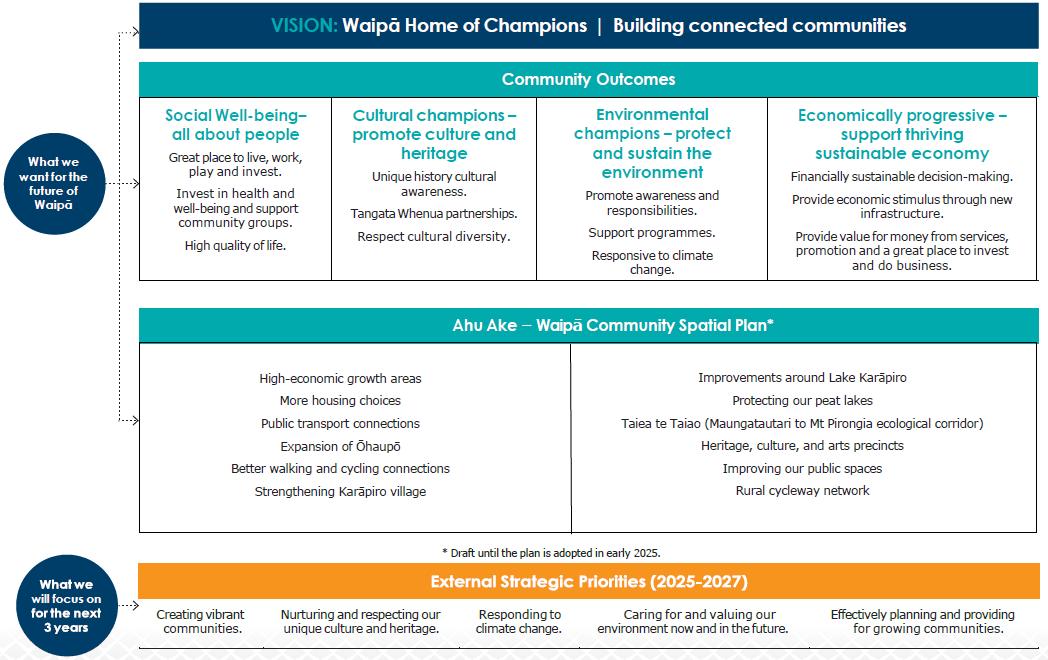
Infrastructure is vital to the quality of life of our current and future communities. With increasing numbers of people wanting to move to our district, we need to continue to build on the foundation we have today with infrastructure that supports community aspirations.
The identification, celebration, protection, and promotion of Waipā District’s heritage enriches the lives of current and future generations. The importance of heritage is recognised in this Strategy with the ongoing provision of a district museum and funding to progress planning the Te Ara Wai project. Funding for the construction of Te Ara Wai will be reconsidered as part of the 2027-37 Long Term Plan (LTP).
The importance of responding to climate change is recognised throughout this strategy and is a key focus for Council in terms of infrastructure planning, provision and resilience. As a Council, we are ensuring our infrastructure decisions enable us to work towards our goals of reducing emissions and developing assets that are resilient to environmental changes.
Ensuring that our infrastructure meets increasing environmental standards is a focus in this Strategy. We are also continuing to strengthen our response to environmental sustainability through a new resource recovery centre in Cambridge.
This is one of the cornerstones of this Strategy. We plan our infrastructure investments to ensure that Waipā continues to be the best place to live, work, play and invest.
3.3.3
The legislation and policies Council is required to follow are complex. Our infrastructure planning is underpinned by a layering of legislation and policy at both the national and regional levels. Sometimes, the priorities and desired outcomes set by different legislation and policies don't align. For example, the National Policy Statement for Urban Development requires us to make enough land available for housing and businesses, while the National Policy Statement for Highly Productive Soils prioritises the need to protect certain types of land, like highly productive soils, from being developed.
These competing objectives, along with our own priorities, influence how and when we deliver infrastructure to our communities.
These include but are not limited to the following:
National
Local Water Done Well (how we will deliver and pay for three waters services and infrastructure)
Resource management reform
Climate Change Response Act 2002
Land Transport Management Act 2003
Local Government Act 2002
National Policy Statement for Highly Productive Soils 2022 (amended August 2024)
National Policy Statement for Urban Development
Regional
Future Proof Strategy
Hamilton-Waikato Metro Spatial Plan
Waikato Regional Policy Statement
Waikato Regional Plan
Te Ture Whaimana o te Awa o Waikato – Vision and Strategy for the Waikato River
Regional Land Transport Plan
Emissions Reductions Plan
Waikato Public Transport Plan
Local
Ahu Ake – Waipā Community Spatial Plan
Waipā District Plan
Waipā 2050 District Growth Strategy
Waipā Transport Strategy
Waste Management and Minimisation Plan.
3.3.4
There are two aspects of population change that are anticipated to have long-term effects on Waipā District and the Council.
The first is enduring population growth. Population projections now indicate that the district is likely to continue to experience a net in-migration of people for the next 30 years at least. Although
there has been a slowdown in international migration into New Zealand post the COVID pandemic, this slowdown is expected to be short term with high population growth resuming.
Growth has exceeded the 2021 high growth population scenario adopted by the Council. Council recently asked Professor Michael Cameron of Te Ngira (University of Waikato) to revise the 2021 projection. This confirmed that high growth is expected to continue for the next ten years at least. The graph below illustrates the projected population growth in line with the revised figures provided in March 2025.
Graph 15 – Waipā District Population Growth 2018-2034
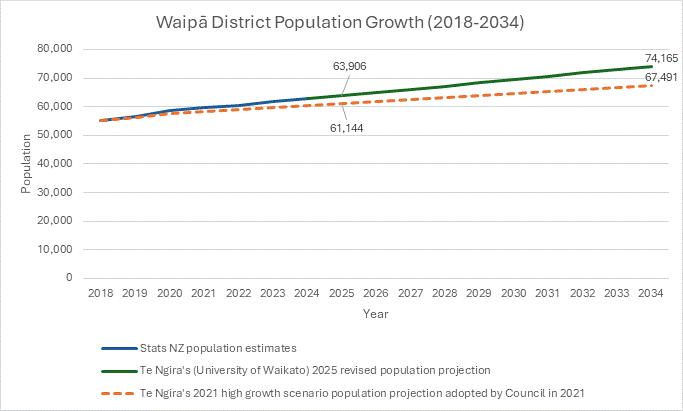
NB – this graph reflects the 2025 revised population figures.
The other change is population ageing. This trend is widely apparent through the developed world and is already evident in the Waipā District. Ageing is expected to become more evident over time. The proportion of the district’s population aged 60+ years is anticipated to continue growing the fastest. As shown in Figure 5, the proportion of the Waipā population aged 60+ years grew from 21.9 percent in 2013 to 23.6 percent in 2018. This age group already comprises almost a quarter of the overall district population.

Council commissions regular updates from Te Ngira (University of Waikato) along with its Future Proof partners to maintain a good understanding of population growth and ageing trends and changes due to migration into and from the district. More recently, this work also serves to maintain compliance with the information and monitoring requirements of the National Policy Statement on Urban Development, formerly the National Policy Statement on Urban Development Capacity. The next updated population projections are expected towards the end of 2025.
Maintenance helps ensure our assets continue to deliver the required level of service and reach their expected lifespan. Asset renewals cover the progressive replacement of existing assets as they reach the end of their useful life.
The optimum balance between maintaining and renewing assets varies across assets. For example, to maintain level of service, a highly critical asset will be proactively maintained and then towards the end of its life, renewed before actual failure, whereas a minor asset will be reactively maintained and renewed once it fails.
Overall, the level of maintenance and rate of renewal should maintain the overall condition of the asset to a standard that maintains the required level of service. Failure to do so would:
Reduce the ability of the asset to deliver the required level of service; and/or
Increase risk of full service failure; and/or
Adversely impact the whole of life cost of the asset.
A mix of the following criteria are used to identify the need for, and priority of, renewal projects:
(a) Asset age, condition, performance, and criticality;
(b) Risk of asset failure;
(c) Opportunities to align projects from different service areas to:
(i) Achieve efficiencies in time and cost;
(ii) Address multiple issues within one project;
(iii) Need for both renewals and increases in asset capacity.
Since 2017, asset condition data has been used to adjust remaining useful life for a number of asset classes when undertaking asset valuations. Base lives are regularly reviewed for depreciating assets where no condition data is available. These reviews provide updated information for Council’s asset performance data sets and guide Council’s investment in assets over time. Council considers that its asset knowledge and completeness of data sets is generally good.
Each year there is a reducing amount of ‘found assets’ (assets that are discovered or identified through activities that had not previously been recorded) added to the various asset inventories. It is noted that the asset information known about waters above ground assets is less than ideal, and collecting this data is a key focus in coming years. Replacement costs for these assets are therefore derived on a more aggregated basis (i.e. replacement of a treatment plant as a whole rather than the components which make up the plant).
Council may face additional renewal expenditure beyond that which has been allowed for in the LTP. This may result from condition assessments highlighting previously unidentified issues or early failure of assets. Should this occur, Council will evaluate the options available to continue to manage the asset and maintain service to the community. A combination of strategies is possible based on the following options:
(a) Review planned renewals (initially within the same asset class and then within the same activity) to identify which low criticality/low risk renewals can be deferred so that the funding can be used on unexpected renewals. This is the preferred option as it has the lowest risk of negatively impacting the service levels received by the community.
(b) Review levels of service with a particular focus on critical versus non- critical assets and the possible impacts on the customer through reduced services.
(c) Increase capital expenditure to accelerate renewals; this may have an impact on Council’s debt servicing costs and therefore rating levels.
(d) Increase operational costs while deferring capital expenditure; this may also have an impact on the whole of life costs of asset ownership.
Asset renewals are funded from depreciation reserves. The reserves are generated from the asset depreciation charge within Council rates. The amount is calculated annually and is based on the value of Council assets and the estimated life left.
Operational expenditure and renewals for roads and cycleways are on average funded 49 percent by Council and 51 percent by NZ Transport Agency Waka Kotahi (NZTA). Exceptions are footpaths, bus stops, shelters and carparks, for which no NZTA funding is available.
Council’s debt level is set to rise substantially peaking in year five in order to finance the infrastructure development required to enable the forecast residential and industrial growth.
The Financial Strategy sets out how debt remains within prudent limits. Debt associated with growth projects is paid down as development contributions are received (including the debt’s interest component), so effectively ‘growth generally pays for growth’ over time. The maximum debt term for capital spend associated with maintaining or improving levels of service is 30 years,
the same timescale as this Strategy. This recognises the long-term planning involved, the intergenerational benefits of the assets being created by this debt, and the need for all those who benefit from them to contribute to their costs. Council’s Financial Strategy provides more detail on how Council manages asset finances.
Our approach to service delivery for each activity is outlined in the table below.
Stormwater Collection and reticulation, retention, treatment and discharge
Wastewater Collection and reticulation, treatment, and discharge
Water Treatment and Supply Source, treatment and reticulation
These services are delivered through a mix of in house, shared services and external contractor resources.
Most operational, compliance and project management work is completed in house.
Water sampling and laboratory services are carried out by a shared services arrangement with Co -Lab (previously Waikato LASS).
External contractors are brought in to fill gaps in expertise or resourcing, and also where physical construction works are outside the capabilities or capacity of our internal crews.
Note that we are, under the Local Government (Water Services Preliminary Arrangements) Act 2024, consulting on future delivery model options at the same time as consultation on the draft 2025-34 LTP. At this stage, our preferred water services delivery option is a Council Controlled Organisation with other Waikato rural/provincial councils known as Waikato Water Done Well.
Transportation Roads, footpaths, and cycleways including associated structures and facilities
General and specialist maintenance contracts.
Bridge management professional services and data collection through the Regional Asset Technical Accord (RATA).
Specific tendered contracts for major repairs.
Joint management contract with NZTA, Waka Kotahi; Hamilton City; and Waikato District Councils for signals and separate CCTV management contract.
In-house enforcement staff.
Passenger transport Nine-year bus service contract administered by Waikato Regional Council.
Taxi provider contracts administered by Waikato Regional Council.
Libraries Delivered through in house resources.
Cemeteries Delivered through in house resources.
Community Services and Facilities
Urban sites are maintained using in house resources.
Rural sites are maintained under an external contract.
Renewals, upgrades and new facilities are identified, programmed and managed in house with the physical works undertaken by external contractors.
Street trees are managed in house with the physical works undertaken by an external contractor.
Council prepared a masterplan in 2020 for its water, wastewater and stormwater activities to inform Activity Management Plans (AMPs), infrastructure strategies and LTPs. The masterplan considered projected growth, resilience, levels of service and key influences affecting these activities. It also reviewed the current and future technical performance requirements of three waters activities and provided a 30-year programme to maintain level of service.
Since then, the Council’s population growth predictions have changed and the detailed implementation planning of some of the initial masterplan projects has resulted in a change in direction and/or scope and/or timing of future projects.
Since 2020, the water supply to Te Awamutu and Kihikihi has been improved with network improvements and treated water supply from Parallel Road in preparation for the reduction in consented take from Te Tahi; the Cambridge wastewater treatment strategy has been confirmed in association with neighbouring councils, and the new Cambridge Treatment Plant is in construction. In addition, Council has prepared catchment management plans for its main urban centres and has a better understanding of the stormwater improvements required.
Levels of service are the parameters or combination of parameters that reflect social, political, economic and environmental outcomes that an organisation delivers. Level of service statements describe the outputs or objectives an organisation or activity intends to deliver to customers. As the level of service statements, measures, and targets for the first nine years of the Strategy are covered in detail in the main body of the 2025-34 LTP, they are not repeated here.
There are no significant changes to levels of service currently planned.
The key factors that will challenge Council’s ability to deliver the desired levels of service while avoiding unsustainable debt and other challenges for future ratepayers are:
(a) Population growth – maintaining levels of service for all while expanding volume and coverage of services.
(b) Ageing population – understanding and adapting to changing levels of service requirements resulting from more people aged 60+ years within the community.
(c) Technology change – digital technology changes faster than the Council can often afford to adopt and adapt to, in its levels of service.
(d) Consent compliance - compliance needs to be maintained and, in some cases, raised, while simultaneously expanding service coverage and associated infrastructure.
(e) Increasingly restrictive consent conditions – consent conditions are expected to become more stringent as environmental standards are raised.
(f) Climate change – how does Council plan for an uncertain size and frequency of weather events and still maintain levels of service and cost- effectiveness?
(g) Increasing number of stormwater ponds and swales required as part of Council’s climate change and stormwater management response, more detention ponds and swales require more upkeep to maintain the level of service.
(h) Uncertainty around demand – within the Community Service and Facilities activity, particularly park and reserves, there is limited information to support analysis and forecasting of demand levels and its implications for levels of service.
Council faces a number of challenges when planning for our infrastructure. These challenges influence our objectives, the prioritisation of what infrastructure we invest in, and our ability to deliver on our plans.
We have identified eight significant infrastructure challenges for the district over the next 30 years.
New Zealand is facing growing challenges in providing sustainable and affordable water services. Infrastructure issues, environmental and public health obligations, climate change and growth demands, indicate that significant reform is required.
The Government requires all councils to review the delivery of water services and produce a plan for future delivery by September 2025. We know we need to change our approach towards the delivery of those services. The current approach is becoming increasingly inadequate and unaffordable. Councils need a different delivery model that complies with new legislation; ensures significant urban growth and development can be serviced; and ensures water service delivery is resilient, efficient, affordable and sustainable.
At the time of writing this Strategy, Council had consulted on the Waikato Water Done Well option (an asset owning CCO with other rural/provincial councils in the region) as its preferred option. The outcome of consultation will inform the development of the Water Services Delivery Plan. Council is required to adopt the plan and submit it for final approval by the Secretary for Local Government no later than 3 September 2025.
Over the last two decades, Waipā District has experienced steady population growth creating demand for new infrastructure and putting increasing pressure on existing services and infrastructure.
While growth rates have recently slowed, we are assuming that this is temporary, and growth rates will return to forecast levels. In the initial years of our modelling (years one to three), we only anticipate development contributions revenue related to what has already been assessed. In the following years, with most of the infrastructure delivered to enable planned growth, development contribution levels will increase to meet anticipated high population projections.
Infrastructure challenges resulting from growth include:
Council needs to provide additional core infrastructure to enable forecasted growth however, a degree of redundancy will exist within a network until growth results in full utilisation of that service. Enlarging networks too much and too quickly risks the costs of development being incurred many years before those costs can be recovered, leading to debt servicing issues. Additionally, if the forecast growth fails to materialise, Council will have reduced development contribution revenue to service its debt.
Increased pressure on the capacity of existing infrastructure.
The introduction of new activities, trends and facility requirements as the population continues to diversify in age and ethnicity.
Higher expectations of Council services as people move here from different areas and expect to see similar levels of service provided.
Three waters are significantly affected by changes in urban housing density and location much more so than other infrastructure services. Plan Change 26 -Residential Zone Intensification has already highlighted areas of the urban centres that cannot increase in density without very significant improvements to current assets that are not yet due for renewal. The Three Waters Masterplan also highlights the potential need for an additional new water source post 2030.
We want to ensure we plan for and invest in growth so that Waipā continues to be a highly desirable place to live, work, play and invest. Council has multiple strategies seeking to achieve the balance between ensuring growth is enabled and occurs in the right way, at the right time, and in the right place. These are outlined below.
1. Ahu Ake, Waipā Community Spatial Plan, provides the foundation for all future planning and investment by Council. Waipā 2050 Growth Strategy sets a pattern for the future growth of our towns and villages and integrates growth with the provision of infrastructure, to ensure a costeffective approach to development. Our District Plan, incorporating plan changes over time, enables Council to respond to the changing needs of the community. We enable development to occur through the opening of growth cells in alignment with the Waipā 2050 Growth Strategy. The development of structure plans for growth cells also ensures Council’s strategic objectives are integrated into planned developments.
2. Council will, wherever possible, try to develop new infrastructure capacity in a staged fashion: adding just enough new capacity to cater for medium-term, rather than long-term, growth. This is reasonably straightforward for reticulated systems, but less so for treatment plants or reservoirs where a single upgrade may offer a more efficient solution to modular development.
3. Council takes a staged approach to new developments so new areas are built with the right infrastructure in place at the right time (known as the ‘just in time’ approach), and to help make infrastructure investment more affordable. Infrastructure Works Agreements (IWA) are put in place with developers to enable them to deliver core infrastructure in lieu of development contributions and achieve economies of scale with project delivery.
4. While Council undertakes the strategic level forward planning of key bulk infrastructure required to support urban development, much of the local-level infrastructure is undertaken by private developers working in partnership under development agreements with the Council.
5. The delivery of most development is done by private developers who work jointly with Council and other service providers to provide the supporting roads, three waters and community infrastructure.
6. Waipā District Council has a ‘growth pays for growth’ funding principle. Debt is used to finance infrastructure development required to provide for growth until development contributions are received, as well as other capital investment such as new or upgraded assets and facilities. Debt associated with growth is paid down as development contributions are received (including the interest component of the debt) meaning growth pays for growth over time.
The current status of infrastructure in the district’s various growth cells can be found in Appendix 1.
For this Infrastructure Strategy, Council finds itself in a vastly different and constrained financial environment. Significantly higher inflation and interest costs, a sharp economic slowdown and much higher levels of debt, have placed limitations on what we can do in terms of infrastructure investment. Parts of our community are also facing challenges with affordability; therefore, we need to ensure the affordability of rates over time for both current and future ratepayers.
We can’t afford to do everything at once. We must operate within the parameters of current economic conditions and the Financial Strategy whilst also balancing community needs as identified in our AMPs. This means we must ensure that the right infrastructure is invested at the right time to achieve a balance between rates, affordability and ensuring that we do not compromise our approach to managing critical and lifeline infrastructure. In order to make the best decisions, a suite of prioritisation principles has been applied to our planning for the 202534 LTP as illustrated in the diagram below.
Our top priority has been to meet our legislative and compliance requirements. Secondly, we have prioritised ensuring that we look after our existing assets. Thirdly, we want to maintain our existing levels of service and finally, we want to ensure that our infrastructure investment aligns to Ahu Ake, Waipā Community Spatial Plan.
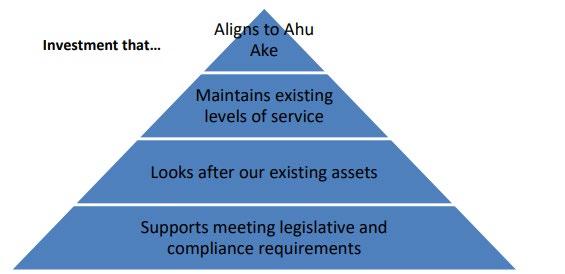
Applying these principles has meant that:
Council is not increasing levels of service in the first two years of this LTP but will reconsider this in future LTPs;
There is a gap between what we are funding and what is identified that the community needs as identified in our AMPs. Again, this will need to be considered in future LTPs; and
Our renewals programme has been reduced in the short term after being reduced in previous LTPs leading to a renewal backlog. More information on this is provided in the section below.
As noted above, Council’s renewal programme has been reduced in previous LTPs and is also reduced in the early years of the 2025-34 LTP. The information below explains how the backlog will be managed.
Asset renewal of the urban water, wastewater and stormwater is planned based on a number of factors including age and material reflected in base life, asset criticality and also operational experience, e.g. regular blockages due to dips in pipelines and any reliable condition physical inspection/rating.
The condition of our three waters assets is assessed via Council undertaking physical condition inspections of a small percentage of assets per year generally focussing on the higher criticality pipes. This means the accuracy of condition ratings (especially for older assets) is unreliable and will be a focus for improvement in the coming asset management cycle, i.e. a process to reduce and if necessary, remove a condition rating if a physical condition investigation is not undertaken during the asset life.
In recent years, Council has not been funding three waters renewals in line with good asset management practice i.e. allocating annual budget to renew assets at around two percent of asset valuation. Asset renewals have primarily been based on critical assets exceeding base life and assets with known poor condition or those requiring significant operational maintenance intervention. There has also been the potential for early renewal of pipes where capacity issues due to growth have been identified.
Assets that are still in service past their original base life are generally given a short extended base life at each valuation. The process of changing the base life is called an optional base life. Optional base lives are also used where poor asset condition is discovered (e.g. by CCTV or physical cut) resulting in it being prudent to reduce the base life meaning an asset is considered for renewal earlier.
Below are examples of optional base lives in the three waters space for the pipe networks;
Water: The total network length is 492km with 156km of these assets having optional base lives. Looking more closely at these, of the 23 percent of assets with optional base lives, roughly half have been extended and half have decreased.
Wastewater: The total network length is 318km with 174km of these assets having optional base lives. Looking more closely, of the 55 percent of assets with optional base lives, roughly half have been extended and half have decreased.
Stormwater: The total network length is 182km with 59km of these assets having optional base lives. Looking more closely at assets with optional base lives, 84 percent have reduced base lives due to poor condition. It should be noted that the stormwater network is significantly younger than the water and wastewater networks with urban stormwater reticulation becoming prevalent in the 1970s, therefore fewer are exceeding their base lives.
Asset renewal of structures, furniture, fencing, signs and playground equipment is planned based on several factors including:
A ge and material reflected in base life;
Asset criticality;
High usage areas; and
Any reliable condition physical inspection / rating.
In terms of condition rating, in addition to a robust maintenance and inspection programme, third party physical playground audit inspections are undertaken on a three yearly cycle. Structural inspections are undertaken by a structural engineer on a five yearly cycle. These inform future renewals based on information provided on remaining useful life, urgency of replacement and cost. Renewals focus on high-risk structural assets in the first instance.
Historically budgets have not covered the estimated cost of replacement due to high inflation rates experienced since the previous structural inspection which has led to a smaller number of renewals being carried out per annum.
Furniture, fences, barriers, and sign renewals are condition rated every three years with inspections undertaken by staff. Because parks and reserve assets are seen regularly by operational staff, any assets requiring immediate attention due to a health and safety risk to the public are replaced immediately if they are in a high-profile area or removed if immediate replacement is not required.
Many assets are still in service past their original base life and are generally given a short extended base life at each valuation (optional base life). Optional base lives are also used where knowledge and risk dictate it prudent to reduce a base life, so an asset is considered for renewal earlier.
Specific information on the backlog in renewals is outlined below.
Parks structural renewals – pedestrian bridges, viewing platforms, boardwalks, retaining walls
Parks renewals –bollards, fences, seats, picnic tables, signage
There is a backlog as inspections identified assets that needed renewals, some of which haven’t been done. Safety triggers have superseded scheduled renewal programmes due to budget constraints.
There is a backlog of poor and very poor condition assets. Replacement of assets is managed within current budget parameters with high profile and premium sites prioritised. Assets on other sites are well past their life and are renewed where safety is compromised, and in some instances asset failure in low use areas occurs.
Playground equipment and safety surface renewal
Approximately 25 percent of existing playground assets are past their projected renewal date. However, to leverage best value, assets are not replaced individually unless they present a health and safety risk but rather are kept in place until the whole playground can be renewed.
Should assets present a health and safety risk to users, they are removed immediately.
According to the current budgeted programme, poor condition renewals are on track for the next two years. The budget cannot be reduced as there are eight playgrounds that contain play equipment exceeding their 15–20-year lifespan.
The backlog of assets primarily refers to road surfacing and road pavements, especially in terms of the high value of renewal works associated with these assets.
This backlog is more theoretical in nature as these assets continue to function adequately. However, the lack of timely renewal results in a rougher road network condition which necessitates more intensive management and frequent maintenance interventions to maintain operability. For some of our customers, this road condition and the resulting intensive maintenance regime may be deemed unacceptable. If the renewal of these assets is left for too long, then road safety is also compromised.
Our approach to managing asset renewals includes:
Management System: We utilise Asset and Work Manager (AWM) (previously known as RAMM) to manage our assets. This system has been an industry standard for many years, and we maintain a high level of confidence in its data integrity.
Asset Lifespan Factors: Our assets operate in a complex environment with numerous factors affecting their useful life, resulting in significant variations in longevity across different assets.
Renewal Decision Process: The trigger for asset renewal combines asset management principles with budget constraints. Forward planning of renewals heavily depends on experienced practitioners interpreting AWM data and outputs, modelling using dTIMS software, complemented by site inspections and testing.
Treatment Selection: Various treatment options are considered based on their design life and available budget allocations.
Council’s ability to plan and carry out the proposed programme of infrastructure capital works will impact the overall delivery of infrastructure. When completing large, complex capital works programmes, there can be challenges related to capacity constraints on internal and/or external resources and uncertainties in the delivery supply chain.
In setting the capital works programme for the 2025-34 LTP, consideration was given to our historical delivery capacity and our significant forecasting assumptions. Council right sized our programme accordingly, including adjusting for inflation. The programme is based on regular communication with developers, IWAs and what we currently know regarding developer timing. Council has regular contact with developers across the district and will only sign up to a Developer Agreement or IWA if there is a known development in line with the infrastructure provisions.
Although there is little Council can do in terms of supply chain issues, workforce resourcing will require ongoing commitment to programmes supporting employment pathways (such as Waipā’s recently established apprenticeship programmes) and use of technology advancements.
The need to respond to climate change and its impacts has gained significant momentum. International consensus is that urgent action is needed in the next decade to manage and adapt to global temperature rises. The potential impacts of climate change on Waipā’s infrastructure assets include:
Existing infrastructure may not have the capacity for increased high-intensity rainfall events which could exceed the capacity of our stormwater networks.
Increased frequency and intensity of drought conditions will increase demand for water while at the same time low summer water levels in the Waikato River will challenge Council’s ability to extract sufficient water for treatment to meet that demand.
The anticipated increase in deformation of our peat roads which will drive lower useful lives of these assets.
Consider alternative measures to address water allocation deficits both within Waipā and regionally as drought impacts the availability of water for municipal use.
Drought events impacting the economy of Waipā due to the high level of dairying and increasing levels of horticulture, particularly if this also led to peat fires.
Uncertainty in population projections as internal migration is impacted by coastal retreat.
Impacts on Civil Defence Emergency Management functions to ensure Waipā is adequately prepared to respond to any effects of climate change (weather events, fires, etc).
Climate change is one of Council’s strategic priorities and we are increasingly integrating mitigation, adaptation, and risk management into our infrastructure planning and decisionmaking. A key part of this work is our comprehensive climate change risk assessment which is being carried out in two phases:
1. An Organisational Climate Change Risk Assessment (OCCRA) to evaluate physical risks such as flooding, drought, and extreme weather events on Council’s infrastructure, assets, and services.
2. Then a Community Climate Change Risk Assessment (CCCRA). This will expand on the approach above to assess risks across the whole district (not just Council’s infrastructure assets and service), and will involve engagement with the community, iwi and mana whenua partners, and other stakeholders to identify district wide risks and opportunities.
The OCCRA work has already identified and prioritised risks with response planning now underway. This assessment was based on projections from two climate change scenarios developed by the Intergovernmental Panel on Climate Change (IPCC), a SSP2-4.5, a ‘middle- ofthe-road’ emissions and warming scenario, and a SSP3-7.0 higher- emissions and warming pathway. The assessment followed the Ministry for the Environment’s climate change risk assessment framework to ensure consistency with national guidance.
The OCCRA highlights direct physical risks to Council’s assets and services. Key risks include:
Parks and reserves are vulnerable to rising temperatures, more extreme weather, and biosecurity threats, which could impact biodiversity, increase maintenance costs, and put recreational and conservation areas at risk.
Older stormwater infrastructure faces risks from heavier rainfall, which could lead to stormwater system failures flooding and infrastructure damage.
Transport networks are exposed to rising temperatures and drought, which may compromise roads and bridges, increase maintenance costs, and potentially affect safety.
In addition to these physical risks, the assessment identified broader indirect risks such as financial pressures and regulatory changes. More frequent extreme weather events could drive up operational and capital costs, affect insurance availability and affordability, and increase legal and planning complexities, particularly around flood-prone areas. Competition over water resources, especially regarding the Waikato River, could also create economic and environmental challenges for the district. The OCCRA provides a strong foundation for embedding climate resilience into Council’s planning. Next, these risks will be integrated into activity-level adaptation planning, ensuring they are considered in AMPs, business plans, and organisation processes. The findings will also shape higher-level strategic planning, potentially feeding into documents such as the Waipā 2050 Growth Strategy, Town Concept Plans, and Economic Wellbeing Strategies. Most importantly, this work will directly inform the 2027–37 LTP by informing future operational and capital budgets to ensure our infrastructure and services are better prepared for the challenges of a changing climate.
To support our broader climate change response, we are also drafting a Climate Change Strategy that will consolidate our climate-related work into a single, accessible document. A key purpose is to provide a more coordinated and transparent approach for our communities, rather than having all climate change work spread across Council documents.
Additionally, carbon impact assessments are now required as part of business case development, and further mitigation considerations are being further embedded into activity management planning through key steps such as the design phase of project management. This ensures we are actively working to reduce our internal greenhouse gas emissions while maintaining essential services and infrastructure.
Council operates within a complex legislative and policy environment with increasing expectations required from Central Government, Waikato Regional Council and the Waikato River Authority. Meeting these increased expectations requires significant infrastructure investment. Changes in the direction of major reform areas such as resource management, local government and three waters reforms, have also occurred as the political environment has changed. This has introduced complexities into infrastructure planning.
To keep informed of these changes and to be able to respond accordingly, a cross- organisational Project Steering Group has been established. Regular reporting is provided to the Executive Team and Elected Members as appropriate.
We cannot do this work alone therefore building and strengthening our key partnerships is a crucial part of planning for and delivering infrastructure for our communities. Key partnerships include mana whenua and iwi, Central Government, Waikato councils, private developers and community and corporate organisations.
Future Proof - Te Tau Tiitoki is a key partnership established to consider how the sub -region should develop into the future and includes the development and implementation of a sub -regional growth strategy. Partners include Waipā, Waikato and Matamata-Piako district councils, Hamilton City Council, Waikato Regional Council, Waikato Tainui, Tainui Waka Alliance, Tāngata Whenua and Central Government agencies.
This sub -regional approach is needed to manage growth in a staged and coordinated manner and to address complex planning issues, especially cross-boundary matters.
Council has also adopted the Anchor Institution Framework and Implementation Plan. A key component of the framework is to partner with other anchor institutions in the area to leverage strengths and look for opportunities to enhance community wellbeing.
This section outlines the most likely scenario for the management of our infrastructure. This scenario has been determined by:
Including the funded capital and operating budget forecasts from the draft 2025-34 LTP. The timing of projects and budget provisions have been informed by our AMPs.
Identifying projects through the LTP that are unable to fit within our financial parameters set by the Financial Strategy. These projects will be revisited in future LTPs.
Including the forecast capital and operating needs for 2035/36 through to 2054/55 as identified in our AMPs.
Our forecasting assumptions.
The plan for the next two years is the most accurate. The remaining seven years are higher level but with reasonable confidence in what we are projecting. The remaining years are a forecast and are subject to change noting that the Infrastructure Strategy is reviewed as part of every LTP. The charts below show the annual funded capital for the first ten years, and in five year blocks the funded and forecast capital for the full 30 years.
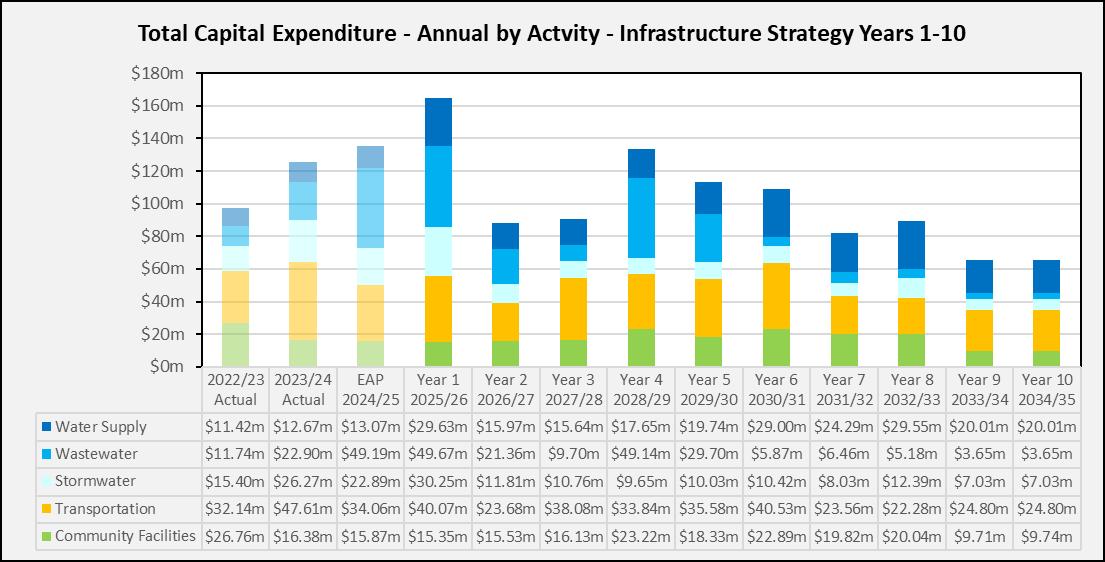
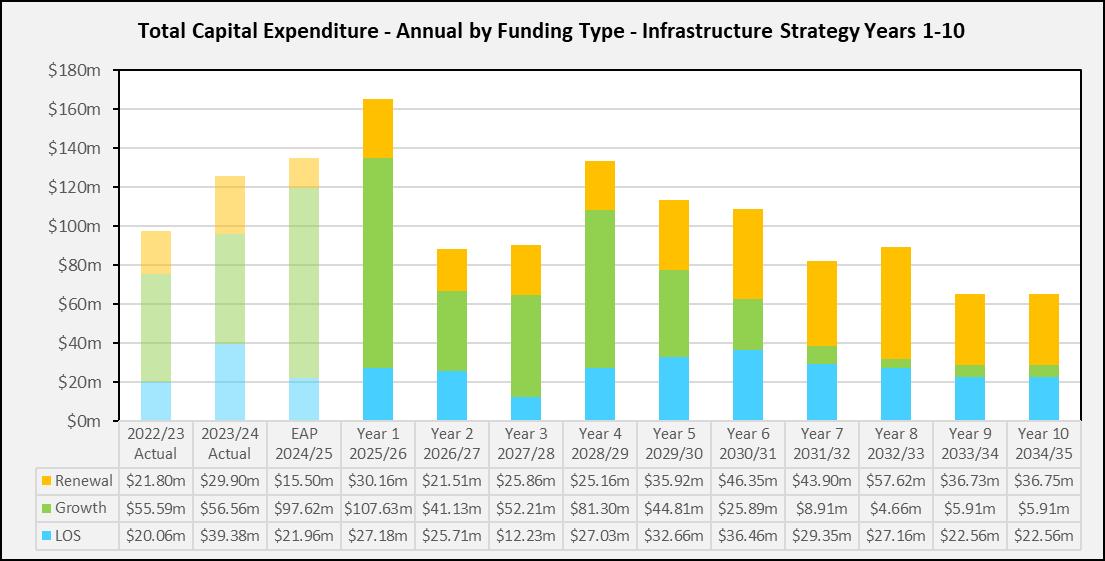
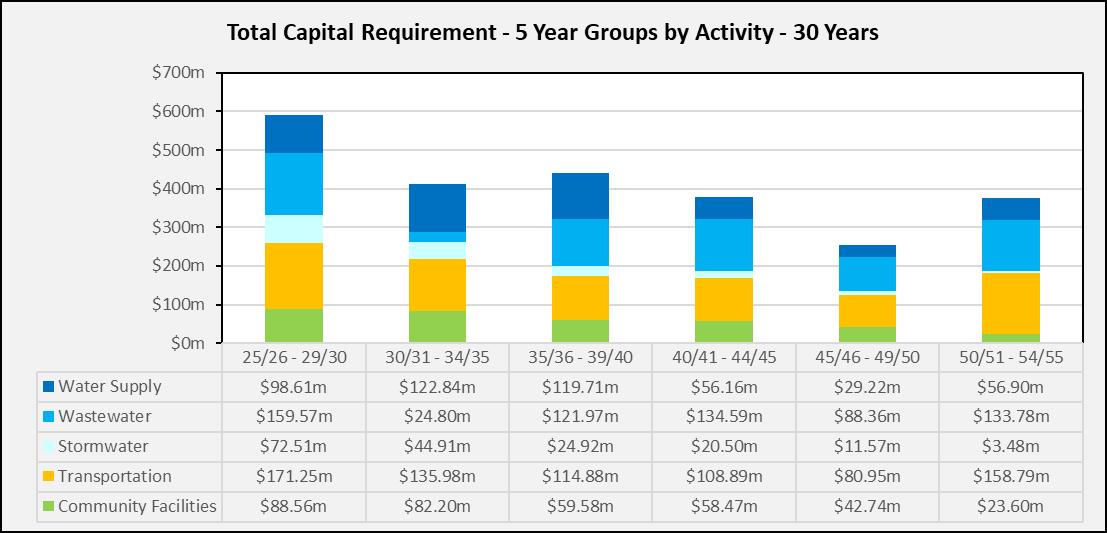
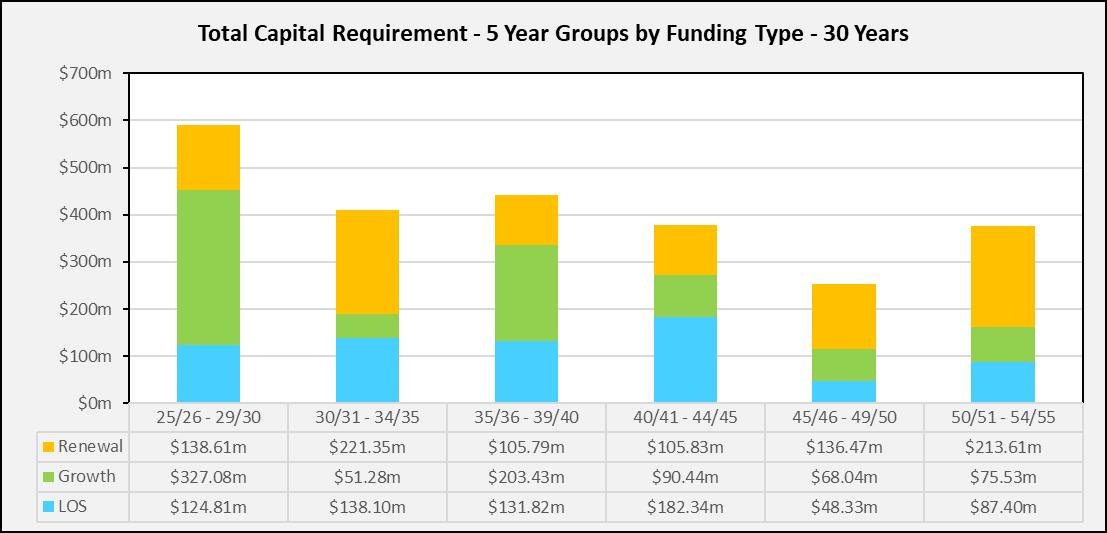
The following significant proposed projects have not been funded in the 2025-34 LTP as they do not align with our prioritisation principles. It is expected that these projects will need to be considered for inclusion in future LTPs. By delaying these projects there is a risk that final costs for delivery will be higher than current estimates. Activity
Design and build Te Ara Wai plus related exhibition planning, design, development and install, packing and moving museum
collection, Te Ara Wai marketing resource, Te Ara Wai transition
Community Services and Facilities - Heritage
Community Services and Facilities - Libraries
Te Ara Wai collection store
$30.2m
Relocating Climax Engine
New Cambridge Library and community hub
$3.2m
The museum will remain in the Roche Street building which is no longer suitable for a modern museum. There will remain limited capacity for museum back of house functions and limited space for exhibition, public and education programmes, and visitor services such as toilet facilities and parking. The location is also isolated from similar public facilities limiting opportunities for spontaneous visits.
The collection will have to remain housed in the current collection store and external storage unit, which has limited space to store objects to best practice standards and limited space to grow the collection.
$654,000 The Climax Engine will have to remain in storage at the Daphne Street Council depot.
$32.4m
We can expect increases in the impacts on library services due to the current inadequate facility. These include:
More items stored in places not designed for them;
Decreasing numbers visiting the library as the building becomes increasingly uncomfortable/overcrowded;
Increase in the number of people unable to access programmes and events as the population grows but the building capacity to hold additional events remains static.
Activity area Proposed projects not
Cycling - Te Awamutu/Ngaroto/Pirongia
Connection
Premier reserves development
C8 Hautapu industrial land acquisition and development
Horahora Domain land purchase
Cycleway Te Awamutu/Pirongia Section 2
Plan Change19 - Carters Flat -
Community Services
Community Services and Facilities - Parks
T6 reserve land
Acquisition of conservation land
$6.9m
$328,000
$787,500
$325,000
$4.4m
$2.5m
$2.7m
$7.5m
Implementation of Sports Clubs Lease
Model review
Pioneer Walkway - cycling implementation
Selwyn Park events space / community hub
Implementing National Policy Statement for Indigenous Biodiversity
Community Services and Facilities - Property
Community Services and
Arnold Street Depot Feasibility
$10.4m
$3.6m
$1.1m
$400,000
$325,000
Consequence of not funding these projects
Planned increase in level of service will not occur. Economic benefits arising from cycling tourism will not be achieved for Te Awamutu.
Planned increase in level of service will not occur.
Land acquisition will not occur preventing reserve provision in that area.
Planned expansion of the reserve will not take place.
Planned increase in level of service will not occur.
The planned increase in walking facilities and the improvement of maintenance access will not occur.
No neighbourhood, sports field, conservation, and amenity provision will be provided within the T6 structure plan area.
Land adjacent to conservation reserves will not be purchased, thus no reduction in negative impacts of neighbouring activities on conservation sites.
Level of service not being met with some codes and informal sporting clubs not having access to sports fields.
Planned increase in level of service will not occur.
Community anchor point to support larger scale events close to Te Ara Wai (also not funded) will not be provided.
Unable to meet National Policy Statement requirements.
None – alternative funding options available.
Water supply improvements
$930,800
Bulk water deliveries will have to be made to ensure water supply at some rural toilets. This will incur additional opex costs.
Activity
Facilities – Public Toilets
Public conveniences: new facilities district wide
Public conveniences - new toilet blocks developer built
Seal extensions
Transportation
T6 St Leger Road network upgrades roading concept plan
Kelly Road urbanisation
$3.1m
Plan Change 19 - Carters Flat -
Transportation
Te Ara Wai transport improvements
$818,900
$6.7m
$14.3m
$1.1m
$11.0m
$3.5m
Te Awamutu western arterial road n/a
Hamilton Southern Links TBD
Areas identified as requiring public toilet provision in order to meet desired service levels will not be serviced until 2034/35 at the earliest.
No new toilet facilities will be provided.
No gravel road sealing meaning the remaining approximately 34km of unsealed road in Waipā will be maintained as metal roads.
Delay in achieving desired service levels.
T6 growth cell is unable to be developed unless fully funded by landowners.
The southern end of Kelly Road adjoining Cambridge Road will remain narrow and non-kerbed until reconsidered in a future LTP.
Carters Flat growth has not been facilitated.
No implications as Te Ara Wai has also not been funded.
Council has reviewed the case for a western arterial road and made a decision to uplift part of the designation for a ring road to the west of Te Awamutu. This is on the basis that the new road would be unaffordable to build and not deliver adequate benefits. Alternative strategic transport improvements for Te Awamutu have been identified instead and these will be pursued in future LTPs. Parts of a western road may still be delivered in future, but they would be aligned with urban housing growth.
This is a planned new highway linking SH1 at Tamahere to SH1C on the west side of Hamilton at Greenwood Street. It makes changes to SH3 and SH21 and impacts several local
Activity area Proposed projects not funded
Estimated cost
Stormwater
Detention Ponds/Houchens Pond $2.1m
Consequence of not funding these projects roads in the Rukuhia area. It was designated in the Waipā District Plan in 2016 and will be built by the NZTA.
Construction funding is not yet confirmed but could begin after 2027. When built it will improve access to industrial and commercial development around the airport and enable further housing within Hamilton City. It will also change some traffic patterns on existing Council roads and some existing sections of Highways 3 and 21 will become redundant and revert to being Council roads for property access. These changes will be recorded in a Network Plan to be developed by NZTA, Waipā and Waikato District Councils and Hamilton City Council, who are all impacted by the new highway development.
Large portions of Houchens Pond were completed in late 2023 as emergency works due to issues with a dam failure. Any further costs associated with these detention ponds related to consent conditions will need to be funded from operating expenditure as they are not funded in the 2025-34 LTP.
Provision, maintenance and management of future stormwater infrastructure
TBD
In July 2022, Council submitted a comprehensive stormwater discharge consent renewal to Waikato Regional Council for Waipā’s urban stormwater system management. It is expected that the consent will be notified in April 2025.
Council anticipates that the renewal will drive a much higher level of discharge quality requirements and require higher levels of capital and operating investment.
As these impacts are not yet fully understood, no provision for this investment has yet been included in this Strategy beyond what is required to cater for growth areas where individual consents provide clear guidance on what is needed. Plan Change 19 - Carters
Carters Flat growth has not been facilitated.
Southern Wastewater Treatment Plant
Fairview Road Water Main
$600,000
The primary need for this plant is for the servicing of Hamilton Airport and its associated industrial growth cells. Council is presently servicing them by tankering wastewater to the Te Awamutu Wastewater Treatment Plant but as growth progresses and wastewater generation increases, this will cease to be feasible.
The challenges related to this project are estimating when new developments will occur and therefore will require the new treatment plant to be available and ensuring we have sufficient lead time to negotiate that with Hamilton City Council plus install our own pumps and pipelines from the airport to the Southern Hamilton treatment plant.
Alternative solution - the Te Awamutu trunk water main upgrade presently under construction should alleviate the Fairview Road issues.
Council’s Financial Strategy has been revised as part of the 2025-34 LTP. The Financial Strategy outlines our financial vision and priorities for the next nine years. It aims to ensure we are achieving a balance between the needs of our community, responsible management of our assets, and financial sustainability over the long-term.
The Financial Strategy describes the impact on debt and rates of the Council’s budget. It has been recognised that for growth councils, it is becoming more difficult to meet the debt to revenue financial benchmark. Council’s lender, the Local Government Funding Agency (LGFA), invited high growth councils, of which Waipā is one, to apply for a bespoke covenant which increases Council’s borrowing limit to 3.5 times the amount of revenue collected.
Waipā applied for the increase in borrowing limit and it was subsequently approved by the LGFA in February 2025. The increased debt covenant will enable us to more sustainably fund our capital work programme, retain affordable interest rates and have an appropriate level of debt headroom.
Our level of debt peaks in year five due to an unprecedented historic investment in projects to improve the district and enable continued growth, coupled with slower realisation of the planned growth in the earlier years of our LTP. We anticipate that this will correct with increased economic activity throughout the country from year four of the LTP, with high levels of development contribution revenue being paid to reduce growth related debt. A forecast lower capital work programme from year seven of the LTP, coupled with higher revenue levels means that our overall debt level is forecast to decrease towards the end of our LTP. This is represented in the graph below.
Council has estimated its operational costs for the next 30 years. The first ten years are based on the 2025-34 LTP. For the remaining years we have used inflation and the projected impacts from the 30-year capital forecasts to make our estimates. The charts below show the annual funded
operational costs for the first ten years, and the funded and forecast operational costs for the full 30 years in five year blocks.

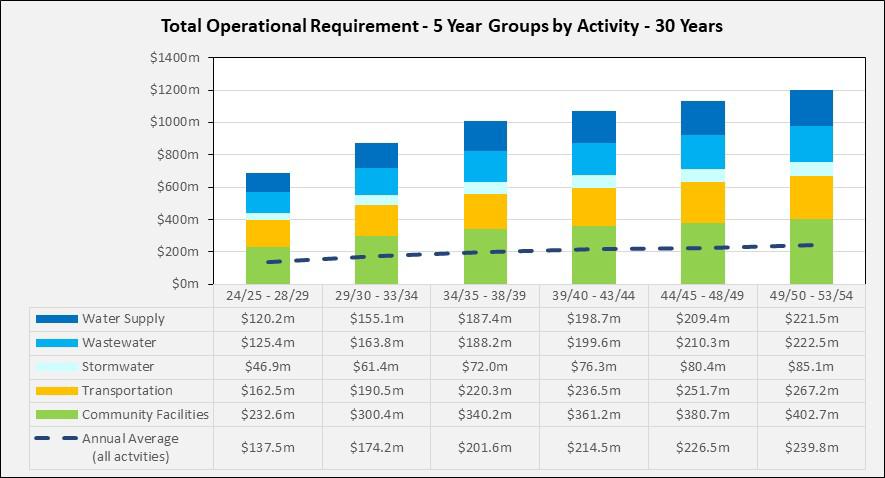
In this section, we have identified six significant issues, explained our approach and the options considered to address them, and discussed the associated implications. We have also outlined how we intend to manage the related risks to meet the needs of both current and future generations. Council has identified its preferred options for managing these issues as part of the 2025-34 LTP process and incorporated them into the most likely scenario as presented in this Infrastructure Strategy.
These issues have the potential to either:
Require significant investment;
Change our current approach to infrastructure management and delivery;
Change an existing level of service or require a new level of service; and/or
Have a significant impact on our community.
Backlog of renewals
The cumulative impact of deferring renewals in previous LTPs due to affordability has resulted in a backlog of renewals in most areas. The backlog peaks in year 3 with approximately $23.3m of renewals backlog, equating to 28 per cent of renewals unfunded at that point. The backlog is budgeted to be cleared by year 8.
This brings increased risk associated with:
• Maintenance costs;
2025-34
$351.8m of capital renewals across Council.
2035-2055
No additional funding required as the backlog will be cleared by year 8.
Council considered three options to address the renewals backlog. Each option has trade-offs.
Option 1: Fully funding renewals at an optimal level would eliminate the backlog quickly, reduce future risk and ongoing maintenance costs. However, this would place a significant financial burden on ratepayers in the short term and would not be affordable.
Option 2: Continuing to defer renewals in the long term avoids
Council has decided to prioritise looking after what we’ve got and focus on catching up on renewal spend over the duration of the 2025-34 LTP. The majority of this will occur in the later years of the plan as debt levels reduce.
By choosing this approach, Council will reduce the risk overtime of asset or service delivery failure. There is still, however, a higher risk in the earlier years of the plan, due to the renewals programme not ramping up until the later years.
• Unplanned asset failures leading to reduced levels of service, including increased environmental damage and increased health risks;
• Negative reputational impacts for Council.
short-term costs but increases long-term costs due to emergency repairs and escalating maintenance needs. This approach also heightens the risk of asset failures and potential legal, environmental, and reputational consequences. There is a chance technology may become available in future with lower costs (e.g. lining pipes rather than digging up and replacing them), however relying on this carries additional risks.
Option 3: Staggering and then ramping up the renewals over the first ten years of the Strategy to prioritise looking after what we’ve got, balances affordability while reducing risk to tolerable levels, noting some assets may have increased risk of failure in the early years due to the slower renewal timeline. This option would mean the backlog of renewals is resolved by the end of the nine year plan. This is the preferred option.
Topic Why
Infrastructure capacity –catering for growth at the right time
A significant portion of our capital expenditure is growth related. It is important that Council manages this programme of work to reflect changing market conditions. If there is a slowdown in uptake and revenue, then the capital work programme needs to adjust to reflect this. Conversely if development increases significantly, Council needs to ensure the capital work programme supports the delivery of growth-related infrastructure.
It is financially prudent for Council to largely realise existing infrastructure investments in growth cells under development before taking on new growth areas where there is a significant cost to Council.
2025-34
$375m growth related capital across Council.
2035-55
$440m growth related capital across Council.
Council considered three options to cater for growth at the right time. Each option has trade- offs.
Option 1: Delivering all required infrastructure as soon as possible would ensure full capacity is available to support growth. However, it requires higher debt levels for an extended period and places a significant financial burden on Council (and ratepayers). This is not sustainable within existing financial limits.
Option 2: Limiting or deferring infrastructure investment reduces immediate capital expenditure. However, this increases the risk of noncompliance with national policy requirements, constrains growth opportunities, and could shift development elsewhere. Over time, underinvestment may also lead to higher costs due to the need for reactive upgrades.
Capital expenditure for growth has been prioritised where growth cells have been activated and/or development agreements are in place. This approach ensures Council is not over or underinvesting ahead of projected growth rates or causing demand issues for the community. Correct timing also manages the risk associated with potential increases in construction costs over time and ensures revenue generated through development contributions is timed appropriately against expenditure. This decision will need to be reconsidered in the 2027-37 LTP due to the implementation of the medium
Option 3: Aligning infrastructure investment with actual development uptake balances affordability while ensuring infrastructure is delivered in step with market conditions. This approach reduces the risk of overinvestment, manages financial requirements, and allows flexibility to respond to changes in growth demand. This is the preferred option. density residential standard and potential for greater demand on infrastructure.
Increased investment in community facilities
Growth, increasing community expectations and a historical reduction in our renewals programme, means there is an ever-increasing need for greater investment in community facilities. This includes:
• Te Ara Wai Museum in Te Awamutu;
• New Cambridge Library;
• Cambridge Town Hall upgrade;
• Te Awamutu to Pirongia Cycleway;
2025-34
$6.6m capital budget for land acquisition for cemetery capacity growth.
Operational funding:
• $137,500 for Te Ara Wai
• $75,000 for Cambridge Library
Council considered three options regarding investment in community facilities.
Option 1: Fully funding all proposed projects would allow for timely delivery of new and upgraded community facilities, while meeting growth demands and community expectations. However, this approach is not financially feasible within current funding constraints and would require significant increases in debt and rates.
Given the significant financial constraints in the draft 2025-34 LTP, Council has placed the following community facilities cornerstone projects on hold to be reconsidered as part of the 2027-37 LTP:
• New Cambridge Library
• Te Ara Wai Museum in Te Awamutu
• Cambridge Town Hall upgrade
Council has decided to provide limited investment for community facilities in the 2025-34 LTP. The primary focus is on renewals; however, funding has been provided for cemetery land in the later years of the plan. With Council’s focus being on renewals and maintaining levels
• Land for future cemetery capacity.
Capital funding of $621,000 for Cambridge Town Hall over the nine years.
These figures are adjusted in later years to account for inflation.
2035-2055
$62m (excludes renewals)
Option 2: Not funding any of the projects would reduce financial pressure but would not address community needs and limit access to important cultural and recreational facilities. Additionally, some assets may deteriorate without investment which would increase long-term costs.
Option 3: Aligning investment with the principles outlined in section 4 to look after what we have got, prioritises essential renewals and maintains limited operational funding to keep key projects progressing. This ensures that future opportunities, including cofunding arrangements, can still be explored while aligning investment with Council’s financial constraints. Major community facility projects will be reconsidered in the 2027-37 LTP. This is the preferred option.
• Te Awamutu to Pirongia Cycleway. of service, community aspirations may not be fully met in the short term.
Prioritisation of Transport Strategy implementation Waipā’s 2022-52 Transport Strategy sets the outcomes that will help us work towards an integrated, safe, sustainable transport system. Financial constraints mean that the implementation of some of the Strategy’s outcomes will need to be prioritised over others. This LTP responds to the Central Government Policy Statement on Transportation 2024, which reprioritises national funding away from passenger transport outside main centres, walking and cycling, and local road safety improvements.
2025-34
$282.4m in capital costs has been provided for the roading activity.
$317.8m in operating costs has been provided for the roading activity.
Co -funding opportunities are also being explored.
2035-2055
$182m of capital expenditure
Council considered three options regarding Transport Strategy implementation.
Council has chosen to prioritise the following strategic outcomes:
Option 1: Fully funding the Strategy. This would enable timely delivery of transport infrastructure and services. However, with no guarantee of Central Government fundinghistorically covering 51 per cent of Council’s transport activitiesfully funding new initiatives would place a significant financial burden on Council and ratepayers.
Option 2: Not funding the Strategy. This is not a viable option as transport infrastructure and services are essential to community functioning and wellbeing. A significant reduction in services would lead to safety, accessibility, and economic impacts. It is not an option to stop or substantially reduce services.
• Reduce greenhouse gas emissions through providing more travel options;
• Improve road safety;
• Maintain rural roads;
• Progress the Cambridge Connections project;
• Progress the expansion of the public transport network (Noting this relies on Regional Council and NZTA funding support going forward and is part of an adopted Regional Passenger Transport Plan).
The implications of not fully funding the implementation of the strategy include increasing the risk of road traffic congestion continuing to worsen leading to increased travel times and increased emissions.
Increasing environmental standards and compliance requirements for three waters
Increasing environmental standards and compliance requirements for resource consents require increasing three waters investment over the next 30+ years. For both of Waipā’s wastewater treatment plants (WWTP), there are requirements for periodic reviews (both technological and environmental) over the life of the discharge consents. For example, the Cambridge WWTP requires reviews following the 10th, 15th, 20th and 25th
2025-34
$490.7m in capital funding across the three water activities.
$589.5m in operating costs across the three water activities.
2035-55
$128m of capital expenditure
Option 3: Prioritising strategic outcomes allows for a balanced approach, acknowledging that achieving objectives will take longer. This ensures transport infrastructure and services are maintained while aligning investment with long-term funding certainty, avoiding inefficient start/stop service provision. This is the preferred option.
Council considered two options regarding investment in three waters infrastructure.
Option 1: Not funding the required investment. This is not a viable option as Council would be in breach of environmental regulations and resource consent conditions. It would also expose Council to legal, financial, and reputational risks while failing to meet community expectations for improved water quality and environmental protection.
Council has decided to invest in three waters activities to ensure increasing compliance requirements and environmental standards are met.
This decision will ensure that Council is compliant with legislative requirements aligned with our prioritisation principles.
anniversaries of commencement of the various discharge consents. These reviews may determine that further investment is needed at each plant to address any deficiencies or for required upgrade works. Investment to address any capacity issues identified (such as population growth exceeding assumptions) would also be aligned with any initiatives in response to the consent review outcomes.
Further investment in stormwater management and discharge quality improvements are anticipated over the next 30 years to meet community aspirations of improving the water quality of the various awa impacted.
Option 2: Funding the necessary investment ensures compliance with evolving environmental standards and regulatory requirements. Council’s approach aligns with Te Ture Whaimana and the commitments outlined in the Southern Metro Wastewater Detailed Business Case. While future wastewater standards may exempt the Waikato and Waipā river catchments due to comanagement arrangements, Council’s planning assumptions remain unchanged to ensure infrastructure continues to meet consent conditions and community expectations. This is the preferred option.
Council considered two options: By Council choosing this option, we will get a good understanding of available water sources This decision will allow Council to determine the optimum new water
of raw water for treatment circa 2025-2040 (depending on growth rate).
$64m of capital expenditure Option 1: Do minimum – rely on previous investigations around Te Awamutu only.
Option 2: Undertake a review of possible new sources, which will include groundwater and potentially a water take from the Waipā River. Also review potential treated wastewater reuse from our Te Awamutu and Cambridge wastewater treatment plants. This is the preferred option.
Changes in legislation
That we will continue to see legislative change from Central Government that will influence economic, social, cultural and environmental outcomes. This includes changes to the purpose of local government, planning and resource management, the Local Water Done Well framework, building, emergency management and transport funding and priorities.
Details of emerging legislative changes are unable to be anticipated with any level of certainty therefore, current legislation is guiding our LTP approach.
Very high
and the preferred option to develop future water supply. source for the district which will subsequently need to be developed to ensure that Council has adequate water supply in the future.
Continue to work with Central Government (individually, and collaboratively with others) to influence policy and legislative change.
Continue to collaborate as a region or sector in responding to change, and to streamline plans, policies, and strategies.
There is a risk of unexpected changes to legislation that may alter the nature of services provided by Council. There may also be financial implications caused by implementing changes.
That Council will continue to deliver water supply and wastewater infrastructure and services for the full period of the 2025-34 LTP.
At the time of writing this assumption, consultation on Council’s Water Service Delivery Plan was scheduled to take place from 9 May to 9 June 2025 alongside LTP consultation with a final decision on the preferred water service delivery option being made mid-calendar year. However, this will not be confirmed until the Department of Internal Affairs has approved Council’s Water Services Delivery Plan.
Once this approval is received, it is acknowledged that an LTP amendment will be required prior to 1 July 2026 if Council proceeds with a two -waters asset owning CCO model (with stormwater services provided as a contracted service) from that date.
Due to uncertainty around final legislation, there could be a financial or resourcing cost that was not been accounted for.
That partnerships with Māori will continue to increase in importance.
There will be new opportunities for improved collaboration and partnership over the next nine years as we establish a more strategic approach to working with Māori to address priority outcomes and community wellbeing.
‘Failure to manage change and respond to the uncertainty of the wider business context’ is a top risk to the achievement of Council’s strategic priorities.
High Continuing to collaborate with the sector including the Department of Internal Affairs as well as, Waikato Waters Done Well, Hamilton City Council and Waikato District Council.
Very high Council has a dedicated role and staff focusing on building and maintaining effective relationships with key partners including iwi and mana whenua. Work is progressing on the development of a Tangata Whenua Partnership framework.
Due to the uncertainty, Council may need to change the way it operates to provide for greater iwi and/or mana whenua involvement and increase the capacity and capability of Māori partnerships within Council.
Continue to grow tikanga and cultural awareness in the organisation through the Tikanga and Te Reo training and practice.
Partnership forums are in place with Māori and Council.
Leading development of Ahu Ake (Waipā Community Spatial Plan) in partnership with mana whenua and iwi.
The ‘Failure to give effect to Te Tiriti and build successful iwi/mana whenua partnerships’ is a top risk to the achievement of Council’s strategic priorities.
Technology is quickly changing and will both cause disruption and provide opportunities to the way Council carries out its business and delivers on its strategic priorities.
Decisions may be made based on the best available information at the time that end up being inefficient and do not meet future use or requirements.
That Council will continue to receive grants and subsidies from Central Government to assist with the expenditure programme.
High (taking innovative opportunities)
Low (cybersecurity risk/information and data assets)
Continue to monitor changes and advances in technology and respond as required.
The ‘failure to protect information management assets’ is a top risk to the achievement of Council’s strategic priorities.
Very high Review work programmes such as roading and waste management should any changes occur to the expected level of subsidy or grant and
Potential subsidy increases from the Ministry for the Environment Waste Minimisation Levy for waste minimisation activities are unknown. Previous funding contributions are used for planning and funding of this activity.
If the subsidy or grant is reduced, the ability to complete the budgeted work programmes will be compromised, either requiring a greater share of costs to be funded by the ratepayers or a reduction in the level of service provided.
The level of subsidy from NZ Transport Agency – Waka Kotahi will remain at 51 per cent for qualifying projects and activities. Budgets will be adjusted in line with funding confirmations received.
If the subsidy is reduced, the ability to complete the budgeted work programmes will be compromised, either requiring a greater share of costs to be funded by the ratepayers or a reduction in the level of service provided.
That Waipā can expect the changing climate to result in:
More extreme weather and greater risks from natural hazard events such as floods, slips and drought.
Warmer temperatures with longer, hotter summers and shifting seasons.
The potential for additional migration of people into Waipā from coastal communities experiencing sea level rise.
Changes in the habitat range of plant and animal species, including pest and domestic species
Diversification of primary industry production as climate conditions impact the horticultural and wider agricultural sector.
amend project budgets where appropriate. Any changes will be included in future annual plans or LTPs.
Plan ahead and remain agile to respond to potential future funding opportunities from Central Government.
Very high Review road work programmes should any changes occur to the expected level of subsidy and amend project budgets where appropriate. Any changes will be included in future annual plans or LTPs.
High Participation in regional, cross Council and sector initiatives to understand climate change impacts and strategies to respond and adapt.
Climate change response is one of Council’s five external strategic priorities making it a focus area for the organisation.
The ‘failure to effectively mitigate and adapt to climate change impacts’ is a
The impacts of climate change could be felt sooner and be greater than expected. If this was to occur the design of existing infrastructure may not sufficiently account for localised effects of climate change such as increased rainfall or drought conditions.
Failure to effectively mitigate and adapt to the impacts of climate change could result in negative financial outcomes, reputation damage, a reduction in the social, cultural, environmental and economic wellbeing of our district, and legislative non- compliance.
top risk to the achievement of Council’s strategic priorities.
Waikato Regional Council is releasing tools to councils and communities to enable proactive monitoring and review of climate change and forecast impacts of adverse weather events.
Carbon emission baselining and monitoring is in place. Carbon impacts are included in business cases and through the project lifecycle.
Climate change governance improvement programme agreed and implemented over next three years.
Risk modelling and assessment work currently underway for Council.
A skills and knowledge matrix has been created and is being completed by the Executive Team, members of the Sustainability and Climate Change Sub - committee and will be shared with all elected members. This will inform the development of a sustainability and climate change learning and development programme.
Preparedness for Civil Defence Emergencies through staff training, exercises, response and communities of practice.
That any costs or actions required in regard to the Emissions Trading Scheme are adequately incorporated into the relevant AMPs and LTP budgets.
That Council will maintain its level of service during a global crisis such as a pandemic or local emergency event with sufficient systems and procedures in place to ensure business continuity.
Council will adequately resource and support an emergency management response and recovery if one occurs.
If the effect of a global crisis or local emergency event on the Council is greater than assumed, budgets and levels of service will be significantly affected.
Low
Any increase or decrease in costs or actions will need to be resourced differently to the different approach planned.
Very high Continue to focus our involvement with regional and sub -regional emergency management activities and local emergency management and business resilience planning.
In the event of an emergency, Council’s response will be immediate with appropriate resources redirected for that purpose and for recovery purposes.
Preparedness for Civil Defence emergencies through staff training, exercises, response and communities of practice.
A committed cash advance facility of $5 million is available in the event of a natural disaster, and short-term
lending opportunities exist with the Local Government Funding Agency.
Ensure there is adequate insurance to cover the district’s assets (where possible) against such events.
The resource consent required by planned capital projects are obtained on-time and without incurring significant costs of compliance.
There is uncertainty in relation to the resource consent, enforcement and regulatory regime under a replacement to the RMA.
All existing resource consents will be renewed where appropriate.
No significant consents (wastewater discharges, water takes) need renewal over the LTP period.
Existing consents are expected to meet or exceed future environmental standards and that cost of requirements has been captures within LTP budgets.
Moderate Continue to work with consenting authorities and key stakeholders to ensure that our consent applications address their concerns.
Engage early with iwi and hapu, where relevant, prior to lodging applications.
Monitor legislative change and work with central government and other councils around implementing any reform of the RMA.
Budget revisions will take place where there are anticipated changes to consent requirements.
Early communication with affected parties and resource consent issuing bodies may enable early identification of issues.
Lifecycle and funding of assets
That the useful lives of assets are revised as part of the cyclical revaluation process for each asset class (one, two or three years depending on the asset class).
Inflation adjustments will be consistent with the Infometrics inflated values outlined in our inflation assumption.
In general, funded depreciation will fund the renewal of assets, and loans will fund any additional replacement costs if depreciation funding has been exhausted.
Further detail on the useful lives of assets is under the accounting policies section of the LTP.
If actual asset lives are shorter than expected, this could result in unbudgeted remedial maintenance costs and/or earlier than expected asset renewal. A service failure may also occur if the asset unexpectedly fails. Early renewal of assets will also result in a shortfall in the depreciation funded to ‘replace’ the asset. Actual asset lives may be longer than expected. This could result in funding of unnecessary renewal budgets.
Sufficient funds, both from depreciation reserves and loans, are not available to replace assets at the time required. This may impact on the ability to achieve levels of service or compromise asset utilisation and resilience.
High Ongoing management of depreciation and renewal programme.
Continue our programme of asset condition assessments and update affected activity management plans.
Update asset records and renewal forecasting to reflect any changes to useful lives. Assess and confirm assets that require replacement before work occurs.
Consider any changes to replacement of significant assets in budget forecasts and during the Annual Plan process (if required).
Prioritisation of assets to ensure the non-failure of critical assets.
‘Failure to adequately invest in and deliver infrastructure’ is a top risk to the achievement of Council’s strategic priorities.
Global, national and localised events can impact the cost to build infrastructural assets. This consequently affects the valuation of our existing assets as they are valued at optimised depreciated replacement cost. The risk in times of increasing costs is that the revaluation of assets is higher than anticipated which increases the depreciation cost. Council has assumed
Low
Council revalues its roading and three waters assets on three yearly cycles. Land and buildings are revalued on two year cycles. Council has applied the average growth in building cost within
that the relative Infometrics capex indices are a fair reflection of increased asset values over time.
That Council uses the depreciation rates within its accounting policies as the basis of the rates used in the LTP financial modelling. Where there are multiple rates the most likely rate is used based on the useful life of the overall asset.
It is unknown with many large projects the type of assets that will eventually be created and the actual useful lives of each individual part which is why an average depreciation rate has been assumed for capital projects.
That interest rates for investments will be set at a margin compared to external debt rate. The estimated level of investments will be an outflow of cashflow modelling of cash inputs and outputs.
The capital works programme has to meet the direction and policies set out in Council’s Financial Strategy and Treasury Management Policy, particularly around debt limits. The programme envisaged for this LTP is substantial and internal factors (e.g. budgeting constraints) and external factors could influence its delivery. In this LTP, it was assumed that the capital works programme will advance in-line with Council's budgets. Table 68 details the delivery of the capital programme and the impact on borrowing and interest cost.
The impact on our community depends on the capital project(s) that is delayed. Delaying key network infrastructure could negatively impact service levels.
Table 68 – Delivery of Capital programme and impact on borrowing and interest cost
the revaluation cycles on these asset types in order to account for an increased level of depreciation due to revaluations.
Low Council uses the depreciation rates in their accounting policies to calculate the budgeted depreciation on assets over their useful lives. These rates are regularly reviewed.
Low Monitor and manage cashflows in line with our Treasury Management Policy to maximise returns on investments with appropriate investment terms.
High Council will undertake a reforecasting exercise of its capital expenditure programme through annual plans, particularly on core infrastructure, to determine what can realistically be delivered within the timeframes and budgets. Council will continue to ensure project delivery resourcing is fit for purpose for the future capital programme.
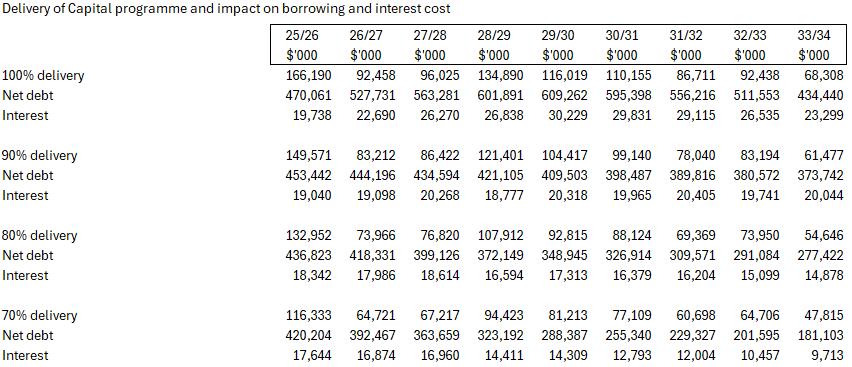
Obligations under Local Government Funding Agency (LGFA) guarantee commitments
That Council will not be called upon to meet its guarantee obligations to the LGFA.
That sufficient internal and external resources will be available to undertake capital works and maintain operational needs in the years outlined in the financial statements.
Low Undertake annual reviews of the Statement of Intent of the company and its credit rating to determine if its business forecasts will potentially trigger one or more of these obligations and decide and report on these matters at the earliest opportunity.
High Provision of human resources staff assistance for each business unit of Council to support addressing capacity and capability issues. Cross organisation approach for
If Council is not adequately resourced both in terms of capacity and capability, then it may contribute to failure and/or significantly increased costs to deliver service levels and key projects.
skills/resources when undertaking change.
‘Inadequate workforce capacity and capability to deliver Council’s objectives’ is a top risk in the achievement of Council’s strategic priorities. This is regularly monitored and reported against by the Executive Team and Audit and Risk Committee. Resource constraints are reported early to Executive Team so allocation decisions can be made.
That the amount and timing of revenue has been calculated in line with average growth over a set period and utilisation projections of services, with the intent to fully recover the costs associated with providing the services.
If average growth rates are significantly less than projected, this could result in higher loan funding costs to fund any shortfall in revenue. A reduction in revenue projections will also impact the debt affordability matrix Council uses.
If growth and revenue are higher than projected additional funds would be available for expenditure in future years, and there would be a consequential increase in the debt affordability matrix Council uses.
That the district’s demographics will trend in accordance with the Te Ngira (University of Waikato), age projections as growth occurs.
High Monitor costs to provide relevant services and revenue to ensure expected costs are met from projected revenue.
Measure and report on movement in other revenue annually as part of the Annual Plan.
‘Risk to Financial Strategy and Affordability’ is a top risk in the achievement of Council’s strategic priorities.
Moderate
Continue to monitor population projections against actual changes confirmed through census data and
Projections show an increasing proportion of our population over the age of 65 over the next 40 years. The age structure of Waipā district is moderately old compared with the rest of the Waikato, and ages relatively quickly. In 2023, 19.3 per cent of the population are aged 65 years and over compared with national average of 16.5 per cent, and this is projected to increase to 29.2 per cent by 2043.
High levels of migration are driving population growth in Waipā and are expected to lead to a more ethnically diverse population in the future.
Longer term, it is expected that the district will see an increasing young Māori population.
housing market demand. In this regard, the urban development capacity monitoring and three-yearly capacity assessments will help keep the Council informed as to changes and trends in housing and business demand. This monitoring information will also enable changes to be made through the Annual Plan and LTP review process.
Review services, work programmes and budgets to reflect significant changes in district demographics.
‘Failure to effectively plan for and manage growth’ is a top risk in the achievement of Council’s strategic priorities.
That along with Waipā’s Future Proof partners, we continue to use the Te Ngira (University of Waikato) population projections. These were last comprehensively reviewed in 2021 based on the 2018 Census. Prof. Michael Cameron of Te Ngira (University of Waikato) revised the Waipā projections in March 2025 to take into account the 2023 Census data and latest population data provided by Statistics NZ.
If future population growth varies significantly from our assumptions, our ability to fund and deliver the agreed work programmes in a timely manner is likely to be seriously affected. Should actual growth be less than forecast, there is a risk of building infrastructure without the ability to
Moderate to high
Monitor growth and the housing market demand and supply.
Where the population or market behaves differently than forecasted, we will review the timing of infrastructure development and the staged rezoning of land and structure plan development as per the
recover costs quickly via development contribution revenue. Should actual growth be higher than expected, there is both a construction inflation risk and a risk that we will struggle to procure resources to meet the demand for infrastructure.
Statistics NZ estimated actual population in Waipā in 2023 to be 61,400. The 2021 Te Ngira (formerly NIDEA) high growth scenario estimated the Waipā population in 2023 at 59,749 (1,651 less than actual).
Even factoring in the current economic slowdown, there remains a backlog of residential growth to be accommodated in Waipā according to Statistics NZ annual population estimates.
The March 2025 Te Ngira projections now estimate a Waipā population of 74,165 in 2034. Graph 17 shows the revised high growth projections, from Prof. Michael Cameron from Te Ngira (University of Waikato).
guidelines of our Waipā 2050 Growth Strategy.
Futureproof has engaged Te Ngira (University of Waikato) to review the comprehensive subregional population projections in late 2025 based on 2023 census data.
Changes will be signalled in future Annual Plan and LTP reviews.
‘Failure to effectively plan for and manage growth’ is a top risk in the achievement of Council’s strategic priorities.
Source: Interim revised high growth projections, Prof. Michael Cameron from Te Ngira (University of Waikato)
Development contributions revenue
Development contributions revenue is based on calculated charges for new Household Equivalent Units (HEUs) within the Development Contributions model.
For residential properties, development contributions are paid by the developers at the time of consent sign off. There are known lags between assessment of development contributions and the payment trigger, and then between that payment trigger and the housing that eventuates.
These lags are demonstrated in the initial years of our modelling (years 1 to 3), which only anticipates development contributions revenue that has already been assessed. In the following years, with most of the infrastructure delivered to enable planned growth, development contribution levels will increase to meet anticipated high population projections.
Moderate in first three years, high in later years
Monitor growth projections and development contributions revenue against actual levels and maintain communications with our development community on when they are looking to proceed with their developments. Where significant changes occur, work programmes; estimations in growth uptake; and budgets will be reviewed and amended accordingly, including the recalculation of development
The amount and timing of development contributions revenue has been calculated so that it is consistent with the development contributions model and assumptions, including economic and population projections.
Development contributions revenue from non-residential development makes up approximately one third of the total projected development contributions revenue.
We believe that due to the scarcity of zoned industrial land in the wider sub -region and with the availability of land within Waipā at strategic transportation nodes, there will be strong uptake of industrial and commercial development activity within the Waipā district. This assumption is well supported by the relevant Future Proof business capacity assessment reports provided by Market Economics.
There is an increased lag with non-residential development given the subdivision is not the main timing of when development contributions are paid. This is due to the diverse nature of activity that can occur within non-residential (e.g. a freight logistic hub will generate more traffic demand than an office block, but both are permitted within the zoning). Therefore, nonresidential is assessed at the time of land use or building consent application and payable at BC certification or activation of land use. Therefore, we believe the majority of our industrial development contributions revenue will occur in the later years of the plan.
contributions rates. Changes will be signalled in future annual plans in line with legislative requirements for consultation.
Amendments to the Development Contributions Policy will enable greater ranges of housing typologies. This aims to incentivise smaller site developments. The development agreement section has also been amended to outline terms on timing and requirements of developers where such timing is breached.
Taking a conservative approach to our budgets due to growing historical lag and the impact that this has on debt levels and financial prudence measures.
‘Failure to effectively plan for and manage growth’ is a top risk that is actively managed at Executive level and through reporting to the Audit & Risk Committee.
Source: Waipā District Council development contributions model
The amount and timing of development contributions revenue is dependent on subdivision and land use activity within the district, which is largely dependent on market factors outside Council’s control. Growth factors are volatile and can vary significantly from our baseline assumptions, thus affecting our ability to fund growth-related work programmes or other programmes if debt escalates.
Note the risk is in the outer years of the Plan for development contribution revenue collection i.e. Y4-9. If the revenue collection is anticipated to be slower than expected due to changing economic conditions in earlier years of the plan then the following options will be available to Council. 1. Reduce capital investment in later years to service debt. 2. Raise development contribution fees. 3. A combination of 1 and 2 are implemented. 4. Alternative funding mechanisms will require introduction.
Development capacity and demand
Capacity provided for within current live zoned growth cells within Waipā is sufficient to meet the expected uptake in development.
Infrastructure, planned or already delivered by Council, enables development to deliver anticipated demand for both residential and non-residential sectors.
For residential we expect developers will deliver supply in alignment with higher population projections and will provide for a wide range of housing typologies within the urban boundaries of Te Awamutu and Cambridge. This will meet Central Government legislative and policy direction associated with housing (where there is a focus on the intensification of existing and planned urban areas that has infrastructure).
With the higher population, we anticipate a large majority will work within the district and that there will be strong demand for non-residential development, particularly industrial activity, within Waipā. This is driven by the limited supply of industrial-zoned land across the wider subregion and the availability of live zoned land for industrial activities within Waipā, located near key transportation nodes.
If there is change in government priorities (e.g. restrictive immigration settings) and/or macro/micro economic impacts (interest rate changes or the creation of significant risks or opportunities), then there is greater uncertainty in the market.
Moderate in first three years, high in later years
Ensuring delivery of infrastructure is undertaken in a ‘just in time’ manner.
Timing infrastructure delivery in tandem or potentially with developers, through Infrastructure Works or development agreements to ensure alignment of costs with revenue.
Set out clear expectations and requirements that any out of sequence development is responsible for all costs associated with unplanned or infrastructure upgrades, internal and external to the development.
Waipā’s economy is reasonably resilient and is projected to continue to grow. Economic activity will however continue to be constrained in the short term. Inflation and interest rates are projected to continue to improve into 2025. High
Review work programmes and budgets annually, or as required due to the changing conditions. If conditions change, then appropriate reductions or increases will be made and signalled in future Annual Plans.
Future economic uncertainty is still a concern that needs to be factored into financial planning (e.g. expectations of Council to fund and respond to climate related matters).
Economic factors vary significantly from the assumptions in this plan which then affects our ability to deliver on the agreed work programmes, either in terms of the scope or timing of the work.
That based on the projected population increase for the next nine years, together with demand for non-residential development, there will be an increase in the district’s rating units, service connections and capital value. A significant part of the capital value increase comes from value uplift from rezonings and subdivision activity, as well as from building development. Collectively these elements result in a significantly increased rating base and shelter existing ratepayers from the full impact of increases in rating requirement. Table 69 shows the projected increase in rating units.
‘Risk to Financial Strategy and Affordability’ is a top risk in the achievement of Council’s strategic priorities.
Moderate in first three years, high in later years
Monitor development projections against actual levels and review the projections on a three-yearly basis. Measure and report on increases in the rating base annually as part of the Annual Plan.
That the cost of future projects included in this plan will be consistent with the Infometrics Cost Escalation Report. Table 70 shows the inflation rates for each activity. The salary assumption for High Monitor cost projections against actuals, with significant differences and associated responses such as
market movement is set each year. It is not part of the inflation rates but has been included in the table as an internal assumption based on history and indications from the market.
* For salary forecasting, Waipa District Council uses a combination of local government and general market salary survey data to determine market movement; provided by Strategic Pay, Council’s remuneration advisor.
Prices increase significantly from those used in preparing the work programmes and associated budgets. Higher costs could result in additional funding being required to maintain the existing levels of service. Higher costs relating to capital expenditure could result in higher debt levels and increased operating costs from interest expenses leading to increases in rates. Should prices decrease from those used to prepare the budgets, then there would be a favourable impact on Council’s operating and capital expenditure budgets and rates.
Council has a higher level of confidence regarding project costs in the short-term but less certainty in the longer term even with the Infometrics projections, due to fluctuations in the economy.
changes in levels of service reflected in budget forecasts and annual plans.
Inflation will increase both the costs and the rates cap of Local Government Cost Index plus two per cent, mitigating the possible breach of the rate cap for operational spend.
‘Risk to Financial Strategy and Affordability’ is a top risk in the achievement of Council’s strategic priorities.
Borrowing and interest rates
That there will be ready access to loan funds at competitive rates. Interest rates will track in line with the projections prepared by our financial advisors. Interest rates for investments will be set at a margin compared to external debt rates. Council will meet its financial commitments and maintain its AA- Fitch credit rating. This will provide Council access to lower interest rates on its borrowing through the Local Government Funding Agency.
Table 71 details the borrowing interest rates used.
Table 71 – Borrowing interest rates – averaged (Source: Bancorp)
High Manage changes in interest rates as set out in our Treasury Management Policy, taking advantage of hedging, fixed rates and swaps.
‘Risk to Financial Strategy and Affordability’ is a top risk in the achievement of Council’s strategic priorities.
Interest rates will increase significantly from the rates used in preparing this plan which would increase costs for Council. This could have an impact on rates increases, future borrowing requirements, and on our ability to deliver the agreed work programmes.
That Council will be successful in meeting water demand objectives to ensure we have sufficient water for all.
Moderate Council has an active water demand management aimed at reducing the amount of water used per household in Cambridge and Te Awamutu from
If the water demand objectives are not achieved, significant investment in capital works would need to commence earlier than planned. This would also result in additional depreciation and loan interest costs as a result of bringing forward this capital work.
250 litres per person per day to 190 litres.
The following section:
Provides a snapshot of the infrastructure assets covered by this Strategy;
Identifies whether Council anticipates that there will be any changes in levels of service;
Summarises the nature of the work programmes; and
Identifies the key focus areas for the delivery of services through that asset.
This category of infrastructure activities includes cemeteries, heritage, libraries, parks, property, public toilets, swimming pools, and waste minimisation and management.
There is a backlog of Community Services and Facilities renewals.
Increase in population – population growth leads to development which has a significant impact on the demand and provision of existing assets and services.
Demographic changes – any change in the demographic makeup of the population, particularly in the relative size of the age groups, can have a significant impact. Each age group will have specific requirements around what they need from the service.
Council direction and goals – the impacts of significant events or decisions that affect the financial position of Council tend to have a direct impact on community services. As it is not necessarily considered core infrastructure such as three waters or roading, community services can often be deprioritised in Annual Plan or LTP budgets.
Cemetery capacity - cemeteries in Hautapu and Te Awamutu will reach capacity within 515 years
Refer to sections 6.4 (backlog of renewals) and 8 (significant infrastructure decisions) for more details on how we are addressing the backlog of renewals.
Population growth is considered when undertaking activity management planning.
Demographic changes are considered when undertaking activity management planning.
Community services and facilities projects that have been delayed as part of the 202534 LTP will be reconsidered in future LTPs.
Maximising the interment capacity of key urban cemeteries through the reorganisation of land usage within the cemeteries.
*Excludes building cost - this is included in the Property building figures.
Asset data confidence
Asset data is a foundation block used to support the planning of asset operations, maintenance, renewals, and new capital investment.
- uncertain
- uncertain
Asset lives
The table below shows the useful lives of major assets. They are reviewed and adjusted if applicable at each financial year end.
The table below summarises the critical assets. Critical assets are those whose failure will have a greater impact upon the activity's ability to provide its services to the intended service levels.
Activity area Critical assets
Cemeteries
Heritage
Libraries
Parks
Property
Small number of assets across the building, fencing, and gates and furniture asset types.
Museum buildings
Software systems
Why
Major or severe Impact of Failure and Duration of level of service loss >1 week.
Essential for housing and displaying the collection and for operating associated services.
Essential for undertaking collection management and protection and providing.
Collection Unable to operate an effective Museum service without access to the collection.
Library buildings and furniture
Library management, service, and security systems
Loan and reference items
Structures including retaining walls, boardwalks, jetties, pedestrian bridges and viewing platforms
BBQs and shade sail poles
Bank St offices
Wilson St offices and Cambridge Library
Te Awamutu Museum
Pool filtration system
Public swimming pools
Pool structure
Pool heating system
Public toilets All public toilet facilities
Any major issues e.g. leak in roof, failure in air conditioning systems would seriously affect the ability to deliver library services.
Any outage for longer than two days would require closure of the libraries
If there was an impact on what could be borrowed or read in the library, then this would have a major impact on the ability to deliver library services.
Major or severe Impact of Failure and Duration of level of service loss >1 week
Buildings that are deemed Emergency Operating Centres. The museum holds national taonga.
This is critical as it is required for the pool to function and meet water quality legislation requirements. If the system fails, the pool will need to be shut down for an extended period of time for repairs or replacement.
Leaks in the pool structure would require the pool to be shut down for an extended period of time for repairs or replacement.
Heating is required to provide a safe and comfortable environment.
Severe Impact of Failure and Duration >1 week
Unlike lifeline services such as roads and three waters, Community Services and Facilities assets (except those identified welfare facilities needed in an emergency) are not as critical. There is, therefore, a reduced urgency to reinstate services following a significant event as compared to lifeline services. They do however provide a sense of ‘normality’ and well-being for the community meaning services do need to be restored. At this time, most Community Services and Facilities assets have not been assessed for resilience.
Assessment of the condition of these assets is achieved through a combination of staff and consultant inspections. Frequency of inspection depends upon asset type and criticality.
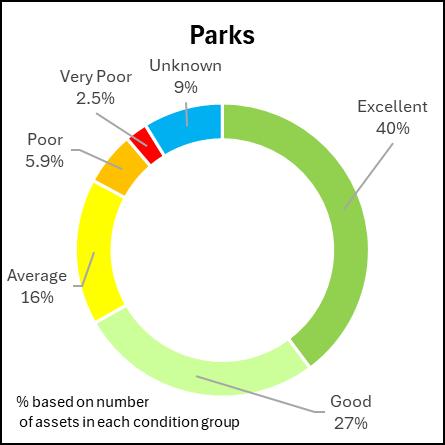

Note – this excludes trees
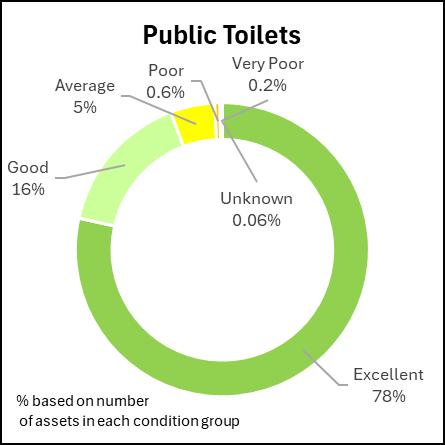

Note – this excludes museum buildings
Nine per cent of park assets and 0.06 per cent of public toilet assets do not have a recorded asset condition and associated facilities assets do not have a recorded condition. This is not deemed
significant. Assets without a recorded condition will be condition assessed prior to any renewal work to confirm that renewal is required and where frequent issues indicate condition may have deteriorated. While unassessed assets do pose an increased risk of unexpected asset failures, the unassessed assets will typically be of lower criticality, meaning the impact of failure is lower.
Public toilets - performance of public toilets has not recently been assessed and the reliability of the available data is uncertain. There are known performance issues at the lakeside reserves public toilets. There are plans to review the assessment methodology and undertake new performance assessments.
Libraries – there is no formal assessment of asset performance within the library activity. However, the following performance issues have been identified by staff:
Cambridge library building – inadequate size, aged appearance, layout not optimal for modern library service needs.
Te Awamutu library building - inadequate storage space, layout not optimal for operational health and safety.
Heritage - the performance of heritage assets is not currently assessed, and no formal process exists.
Parks and cemeteries – performance was last assessed in 2019 when an external agency was engaged to assess performance through determining the purpose of the asset and how well it meets this purpose. Results suggested that majority of assets have no performance issues. However, there are concerns over the process used and the accuracy of the resulting data outputs. Work is in progress around the development of more appropriate methodology for capturing performance is developed and reassessment of the assets.
Property - there has previously been an inconsistent approach to assessing property asset performance largely due to the lack of data to support the assessment. That has now been improved with properties now surveyed against defined performance measures, not all properties have yet been assessed under the new regime. Key performance issues include:
Council offices - 101 Bank Street requires significant upgrades to ensure that the space is more functional to meet the requirements of a modern workplace.
Cambridge Library - significant space constraints which impacts on ability to adequately provide the service.
The Community Services and Facilities demand forecasts for this Strategy and the underpinning AMP have been developed by applying population change, changing customer needs, and environmental factors to current and historic demand levels. The reliability of the forecasts is heavily dependent upon the quality of current and historic demand data. This varies from high reliability for discrete services such as cemetery burials and swimming pool visitation to low reliability for broader services such as park usage.
The forecast level of service expenditure does not include any changes in the first nine years of the Strategy. However, investments in a new Cambridge Library and Te Ara Wai will be reconsidered as part of the 2027-37 LTP.
Looking at the later years of the Strategy, service level increases could occur with the proposed purchasing of new reserves and development of existing reserves. This could include the delivery of new standards deemed more appropriate for the changing demographics, intensification of housing in urban areas, and needs of the community.
Capital expenditure
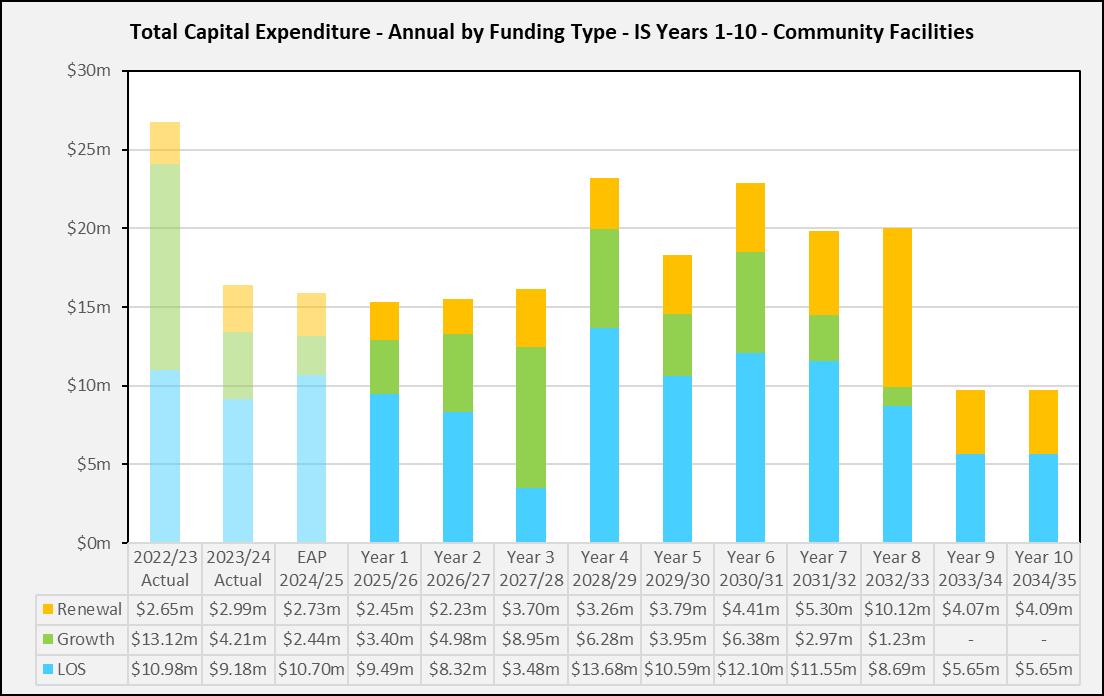

Operational expenditure
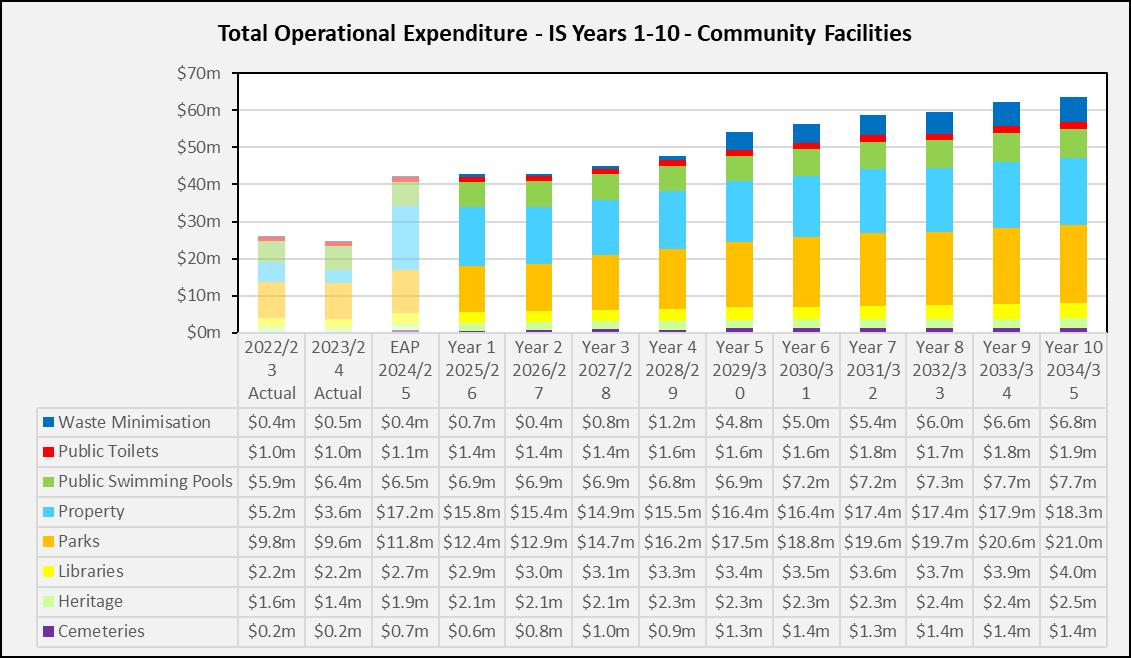

This category of infrastructure includes:
Roads and structures;
Signs and traffic facilities;
Amenities/ parking;
Street lighting;
Footpaths and cycleways;
Passenger transport;
Rural drainage;
Activity management professional services.
The two bridges linking Cambridge and Leamington will become too congested by 2041.
There is a backlog of renewals for transportation.
The radial pattern of existing streets in Te Awamutu brings all heavy traffic through residential streets and the CBD creating negative amenity impacts.
The Cambridge Connections project will seek to find a long term solution to this.
Refer to sections 6.4 (backlog of renewals) and 8 (significant infrastructure decisions) for more details on how we are addressing the backlog of renewals.
Council has reviewed the case for a western arterial road and decided to uplift part of the designation for a ring road to the west of Te Awamutu. This is on the basis that the new road would be unaffordable to build and not deliver adequate benefits.
Alternative strategic transport improvements for Te Awamutu have been identified instead and these will be pursued in future LTPs. Parts of a western road may still be delivered in future, but they would need to be aligned with urban housing growth.
Increasing traffic volumes on SH3 and SH39 create community separation and environmental impacts in Te Awamutu, Kihikihi, Ōhaupō and Pirongia.
Growth and business development is putting more pressure on car parking in the main town centres, the corresponding increase in use of parking time limits and enforcement is exceeding resourcing capacity.
Council will continue to work with NZTA Waka Kotahi to plan for improvements that will reduce this impact.
Council will be developing a parking strategy along with continuing to enforce parking time limits.
The table below shows the useful lives of major assets, those useful lives are reviewed and adjusted if applicable at each financial year end.
Activity Area
Transportation
Formation/carriageway and shoulder Infinite Pavement structure 12 – 150
Pavement surface (seal) 6 - 65 Catchpits and culverts
- 75
75
– 35
– 35
Bridges (including State Highway bridges)
Damage to a bridge requires full closure until the bridge is certified by a structural engineer to be safe to reopen, therefore any damage will result in significant disruption to the network.
Urban and rural arterial roads
Lifeline routes
resilience
These roads provide high capacity and connectivity across our district and to the highway network. They are the principal routes used by freight and passenger transport.
Lifeline routes provide the corridor for access to all critical services that may be needed in an emergency, or to restore lifeline service. These include electricity, phone and internet, gas and three waters.
Asset resilience is managed through our contractors’ emergency management plan for responding to accidents and emergency events, our own internal business continuity plan, and our maintenance and renewals programmes to ensure the road network is as resilient as practicable to weather events. Waipā’s network is reasonably robust therefore most major weather events result in little damage.
For almost all district properties, there is a secondary route should a bridge on the primary route become compromised or road are closed due to washouts and slips from intense rainfall events.
The expected longer periods of hotter temperatures due to climate change will raise the risk of bitumen surface instability leading to flushing or bleeding of chip seals resulting in negative road
safety impacts from slippery surfaces. Similarly, increased peat soil shrinkage will lead to more cracking and settlement of roads. In both cases, increased maintenance and lower service levels are more likely than full service failure.
Through Council’s RATA membership, most condition data for Council’s transportation assets is collected under various RATA data collection contracts or in future the Consistent Condition Data Collection project run by NZTA. The frequency of inspection depends upon asset type and criticality.
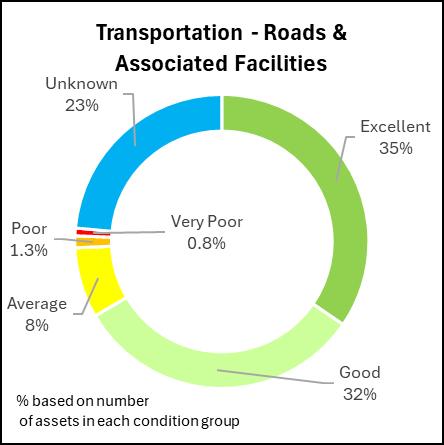
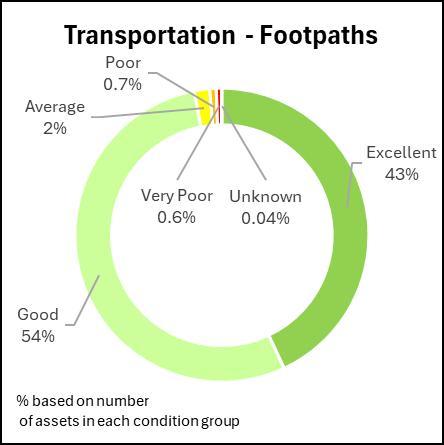
23 per cent of road and associated facilities assets do not have a recorded condition. The vast majority of those assets are formation, land, subbase, and surface water channels (SWC). Only SWC would be considered important to have condition data for. Where SWC condition data is missing, the condition will be assessed prior to any work on the related road to determine whether SWC renewal work is required.
For footpaths, just 0.04 per cent of assets do not have a recorded condition. This is not deemed significant, and the three yearly condition assessment of footpaths should help address that gap. While unassessed assets do pose an increased risk of unexpected asset failure, the unassessed assets will typically be of lower criticality meaning the impact of failure is lower.
Transportation performance is gauged through hard quantitative measurements and subjective qualitative measures. Quantitative measurements include congestion, network availability, passenger transport trips, safety as measured by crashes or crash risk, efficiency as measured by cost to maintain, and amenity issues such as how comfortable the service is. Subjective qualitative measures include Council’s quarterly resident surveys and annual RATA customer surveys.
Quantitative measurements indicate that Waipā roads offer a smoother ride than our peer groups and the national average. However, pavement and surface condition has indicated a decline in condition, dropping to below the peer group average. Addressing our backlog of reseals and
pavement rehabilitation should see these condition indicators improve back toward the national average.
The annual RATA customer surveys show that respondents’ satisfaction has declined. This decline has been seen across all Waikato councils included in the survey. The biggest decline was in the area of road condition and roadside drains which reflects the very wet 2023 year with potholing and flooding occurring through cyclones and a much higher annual rainfall than normal.
The Transportation demand forecasts used for this Infrastructure Strategy and the underpinning AMP are based on the Waikato Regional Traffic Model. This has recently been updated to reflect the 2023 Census data, Future Proof 2050 growth projections and major network changes like completion of the Waikato Expressway. Overall, the certainty of traffic quantum is reasonably high. However, the effects of growth cell developing timing and external factors such as Central Government policy and economic pressures mean timings should be taken as indicative.
The forecast level of service expenditure does not include any changes to levels of service in the first nine years of the plan. Funding included over this period is to ensure we are meeting current levels of service.
In the later years of the plan, the following level of service increases have been forecast:
The development of part of the Te Awamutu western ring road or an internal road reconfiguration to divert some traffic from Sloane, Bank and Alexandra Streets;
The continued development of urban mobility networks-paths and cycle paths;
Implementation of a programme of demand management, travel mode change, and infrastructure improvements to address transportation challenges in Cambridge.


Operational expenditure


This category of infrastructure includes:
Stormwater collection and reticulation;
Retention, treatment, and discharge of stormwater.
Stormwater schemes
Urban stormwater networks
Cambridge;
Te Awamutu;
Karāpiro;
Kihikihi;
Ōhaupō and Pirongia.
Rural drainage
222km of rural drains, which were vested to Council from the drainage boards.
Current and future issues
There is a backlog of stormwater renewals. Refer to sections 6.4 (backlog of renewals) and 8 (significant infrastructure decisions) for more details on how we are addressing the backlog of renewals.
Environmental effects – older subcatchments in the district do not have specific devices for the management of stormwater quality.
New urban stormwater discharge consent –this will require greater investment in upgrades and maintenance of assets to improve the quality of discharged stormwater and to ensure assets are operating and maintained correctly.
Asset summary
Catchment management plans developed in 2022 outline how Council will improve stormwater quality in the future.
As these impacts are not yet fully understood, no provision for this investment has yet been included in this strategy beyond what is required to cater for growth areas where individual consents provide clear guidance on what is needed.
Silt traps Qty 15
Soak holes Qty 177
Soakage trenches Qty 470
Asset data confidence
Asset data is a foundation block used to support the planning of asset operations, maintenance, renewals and new capital investment.
Activity Data Confidence Grade
Stormwater B+ - reliable
Asset lives
The table below shows the useful lives of major assets; those useful lives are reviewed and adjusted if applicable at each financial year end.
Activity Area Components Years
Stormwater
Critical assets
Structures
15 – 150 Pipes
50 – 135 Manholes
50 – 80
The table below summarises the critical assets within each activity area. Critical assets are those who’s failure will have a greater impact upon the activity's ability to provide its services to the intended service levels.
Pipes and associated manholes assessed as high or very high criticality - 1.2 per cent of network length
Stormwater
Asset resilience
Treatment ponds
Criticality determined by assessing impacts of failure against health and safety, business continuity, compliance and regulatory, environmental, financial, reputation/image, and resourcing.
These assets are required to protect our streams and the Waikato River from the effects of pollution from urbanisation.
Asset resilience in this activity is managed through the proactive inspection and maintenance as required of stormwater assets, e.g. pipe CCTV and cleaning and the cleaning of road catchpits during autumn.
Climate change driven increases in the frequency and intensity of heavy rainfall events will increase the risk of surface flooding and reduced treatment quality as the network and treatment devices capacities are exceeded. In most cases the network assets are not expected to be significantly damaged, with the overflow flowing via secondary flow paths.
There is currently little understanding of the seismic resilience of critical stormwater assets and there is currently no work planned to address this shortfall.
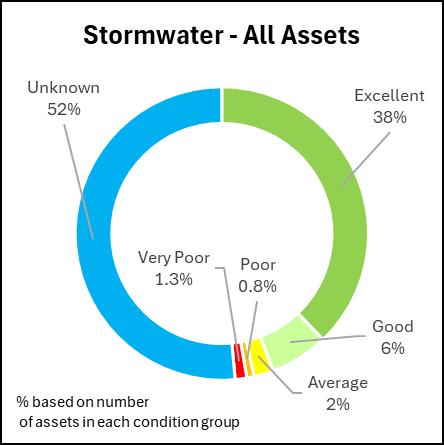
52 per cent of stormwater assets do not have a recorded condition. The majority of that is made up of connections, manholes, and pipes. It is not feasible from either a financial or practicality viewpoint to assess all assets across the network.
Where no condition is recorded, an assumption is made for the condition based on the age of the asset and the condition of similar assets that have been physically checked. Assets without a recorded condition will be condition assessed prior to any renewal work to confirm that renewal is required and where frequent issues indicate condition may have deteriorated. While unassessed assets do pose an increased risk of unexpected asset failures, the unassessed assets will typically be of lower criticality meaning the impact of failure is lower.
Current performance data is only held for stormwater pipes with this performance being derived from the CCTV condition inspections. There is ongoing discussion around what information is needed to determine performance grades such as a capacity and a velocity etc.
At a holistic network level, Council’s modelling assessments have identified that approximately 17 per cent of the Cambridge and 14 per cent of the Te Awamutu network does not have capacity to service a one in two year event. Additionally, the Catchment Management Plans and further analysis undertaken to identify environmental effects from urban stormwater discharge have identified devices and structures that will need significant investment to raise their performance to the required levels.
Stormwater demand is an evolving issue as Council is waiting for a new urban stormwater discharge consent to be agreed to with Waikato Regional Council. The new consent is likely to require additional flow management from higher risk sub - catchments plus the adoption of the National Policy Statement on Urban Development - through Council’s Plan Change 26, which allows for greater housing density - may place additional demand on Council’s conveyance, treatment, and discharge assets.
Forecast expenditure does not include any changes to levels of service in the first nine years of the plan. Funding over this period is to ensure we are meeting current levels of service including consent requirements.
Looking at the later years of the strategy, the forecasts are based on continuing to ensure we are meeting current levels of service and are compliant with any changes in consent requirements.
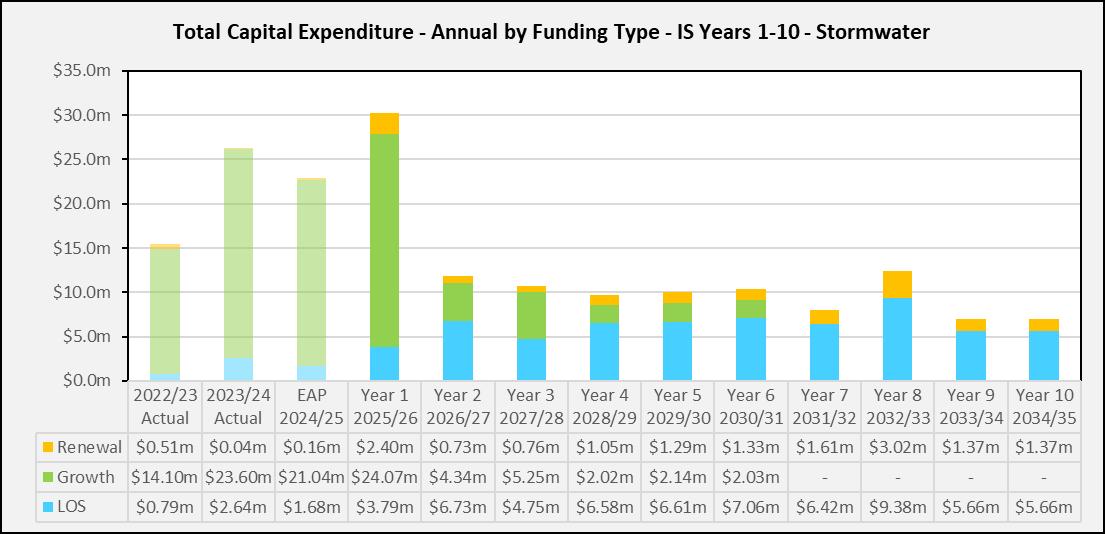
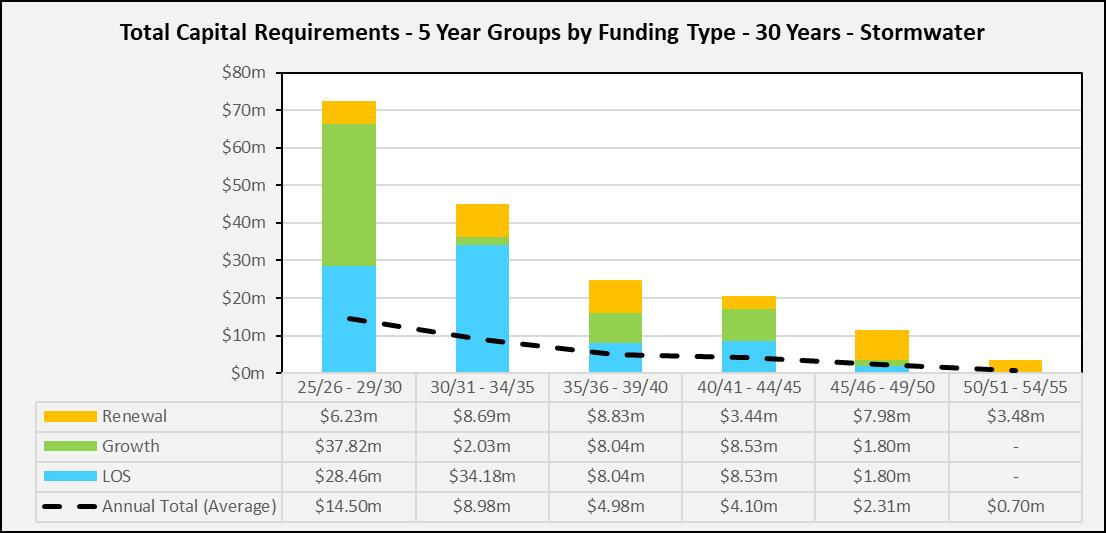
Operational expenditure

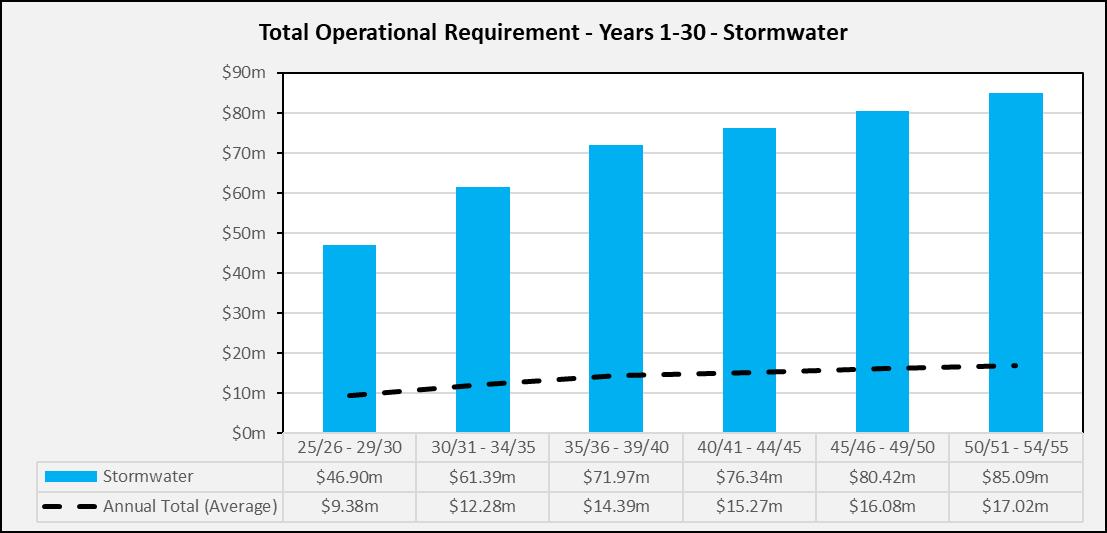
What we provide
This category of infrastructure includes:
Wastewater collection and reticulation;
Treatment of wastewater;
Discharge of treated water to environment.
Wastewater schemes
Cambridge and Karāpiro
Treatment: Cambridge Wastewater Treatment Plant;
Significant level of trade waste (>20 percent by flow).
Te Awamutu and Kihikihi
Treatment: Te Awamutu Wastewater Treatment Plant;
Current trade waste levels will increase significantly with the inclusion of Waikeria Prison flows.
Current and future issues
There is a backlog of renewals for wastewater.
Ability to provide for currently unserviced areas such as the new industrial area near the airport presently serviced by tanker and the existing Ōhaupō and Pirongia townships presently self-serviced with on lot private devices.
Approach
Refer to sections 6.4 (backlog of renewals) and 8 (significant infrastructure decisions) for more details on how we are addressing the backlog of renewals.
These projects are being planned for the later years of this strategy.
Asset data confidence
Asset data is a foundation block used to support the planning of asset operations, maintenance, renewals and new capital investment.
Wastewater B+ - reliable
Asset lives
The table below shows the useful lives of major assets, those useful lives are reviewed and adjusted if applicable at each financial year end.
Critical assets
The table below summarises the critical assets within each activity area. Critical assets are those whose failure will have a greater impact upon the activity's ability to provide its services to the intended service levels.
Pipes and associated manholes assessed as high or very high criticality – 24 per cent of network length
Key connections
Wastewater
Pump stations
Treatment plants
Criticality determined by assessing impacts of failure against health and safety, business continuity, compliance and regulatory, environmental, financial, reputation/image, and resourcing.
These provide a service to our key customers who provide a district wide service i.e. hospital, schools.
These are considered to be critical as they are located in the low point of our network and therefore are at a high risk of wastewater spills and odour.
The wastewater treatment plants as a whole are considered to be critical as it is our main form of treatment.
Asset resilience is managed through:
Portable generator availability for the minimum operation of pump stations and treatment plants;
Circa nine hours storage in pump station wet wells to allow for short term outage and repairs.
New treatment plant designs will include consideration of seismic resilience.
49 per cent of wastewater reticulation assets and 0.3 per cent of treatment plant assets do not have a recorded condition. The majority of that is made up of connections, manholes and pipes. This split reflects the difficulty in assessing underground assets. It is not feasible from either a financial or practicality viewpoint to assess all assets across the network.
Where no condition is recorded, an assumption is made for the condition based on the age of the asset and the condition of similar assets that have been physically checked.
Assets without a recorded condition will be condition assessed prior to any renewal work to confirm that renewal is required and where frequent issues indicate condition may have deteriorated. While unassessed assets do pose an increased risk of unexpected asset failures, the unassessed assets will typically be of lower criticality meaning the impact of failure is lower.
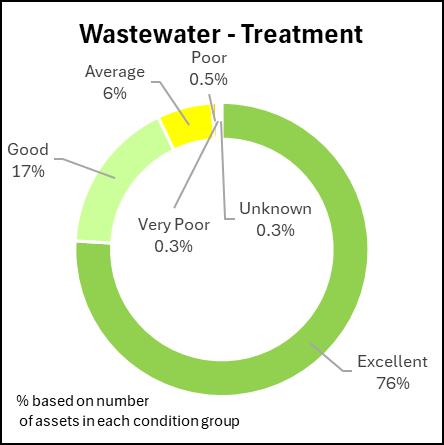
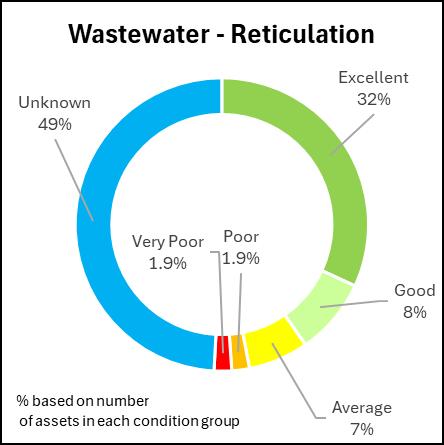
Current performance data is only held for wastewater pipes with the performance being derived from CCTV condition inspections. There is ongoing discussion around what information is needed to determine performance grades, such as a capacity and a velocity, etc. At a holistic network level, the hydraulic modelling of the network is indicating that the network is performing as required.
The wastewater demand forecasts used for this Infrastructure Strategy and the underpinning AMP are from the 2020 Three Waters Masterplan analysis which in turn was based on the Waipā 2050 Growth Strategy from 2019.
Significant development proposed urban intensification and changes to growth cell development timing has occurred since then with a Council direction to increase from the Te Ngira medium (basis of Waipā 2050) to high growth scenario. Consequently, while the overall quantum and location of the demand forecasts remain reliable, the forecast timings should now be seen as
indicative only. It is proposed that the Three Waters Masterplan will be refreshed circa 2026 incorporating latest Census data and population forecasts at that time.
The forecast level of service expenditure does not include any changes to levels of service in the first nine years of the plan. Looking at the later years of the strategy, the forecasts are based on continuing to ensure we are meeting current levels of service and are compliant with any changes in consent requirements. Also included is a high-level indicative cost for the potential wastewater reticulation of Pirongia, Ōhaupō and the present airport industrial precincts as identified in Ahu Ake.
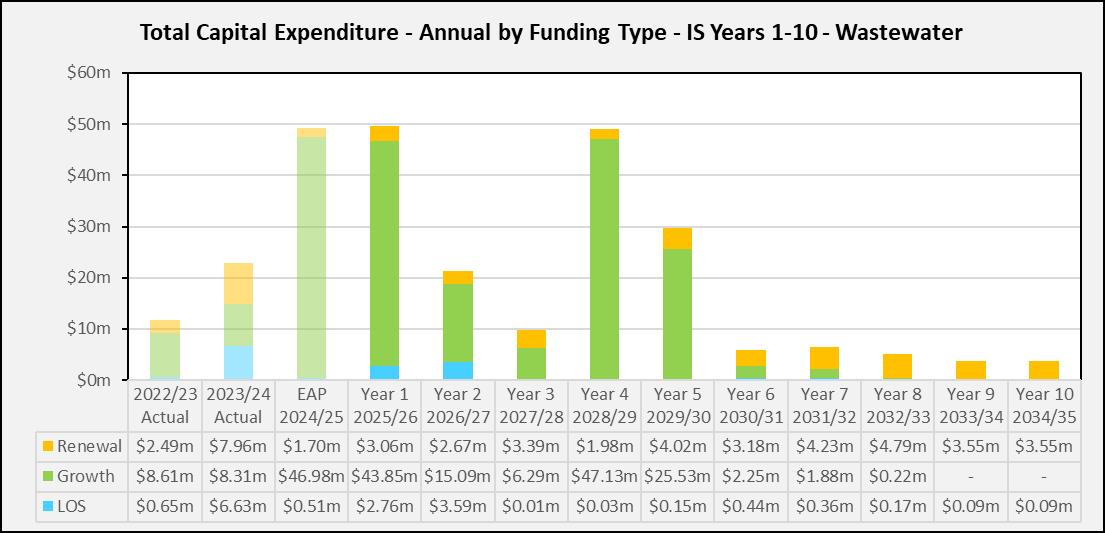

Operational expenditure
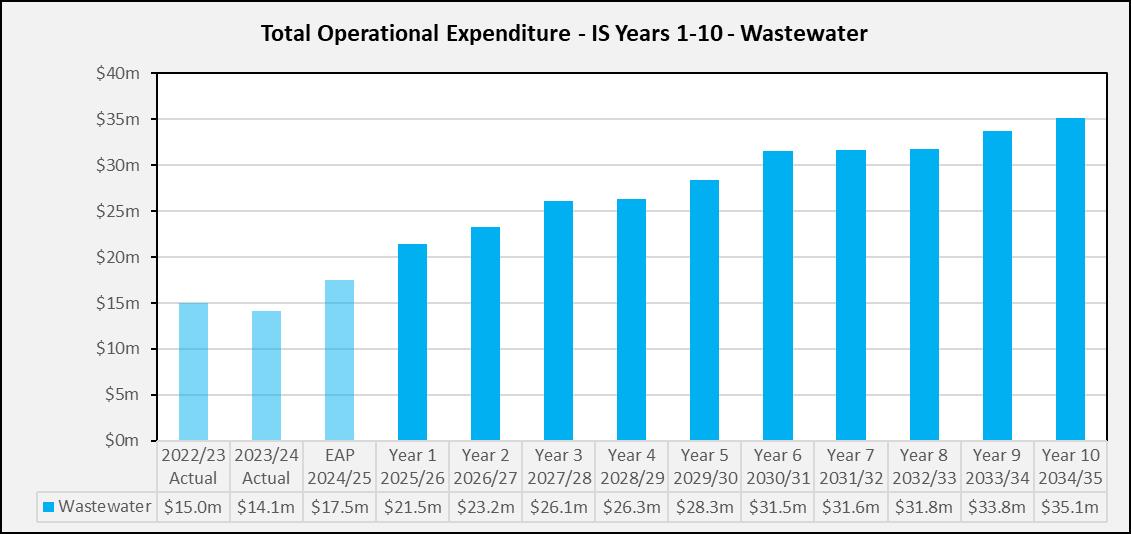
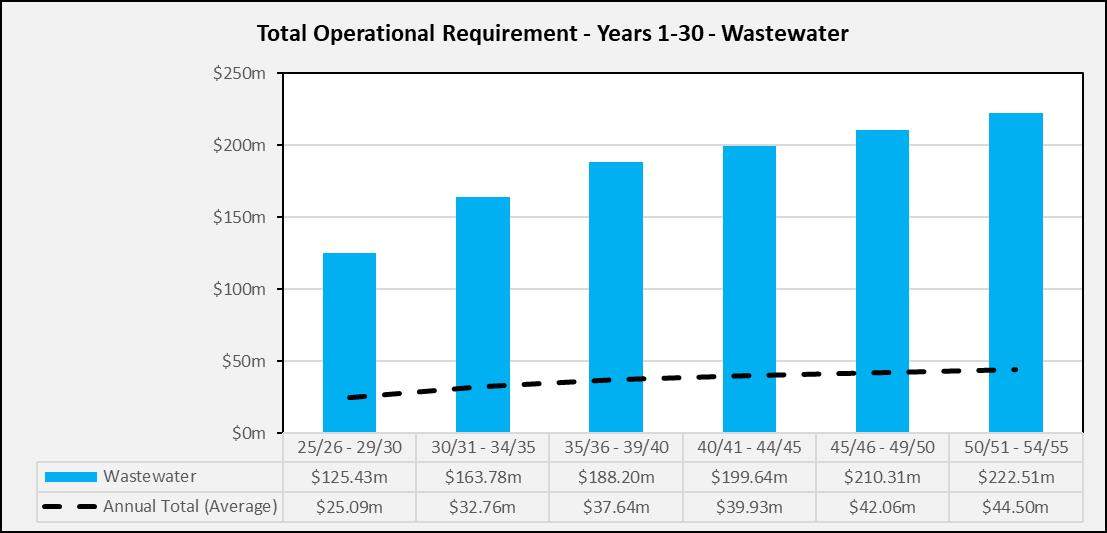
What we provide
This category of infrastructure includes:
• Source water abstraction;
• Treatment of water;
• Reticulation and supply of treated water.
Water schemes
Cambridge
• Three main networks; Karāpiro Village, Cambridge North and Cambridge South;
• Water is supplied on an unrestricted basis to the urban residential areas of Cambridge and Karāpiro Village;
• Sourced from: Lake Karāpiro and Waikato River;
• Treatment: Karāpiro Water Treatment Plant (WTP) and Alpha Street WTP.
Te Awamutu and Pirongia
• Two reticulation zones; Te Awamutu and Pirongia;
• Sourced from: Mangauika Stream and Frontier Road Bore;
• Treatment: Te Tahi WTP and Frontier Road WTP.
Kihikihi
• Consists only of the Kihikihi township sourced from: Hall Street and Church Street bores;
• Treatment: Rolleston Street WTP.
Pukerimu
• Services the Ōhaupō township and the Pukerimu rural area;
• Unrestricted to Ōhaupō;
• Restricted basis to rural properties, boundary of Mystery Creek Events Centre, and Hamilton Airport;
• Sourced from: Waikato River;
• Treatment: Parallel Road WTP.
Current and future issues
Issues Approach
Storage - Insufficient future capacity is forecast as a result of significant residential growth in Cambridge and Te Awamutu with industrial growth at the airport and Hautapu.
Treatment capacity - further water source and associated treatment capacity is required district wide to service growth over the next 30 years with associated network
New or upgraded network to service growth will be provided for in future LTPs.
See section 8 (Significant infrastructure decisions) for more details on how we are dealing with this issue.
reconfiguration depending on where the new source is located.
Some areas of Cambridge and Te Awamutu currently suffer from low pressure which could be exacerbated with future population growth.
Asset summary
The upgrade of the Alpha Water Treatment Plant plus Hautapu reservoir pump station should improve this.
Asset data confidence
Asset data is a foundation block used to support the planning of asset operations, maintenance, renewals and new capital investment.
Activity
Data Confidence Grade Water Treatment and Supply B+ - reliable
Asset lives
The table below shows the useful lives of major assets, those useful lives are reviewed and adjusted if applicable at each financial year end.
The table below summarises the critical assets within each activity area. Critical assets are those who’s failure will have a greater impact upon the activity's ability to provide its services to the intended service levels.
Treatment plants
Reservoirs
The treatment plants are highly critical as a failure of treatment processes may impact on our ability to supply water and could result in an outbreak of disease.
Current storage volumes meet the requirements for drinking water standards, if a reservoir was to fail, we would be unable to meet these standards and as a consequence, we may have a contamination event or run out of water.
Pumps
Trunk mains and valves
Pipes and valves
Fire hydrants
The majority of our reservoirs rely on pumps to distribute water into the reticulation, without these pumps disruption to supply or reduction in pressure would be felt by all customers serviced by the reservoir.
Our trunk/bulk and ring main feeds reservoirs and the network, if these were to fail interruptions to supply or reduction in pressure would be felt by all customers within the district.
Pipes that provide water to our significant customers such as the hospital and high use commercial customers are considered to be critical.
Our fire hydrants must be operational at all times to ensure that they are available for firefighting.
Asset resilience is managed through reservoir storage and where possible cross connection of supply schemes. The Te Awamutu water supply is now connected to the Pukerimu water supply. There is also potential for the Pukerimu water supply to be connected to service Cambridge in the future. Additional storage of treated water is also proposed.
The new Parallel Road and Karāpiro treatment plant extensions have both been seismically qualified. An earthquake resilience study of the existing reservoirs has found that seismic strengthening (or renewal) is required. No earthquake resilience studies have been completed on our other existing treatment plant buildings and structures. Seismic resilience will be increased as all future water treatment and reservoir renewals/upgrades will be being seismically qualified.
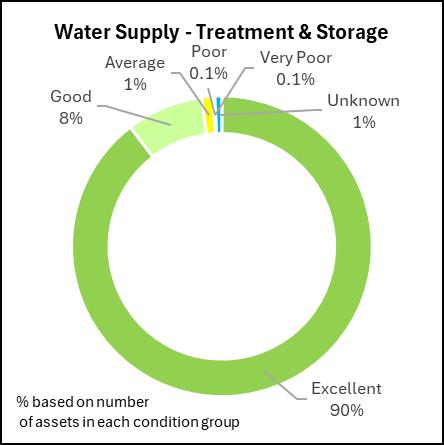

Sixty-two percent of water supply reticulation assets and one percent of treatment plant assets do not have a recorded condition. The majority of that is made up of water meters and connections. Pipes and valves also have a high proportion of their asset classes with no recorded asset condition. This split reflects the difficulty in assessing underground assets. It is not feasible from either a financial or practicality viewpoint to assess all assets across the network.
Where no condition is recorded, an assumption is made for the condition based on the age of the asset and the condition of similar assets that have been physically checked. Assets without a recorded condition will be condition assessed prior to any renewal work to confirm that renewal is required and where frequent issues indicate condition may have deteriorated. While unassessed assets do pose an increased risk of unexpected asset failures, the unassessed assets will typically be of lower criticality meaning the impact of failure is lower.
We measure the performance of our network assets by:
• the ability to provide pressure and flow suitable for firefighting;
• pressure and flow at point of supply to the customer.
We have also developed network models to assess performance issues, and the results are factored into renewal programmes.
Performance of our treatment plants is considered to be consistently meeting requirements.
With regard to reticulation, the following network performance shortfalls were identified in the Three Waters Masterplan:
• Growth cells require significant upgrades to reticulation, reservoirs, and treatment plants to service;
• Fire code compliance requires pipe upgrades (projects in design / construction at present).
Projects are either in progress or are planned to address them.
The water supply demand forecasts used for this Infrastructure Strategy and the underpinning AMP are from the 2020 Three Waters Masterplan analysis which in turn was based on the Waipā 2050 Growth Strategy from 2017
Significant development, proposed urban intensification and changes to growth cell development timing has occurred since then, with Council direction to increase from the Te Ngira medium growth scenario (the basis of Waipā 2050) to the high growth scenario. Consequently, while the overall quantum and location of the demand forecasts remain reliable, the forecast timings should now be seen as indicative only.
It is also proposed the Three Waters Masterplan will be refreshed circa 2026 incorporating latest Census data and population forecasts at that time.
The forecast level of service expenditure does not include any changes to levels of service in the first nine years of the Plan. Looking at the later years of the Infrastructure Strategy, the forecasts are based on continuing to ensure we are meeting current levels of service and are compliant with any changes in consent and regulatory requirements.

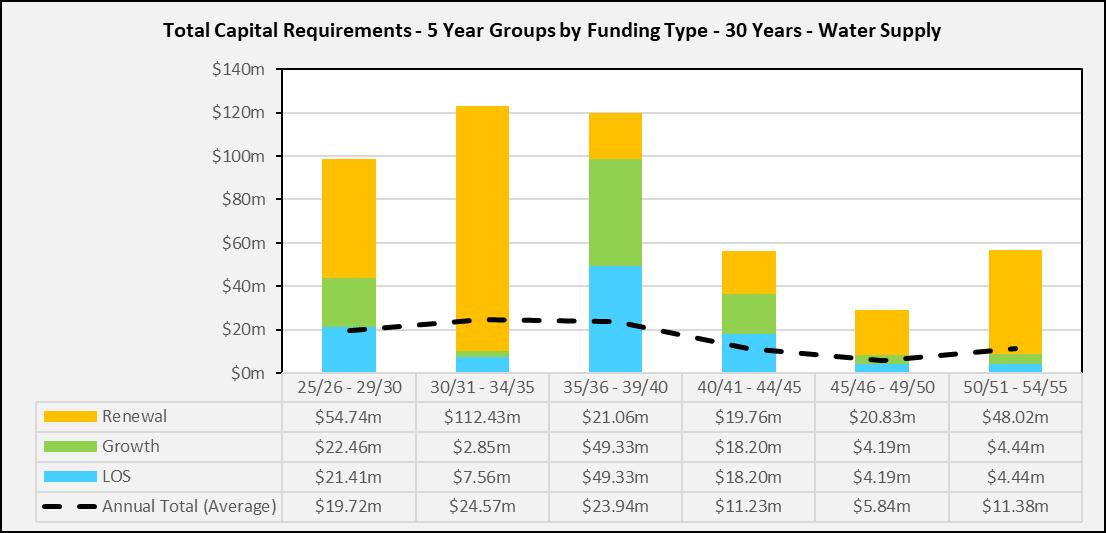
Operational expenditure


APPENDIX 1 – Cambridge and Te Awamutu Growth Cells Information
Cambridge Residential and Industrial Growth Cells

Residential Growth
Cambridge residential growth cells – anticipated 2017 to 2035 (Refer to Cambridge growth cell map above)
Cambridge North Collector roads and roading improvements already in place for the remaining development to connect in alignment with when developers wish to.
No additional costs specific to this cell are expected.
Council funded wastewater pumpstations, stormwater reserves and water supply internal and external to the cell already in place for the remaining development to connect in alignment with developers timing. Estimated $1.5 million in additional expenditure expected to deliver these components of infrastructure.
Future development will require access to the Norfolk Drive intersection upgrading the current set of lights to a four-way intersection. An internal collector road
Two wastewater pumpstations are identified to service the cell through master planning exercises, with one already in place for the initial development.
Playgrounds funded by Council mostly in place. Only one more reserve required to be developed $600k in estimated costs.
87ha This growth cell is zoned for residential development in the Waipā District Plan and is actively being developed. Approximately two hectares have been set aside for a neighbourhood commercial centre.
Most of this growth cell is developed with only a portion of vacant land remaining. The growth cell has a remaining dwelling capacity of approximately 1,044 dwellings.
Structure plan indicated two recreation reserves being required internal to the cell which Council will work with the developers in delivering.
$6.2 million in additional expenditure expected to
46ha
This is a residential growth cell with the potential for a commercial neighbourhood centre. Development shall be undertaken in accordance with the relevant Structure Plan
Growth Cell Transportation Three Waters Community facilities and reserves Land Area Overview and Capacity
network with provisions for walking and cycling and urbanisation align Victoria Road will also be required as the cell develops.
Detailed master plans have been developed to meet developer expectations and ensure delivery is in alignment with their timing.
$16.3 million expected in addition to the initial $8.8 million to deliver the necessary Council infrastructure to service the cell.
C2 and C3 Growth cells include internal collector
Stormwater swale and basin in alignment with the C1 – 3 Catchment Management Plan are quired to enable development without impacting downstream water ways. Design and consent is obtained and land is in negotiation with relevant owners. Timing of the SW assets will be worked through with the developer.
External to site water supply network has been modelled and upgraded to allow connection to the cell. Internal pipe network will include a principle main delivered by Council.
$15.3 million in addition in addition to the initial $10 million expenditure expected to deliver the required infrastructure.
Main central collector pumpstation is
deliver this component of infrastructure. contained within the District Plan.
Only a small portion of the cell has been developed, which connects to Abergeldie Way. The growth cell has a dwelling capacity of approximately 528 dwellings.
Destination playground and active reserves are 284ha This combined growth cell has been identified as the
Growth Cell Transportation Three Waters Community facilities and reserves Land Area
roads with cycleway and pedestrian facilities throughout the cells which will be developed in alignment with developer timing. Urbanisation of existing roading networks such as Cambridge Road are already under construction including intersection upgrades including a central roundabout with pedestrian underpasses.
$14.5 million in additional expenditure to the initial $56.8 million is expected to deliver this component of infrastructure.
constructed which will take cells full development
flows. Additional collector pumpstations are identified through the master planning process and will be worked through as an when developers apply. Downstream upgrades are already in place.
Main outfall for the C1 – 3 catchment is almost complete along with connecting piped infrastructure to the upstream swales which are being developed in tandem with developer timing. External water upgrades have already been completed, internal trunk main and principal mains are coordinated where required with the developers.
$12.7 million in additional expenditure to the initial
central components to the cells and are already developed or acquired ready for development when necessary. Additional reserves still to be purchased and developed in alignment with developers to progress.
Primary school has been designated with the C2 growth cell.
$413.4 million in additional expenditure to the initial $18.2 million expected to deliver this component of infrastructure.
Overview and Capacity
major new growth cell for residential growth on the northern side of the Waikato River. C2 includes potential for a neighbourhood centre. Development shall be undertaken in accordance with the relevant Structure Plan contained within the District Plan. Both cells have seen active development occur within them, with large scale subdivisions delivering Council infrastructure in tandem to enable future wider development to occur.
The growth cell has a dwelling capacity of approximately 3,400 dwellings.
C4 Growth cells include internal collector roads in the northern portion of the growth cell as defined in the structure plan. Kaipaki/Cambridge/ Silverwood Lane Roundabout is required in alignment with the District Plan with a trigger of 300 lots developed prior to the completed upgrade (which have developed initial designs entering into detailed design and build).
$17.5 million in additional expenditure to the initial $900k is expected to deliver this component of infrastructure.
$69 million expected to deliver this component of infrastructure.
Central collector wastewater pumpstation is already constructed with a second pumpstation in the south of the cell still potentially required.
Most stormwater infrastructure is delivered by the landowners with only minor gully improvements funded by Council.
Water upgrades external to the site have already occurred with only some additional costs required for the realignment of Lamb Street existing services.
$3 million in additional expenditure to the initial $2.3 million is expected to deliver this component of infrastructure.
Reserve development within the northern portion of the cell is already constructed.
Additional reserves to the south are also specified within the structure plan which Council will look to development in alignment with developers.
$4.5 million in additional expenditure to the initial $800k is expected to deliver this component of infrastructure.
66ha This growth cell is intended for residential development for development on the Leamington side of Cambridge. Development shall be undertaken in accordance with the relevant Structure Plan contained within the District Plan. Initial development has occurred in the northern half of the growth cell. Central development is looking to develop in alignment with Council’s realignment of Lamb Street as required for the Kaipaki/Cambridge/ Silverwood Lane roundabout.
The growth cell has a dwelling capacity of approximately 790 dwellings.
C6 Lamb Street intersection upgrade required and reliant on wider subsidy funding. In design phaseworking towards a solution as and when required.
$2.7 million in additional expenditure to the initial $280k is expected to deliver this component of infrastructure.
Wastewater not applicable. Stormwater is the developer’s responsibility.
Large lot residential with direct water connection. Receiving water infrastructure already in place.
Cultural reserve in place within the development.
No Council cost and given large lot residential nature of development, not anticipated to be necessary.
53ha This growth cell is zoned for large lot residential development, has a Structure Plan in place and is actively being developed. Portion of this cell is already developed.
The growth cell has a dwelling capacity of approximately 160 dwellings.
The above growth cells make provision for 536 hectares of residential land with a dwelling capacity of more than 5,900 dwellings. Estimated costs include both level of service and renewal shares if the totals and cost estimated may also be linked to other growth cells if they both share a demand generation.

Residential Growth
Te Awamutu residential growth cells – anticipated 2017 to 2035 (Refer to Te Awamutu growth cell map above)
T1 Frontier Road to Pakura Street urbanisation was required to provide better connectivity for T1 and T2 growth cells.
$3 million in additional expenditure to the initial $1.1 million is expected to deliver this component of infrastructure.
No cost to Council for stormwater.
Wastewater downstream upgrades were required to provide capacity for T1 and T2 growth cell which are now in place.
Water supply reservoir pump station was installed due to elevation to provide correct pressure to both T1 and T2 growth cells.
Water trunk main within town centre needed to be upgraded to provide water to T1 and T2 growth cells.
$110k in additional expenditure to the initial $6 million is expected to deliver this component of infrastructure.
Structure Plan required playground to be built within T1 growth cell. This has been recently completed. However, some costs have been set aside to ensure all parks within the Structure Plan area meet the right requirements.
$1.6 million in additional expenditure to the initial $1.7 million is expected to deliver this component of infrastructure.
87ha This growth cell is zoned for residential development in the Waipā District Plan and is actively being developed.
Approximately two hectares has been set aside for a neighbourhood commercial centre.
This growth cell has already been consented and four stages out of 12 have been completed. T2 growth cell has been partially uplifted (18ha) and 70 percent of this area has been already developed.
The growth cell has a remaining dwelling capacity of approximately 1,044 dwellings.
T3
No cost to Council for roading, with external roads capable of handling the current traffic flows. Due to flooding within T3 and Bond Road industrial growth cells, Council will be funding culvert upgrade and basin to alleviate flooding within the growth cells and surrounding areas.
No Council cost and will review future needs as developer submits application.
46ha This growth cell has been identified for residential development.
The growth cell has a dwelling capacity of approximately 120 dwellings.
T6 SH3/St Leger Road
intersection upgrade will be required to service this large lot residential growth cell. This upgrade will mainly benefit T6 and T8 growth
Wastewater downstream pump station upgrade (Christie Avenue) was completed to provide capacity within network to service growth within T3, Bond Road Industrial growth cell and infill.
$2.7 million in additional expenditure to the initial $3.6 million is expected to deliver this component of infrastructure.
Water supply will be provided to this large lot residential growth cell.
No Council cost and given large lot residential nature of development, not anticipated to be necessary.
Existing culvert within St Leger Road required upgrade
Approximately third of the growth cell have been completed. There is an existing earthworks consent for the rest of the growth cell, however, no subdivision consent has been applied for yet.
284ha This growth cell has been identified as a location for nonserviced (water only) large lot residential development, providing an alternative form of
Growth Cell Transportation Three Waters Parks and Reserves Land Area Overview and Capacity
cells, however, other Te Awamutu growth areas share burden of the upgrade cost as this will provide capacity for growth within Te Awamutu and Kihikihi.
$6 million in additional expenditure is expected to deliver this component of infrastructure. and replacement to alleviate stormwater flooding issues within the T6 growth cell.
$1.6 million in additional expenditure is expected to deliver this component of infrastructure.
T8 Refer to T6, no other T8 specific roading cost.
Wastewater downstream upgrades were required to provide capacity for growth within T8 growth cell. Park land acquisition and playground construction was completed as per adopted Structure Plan.
living choice to other greenfield developments in Te Awamutu. Development shall be undertaken in accordance with the relevant Structure Plan contained within the District Plan.
This large lot residential growth cell is mostly undeveloped with pockets of small development occurring – this is also reflected via not providing funding until later years of the Long Term Plan (year six onwards).
The growth cell has a dwelling capacity of approximately 504 dwellings and due to the nature of the development and available capacity is expected to be developed over a larger time period than other growth cells.
62ha This a residential growth cell and development shall be undertaken in accordance with the relevant structure plan
Growth Cell Transportation Three Waters Parks and Reserves Land Area Overview and Capacity
$130k in additional expenditure to the initial $82k is expected to deliver this component of infrastructure. No additional funding required.
T9
A roundabout will be required on the intersection of Cambridge Road and the future collector road to enable growth within T9 and T10 growth cells. This will also include collector road connectivity between these growth cells.
$8.9 million in additional expenditure to the initial $3 million is expected to deliver this component of infrastructure.
Water upgrades were required to provide water to T9 and T10 growth cells. These upgrades are finalised.
Wastewater downstream pipe upgrades to Christie Avenue pump station are required to be undertaken to provide capacity for these growth cells. Some of these works are shared between T11 growth cell as well.
A small historical stormwater cost in relation to structure plan is being recovered.
No Council cost and reserves will be vested as and when required.
contained within the District Plan.
Approximately 20 percent of this growth cell has been developed. Currently there are no active resource consents in this area.
The growth cell has a dwelling capacity of approximately 132 dwellings.
53ha This growth cell is zoned for large lot residential development has a Structure Plan in place and is actively being developed.
Initial stage of T9 has been developed and remainder will occur once roading upgrades are undertaken. This also applies to T10.
The growth cell has a dwelling capacity of approximately 160 dwellings.
$6 million in additional expenditure to the initial $3.4 million is expected to deliver this component of infrastructure.
T10 Refer to T9. Refer to T9. Refer to T9.
T11
Central collector initial stage developed. Remaining construction to occur in alignment with developers timing of the extension. Cycle facilities including a stream crossing are in development, with bridge to be built in tandem with mainstream crossing. External to the site no upgrades are required based off the traffic
Wastewater central collector pumpstation has been installed which takes not only the initial growth cell catchment but wider Te Awamutu western catchment flows. Rising main connection to Albert Park pumpstation currently in consenting phase.
Stormwater internal to the cell will be developed by the developers. Overarching flood modelling of the stream
Central neighbourhood reserve will be developed in conjunction with developers staging and in alignment with the Structure Plan. Identified flood plain will be replanted as reserve with relevant amenity pathing throughout the reserve.
$8.6 million in additional expenditure is expected to deliver this component of infrastructure.
21ha This a residential growth cell and development shall be undertaken in accordance with the relevant Structure Plan contained within this District Plan.
The growth cell has a dwelling capacity of approximately 252 dwellings.
80ha This growth cell has been identified as a residential growth cell. Development shall be undertaken in accordance with the relevant Structure Plan contained within the District Plan.
Initial stage has been undertaken enabling collector road and wider infrastructure to connect.
The growth cell has a dwelling capacity of approximately 432 dwellings and represents an opportunity for housing in
Growth Cell Transportation Three Waters Parks and Reserves Land Area Overview and Capacity
modelling of the intersection designs.
$10 million in additional expenditure to the initial $7.7 million is expected to deliver this component of infrastructure.
has confirmed the development extent. Water reticulation has been upgraded to cater for the development. Internal reticulation will be at the developer’s expense.
$2 million in additional expenditure to the initial $2.4 million is expected to deliver these components of infrastructure.
T12 External roading upgrades not required. Internal development is at developer ’s expense given the cell is all under a single ownership.
External wastewater and water supply modelling has upgraded pipes or determined sizes are already adequate for the development of the cell.
Internal reticulation for all three waters is at the developer’s expense.
External to the site is Centennial Park, containing a destination playground which Council has already funded and delivered.
Development internal to the cell will be at the developer’s expense.
T13 External roading upgrades not required. Internal development all at
External wastewater and water supply modelling has upgraded pipes or Requirements within the cell have not been developed by Council given the cells’
proximity to a commercial node which provides necessary social infrastructure shopping / medical etc.
11ha This growth cell is zoned for residential development. The growth cell has a dwelling capacity of approximately 132 dwellings.
Recent consent application looks to develop this site in three stages.
Note - this is not included in the development contributions model given the land ownership and funding requirement being on the landowner.
35ha The current Te Awamutu Racecourse is identified as a potential future residential
developer ’s expense given the cell is all under a single ownership.
determined sizes are already adequate for the development of the cell.
Internal reticulation for all three waters is at the developer’s expense.
ownership is under a single landowner.
Council will review depending on the outcomes of any future application.
growth cell if no longer needed for its current purpose.
The growth cell has a dwelling capacity of approximately 420 dwellings.
Note – this is not included in the development contributions model given the land ownership and funding requirement being on the landowner. No development has occurred in this growth cell.
The above growth cells make provision for 679 hectares of residential land, with a dwelling capacity of approximately 3,196 d wellings. Estimated costs include both level of service and renewal shares if the totals and cost estimated may also be linked to o ther growth cells if they both share a demand generation. Industrial Growth
Cambridge industrial growth cells – anticipated 2017 to 2035 (Refer to Cambridge growth cell map above)
C8 and C9 Hautapu growth cells have external upgrades required to the existing roading networks. All master planned and in various stages in design.
Master planning has identified four pumpstation locations that will allow gravity wastewater infrastructure to connect existing and future industrial
Pocket parks were identified during the Structure Plan phase and have been funded to ensure good work and play spaces internal to cell.
132ha Intended for industrial development. Is located within the Hautapu Industrial Structure Plan Area.
Growth Cell Transportation Three Waters Community facilities and reserves Land Area Overview and Capacity
External upgrades include Hautapu/Victoria intersection upgrade (central staged roundabout with a secondary roundabout necessary as and when C10 wider cell develops), Urbanisation of Hautapu road, and Allwill Drive Signalisation.
Internal to the cells are central collector roads linking the cell also providing for cycle and pedestrian modes of transportation.
$14.1 million in additional expenditure to the initial $4.9 million is expected to deliver this component of infrastructure.
premises, with the central collector pumpstation already installed as well as the downstream receiving infrastructure also upgraded to handle the capacity of the cell’s development.
Five basins have been identified through the master planning process to ensure the development doesn’t increase flows with the northern streams. Two of these basins have been installed with the remaining to occur once the developer’s intent is known.
Water reticulation requires a reservoir upgrade which is currently sized and under negotiation for relevant land. Network upgrades are complete and internal principal mains will also be constructed as and when
$3.4 million in additional expenditure to the initial $2 million is expected to deliver this component of infrastructure.
A combination of both the C8 and C9 areas has been identified as necessary to satisfy the industrial needs for Cambridge.
With some initial development already under way within the south of the C8 cell and northern areas of C9.
The area is currently partially serviced, with the Long Term Plan enabling servicing and uptake in the cells to occur.
Growth Cell Transportation Three Waters Community facilities and reserves Land Area Overview and Capacity
required in alignment with developers.
$18.8 million in additional expenditure to the initial $9 million is expected to deliver these components of infrastructure.
C10 The growth cell has links to the C8 and C9 cells with the staged secondary roundabout required, but majority of the costs are associated with the internal collector roads and initial roundabout that allows access to the existing industrial activity within the cell.
$43.9 million in expenditure is expected to deliver this component of infrastructure.
Master planning has identified three pumpstation locations that will allow gravity wastewater infrastructure to connect existing and future industrial premises, with the central collector pumpstation already installed as well as the downstream receiving infrastructure also upgraded to handle the capacity of the cell’s development.
Stormwater will be managed independently between the relevant landowners as discharge consents.
Amenity spaces have not been defined within this cell due to the ownership providing amenity through their own scope of development and the status of the surplus land. No immediate need for such facilities has been identified.
162ha Intended for industrial development, the C10 growth cell comprises of a 56.7ha area of industrial zone (with an associated Structure Plan that was approved through a private plan change process) under Plan Change 11.
The remaining 105.3ha area is currently zoned rural but is currently under a council led plan change (Plan Change14) to uplift zoning to the post 2035 zone for industrial.
For the purposes of the modelling development contributions, we have not
Growth Cell Transportation Three Waters Community facilities and reserves Land Area Overview and Capacity
Water reticulation requires a reservoir upgrade which is currently sized and under negotiation for relevant land. Network upgrades are complete and internal principal mains will also be constructed as and when required in alignment with developers. $18.8 million in additional expenditure to the initial $9 million is expected to deliver these components of infrastructure.
included Plan Change 14 into the assumed uptake.
The above growth cells make provision for 294 hectares of industrial land. Estimated costs include both level of service and renewal shares if the totals and cost estimated may also be linked to other growth cells if they both share a demand generation.
Te Awamutu industrial growth cells – anticipated 2017 to 2035 Growth Cell Transportation Three Waters
Bond Road
Industrial No roading upgrades are required as a result of this cell’s development. Wastewater is to be delivered by the remaining development with downstream upgrades already in position.
Amenity spaces have not been defined within this cell due to the ownership providing amenity through their own scope of development and status of
17ha A Structure Plan is in place and this land is zoned for industrial development.
The western area for the growth cell has already received uptake with only 7ha still remaining to be developed.
Growth Cell Transportation Three Waters Community facilities and reserves Land area Overview and capacity
Stormwater within the remaining cell will be upgraded in conjunction with the developer. Will include swales and defined wetlands.
the surplus land. Not immediate need for such facilities has been identified.
Water reticulation services has been constructed to the boundary with the developer required to reticulate the remaining site.
Additional $2.7 million in additional expenditure to the initial $3.1 million is expected to deliver these components of infrastructure.
The above makes provision for seven hectares of industrial land live zoned, not yet developed, but expected over the next nin e years. Estimated costs include both level of service and renewal shares if the totals and cost estimated may also be linked to other growth cells if they both share a demand generation.


Council Controlled Organisations (CCOs) are organisations in which the majority of control is held by a council or jointly with other councils. Waipā District Council is a shareholder in three CCOs, including:
• Waikato Regional Airport Limited, also known as Hamilton International Airport;
• Local Government Funding Agency Limited;
• Co -Lab (formerly known as Local Authority Shared Services Limited).
The Finance and Corporate Committee monitors our interests in our CCOs including reviewing and approving Statements of Intent, receiving reports and authorising the signing of shareholder documents.
Waikato Regional Airport Limited (Hamilton International Airport) is jointly owned by five local authorities – Hamilton City, Waipā District, Waikato District, Matamata-Piako District and Ōtorohanga District Councils. Hamilton & Waikato Tourism Limited, Titanium Park Limited and Waikato Regional Airport Hotel Limited are fully owned subsidiaries and form the WRAL Group (Group). Waipā District Council’s shareholding is 15.625 percent and equity securities are listed as a strategic asset as defined by the Local Government Act 2002.
Core purpose
1. An enabler of air services to the region.
2. A supporter and developer of aviation through investment in, and provision of, airport infrastructure and support services for both general aviation and commercial airline activities.
3. The operator of a first class, safe, sustainable and compliant airport that connects the Mighty Waikato to New Zealand and beyond.
4. To strategically position the Group to enhance capital value and be financially self-sustaining through an income diversification strategy.
Key objectives and activities
1. Operate an efficient, compliant and resilient airport.
2. Enhance the traveller experience.
3. Maintain a viable aeronautical business.
4. Future-proof the airport.
5. Maximise long-term income from diverse nonaeronautical business opportunities stemming from optimisation of land and property holdings.
6. People
7. Sustainability
8. Assist in the development and marketing of the Hamilton and Waikato region as a destination to domestic and international visitors.
9. Te Tiriti and Te Ao Māori
Key performance targets
Non-financial performance targets
Health, safety and wellbeing
• Zero WorkSafe notifiable accidents/injuries.
• Operate a workplace that fosters employee wellbeing and improving organisational culture, as measured by the Employee Engagement Survey.
Aeronautical compliance
• To maintain the Airport Certification Standards as required by the Civil Aviation Authority.
• Ensure airport is operationally available for all scheduled passenger services (except for uncontrollable events).
Maintain a viable aeronautical business
• Promote the airport as an international port for private and commercial airline activities.
• Assist airlines to identify opportunities to increase flight schedules and passenger numbers.
• As the base airport, facilitate the first operational trials of Air New Zealand’s Next Generation Technical Demonstrator aircraft.
• Finalise a business case to support the Airport’s final position in respect of the lapse period of the current runway designation, taking into account recent developments in international air services, national resilience and emerging regional growth opportunities since 2022.
Property
• Complete enabling infrastructure and site development of the first stage of Precinct North.
• Complete construction of the first design-build property for Precinct North’s first tenant.
• Commence the first stage of development of the Precinct North ecological compensation site in accordance with the Precinct’s ecological management plan.
• Remain collaborative with local authorities and Central Government agencies for joint infrastructure and transport initiatives.
Climate change response
• Maintain Level 4 accreditation to the Airport Council International’s Airport Carbon Accreditation Programme.
• Maintain the JetPark Hotel’s Qualmark Silver Enviro rating.
• Complete a feasibility study for additional on-site generation and storage capabilities of renewable energy sources.
At all times the Group will behave in a professional and ethical manner in all its business dealings with its customers and stakeholders and strive to be an employer of choice in fostering a high performing organisation.
The Group is committed to its obligations under the Local Government Act 2002 to its employees, shareholders, the community including climate change response and Te Tiriti o Waitangi. The Board and Management will ensure that all requirements of the Health and Safety at Work Act 2015 are maintained, including through the engagement of an independent consultant and audit processes to ensure the organisation and its subsidiary companies are maintaining compliant and best practice processes.
For commercial reasons, Titanium Park Limited operates as a subsidiary company, more recently with the WRAL directors as a transitional board. During 2026 we expect to finalise the property and funding strategy for Precinct North and address future Titanium Park board composition.
While no commercial valuation of shares has been completed, the consolidated balance sheet of WRAL as at 30 June 2024 shows shareholder equity of $230 million based on independent valuations of the Group’s property, plant and equipment and investment properties.
The Directors recognise the importance of dividend payments to shareholders. The Directors will review the performance and outlook for the Group annually in accordance with the Group’s dividend policy before declaring any dividends.
If the Group wishes to subscribe for, purchase, or otherwise acquire shares in any other company or any other organisation, it can do so only after first obtaining approval from the majority of shareholders at either a General Meeting or at a Special Meeting convened for that purpose.
Major transactions in the WRAL Group are those that would result in 10 percent of the company’s assets (by book value) being acquired or disposed by the Group annually before declaring any dividends. There are no additional major transactions presently contemplated for which shareholders have not already been consulted over.
The Local Government Funding Agency Limited (LGFA) was established by the Local Government sector and the Crown to enable local authorities to borrow at lower interest margins than would otherwise be available. Waipā District Council’s shareholding is 0.4 per cent.
The objectives of the CCO are to:
a. Achieve the objectives of the shareholders (both commercial and non-commercial) as specified in the Statement of Intent. The shareholders agree that the CCO shall carry on its business with a view to making a profit sufficient to pay a dividend in accordance with the Dividend Policy, but that the primary objective of the shareholders with respect to the company is that it optimises the terms and conditions of the debt funding it provides to participating local authorities;
b. Be a good employer;
c. Exhibit a sense of social and environmental responsibility by having regard to the interests of the community in which it operates and by endeavouring to accommodate or encourage these when able to do so; and
d. Conduct its affairs in accordance with sound business practice.
The Statement of Intent sets out the CCO’s strategic priorities together with associated objectives and performance targets which align with the foundation objectives and have been agreed with shareholders.
Nature and scope of activities
• LGFA raises debt funding for the purpose of providing debt financing to New Zealand local authorities and CCOs (members);
• In August 2024, LGFA confirmed that it will provide financing to support water CCOs established under Local Water Done Well;
• LGFA may raise debt funding either domestically and / or offshore in either New Zealand dollars or foreign currency;
• LGFA only lends to members that have completed required relevant legal and operational arrangements and comply with the LGFA’s lending policies;
• In addition, LGFA may undertake any other activities considered by the LGFA Board to be reasonably related, incidentally to, or in connection with, that business.
• The LGFA Board has agreed subject to receiving Shareholder approval to support the development of the Ratepayer Assistance Scheme (RAS).
The LGFA has the following performance targets for the draft Statement of Intent 2025-2028 The financial performance targets are focused on the 2025-2026 year
Governance, capability and business practice
Performance targets
Comply with the Shareholder Foundation Polices and the Board-approved Treasury Policy at all times.
Maintain LGFA’s credit rating equal to the New Zealand Government sovereign rating where both entities are rated by the same Rating Agency.
LGFA’s total operating income, excluding unrealised gains / (losses) on financial instruments, for the period to 30 June 2026.
LGFA’s total operating expenses (excluding Approved Issuer Levy) for the period to 30 June 2026.
Optimising financing services for local government
Performance targets
Share of aggregate long-term debt funding to the Local Government sector. The market share excludes entities who are ineligible for borrowing from LGFA e.g. water entities not financially supported by their parent councils.
Conduct an annual survey of Participating Borrowers who borrow from LGFA as to the value added by LGFA to the borrowing activities.
Successfully refinance existing loans to councils and LGFA bond maturities as they fall due.
Meet all lending requests from Participating Borrowers, where those requests meet LGFA operational and covenant requirements.
Environmental and social responsibility
Performance targets
Health and safety
2025-26 target
No breaches
LGFA credit ratings equivalent to NZ Sovereign.
>$44.7 million
< $12.1 million
2025-26 target
> 80%
> 85% satisfaction score
2025-26 target
No notifiable incidents
Maintain Toitū Carbon Zero certification. Carbon zero certification maintained.
Meet reduction targets outlined in our Carbon Reduction Management Plan.
Increase our GSS lending book and Climate Action Loans (CALs).
Develop a sustainable financing option for the water section.
Understand LGFA’s exposure to climate related risks through council lending.
Assess required governance skills for LGFA’s climate-related risks and opportunities.
< 8.7 tCO2e annual per person GHG emissions.
Two new GSS loans undertaken.
Three new borrowers enter into CALs
New sustainable financing option is available to water entities.
Climate change is incorporated into LGFA’s credit risk assessments.
Develop a director skills matrix.
Performance targets
2025-26 target
Review each Participating Borrower’s financial position. 100%
Arrange to meet each Participating Borrower over a 15-month period, including meeting with elected officials as required, or if requested. 100%
Industry leadership and engagement
Performance targets
Provide quarterly updates to shareholders and borrowers on sector developments that are impacting LGFA.
Meet annually with Infrastructure Commission, Local Government New Zealand, Taituarā, Water New Zealand, Infrastructure New Zealand, Crown Infrastructure Partners, Department of Internal Affairs, Treasury and Minister’s office to discuss sector issues from an LGFA perspective.
Support councils with Local Water Done Well by providing timely and responsible advice for onboarding water CCOs.
Provide a governance opportunity for a council or CCO staff member under the LGFA Future Director Programme.
2025-26 target
Four quarterly updates to councils and CCOs
Nine meetings across stakeholders
On-boarding process is underway for all water CCOs who have requested it.
One Future Director appointed for an 18month term.
Established in 2005, Co-Lab, previously known as the Waikato Local Authority Shared Services Limited, is jointly owned by 12 local authorities to provide a co-ordinated approach to the provision of services and improvements to quality of services at reduced costs. It achieves economies of scale resulting from a single entity representing all councils and leveraging procurement opportunities.
Co -Lab’s vision is that council collaboration maximises community wellbeing. The company’s purpose is to achieve this vision by helping councils identify and realise shared opportunities. It achieves these outcomes by:
• Acting as an ideas laboratory for developing opportunities that create value to councils;
• Providing shared services to councils; and
• Entering joint procurement arrangements for the benefit of councils.
Member councils currently pay an annual level, depending on their size, to support Co-Lab’s operating costs. Services provided to councils are funded on a user pays basis.
Co-Lab’s draft 2025 Statement of Intent includes a suite of performance measures that track progress towards the company’s strategic goals.
Shareholding councils understand we provide them value.
• We know the value we provide shareholders has improved by 15 percent by 30 June 2027* (baseline y/e 30 June 2024).
• By 30 June 2027, 80 percent of shareholders agree they get value from Co-Lab.
• All shareholders take up at least one additional shared service.
*Based on the regional benefits of collaboration (not an individual councils’ benefits from collaboration).
• Year-on-year increase in the value we provide to councils.
• 80 percent + of council survey respondents believe those Co-Lab services they received meet or exceed their expectations (evidenced by an annual survey).
• Year-on-year increase in the utilisation of services we provide to councils.
Deliver value by growing the scale of our shared service function.
• 24 new instances of CoLab shared services being utilised, by June 2027 (baseline y/e 30 June 2024).
• Year-on-year increase in the utilisation of services we provide to councils.
• Year-on-year increase in the number of services available to councils.
Diverse, talented and motivated people work for us.
• Maintain staff engagement above 85 percent.
• Staff turnover is less than 15 percent.
• Our vacancies are filled by suitable candidates within 3 months. All baselined y/e 30 June 2024).
• Maintain staff engagement above 85 percent.
• Staff turnover is less than 15 percent.
• Vacancies are filled by suitable candidates within three months.

I am the Auditor-General’s appointed auditor for Waipā District Council (the Council). The Local Government Act 2002 (the Act) requires the Council’s Long-term Plan (the plan) to include the information in Part 1 of Schedule 10 of the Act. Section 94 of the Act requires an audit report on the Council’s plan. Section 259C of the Act requires a report on disclosures made under certain regulations. I have carried out this work using the staff and resources of Audit New Zealand. We completed our audit on 18 July 2025
In our opinion, because of the significance of the matters described in the basis for adverse opinion section of our report, the plan does not provide an effective basis for long-term integrated decisionmaking, or co-ordination of the Council’s resources, or accountability of the Council to the community. This is because the information and assumptions underlying the forecast information in the plan are not based on the best available information and are not supported by underlying evidence.
As outlined on pages 21 to 23 of the plan, the Council’s consultation on the future of water services noted the preferred option to establish a joint Council Controlled Organisation (CCO) with neighbouring Councils. Despite this, the plan has been prepared on the assumption that the Council will continue to deliver water services in-house for the next nine years of the plan
We consider the assumption to be unreasonable, given that the Council’s stated preference is to transfer drinking water and wastewater activities, assets and associated debt to a separate CCO effective from 1 July 2026. We expect the plan to be prepared using the best information available to the Council.
The impact on the plan is pervasive given the significance of water services infrastructure and service delivery to the Council.
Assumption over population growth, household occupancy rates, and industrial development
Pages 42 to 58 of the plan outlines the Council’s population growth, household occupancy rates, and industrial development growth assumptions over the period of the Long-term Plan.
The Council could not provide us with adequate evidence to support these assumptions. Furthermore, the Council could not demonstrate that it has consistently applied assumptions about population growth, household occupancy rates, and industrial development to the financial forecasts underpinning the Long-term Plan document.
The above matter is pervasive given the nature and significance of assumptions to the rates increases, development contribution revenue, debt, and operating and capital expenditure in the forecast underlying information supporting the plan and any related service performance information.
Opinion – Disclosures required by Part 2 of the Local Government (Financial Reporting and Prudence) Regulations 2014
In our opinion, the disclosures on pages 145 to 150 represent a complete list of the disclosures required by Part 2 of the Local Government (Financial Reporting and Prudence) Regulations 2014 (the Regulations) and accurately reflect the information drawn from the plan on which we have given an adverse opinion.
Without further modifying our opinion, we draw attention to page 4 which states the Council failed to adopt the plan before the commencement of the first year to which it relates. This is a breach of section 93(3) of the Local Government Act 2002
We carried out our work in accordance with the International Standard on Assurance Engagements (New Zealand) 3000 (Revised) Assurance Engagements Other Than Audits or Reviews of Historical Financial Information. In meeting the requirements of this standard, we took into account particular elements of the Auditor-General’s Auditing Standards and the International Standard on Assurance Engagements 3400 The Examination of Prospective Financial Information that were consistent with those requirements.
We assessed the evidence the Council has to support the information and disclosures in the plan and the application of its policies and strategies to the forecast information in the plan. To select appropriate procedures, we assessed the risk of material misstatement and the Council’s systems and processes applying to the preparation of the plan.
Our procedures included assessing whether:
• the Council’s financial strategy, and the associated financial policies, support prudent financial management by the Council;
• the Council’s infrastructure strategy identifies the significant infrastructure issues that the Council is likely to face during the next 30 years;
• the Council’s forecasts to replace existing assets are consistent with its approach to replace its assets, and reasonably take into account the Council’s knowledge of the assets’ condition and performance;
• the information in the plan is based on materially complete and reliable information;
• the Council’s key plans and policies are reflected consistently and appropriately in the development of the forecast information;
• the assumptions set out in the plan are based on the best information currently available to the Council and provide a reasonable and supportable basis for the preparation of the forecast information;
• the forecast financial information has been properly prepared on the basis of the underlying information and the assumptions adopted, and complies with generally accepted accounting practice in New Zealand;
• the rationale for the Council’s activities is clearly presented and agreed levels of service are reflected throughout the plan;
• the levels of service and performance measures are reasonable estimates and reflect the main aspects of the Council’s intended service delivery and performance; and
• the relationship between the levels of service, performance measures, and forecast financial information has been adequately explained in the plan.
We did not evaluate the security and controls over the electronic publication of the plan.
The Council is responsible for:
• meeting all legal requirements affecting its procedures, decisions, consultation, disclosures, and other actions relating to the preparation of the plan;
• presenting forecast financial information in accordance with generally accepted accounting practice in New Zealand; and
• having systems and processes in place to enable the preparation of a plan that is free from material misstatement.
We are responsible for expressing an independent opinion on the plan and the disclosures required by the Regulations, as required by sections 94 and 259C of the Act. We do not express an opinion on the merits of the plan’s policy content
We have complied with the Auditor-General’s independence and other ethical requirements, which incorporate the requirements of Professional and Ethical Standard 1 International Code of Ethics for Assurance Practitioners (including International Independence Standards) (New Zealand) (PES 1) issued by the New Zealand Auditing and Assurance Standards Board. PES 1 is founded on the fundamental principles of integrity, objectivity, professional competence and due care, confidentiality and professional behaviour.
We have also complied with the Auditor-General’s quality management requirements, which incorporate the requirements of Professional and Ethical Standard 3 Quality Management for Firms that Perform Audits or Reviews of Financial Statements, or Other Assurance or Related Services Engagements (PES 3) issued by the New Zealand Auditing and Assurance Standards Board. PES 3 requires our firm to design, implement and operate a system of quality management including policies or procedures regarding compliance with ethical requirements, professional standards and applicable legal and regulatory requirements.
Other than our work in carrying out all legally required external audits, we have no relationship with or interests in the Council or any of its subsidiaries.

René van Zyl Audit New Zealand
On behalf of the Auditor-General, Auckland, New Zealand